The private collection of a Swedish family in Närke
From the private collection of a Swedish family in Närke. The couple has a keen interest in art and antiques and started to collect in the 1960’s, attending auctions, antique shops, and antique f airs. Always seeking additional pieces that would adorn their home and that intrigued them with its quality and history.
 LOT 1020 – 1032
LOT 1020 – 1032
1020. A large black glazed jar, presumably late Ming dynasty. Classic shape with a rounded shoulder, inverted rim with a slightly flared rim, handles by the neck for rope handles. The body with a thick almost black glaze. Height approx. 50 cm.

Provenance: From the private collection of a Swedish family in Närke.
Estimate: SEK 8 000 – 10 000 / EUR 710 – 880
1021. A blue and white bowl with a turtle, possibly 17th Century. Rectanular shape, the exterior decorated with a floral scroll. The interior with a trutle. Height 10.5 cm. Measurement to the top 14 x 15.5 cm.

From the private collection of a Swedish family in Närke. SEK 8 000 – 10 000 / EUR 710 – 880
1022. A Transitional jar, 17th Century. Ovoid shape with a short rim, decorated in wucai colours with phoenix brids amidst a contionous floral scroll. Height 15 cm.
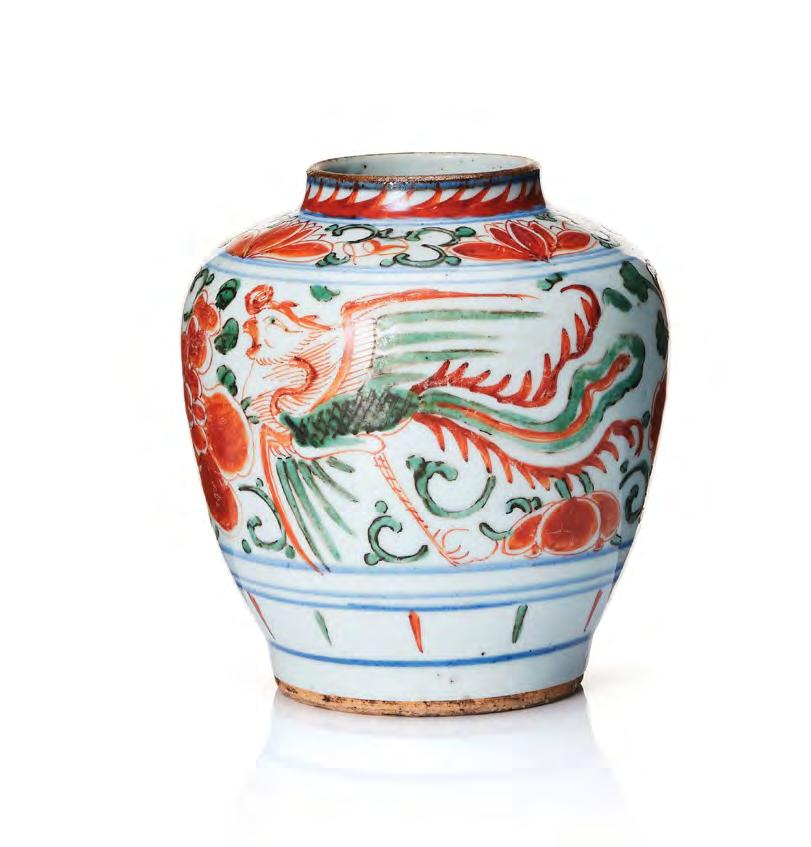
Provenance: From the private collection of a Swedish family in Närke.
1023. A famille rose lotus dish, Qing dynasty, Qianlong (1736–95).
Lobed with a rim in the shape of pink lotus leafves, central motif with a lotuspond in full bloom. Diameter 22.2 cm.

Provenance: From the private collection of a Swedish family in Närke. Catalogue note: Lotus is the symbol of honesty, goodness, beauty, purity and strength in the eyes of the Chinese people.
Estimate: SEK 10 000 – 15 000 / EUR 880 – 1 320
1025. A blanc de chine figure of a boy on an ox, late Qing dynasty. The boy is seated on the back of the ox, plaing a flute clad in a loose fitted robe with a hat on his shoulder. Height 18.5 cm. Length 19 cm.
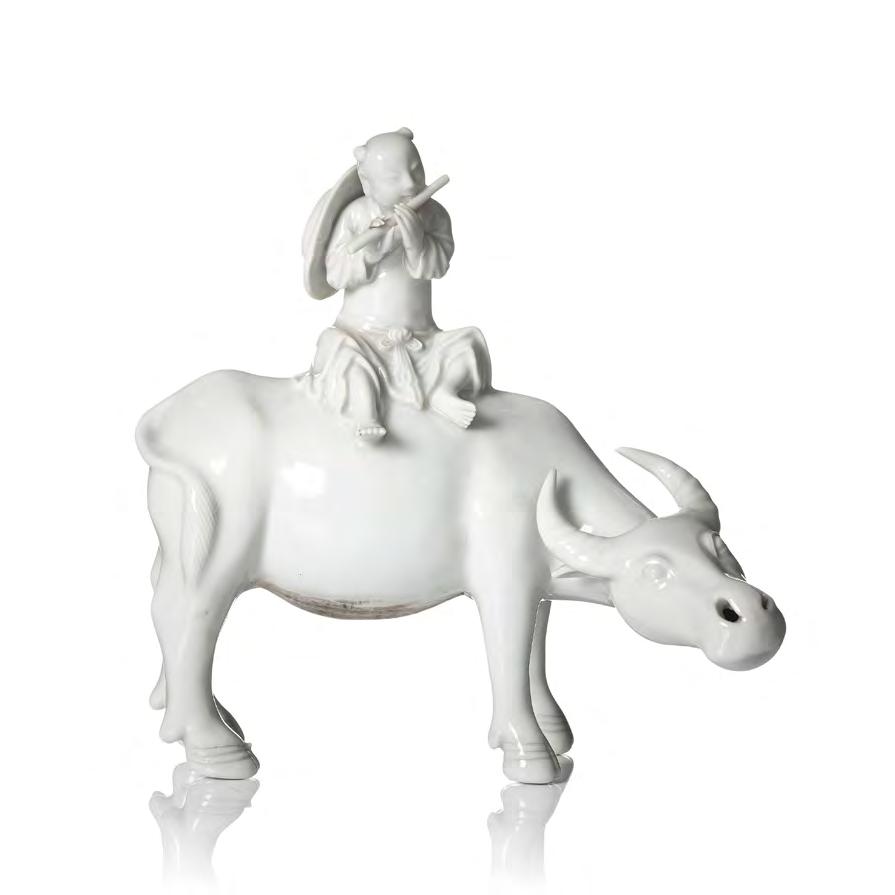
Provenance: From the private collection of a Swedish family in Närke.
Catalogue note: The ox has many meanings and carry a lot of symbolism in Chinese culture. One of the myths involving the interaction of humans or divine beings and oxen, and in art depicted as a boy or man with an ox is related to a popular holiday held on the 7th day of the 7th lunar month. In Chinese mythology, there is a love story of Qi Xi (七夕 literally, “the Seventh Night”), in which Niulang (the Cow-Herd) (牛郎 , Altair) and his two children ( β and γ Aquilae) are separated from their mother Zhinü (the Weaver-Girl) ( 織女 , lit. “Weaving Girl”, Vega) who is on the far side of the river, the Milky Way. Niulang was very upset when he found his wife was taken back to heaven. Upset by the separation, the ox saw this happens and became a boat for Niulang to carry his children up to Heaven. The ox actually was once the god of cattle, but downgraded as he had violated the law of Heaven. Niulang once saved the ox when it was sick. However, one day per year, on the seventh day of the seventh lunar month, magpies make a bridge so that Niu Lang
1024. A set of eight 'deer plates', Qing dynasty, Qianlong (1736–95).
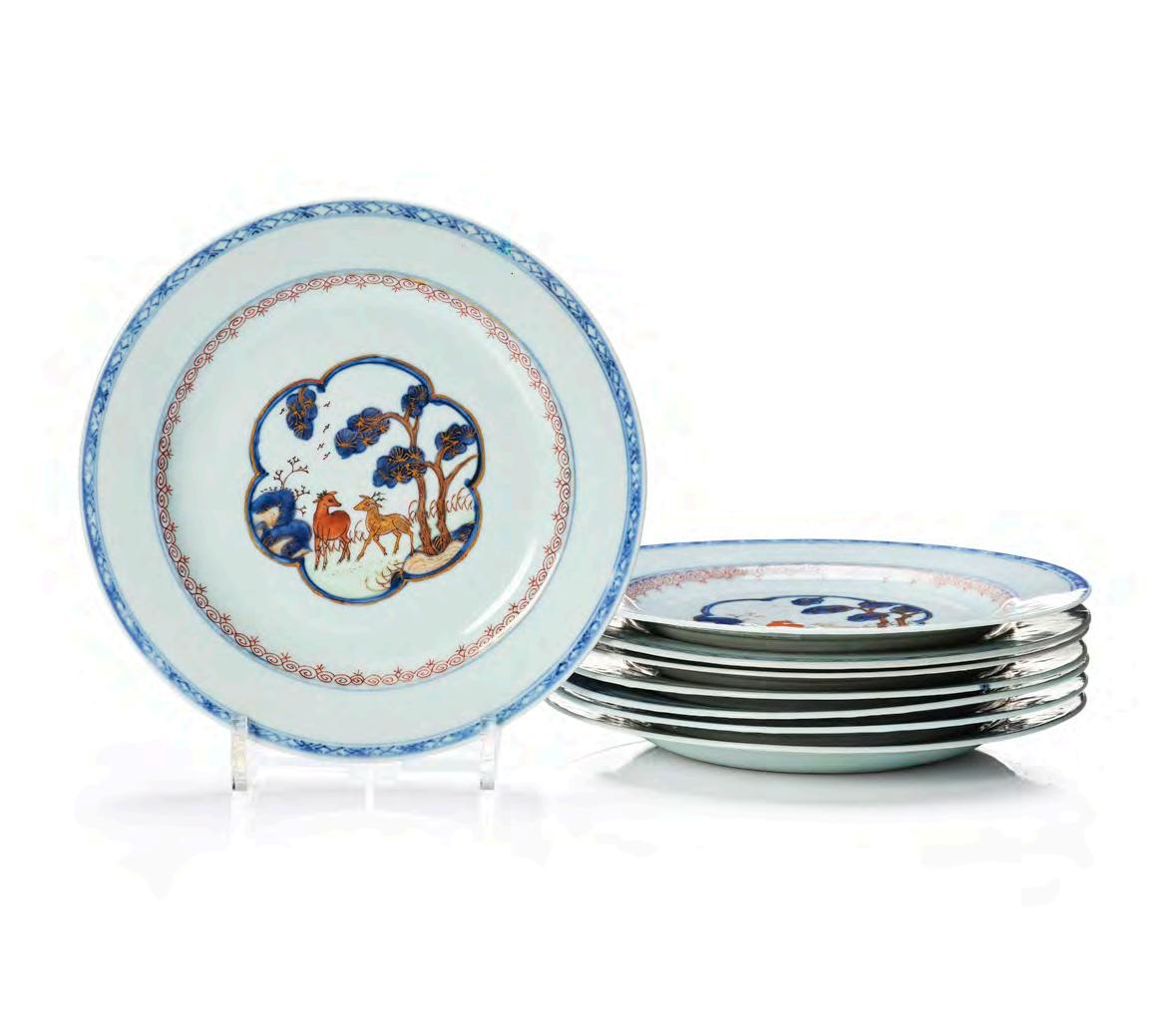
Round, flat, decorated with deers in a landscape setting with pine trees. Diameter 23 cm.
Provenance: Purchased at Bukowskis, Auction 484, lot no 551 . From the private collection of a Swedish family in Närke.
Catalogue note: A symbol of longevity and grace in Chinese mythology, the word deer is pronounced lu, a homonym for emoluments – favors granted to officials. They therefore represent wealth, nobility and success in imperial examinations (civil service exams for selecting candidates for the state bureaucracy in Imperial China).
Estimate: SEK 8 000 – 10 000 / EUR 710 – 880
1026. A famille rose flower pot, Qing dynasty, 19th Century. Rectangular shape, decorated in famille rose colours with a contionus figure scene with 12 people in a garden setting. Height 16 cm.

Measurement top 18.5 x 18.5 cm.
Provenance: From the private collection of a Swedish family in Närke. and history.
Estimate: SEK 12 000 – 15 000 / EUR 1 060 – 1 320
1027. A rectangular famille rose flower pot, Qing dynasty, 19th Century. Rectangular shape on four small feet, powerful decoration with a continous figure scene in a garden setting. Height 17.5 cm. Measurement top 19 x 19 cm.
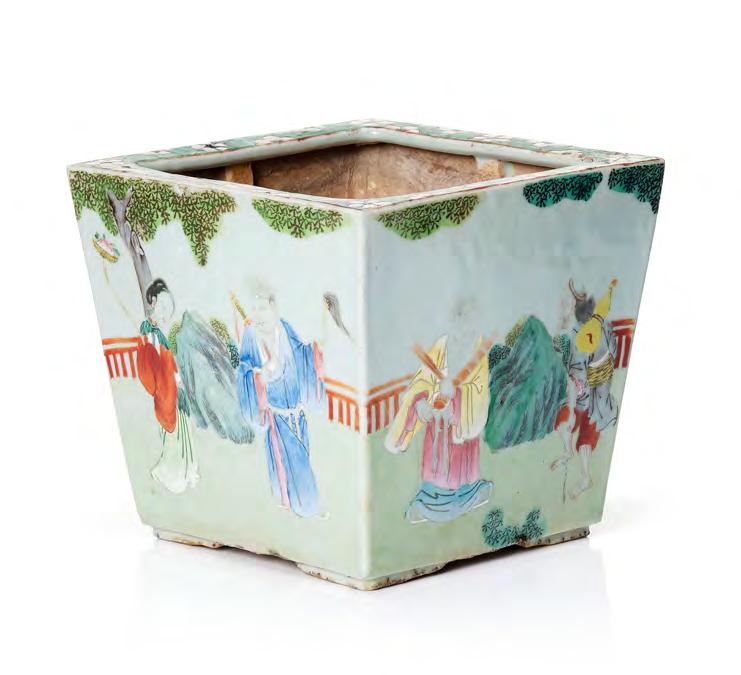
1028. A set of three famille rose dishes, late Qing dynasty with

Decorated in famille rose colours with a cricket in a garden in full bloom.
From the private collection of a Swedish family in Närke. The couple has a keen interest in art and antiques and started to collect in the 1960’s, attending auctions, antique shops, and antique fairs. Always seeking additional pieces that would adorn their home and that intrigued them with its quality and history.
Crickets hold a lot of symbolism in Chinese culture. From the Chun Qui period (770-476 B.C.) crickets were kept as symbols of luck and auspicious virtue. Whenever autumn arrives, the ladies of the palace catch crickets and guarded them in small golden cages, which were placed near their pillows so as to hear their songs during the night. They have been known to inspire scholars to write poems, they are a symbol of good luck to give to someone who is moving in to a new house. The crickets also have many children, something that was important and highly regarded in the past.
SEK 4 000 – 6 000 / EUR 360 – 530
1029. A famille rose sgrafitto vase, Qing dynasty, 19th Century with

Seal mark in red to base. Baluster shape on a tall foot and with a tall neck with flared rim. Decorated in famille rose colours with flowers against a blue sgrafitto ground. Gilded rim. Interior and base in a pale turkoise colour. Height 40.5 cm.
From the private collection of a Swedish family in Närke. The couple has a keen interest in art and antiques and started to collect in the 1960’s, attending auctions, antique shops, and antique fairs. Always seeking additional pieces that would adorn their home and that intrigued them with its quality and history.
SEK 15 000 – 20 000 / EUR 1 320 – 1 760
 1036. A long scroll painting after Zhao Yong (Zhao Zhongmu 1289–1369), ink and colour on paper and on silk, Qing dynasty.
1036. A long scroll painting after Zhao Yong (Zhao Zhongmu 1289–1369), ink and colour on paper and on silk, Qing dynasty.

1030. A Chinese 'five clawed dragon' dish, late Qing dynasty with Guangxu mark.
Oval shape with lobed rim, decorated to the center in red with a front facing five clawed dragon chasing the flaming pearl amidst cloud formations, around that four sets of flowers in vibrant colours. Gilded rim. Length 35 cm.

Provenance: From the private collection of a Swedish family in Närke. The couple has a keen interest in art and antiques and started to collect in the 1960’s, attending auctions, antique shops, and antique fairs. Always seeking additional pieces t hat would adorn their home and that intrigued them with its quality and history.
Estimate: SEK 8 000 – 10 000 / EUR 710 – 880
1031. A Chinese Republic vase, with Qianlong mark. Baluster shape with a flared rim, decorated with four panels in underglaze blue depicting figure scenes. The vase with a mild celadon glaze on a relief ground of a contionous floral scroll. Height 22.5 cm. From the private collection of a Swedish family in Närke. The couple has a keen interest in art and antiques and started to collect in the 1960’s, attending auctions, antique shops, and antique fairs. Always seeking additional pieces that would adorn their home and that intrigued them with its quality


SEK 10 000 – 15 000 / EUR 880 – 1 320
1032. A doucai vase, late Qing dynasty with a Jiajing mark. Dropp shaped with a bulbshaped mouth, decorated in doucai colours with five clawed dragons alternating with phoenix birds. The six characters are placed by the rim. Height 22 cm.
Provenance: From the private collection of a Swedish family in Närke.
Estimate: SEK 4 000 – 6 000 / EUR 360 – 530
1033. A Chinese scroll painting, ink and colour on silk laid on paper, Qing dynasty, probably 18th Century.

With calligraphy and seal in red. A scholar in a landscape setting. It illustrates the story of Wang Xizhi writing calligraphy to help out a poor fan vendor (her business boomed thereafter!).
Measurement motif 31 x 63 cm. Measurement hanging 44 x 143 cm.
Provenance: Purchased in China by a Swedish Collector in the early 1960s, thence by descent. The Collector worked for the Etnografic Museum in Stockholm and had a great interest in Chinese Works of Art.
Estimate: SEK 12 000 – 15 000 / EUR 1 060 – 1 320
1034. A Chinese scroll painting, ink and colour on paper, Qing dynasty after Wen Zhenming. A riverscape with buildings, mountain tops and people. Measurement motif 36 x 59 cm. Measurement Calligraphy square 36 x 29.5 cm. Measurement hagning 52 x 140 cm.

Provenance: Purchased in China by a Swedish Collector in the early 1960s, thence by descent. The Collector worked for the Etnografic Museum in Stockholm and had a great interest in Chinese Works of Art.
Catalogue note: Wen Zhengming (1470–1559) was a leading Ming Dynasty painter, calligrapher, and scholar. Wen Zhengming is regarded as one of the “Four Masters of Ming” ( 明四家 ), which also include Shen Zhou ( 沈周 ), Tang Yin ( 唐寅 ), and Qiu Ying ( 仇英 ). The longest living of the four and attracting many students, Wen Zhengming had sons who followed his footsteps and many disciples as well. Consequently, he had a great impact on painting and calligraphy of the middle and late Ming dynasty and became known along with Shen Zhou as a leader of the Wu School.
Estimate: SEK 8 000 – 10 000 / EUR 710 – 880
1035. A Chinese landscape painting, signed Wen Zhengming (1470-1559), but after.
Color and ink on silk laid on panel. Two seals in red. With calligraphy. Sholou is walking with his deer and an attendant though a landscape with misty mountains and waterfalls. Measurement with frame 70-156 cm
Catalogue note: Wen Zhengming (1470–1559) was a leading Ming Dynasty painter, calligrapher, and scholar. Wen Zhengming is regarded as one of the “Four Masters of Ming” ( 明四家 ), which also include Shen Zhou ( 沈周 ), Tang Yin ( 唐寅 ), and Qiu Ying ( 仇英 ). The longest living of the four and attracting many students, Wen Zhengming had sons who followed his footsteps and many disciples as well. Consequently, he had a great impact on painting and calligraphy of the middle and late Ming dynasty and became known along with Shen Zhou as a leader of the Wu School.
Estimate: SEK 30 000 – 40 000 / EUR 2 640 – 3 520

1036. A long scroll painting after Zhao Yong (Zhao Zhongmu 1289–1369), ink and colour on paper and on silk, Qing dynasty. Seal marks in red. With calligraphy signed Wu Xigi (1746–1818). Decorated with a big herd of horses in a landscape. Measurment 33 x 320 cm. An additional panel with calligraphy on a gold splashed paper. Measurement 33 x 82 cm. Total lenght 38 x 480 cm.

Provenance: Property of a Swedish Collector.
Estimate: SEK 20 000 – 25 000 / EUR 1 760 – 2 200
1037. A Chinse scroll painting, signed Yun Yuancheng, possibly 18th Century.

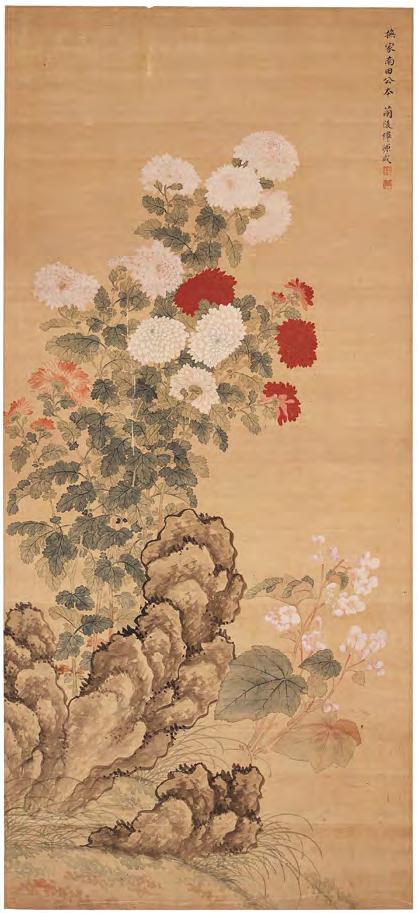
Ink and colour on silk, laid on board. Two seals in red. Possibly a descendant of Yun Shoupi. Chrystanthemum and a garden rock.
Measurment 47,5 x 114,5 cm. Measurment with frame 62 x 121 cm.
Provenance: Purchased at Svenskt Tenn in the 1970's.
Estimate: SEK 15 000 – 20 000 / EUR 1 320 – 1 760
1038. A large Chinese painting, by an anonymous artist, Qing dyanasty, 19th Century.
Ink and colour on silk. Magpies in a garden in full bloom. Measurment with frame 108 x 209 cm. Laid on panel. No glass.
Provenance: Purchased at Svenskt Tenn in the 1960's.
Catalogue note: Magpies are seen as an omen of good fortune. This is reflected in the Chinese word for magpie, simplified Chinese: 喜鹊 ; traditional Chinese: 喜鵲 ; pinyin: x ǐ què, in which the first character means “happiness”. It was the official ‘bird of joy’ for the Manchu dynasty)
Estimate: SEK 20 000 – 30 000 / EUR 1 760 – 2 640
1039. A Chinese scroll painting after Lan Meng (1644–1722), Qing dynasty.



Signed and with two seals in read. Depicting a riverscape with mountains. Measurment motif 51 x 160 cm. Measurment with frame 70x178 cm.
Provenance: From the Collection of a Swedish family.
Estimate: SEK 15 000 – 20 000 / EUR 1 320 – 1 760
1040. A Chinese scroll painting, signed of Qiu Ying (1494–1551), but most likely later.

Calebass shaped seal in red. Calligraphy. Can be rolled up. A landscape with moutains and figures in the forground by a pavillion. Framed but can be rolled up. Measurement motif 144 x 39.5 cm. Measurement with frame 179 x 62 cm.
Provenance: From the collection of Brith & Berthil Christenson, Djursholm. Thence by descent. The painting (lot no 1040) and the lanterns (lot no 1276) was purchased in the 1950’s when Brith Christenson was on tour with the Opera Ballet in China. The altartable from the same collection (lot no 1047) was purchased from another family in Djursholm in the 1960’s.
Estimate: SEK 20 000 – 25 000 / EUR 1 760 – 2 200
1041. A Chinese painting by Feng Chaoran (1881/1882–1954), ink and colour on paper.
Landscape, dated 1916. Measurement motif 25.5 x 33 cm. Total measurement including frame 37 x 42 cm.
Estimate: SEK 6 000 – 8 000 / EUR 530 – 710
1042. The Hongs of Canton by anonymous Chinese artist, around 1800. Oil on canvas. Depicting a view of the hongs, or “Factories,” at Canton that commemorates the early years of direct trade between the United States and China (center flag). It also records six other flags representing other contries actively in trade with China (Great Britain, France, Sweden, Denmark, the Netherlands and Spain). These countries were all actively trading at Canton, the only Chinese port at which Western trade was permitted. Mesurement with frame 54 x 67 cm.

Provenance: Property of a Swedish private collection.
Exhibitions: These painting were produced as export wares in the Qing dynasty through the 18th and 19th centuries, and sought after by western collectors ever since, China Trade paintings are now of growing interest to Chinese clients as well.It is a taste being driven by Chinese institutions, led by the Hong Kong Museum of Art on Kowloon and the Guangdong Museum in Guangzhou on the mainland. The Hong Kong Museum of Art, which keeps the core of the celebrated Chater Collection.
Estimate: SEK 80 000 – 120 000 / EUR 7 040 – 10 560
Painted with people in interiors. Measurment album 24 x 37 cm.
Provenance: Property of a Swedish private Collection.
Catalogue note: These paintings are important documents for research and understanding the interior fashion, the clothing fashion and the colours of textiles of the period.



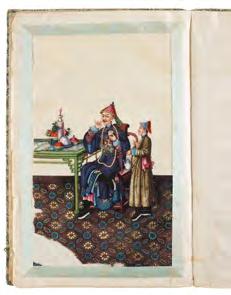









Estimate: SEK 6 000 – 8 000 / EUR 530 – 710
1043.
An elegante gathering in a garden setting. Measurement motif 50x35 cm. Measurement with frame 40x55 cm.
Provenance: Property of a Swedish private collection.
Estimate: SEK 30 000 – 40 000 / EUR 2 640 – 3 520
A Chinese reverse glass painting, Qing dynasty, around 1800.
1044. An album with 12 Chinese paintings by anonymous artist, Qing dynasty, 19th Century.
 1047. A Chinese black lacquered altar table with mother of pearl inlay, 17th /18th Century.
1047. A Chinese black lacquered altar table with mother of pearl inlay, 17th /18th Century.

1046. A Chinese hardwood table/seat, Qing dynasty, 19th Century. Four connected legs, decorated in relief. Measurement 36 x 36 x 46 cm.

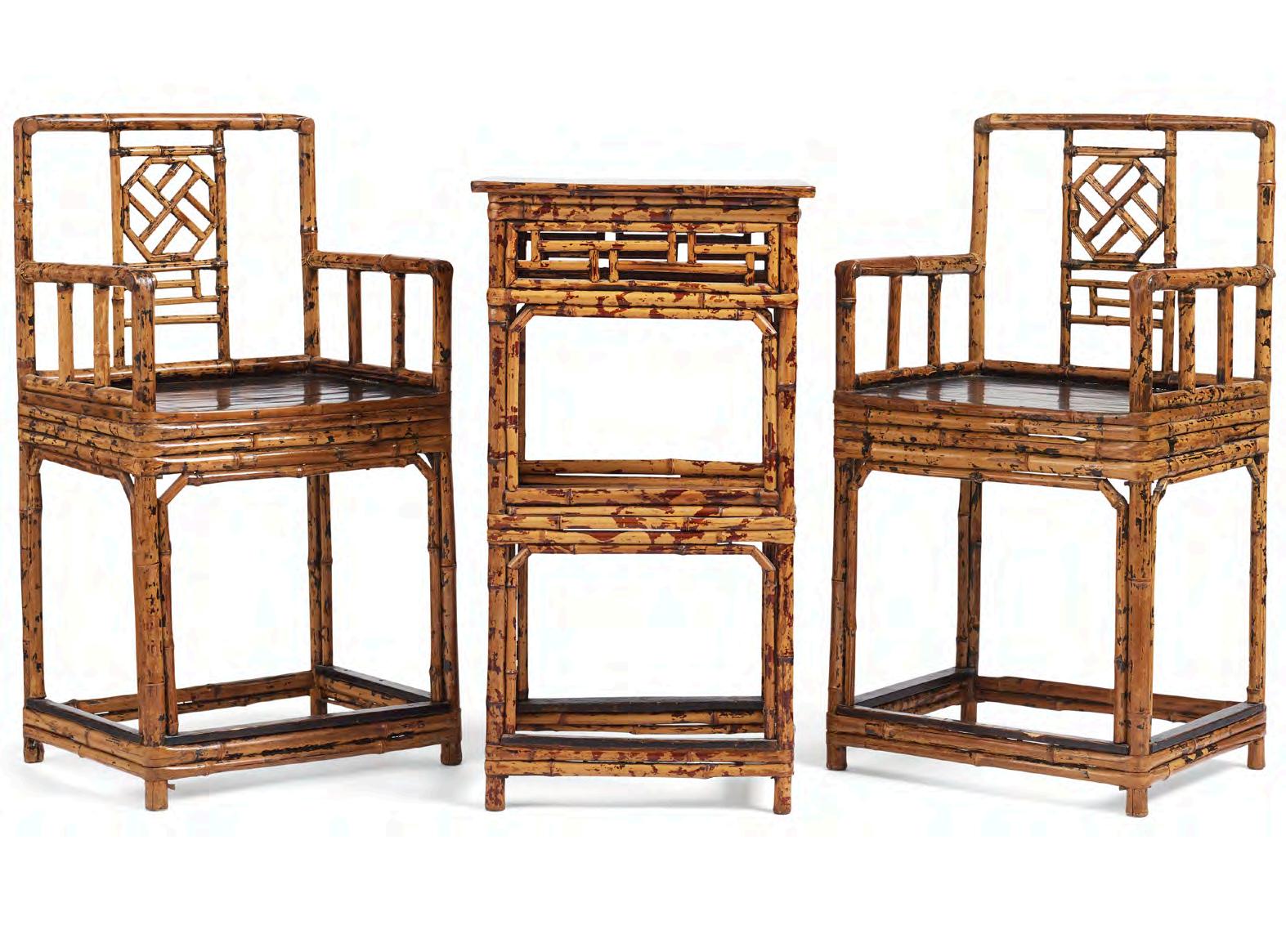
Estimate: SEK 6 000 – 8 000 / EUR 530 – 710
Provenance: From a Swedish private collection.
Exhibitions: Compare with; Sothebys, In the Studio: Asian Art Featuring Works from the Collection of Bruce Dayton and Ruth Stricker Dayton. 28 September 2021, New York. Lot 752.
Estimate: SEK 12 000 – 15 000 / EUR 1 060 – 1 320
1047. A Chinese black lacquered altar table with mother of pearl inlay, 17th /18th Century.


Of rectangular shape with connected legs, deocrated with mother of pearl with pheasants in a garden with peonies in full bloom. Length 161 cm. Depth 51 cm. Height 83 cm.
Provenance: From the collection of Brith & Berthil Christenson, Djursholm. Thence by descent. The painting (lot no 1040) and the lanterns (lot no 1276) was purchased in the 1950’s when Brith Christenson was on tour with the Opera Ballet in China. The altartable from the same collection (lot no 1047) was purchased from another family in Djursholm in the 1960’s.
Literature: Guantin Jia Ju Zhen Da Guai. Beijing 2006; Compare table with mother of pearl inlay on page 273. Compare another table on page 627.
Estimate: SEK 75 000 – 100 000 / EUR 6 600 – 8 800
1048. A silk embroidery, Qing dynasty, 19th Century. Depicting two elegant ladies in a garden setting . Measurement with frame 76 x 121 cm.


Provenance: Property of a Swedish private collector.
Estimate: SEK 6 000 – 8 000 / EUR 530 – 710
1049. A group of four framed rank badges, Qing dynasty, 19th Century.

Embroidered with birds. Measurement each 29 x 29 cm and 30x30 cm. Measurment with frame 39 x 132 cm.
Provenance: Property of a Swedish private collector.
Estimate: SEK 8 000 – 10 000 / EUR 710 – 880
1050. Two embroidered silk panels, late Qing dynasty. Embroidered in different colours on a rust red ground, decorated with a motif with a empress in a garden setting. Lined. Measurment each hanging 218 x 46 cm.

Provenance: From a Swedish private collection.
Estimate: SEK 10 000 – 15 000 / EUR 880 – 1 320
1051. A Chinese embroiderd kang pillow, Qing dynasty, 19th Century.

Embroidered in different colours with figure scenes from court life against a pale celadon/light blue ground. Height 23 cm.

Provenance: Property of a Swedish private collection.
Estimate: SEK 4 000 – 6 000 / EUR 360 – 530
1052. A Chinese silk embroidery, Qing dynasty, 19th Century.

Embroidered in colours on a coral red ground. Lined in yellow silk. Measurement 101 x 184 cm.
Provenance: Property of a Swedish private collection.
Estimate: SEK 5 000 – 7 000 / EUR 440 – 620
1053. A Chinese robe, Qing dynasty, 19th Century. Decorated with four clawed dragons chasing the flaming pear above fierce waves and rock formations. Height back 117 cm.
Provenance: Purchased in London in the 1960's, thence by descent.
Estimate: SEK 12 000 – 15 000 / EUR 1 060 – 1 320
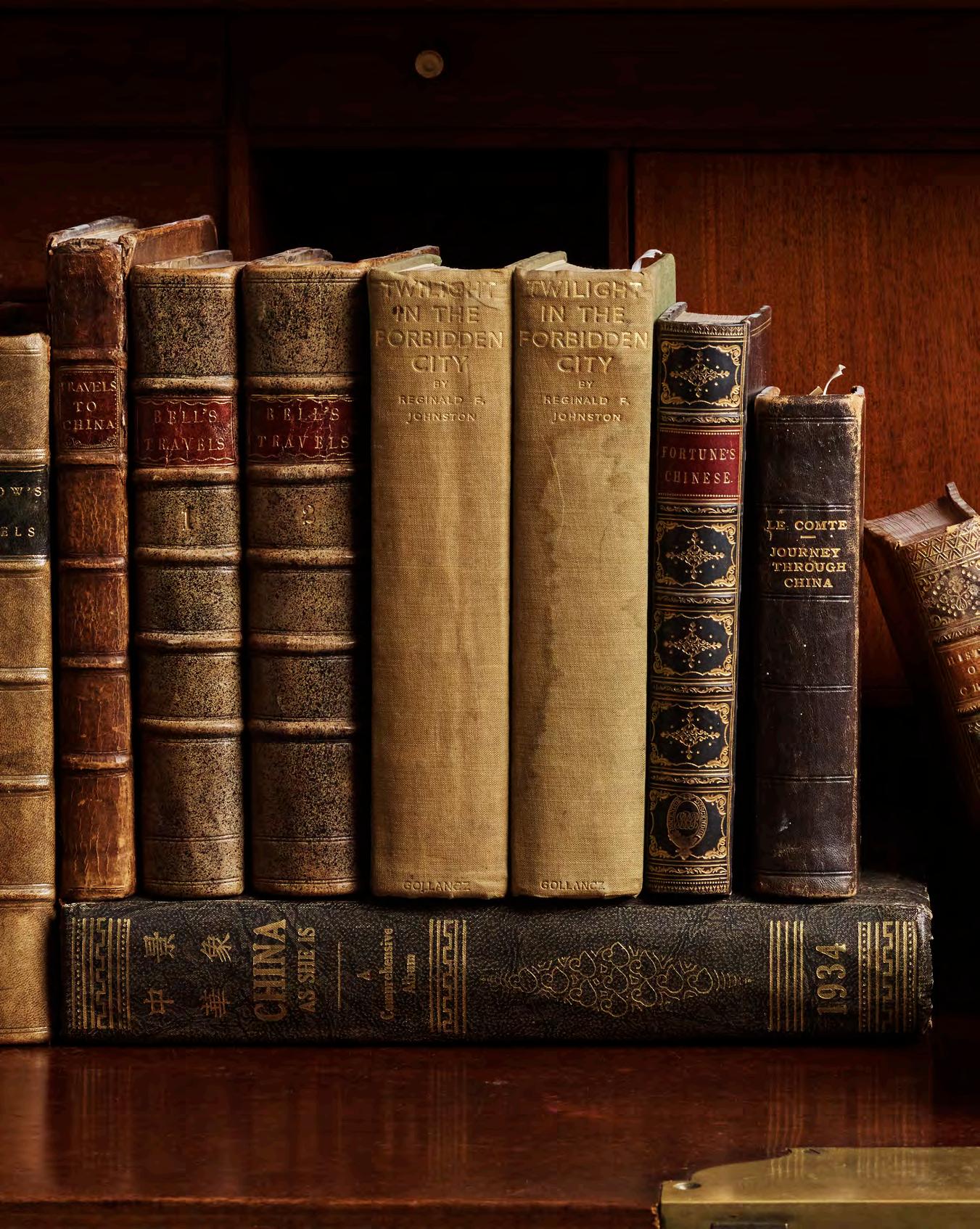
The Collection of Ann Kreuger
From the Collection of Ann Kreuger (l1926–2022). Ann Kreuger is well known in the circles of snuff bottles collectors, dealers and auction houses. She was an active m ember in the Snuff bottle society, researched, collected, lectured, and wrote numerous articles in the single owner sale ‘The Guo’an Collection of fine Chinese snuff bottles, Hong Kong, Monday 30 October 2000, from where they found their way into other prestigious collections.
 LOT 1054 – 1080
LOT 1054 – 1080
1054. An embrodered silk robe, Qing dynasty (1644–1912).

Embroidered with fierce four clawed dragons in gold chasing the flaming pearl amid cloud formations above waves all on a deep coral red silk ground. Lined. Lenght back 105 cm.
Provenance: From the Collection of Ann Kreuger (l1926–2022).
Estimate: SEK 12 000 – 15 000 / EUR 1 060 – 1 320
1055. A Chinese silk embroidered wall panel/bedspread, Qing dynasty, 19th Century.
Depicting birds in a flowering garden, with silver and gold thread against a beige ground. Measurment 364 x 263 cm.

Provenance: From the Collection of Ann Kreuger (l1926–2022).
Estimate: SEK 8 000 – 10 000 / EUR 710 – 880
1056. A Collectors Library, part 1. The History of China, Vol I-IV. The General History of China, containing a Geographical, Historical, Cronolgical, Political and Physical Description of the Empire of China. 'Chinese Tartary, Corea and Thibet. Including an Exact and Particular Account of their Customs, Manners, Cereemonies, Religion, Arts and Scciences. Done from the French of P. Du Halde. London M DCC XXXVI. With maps and fold outs. Leather binding.


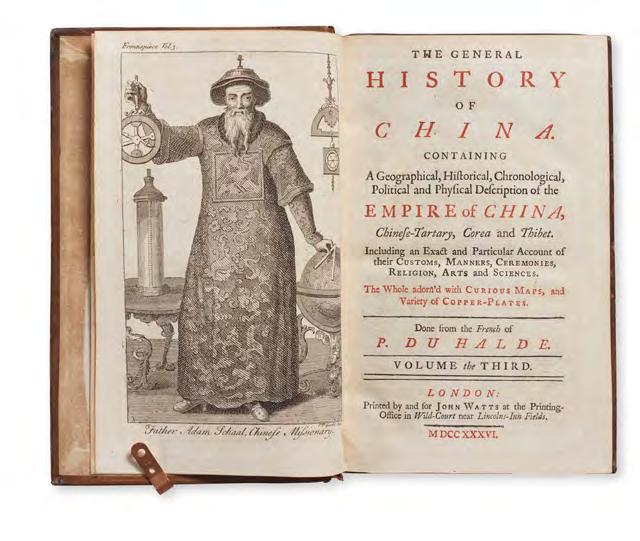


Provenance: From the Collection of Ann Kreuger (l1926–2022).
Estimate: SEK 6 000 – 8 000 / EUR 530 – 710
1057. A Collectors Library, part 2. J. H. Gray, China, A History of the Laws, Manners and Customs of, Vol I-II, London 1878.
John H Gray was a 19th-century Anglican priest who was the first Archdeacon of Hong Kong. He served as a chaplain throughout Hong Kong, preaching and teaching Christianity. Ten years after he arrived in China, he wrote a book on Chinese society entitled simply China. Blue cloth binding.

Measurement 15 x 22,5 cm.
Provenance: From the Collection of Ann Kreuger (l1926–2022).
Estimate: SEK 5 000 – 7 000 / EUR 440 – 620
1058. A Collectors library, part 3. A group of books about Chinese Art (23 volumes).
Comprising; Classical Chinese Painting, London, 1979. The Distant Mountains, James Cahill, New York and Tokyo, 1982. Parting at the Shore, James Cahill, New York and Tokyo, 1978. Hills Beyond a River, James Cahill, New York and Tokyo, 1976. Chinese Erotic Art, Michel Beurdeley, Hong Kong 1969. Chinese Calligraphy, Tsen Yu-ho Ecke, Philadelphia, 1971. Flowers in Art from East and West, Paul Hulton and Lawrence Smith, London 1979. Chinese Painting and Calligraphy, Wan-go Weng. New York, 1979(…)
Provenance: From the Collection of Ann Kreuger (l1926–2022).
Estimate: SEK 4 000 – 6 000 / EUR 360 – 530
1059. A Collectors Library, part 4. A group of books about China. (10 volumes).

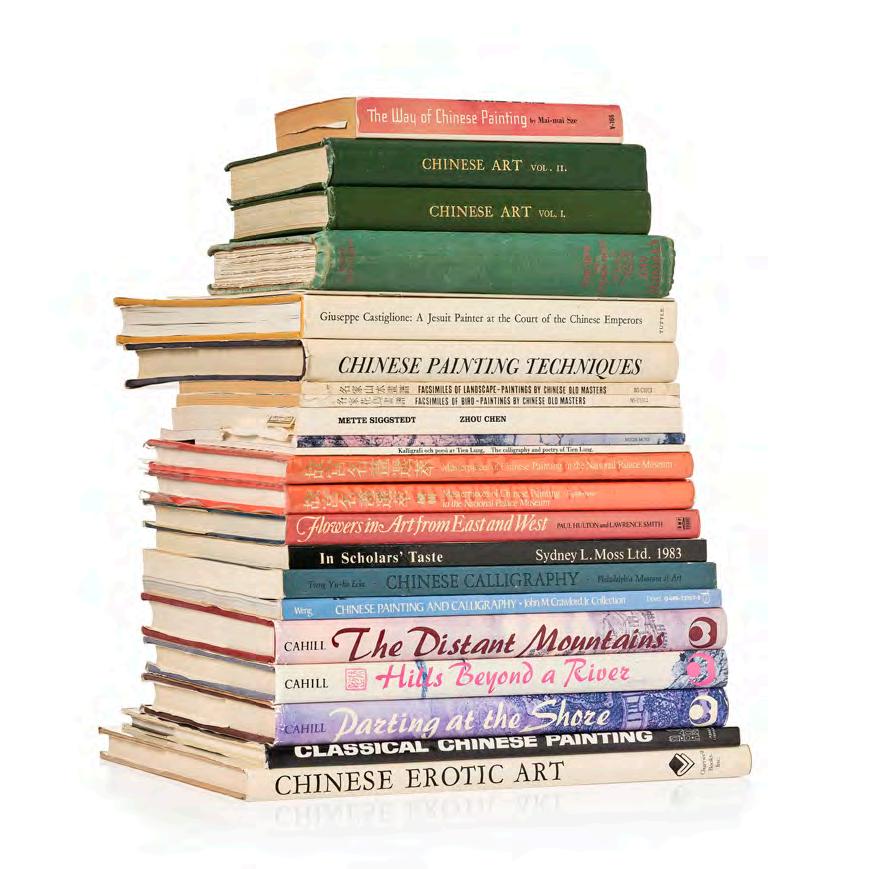
Comprising; John Barrow, Travels in China, 2nd ed. London 1806. Includes colour plates. Descriptions, observations and comparisons, made and collected in the short residence at the imperial palace of Yuen-min-yuen, and a subsequent journey throught the country from Peking to Canton. Leather binding. Travels to China, ‘Three years of travels from Moscow over land to China through Great Ustiga, Siriania, Permia, Sibiria, Daour, Great Tartary & to Peking. Written by his Excellency E. Ysbrandts Ides, London 1706. Leather binding. John Bell, Bells Travels Vol I-II, Glasgow MDCCLXIII. ‘Travels from St Petersburg in Russia to diverse parts of Asia by John Bell. French binding. Reiginald F Johnston. Twilight in the forbidden city, London 1934. ‘ Professor of Chinese in the University of London, last British Commissioner of Weihaiwei, Tutor to His Majesty the Emperor Hsuan-Tung’. China as she is, A comprehensive album, 1934. L.T. Wu. Memoires and Observations made in a late jouney through the Empire of China, by Louis Le Comte, London 1698. Leather binding. Robert Fortune, A residence among the Chinese, Inland, on the coast and at sea, being a narrative of scenes and adventures during a thrid visit to China from 1853-1856. London 1857. Leather binding. Robert Fortune, A residence among the Chinese, Inland, on the coast and at sea, being a narrative of scenes and adventures during a thrid visit to China from 1853-1856.
Provenance: From the Collection of Ann Kreuger (l1926–2022).
Estimate: SEK 15 000 – 18 000 / EUR 1 320 – 1 590
1060. A Collectors Library, part 5. Edward T Chow Collection, Part I - III. The Frederic Meyer Collection of Chinese Art. Three volumes, Sothebys Parke Bernet, Hong Kong LTD. 1981. In association with Michel Beurdeley and Lane Crawford Holdings Ltd. Christies, the Frederick Meyer Collection of Chinese Art, 1974. Provenance: From the Collection of Ann Kreuger (l1926–2022).
Estimate: SEK 2 500 – 3 000 / EUR 220 – 270
1061. A Collectors Library, part 6. A group of books on China and its litterature and history. (33 volumes).



Comprising; Tu Fu, the autogbiography of a Chinese poet, arranged from his poems by Florence Ayscough, London. The Haunted Monastary and the Chinese Maze Murders, Robert van Gulik, New York 1957. Celebrated cases of judge Dee, Dee Goong An, translated by Robert van Gulik, New York, 1976. Romance of the three Kingdoms, Vol I-II. A dream of the red mansions, Vol I-III. The lacquer screen, Robert van Gulik, The Red Pavillion, Robert van Gulik, The Willow pattern, Robert van Gulik, The Haunted Monastery, Robert van Gulik, the Emperors Pearl, Robert van Gulik. 1969. The Death of the wWoman Wang, Jonathan D. Spence, 1978. A Collection of Chinese Lyrics, Alan Ayling & Duncan Mackintosh, London 1967. The Poems of Mao Tse-Tung, Translated by Willis Barnstone, London 1972. Plantaing in the Rain, Du Mu, translated by R F Burton, 1990. Folktales of China, edited by Wolfram Eberhard, 1968. Peking Opera and Mei Lanfang, by Wu Zugang, Huang Zuolin and Mei Shaowu. Trade and dominion, J. H. Parry, 1974. A history of Chinese Litterature, By Herbert G. Giles, Japan 1991. A Judge Dee Mystery, Murder in Canton, by Robert van Gulik, The Monkey and the Tiger by Robert van Gulik. The Chinese Bell Murders, Robert van Gulik, The Emperors Pearl, Robert van Gulik. The Willow Pattern, Robert van Gulik. Li Po and Tu Fu, 1973. Poems of the late Tang, Penguin Classics. One Hundred and Seventy Chines Poems, translated by Arthur Waley. A Golden Treasury of Chinese Poetry, translated by John Turner, London 1979. Emperor of China, Self-Portrait of Kangshi, by Jonathan D. Spence. 1974. Selected Poems of the Tang & Song dynasties. Hermit of Peking, The hidden life of Sir Edmund Backhouse. Hugh Trevor Roper. 1978.
From the Collection of Ann Kreuger (l1926–2022).
SEK 6 000 – 8 000 / EUR 530 – 710
1062. A Collectors Library, part 7. A group of books about China. (19 volumes). Comprising; Sir G Staunton, An Historical Account of the Embassy of China. London 1797. Mongol Jewellry, Nationalmuseum, Martha Boyer, Köpenhamn, 1952. A compendium with a series of edition of Les Races Humaines’ Hatchett & Cie. La China, VIaggi di J. Thomson E T. Chouzhe. Milano, 1895. A booklet named Mongolei 1910. Barbarians and Mandarins, Thirteen centuries of western Travelers in China by Nigel Cameron, Japan, 1970. La Chine Ouverte, adventures d’un fan-kouei dans les pays de tsin. Par Auguste Borget, MDCCCXLV. Hills of Blue, a picture roll of Chinese history from far beginnings to the death of Chien Lung, A. D. 1799. by A E Grantham. Londonm 1927. Chinese Characteristics by Arthur H. Smith, a Twenty-two years a missionary of the American Board in China. 1894. Social Life of the Chinese, By Justus Doolittle, Vol I-II. 1863-1865. Across the Mongolian Plains, by Roy Chapman Andrews. New York, 1921. Mongol Journeys, by Owen Lattimore, London, 1941. News from Tartary, A jouney from Peking to Kashmir, by Peter Fleming, London, 1936. Among the Mongols, by Rev. James Gilmour, London. Travels in Tartary, by Peter Fleming, London 1941. Travels in TArtary, Thibet and China, during the years 1844-1856 by M. Huc. Second Edition. The Chinese Empire, by M Huc, formerly a missionary apostolic in China, London, 1860. Strange Stories from a Chinese Studio, translated by Herbert A Giles. London 1909. Mongol Jewellry, Nationalmuseum, Martha Boyer, Köpenhamn, 1952. A compendium with a series of edition of Les Races Humaines’ Hatchett & Cie.
Provenance: From the Collection of Ann Kreuger (l1926–2022).
Estimate: SEK 8 000 – 10 000 / EUR 710 – 880
1063. A collectors libary, part 8. A group of books about Chinese Ceramics. (20 volumes).
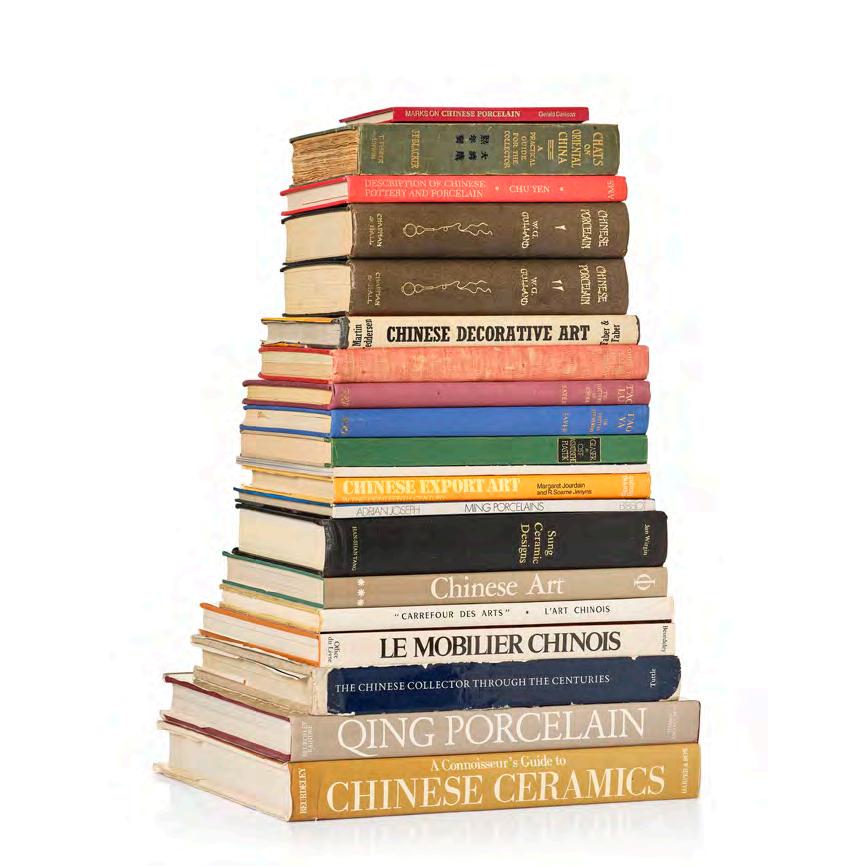
Comprising; A Connoisseurs Guide to Chinese Ceramics. Cecile and Michel Beurdeley. First Edition. Qing Porcelain, famille verte, famille rose. Michel Beurdeley and Guy Raindre. 1987. The Chinese collector through the centuries, M Beuredely, Switzerland, 1966. Le mobilier de chinoise, C & M Beurdeley, 1979. Sung Cearmics, Jan Wirgin, Stockholm 1970. Ming Porcelain, their origins and development, Adrian, M Joseph, London 1971. Art Chiniois, Michele L’Serstevens, Paris, 1962. Chinese Export Art, Margaret Joudain and R S Jenyns. 1967. Chinese Art, R. Soame Jenyns, 1981. Chinese Pottery Burial Objects of the Sui and Tang dynasties, Hugh M Moss, 1970. Ching-te-chen, T’ao-Lu. Geoffery R Sayer, 1951. Tao Ya, Geoffrey R Sayer. London, 1959. Glaser, Ostasiatiche plastik 1925. Guide to later Chinese porcelain, W. B Honey, London 1927. Chinese Decorative Art, Feddersen, London, 1961. Chinese porcelain, Volume I-II, W. G. Gulland, London, 1929. Discriptions of Chinese pottery and porcelain, Chun Yen, 1910.Chats on Oriental China, J F Blacker, 1911. A guide to marsk on Chinese porcelain, Gerald Davidson.
Provenance: From the Collection of Ann Kreuger (l1926–2022).
Estimate: SEK 4 000 – 6 000 / EUR 360 – 530
1064. A collectors library, part 9. A group of books on China. (9 volumes).


Comprising; Williams, The Middle Kingdom, a survey of the geography, government, literature, social life, arts and history of the Chinese Emperor and its inhabitants. New York, Charles Scribner’s Sons, 1914. Vol I-II. Dyer Ball, Things Chinese, Second Edition, London 1893. James Zee-Ming Lee, Hong Kong 1961, Chinese Potpourri. Chinese Collection, Hyde Park Corner. Memoirs of Father Ripa, During thirteen years of residence at the court of Peking in the service of the Emperor of China. London 1844. Library of Entertainting knowledge, Davis’s Chinese I-II. Pictures of the Chinese, London, 1860.
1065. A Collectors Library, part 10. A group of books and pamflets on Chinese painting and China. (12 in total).
Comprising; Jewels of Light. from the Jung-Pao-Tsao Workshop, Text by Alex Wedding, Leipzig 1961. A booklet of prints. Two books on Chinese Art, Vol I-II. Glossary of Reference on the Far East, By Herman A. Giles. London 1974. China Journal, by Emmet Dedman, Harward 1973. Official Guide to Eastern Asia, Vol I, II and IV. Tokyo 1915. 3 booklets; The Chinese word for horse. The Chinese worde for man and woman. The Chinese word for Thief.
Provenance: From the Collection of Ann Kreuger (l1926–2022).
Estimate: SEK 3 000 – 4 000 / EUR 270 – 360
1066. A Collectors Library, part 11. A group of books on expiditions, Tibet etc. (7 volumes).
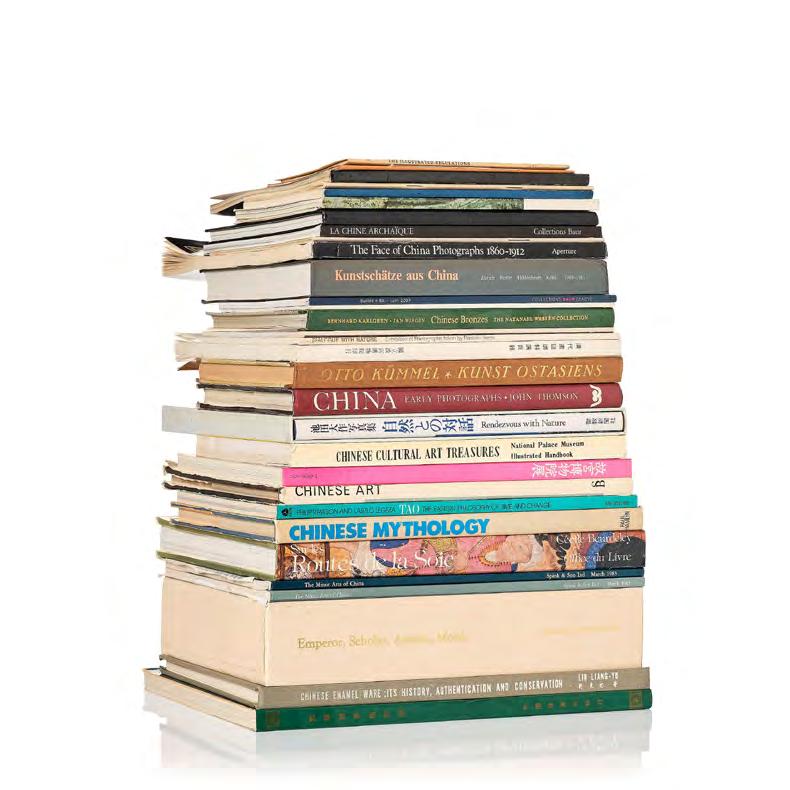

Comprising; History of the Expedition in Asia 1927-35. Part VI. General reports on travels and fireld work by Folke Bergman, Gerhard Bexell, Birger Bohlin, Gösta Montell. Stockholm 1945. Treasures of Tibetan Art, Collections of the Jacques Marchais Museum of Tibetan Art. Barbara Lipton and NimaDorjee Ragnubs. 1996. Die Mongolen, Walther Heissig, Claudius C Muller. Frankfurt 1989. Tibet, Giuseppe Tucci, Stockholm 1967. Magic and Mystery in Tibet, by Alexandra David Neel. Maryland 1971. Kuhles grasland mongolei, by Walter Bosshard, 1950. Ein Rit fur Deutschlands, Wilhelm Karl Herrman, 1941.
Provenance: From the Collection of Ann Kreuger (l1926–2022).
Estimate: SEK 4 000 – 6 000 / EUR 360 – 530
1067. A Collectors Library, part 12. A group of books and pamflets on China (29 books/pamflets).

Comprising; Emperor, Scholar, Artisan, Monk, The Creative Personality in Chinese Works of Art, by Sidney L Moss, 1984. Chinese Enamel Ware, its Hitory Authentication and Conservatin, by Liu Liang - Yu. Life of the Emperors and Empresses in the Forbidden City, Beijing, 1983. Tao, the eastern philosophy of time and change, by Philip Rawson and Laslo Legeza, Holland 1973. Chinese Mythology, Anthony Christie, Verona 1968. Chinese Cultural Art Treasures, National Palace Museum, Illutrated Handbook. 1981. Rendevous with nature. Exhibition Catalogue of Imperial Court in Forbidden City, Qing dynasty. 1985. Routes de la Soie, Le grand voyage des objects d’art, Cecile Beurdeley, Suisse 1985. China, the land and its people, early photographs by John Thomson, Die Kunst Ostasiens, Berlin 1921. Dialog with nature, exhibition catlaogue. The Illustrated Regulations for Cermeonial Paraphernaila of the Ching Dynasty, Margaret Medley. The Face of China, as seen by photographers & travelers 1860-1912, L Carrington Goodrich and Nigel Cameron. The presence of the Dragon Throne, John E Vollmer, Toronto. L’art du the en Chine, Collections Baur, Musee des arts d’extreme-orient, bulletin, 2007. Pamflet, Percival David Foundation of Chinese Art, Illustrated guide to the collection. Pamflet from the Entografic museum. Bookelt from the Muesum of Far Eastern Antiquites, Stockholm. Pamflet from the Mount Trust Collection of Chinese Art. Te som konst, Östasiatiska Museet, Mette Siggstedt. La Chine Archaique, Collection Baur, 1987. Chinese Bronzes, the Natanael Wessen Collection, Bernhard Karlgren, Jan Wirgin, Kunstschätze aus China, Helmut Brinker und Roger Goepper, Köln 1982. Porcelain of the National Palace Museum. Chinese Glas, Museum fur kunsthandwerk Frankfurt am Main. Guide to the Chinese Ceramics in the department of eastern art Ashmolean Museum, by Mary Tregear. Chinese Art, Finlay MacKenzie, London. The Minor Arts of China. Vol I-II. Spink & Son Ltd.)
Provenance: From the Collection of Ann Kreuger (l1926–2022).
Estimate: SEK 8 000 – 10 000 / EUR 710 – 880
1068. A Collectors Library, part 13. A group of books about snuffbottles (20 volumes). Comprising; By Imperial Command, An intruduction to Ch’ing Imperial Painted Enamels. Hugh Moss, A New Look of Chinese Inside Painted Snuff Bottles, J. H. Leung. Snuff Bottles from China, Helen White, 1992. The Art from the Scholars Studio, 1986. The Art of the Chinese Snuff Bottle, Vol I-II, Moss, Graham, Tsang. Chinese Snuff Bottles from the Collection of Mary and George Block, by Robert Kleiner. Chinese Snuff Bottles from the Collection of John Ault, by Robert Kleiner. Chinese Snuff Bottles from the White Wings Collection by Robert Kleiner. Snuff Bottles in the Collection of the National Palace Museum. Masterpieces of Chinese Snuff Bottles in the National Palace Museum. The Experience of Art, Hugh Moss. The Collectors Book of Snuff Bottles, Bob C Stevens. Guide du collectioner de tabatiers chionoises, Viviane Jutheau. Chinese Snuff Bottles & Dishes, from the Bob C Stevens Collection. Chinese Snuff Bottles, the Adventures & Studies of a Collector, Lilla S Perry. Preisen aus kleinen Tabakflaschen, Johanna Kreug. Catalogue, part I-III. Parke Bernet Galleries, From the Collection of Mrs Elmer A. Claar. Chinese Snuff Bottles in the Fitzwilliam Museum Cambridge (pamflet by Hugh Moss), Chinese Snuff Bottles in the British Museum (pamflet by Hugh Moss). Chinese Snuff Bottles:5. Edited by Hugh M Moss. In addition to above a group of, snuff bottle reviews, auction catalogues and pamflets in the subject.)
Provenance: From the Collection of Ann Kreuger (l1926–2022).
Estimate: SEK 8 000 – 10 000 / EUR 710 – 880
 1042. The Hongs of Canton by anonymous Chinese artist, around 1800.
1042. The Hongs of Canton by anonymous Chinese artist, around 1800.
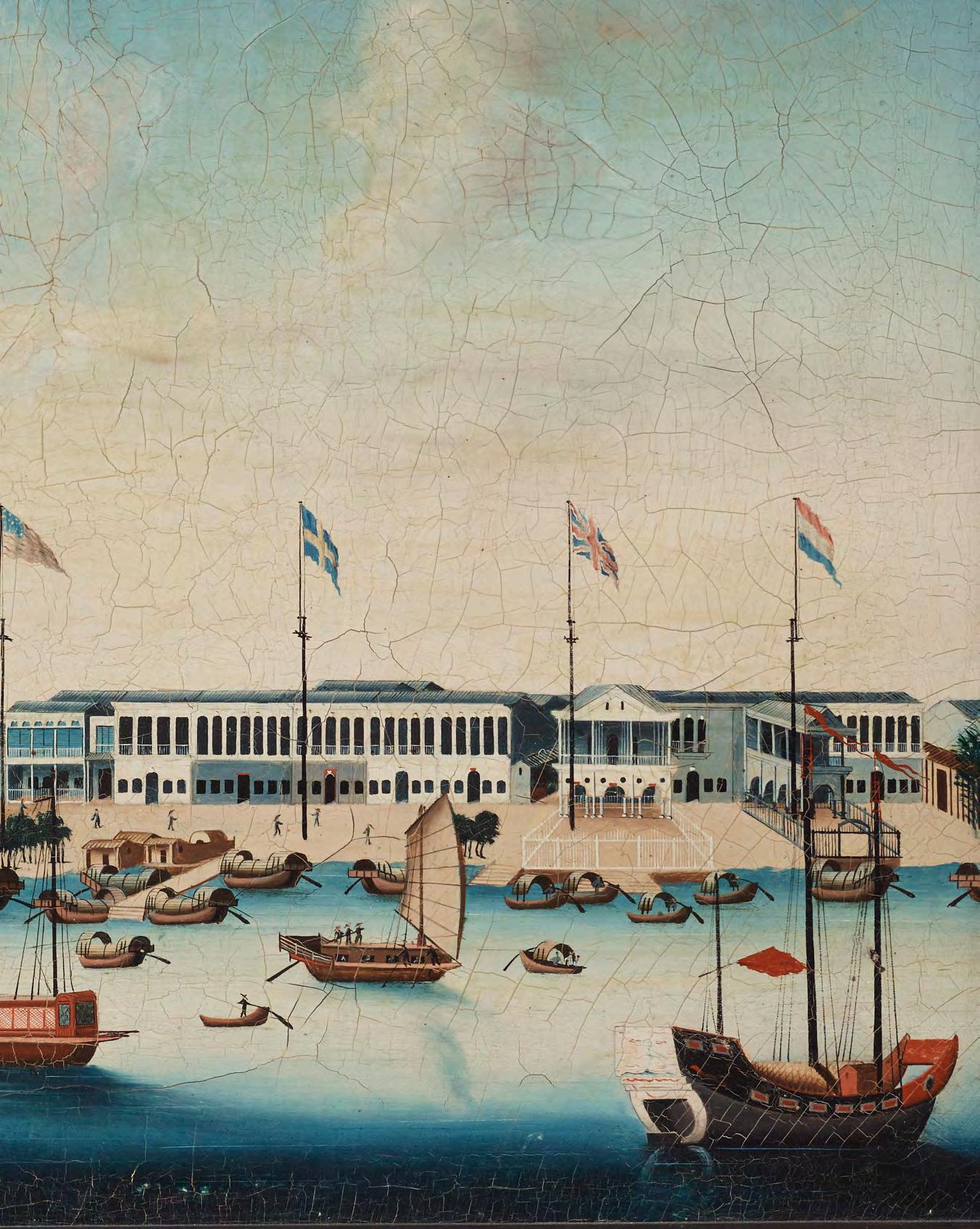
1069. A Collectors Library, part 14. A group of dictionarys and encyklopedias. (25 volumes).



Comprising; Eminent Chinese of the Ch’ing Period (1644-1912), Arthur W. Hummel, Taipei 1970. A Chinese Biographical Dictionary, Herbert A Giles, Taipei 1971. The Encyclopaedia Sinica, By Samuel Coulding, Taipei 1973. Nature in Chinese Art, by Arthur de Carle Swerby and Harry E Gibson, New York 1940. Chinese Symbolism and Art Motives, C. A. S. Williams, New York 1960. A Chinese-English Dictionary, 1978. Mathews’ Chinese English Dictionary, American Edition, Harward University Press, Massachusetts 1944. Substance and Symbol in Chinese Toggles, by Schuyler Cammann, Philadelphia 1962. Annual Customs and Festivals in Peking, by Tun LiCh’en, Hong Kong 1965. Chinese to English Dictionary, English Copy of Xinhua Zidian, California 1978. A Dictionary of Chinese Mythology, by E.T.C Werner, New York 1961. Myths and Legends of China, by E. T. Chalmers Werner, London 1924. Pointers and Clues to the Subjects of Chinese and Japanese Art by Will. H Edmunds. A Dictionary of Chinese Symbols, Routhledge & Kegan Paul, New York 1986. The Glossary of Chinese Art and Archeology, by S Howard Hansford, London 1972. A handbook of Chinese Art, by Margaret Medely, London 1964. Read Chinese, a beginning text in the Chinese Character, by Fang-Yu Wang, Connecticut 1968. Animals in the Chinese Zodiac, By T.C. Lai. Supplementary index to Giles Chinese Biographical Dictionary, compilded by Gillis and Yu, San Fransisco, 1979. Chinese Readers Manual, by William Frederick Meyers, Shanghai 1874. A Tourists Handbook of Conversation in Chinese, by Tong Lung, Hong Kong. Chinese for Beginners, Peking 1976. English-Chinese Dicitonary of Peking Colloquial, London 1933. Chinese Symbols and Superstitions, by Harry T. Morgan. Detroit 1972. Nagel’s Encyclopedia- Guide, China. Switzerland 1978. From the Collection of Ann Kreuger (l1926–2022).
SEK 10 000 – 15 000 / EUR 880 – 1 320
1070. Part 15.A lot with various old catalogues from Bonhams, Christies and Sothebys on the subject snuff bottles etc (68 cat).
Not a complete series, but dating from the year 1981–2008. In the subject snuff bottles but also catalogues on Chinese Works of Art.
Provenance: From the Collection of Ann Kreuger (1926–2022).
Estimate: SEK 4 000 – 6 000 / EUR 360 – 530
1071. A Collectors Library, part 16. A group of books about snuff bottles (26 volumes).
Comprising; Ma Shaoxuan, Inside-Paintind Snuff Bottle, Robert Hall, Chinese Snuff Bottles, volume I, II, III, IV. Hugh Moss, Chinese Snuff Bottles. I-IV. Moss, Chinese Snuff Bottles. Chinese snuffbottles for the Collection of Rt Hon. The Marquess of Exeter. Robert Kleiner, Important Chinese Snuff Bottles from The Mack Collection. Les tabatieres chinoises, Bob C Stevens. Chinese Snuff bottles, Lilla S Perry, Japan, 1968. Schnupf Bruder, Heiner Schaefer, Vol I-II, 1985. Miniature Art from Old China, Chinese Snuff Bottles from the Montclair Art Museum Collections, Schuyler V. R. Cammann, 1982. Chinese Snuff Bottles from the Edward Choate O’Dell Collection. Chinese Snuff Bottles of the Silica or Quartz Group, by Hugh M Moss. Chinese Snuff Bottles of the Chi’ing Dynasty. Hong Kong Museum of Art. Reflected Glory in a Bottle by Emily Burne Curtis, New York, 1980. The Medicine Snuff Bottle Connection, Raymond Li. A glossary of Chinese Snuff Bottle Rebus, Raymon Li. Snuff Bottle TErminology, Raymond Li. Chinese Snuff Bottle Themes, Raymon Li. Old Chinese Snuff Bottles, Henry C Ritt.)
Provenance: From the Collection of Ann Kreuger (1926–2022).
Estimate: SEK 6 000 – 8 000 / EUR 530 – 710
1072. A Collectors Library, part 17. A lot with old Christies and Sothebys catalogues, approximately 60 catalogues.

Comprising, Christies, The Ko Family Collection of Chinese snuff bottles, Vol I-VI, 1971–1976. Christies, Chinese Jades and Snuffbottles. May 10, 1976. Christies, Chinese Jades and Snuffbottles, July 11, 1979. Sothebys Catalogues in the subject snuff bottles, from 1969–1984.
Provenance: From the Collection of Ann Kreuger (1926–2022).
Estimate: SEK 4 000 – 6 000 / EUR 360 – 530
1073. A Collectors Library, part 18. A group of books by Osvald Sirén, five volumes.

Kinas trädgårdar, vol I-II. Stockholm 1948. Measurment 25 x 31 cm. Osvald Sirén, Bilder från Kina. 1936. Exlibris Orvar Karlbeck. And with dedication from the author to Mr Karlbeck. Measurement 25 x 31 cm.
Provenance: From the Collection of Ann Kreuger (1926–2022).
Estimate: SEK 4 000 – 6 000 / EUR 360 – 530
1074. A Collectors Library, part 19. A group of litterature about the Swedish Explorer Sven Hedin. (15 volumes).

Comprising; Sven Hedin som Tecknare, Gösta Montell och Folke Holm, Stockholm 1964. Hyllningsskrift tillägnad Sven Hedin, Stockholm 1935. Sven Hedin, den vandrande sjön, Stockholm, 1937. Pamflett, Sven Hedin Teckningar, Nationalmuseum 1978–1979. Asien, Tusen mil av okända vägar, Sven Hedin, Del I-II, Stockholm 1903. Stora hästens flykt, Sven Hedin, Stockholm 1935. Sidenvägen, Sven Hedin, 1936. Från pol till pol, Vol I-II, Sven Hedin, 1911. Gobiökninens gåtor, Sven Hedin, 1931, Från Peking till Moskva, Sven Hedin, 1924. Genom Asiens öknar, Sven Hedin, Jehol, Kejsarstaden, Sven Hedin, Stockholm 1931. Åter till Asien, Sven Hedin, Stockholm 1928.
Provenance: From the Collection of Ann Kreuger (1926–2022).
Estimate: SEK 6 000 – 8 000 / EUR 530 – 710
1075. A Collectors Library, part 20. A group of books in Swedish on travels in Asia. (29 volumes).
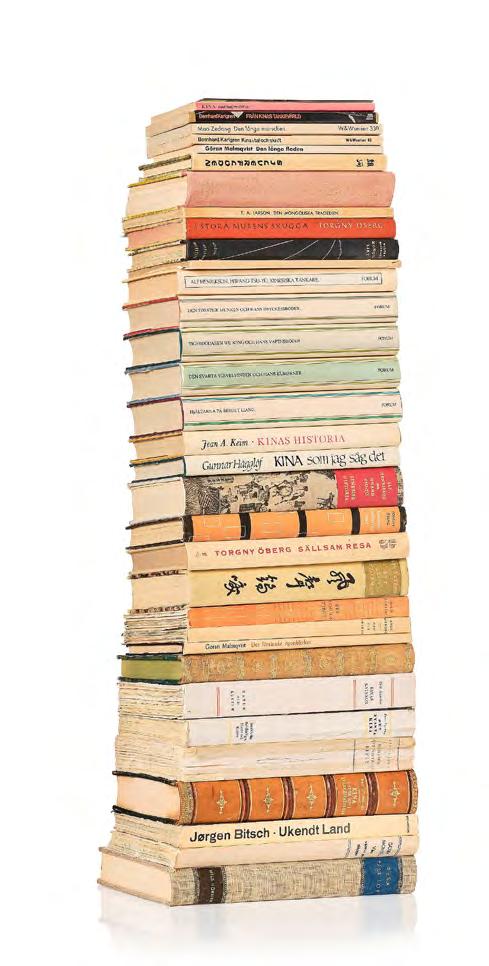

Comprising; Erik Nyström, Det nya Kina, Stockholm 1913. Karavan, Nils Ambolt, Stockholm 1935. På spår efter urmärnniskan, Roy Chapman Andrews, Stockholm 1923. Haslund Henning, Zajagan minnen och intryck från tre års vistelse i mongolernas nomadvärld. Stockholm 1934. Haslund Henning, Jabonah, äventyr och upplevesler bland Centralasiens nomader. Stockholm 1932. Haslund Henning, Asiatiska strövtåg, Stockholm 1945. Montell Gösta, Våra vänner på stäppen, genom Mongoliet till torgoterna vid Etsingol. Stockholm 1934. Gösta Montell, Bland gudar och vanliga människor, Stockholm 1942. A. H. Rasmussen, Slukad av Kinas Drake. Stockholm 1954. Japanska Studier och skizzer, Konni Zilliacus, Helsingfors 1896. Bland Kinseser och Mongoler, resor, af Alexis Kuylenstjerna, Vol I-II, Stockholm 1901. Resa uti Europa, Asia, Africa. vol I-II, C P Thunberg, Stockholm MCMLI. I Frärran Östern, reseskildringar från Indien, Kina, Japan, Tibet och Burma, Gustav Kreitner, Stockholm 1885. Det underbara Kina, Erik Nyström, Stockholm 1937. General Preschevalskys Forskningsresor i Centralasien, 1870-1885, Sven Hedin. Stockholm 1891. Bortom Kinesiska Muren, Georg Söderbom, Stockholm 1954. Asien Vaknar, Karl Hildebrand, Stockholm 1927. Stäppen och den goda jorden, Folke Boberg, Stockholm 1957. Sju resor i östern, G J Ramstedt, Stockholm 1961. Resa i Kina. M . Huc. Stockholm 1864. Resa i Mongoliet och Tibet, M Huc, Stockholm 1862. Bland Pilgrimer i Djingis Khans Land, upplevelser i Mongoliet, Folke Boberg, Stockholm 1945. En Ostindisk resa, Olof Toren, Stockholm. Marco Polos resor i Asien 1271-1295. Udevalla 1964. Mongoliet, den första folkrepubliken. Karl-Erik Norrman, Hans Engman, Halmstad 1969. På Tusenårig Karavan genom Mongoliet, Edgar v Hartman, Stockholm 1935. Kang Yu Weis svenska res 1904, Göran Malmqvist.)
Provenance: From the Collection of Ann Kreuger (1926–2022).
Estimate: SEK 4 000 – 6 000 / EUR 360 – 530
1076. A Collectors Library, part 21. A group of books on gemstones. (11 volymes).
Comprising. Jade Amuelets, Liberty & Co. Stenar i färg, Per Ludegård, Stockholm 1961. Gem Testing, B. W. Anderscon, London 1964. Antiques Jade, Milan 1969. Ädelstenarnas värld, Dr Rudolf Metz, 1965. Ädla stenar, C G Hallberg, Stockholm 1953. Diamenter och ädla stenar, Wilhelm Deines. 1964. Chinese Jades, throughtout the ages, Stanley Charles Nott, Japan 1966. The Book of Agathe, Leland Quick, 1963. Chinese Carved Jades, S. Howard Hansford, London 1968, Ädelstenar, Bernd Binnewies, 1975.
Provenance: From the Collection of Ann Kreuger (1926–2022).
Estimate: SEK 2 500 – 3 000 / EUR 220 – 270
1077. A Collectors Library, part 22. A group of books in Swedish on travels to Asia. (33 volumes).

Comprising; Mongoliet och mitt liv bland mongolerna, F. A. Larson, Hertig av Mongoliet, Stockholm 1929. Kina under sista änkkejsarinnan, af J. O. Bland och E. Backhouse, Stockholm 1912. Resa till Lop, Nils Hörner, Stockholm 1936. Unkendt Land, Rejse i Mongoliet, Jörgen Bitsch, Danmark 1962. Det nyaste Kina, Erik Nyström, Stockholm 1936. Våra vänner på stäppen, Gösta Montell, Stockholm 1934. Sällsam resa, Torgny Öberg, Stockholm 1958. I stora murens skugga, Torgny Öberg, Stockholm 1958. Karavanklockornas land, Torgny Öberg, Stockholm 1957. Tatt av Chinas Drage, A. H. Rasmussen, Oslo 1953. Den mongoliska tragedin, F A Larson, Stockholm 1950. Mongoliet, Walter Bosshard, Stockholm. Från Tält och Tempel i Fjärran Östern, Liljevalchs Konsthall, 1932. Det hemliga Tibet, Fosco Maraini, Stockholm 1955. Kinas Kvinnor, Erik Nyström, Stockholm 1940. Konsten att njuta av livet, av Lin Yutang, Stockholm 1940. Ett blad i stormen, av Ling Yutang, Stockholm 1943. Kinesisk historia, Alf Hernikson och Hwang Tsu-Yu. Stockholm 1967. Kina som jag såg det, Gunnar Hägglöf, Stockholm 1978. Kinas Historia, Jean A. Keim, Stockholm 1967. Kina i tal och skrift, Bernhard Karlgren. Från Kinas tankevärld, Bernhard Karlgren. Kina, tradition/revolution. Göran Malmquist, Bo Gyllensvärd. Det förtätade ögonblicket, Göran Malmqvist, Stockholm 1965. Den långa marschen, Maos 38 dikter, tolkade och kommenterade av Göran Malmqvist. Stockholm 1973. Den blå draken, Aage Marcus, Stockholm 1953. Den långa floden, Göran Malmqvist. Tusenårig japsnk lyrik i tolkning av Lotti Jeanneret. Den svarta virvelvinden och hans kumpaner, överstättnign av Göran Malmqvist. Hjältarna på berget Liang, översättning av Göran Malmqivst. Tigerdödaren Wu Song och hans vapenbröder, översättning av Göran Malmqvist. Den törstige munken och hans dryckesbröder, översättning av Göran Malmqvist. Kinesiska tängare, i urval av Alf Henrikson och Hwang Tsu-Yu.)
Provenance: From the Collection of Ann Kreuger (1926–2022).
Estimate: SEK 4 000 – 6 000 / EUR 360 – 530
1078. A Collectors Library, part 23. A group of books on China by Johan Gunnar Andersson. (4 volumes). Comprising; Den Gula Jordens Barn, Draken och de Främmande Djävularna, Mitt liv och min tro. Kina genom tidsåldrarna. Provenance: From the Collection of Ann Kreuger (1926–2022).
Estimate: SEK 2 500 – 3 000 / EUR 220 – 270
1079. A Collectors Library, part 24. A group of books on travels to Asia. (20 volumes). Comprising; Öst-Asien i våra dagar, Midtens Rike Kina, af Ernst von Hesse-Wartegg, Stockholm 1904. Kina, Folk och Land, fri översättning av Kjellman Göransson. Stockholm. Asiens underbara värld, Sällsamma upplevelser av Ferdinand Ossendowski, Stockholm 1924. Kinesiska språket i mittens rike, Johan Björksten, Stockholm 1993. Min son på galejan, eller en ostindisk resa. Jacob Wallenberg, Stockholm 1923. Det fagra landet, Sten Bergman, Stockholm 1962. Kamtchatka, Sten Bergman, Stockholm 1928. De tusen öarna i fjärran öster, Sten Bergman, Stockholm 1931. Två svenska japanfarare, Harald Hjärne, Stockholm 1923. Linnes Lärjungar, Resenärer i Floras Rike, Stockholm 1960. Svenskarna och Österlandet, T. J. Arne, Stockholm 1952. Chinas Handel, Industri och Stadsförfattning. C F Liljevalch, Stockholm 1848. På Jakt Efter ur Människans förfäder, Birger Bohlin, Stockholm 1944. De seglande österut, Charles David Ley, Stockholm 1961. Skattsökare i Kina, Orvar Karlbeck, Stockholm 1955. Tecknens rike, Cecilia Lindqvist, 1989. 400 miljoner kunder, Carl Crow, Uppsala 1937. Pehr Osbeck, Dagbok över ostindisk resa åren 1750, 1751, 1751 och 1757. Nyutgåva 1969. Captitaine Carl Gustav Ekebergs Ostindiska Resa åren 1770 och 1771. Nyutgåva. 1970. Charpentier Cossigny resa till China. Stockholm 1803.)
From the Collection of Ann Kreuger (1926–2022).
SEK 4 000 – 6 000 / EUR 360 – 530
1080. A Collectors Library, part 25. A group of books on Chinese Art and Works of Art in Swedish. (30 volymes).

Comprising; Ostindiska Compagniets Saga, Historien om Sveriges mäktigaste handelsföretag, av Eskil Olan, Göteborg 1920. Svenska Ostindiska Compagnierna 1731-1813, Sven T Kjellberg, Malmö 1974. Kinesisk Konst från stenålderskeramik till modern arkitektur, William Willetts, London 1965. Kejsarens Arme, Soldater och Hästar av lergods från Qin Shihuangs grav, Jan Wirgin, Stockholm 1984. Drakar, Gudar & Andar i den Kinsiska Mytologin, text av Tao Tao Lius Sanders. Milano 1983. Kinesiskt måleri, Michel Courtois, Geneve 1969. Die Ostaschiatische Tuschmalerei, von Ernst Grosse, Berlin 1922. Kinesiskt porslin och dess förhistoria, Bo Gyllensvärd, Motala 1977. Utställningen Arkeologiska Fynd från Folkrepubliken Kina. Drakens År, Mette Siggstedt, Stockholm 1988. Kinesiskt Siden, Mette Siggstedt, Stockholm 1990. Blomsterspråk, Mette Siggstedt, Stockholm 1986. Kinesisk Konst, Nationalmuseum, Stockholm 1959. Blåvitt Ming Porslin, Östasiatiska Museet, Stockholm 1964. En kinasamlares gåva, Axel och Nora Lundgrens samling av kinesisk keramik, bronser och måleri. Stockholm 1979. Kinesisk Konsthistoria, Jan Wirgin, Stockholm 1972. Kinesisk Konst, Maria Prodan, Italy 1957. Kina i kejsartid, Bo Särnstedt, Stockholm 1969. Kinesiska gravfiguriner, Mette Siggstedt, Stockholm 1987. Kinesiskt porsli och dess förhistoria, Bo Gyllensvärd, Västerås 1966. Kinesisk keramik, Bo Gyllensvärd, Stockholm 1948. Kinesisk Kalligrafi, Lars Berglund, Jubileumsskrift om tobak 1915-1965. Tobak, Kjell Collin, Stockholm 1963. Boken om Tobak, Ovre Richter Frich, Stockholm 1934. boken om Tobak OVre Richter Frich. Tabak, seit Anno Tobak, Munchen 1961. Kina som Hobby, Gustaf Hillerström samling, Stockholm 1968. Gustav VI Adolfs Gåva, Stockholm 1975. Kinesiska Konstskatter ur H. M. Konungens samling, Stockholm 1967. Chinesische Lackarbetiten, Ein Brevier, von Martin Feddersen, Berlin 1958.Japansk lackkonst, Lars Berglund, Jan Wirgin. Kinesiska Mattor och Skulpturer ur Nils Nessims samling, Stockholm 1960. Kinesiska mattor, Östasiatiska Museet, Stockholm 1986. Skönthetens spegel, konstskatter från Indien, Östasiatiska Museet, Stockholm 1987. Kina, Kejsare, dynastier och konstskatter, Bamber Gascoigne, Stockholm 1974. Samt en uppsättning matrikel från Östasiatiska museets vänförening.)

Provenance: From the Collection of Ann Kreuger (1926–2022).
Estimate: SEK 4 000 – 6 000 / EUR 360 – 530

The Collection of Sven Lindqvist
From the Collection of Sven Lindqvist (1932–2019), a well renowned Swedish author whose 35 books range from travel and reportage to essays, aphorisms, autobiography, and documentary prose. 1960–62 he studied at Peking University and was 1961–62 cultural attaché at the Swedish Embassy. He formed a life-long attachment to Chinese Art and culture, especially calligraphy. During his studies at Peking University Lindqvist was fascinated by a Tang dynasty painter famous for his murals: Wu Tao-tzu. The legend has it that he – after having just finished a wall-painting, he suddenly clapped his hands and a gate in the painting opened. Wu Tao-tzu entered into his art, the gate closing behind him, and he was never seen again. The Myth of Wu Tao-tzu, by Sven Lindqvist, (Bonniers 1967, in English, Granta 2012), is the story of what happened to the painter in the painting.
 LOT 1081 – 1089
LOT 1081 – 1089
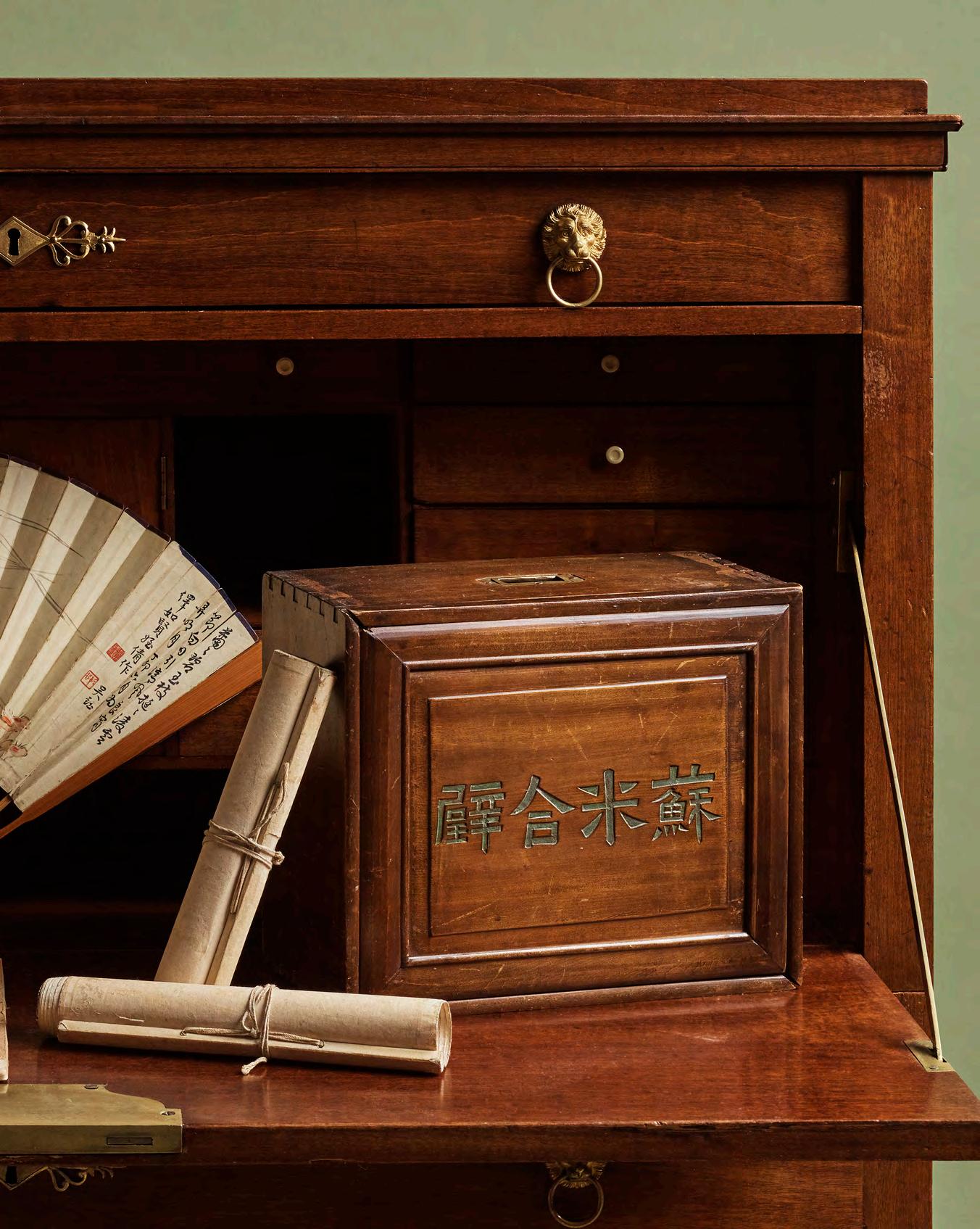
1081. Two scroll paintings with calligraphy, signed Bao Shichen (1775–1855).

Black calligraphy against a yellow ground. That reads Jingxin zongsi shi. Measurement motif 12.5 x 64 cm. Measurement hanging 23 x 112 cm.
Provenance: From the Collection of Sven Lindqvist (1932–2019).
Estimate: SEK 20 000 – 30 000 / EUR 1 760 – 2 640
1082. A scroll painting after Song Huizong, Qing dynasty. Ink and colour on silk, laid on paper. With three seals in red and with calligraphy. Depicting a bird of pray in a garden setting. Measurement motif 45 x 100 cm. Measurement hanging 52 x 136 cm.

Provenance: From the Collection of Sven Lindqvist (1932–2019).
Estimate: SEK 10 000 – 12 000 / EUR 880 – 1 060
1083. A Chinese fan painting, ink and colour on silk laid on paper, after a Song dynasty painting, Qing dynasty.
With seal in red. For a sunfan. Painted with two birds in a tree. Measurment 27.5 x 26.5 cm. Measurement hanging 36 x 110 cm.

Provenance: From the Collection of Sven Lindqvist (1932–2019).
Estimate: SEK 4 000 – 6 000 / EUR 360 – 530
1084. A Chinese fan painting, ink and colour on paper, Qing dynasty, 19th Century.
Round. With calligraphy and a seal in red. Depicting a bird in a blossoming cherry tree against a blue sky. Diameter fan 26 cm. Measurment with frame 35 x 38 cm.

Provenance: From the Collection of Sven Lindqvist (1932–2019).
Estimate: SEK 4 000 – 6 000 / EUR 360 – 530
1085. A Chinese fan with Calligraphy by Ma Xulun (1884–1970).

One side with elegant challigraphy, the other painted with flowers and lingzhifungus, as well as with calligraphy. Ma Xulun was a politician, lingquist and activist. This fan was given by him to Mr Yiru as a gift. Length folded 33 cm. Length unfolded 52 cm.
Provenance: From the Collection of Sven Lindqvist (1932–2019).
Estimate: SEK 8 000 – 10 000 / EUR 710 – 880
1086. A scroll painting of bamboo, after a Song dynasty painting, probably late Qing dynasty / 20th Century.
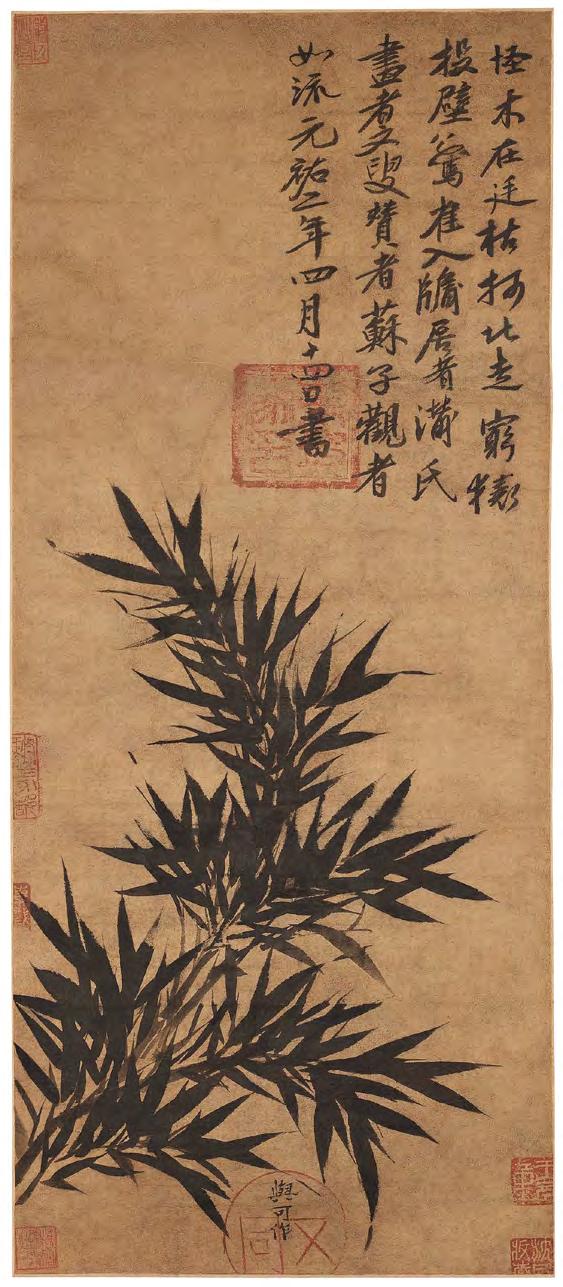
With several seals in red. Depicting bamboo and calligraphy. Measurement motif 29 x 67 cm. Measurement hanging 50x220 cm.
Provenance: From the Collection of Sven Lindqvist (1932–2019).
Estimate: SEK 4 000 – 6 000 / EUR 360 – 530
1087. A collection of rubbings of the calligraphy of two Song dynasty artists Su Shi and Mi Fei, early 20th Century.
In a wooden box. 24 booklets inside the wooden box that measures 15,5 x 30x25 cm.
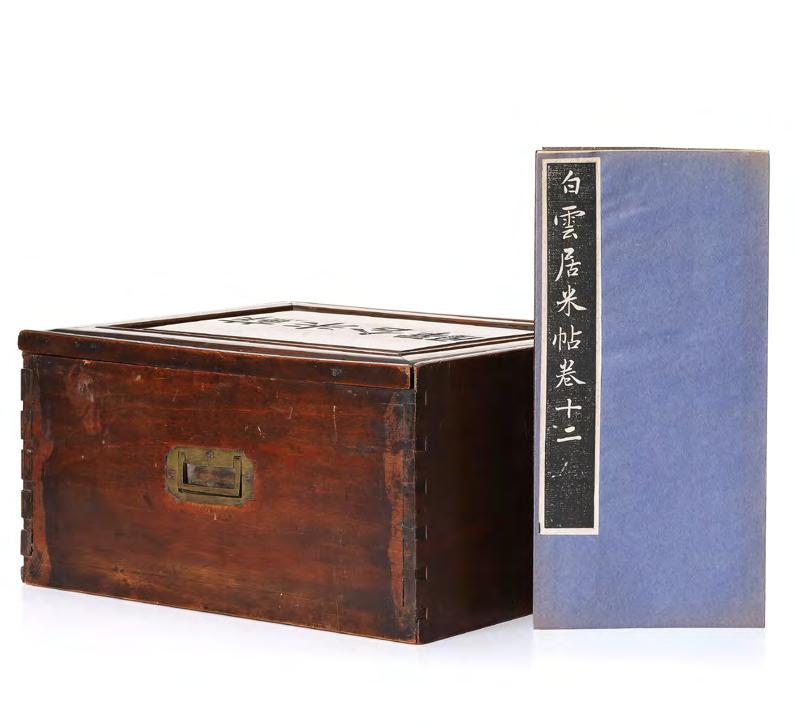
Provenance: From the Collection of Sven Lindqvist (1932–2019).
Catalogue note: Mi Fu (Chinese: 米芾 or 米黻 ; pinyin: M ǐ Fú, also given as Mi Fei, 1051–1107 CE)[1] was a Chinese painter, poet and calligrapher who was born in Taiyuan during the Song dynasty. He became known for his style of painting misty landscapes. This style would be deemed the “Mi Fu” style and involved the use of large wet dots of ink applied with a flat brush. His poetry was influenced by Li Bai and his calligraphy by Wang Xizhi. Mi Fu is regarded as one of the four greatest calligraphers of the Song dynasty, alongside Su Shi, Hung Tingjian and Cai Xian. His style is derived from calligraphers in earlier dynasties, although he developed unique traits of his own.
Estimate: SEK 6 000 – 8 000 / EUR 530 – 710
1089. Casual Literary Notes by the Studio of Anjian. The original titel was inscribed by Sun Zhutang (1879–1943).

In the sping of the year of Gengzhen (1920). Mått 15.3 x 26 cm.
Provenance: From the Collection of Sven Lindqvist (1932–2019).
Catalogue note: Sun Zhuang was a native of Beijing, a calligrapher and collector of bronzes and stones, and served as a manager of the Commercial Press.
Estimate: SEK 4 000 – 6 000 / EUR 360 – 530
1088. A print of the 'Remaining Ink of Ming Virtues, in a wooden case, two volumes.

In a wooden album. Measurment 20x32.5 cm.
Provenance: From the Collection of Sven Lindqvist (1932–2019).
Estimate: SEK 15 000 – 20 000 / EUR 1 320 – 1 760
1090. A large gilt copper alloy figure of Tara, Ming dynasty (1368–1644).
Portrayed seated in lalitasana with hands in varada- and vitarkamudra, with downcast eyes beneath a tiered crown fronting a tall chignon, wearing a dhoti, elaborate jewelry and long scarf, with long-stemmed lotus issuing from the palms and rising to the shoulders, the pendent right foot going over the double lotus throne. Height 26 cm.
Provenance: From the collection of a Swedish couple who were members of the Swedish Missionsförbundet in Falköping (Mission Covenant Church of Sweden, founded in 1878). They aquired it from members of their congregation who were missionarys in China in the early 20th Century. Thence by descent to their grandchildren.
Exhibitions: Compare a dated tara at, Sothebys, Important Chinese Works of Art / 17 March 2015 • New York. Lot 377.
Estimate: SEK 200 000 – 250 000 / EUR 17 590 – 21 990


Lot 1090.
1090. A large gilt copper alloy figure of Tara, Ming dynasty (1368–1644).
1100. A gilt bronze Pala-revival sculpture of Amitayus, 18/19th Century, possibly Mongolian.
From an esteemed Finnish collector and mecenat of the Arts, the major part of the collection was brought together during 1920–1960, thence by descent.
 LOT 1091 – 1094
LOT 1091 – 1094
1091. A gilt-bronze figure of Vairochana, Ming dynasty (1638–1644).
The Primordial Buddha sits in dhyanasana with the hands clasped in a form of vajramudra. He is clad in voluminous robes with hems elegantly incised with a foliate pattern. Svastika to his chest. The face is serene in expression and surmounted by a tiara with diminutive Buddha images. Height 18 cm.
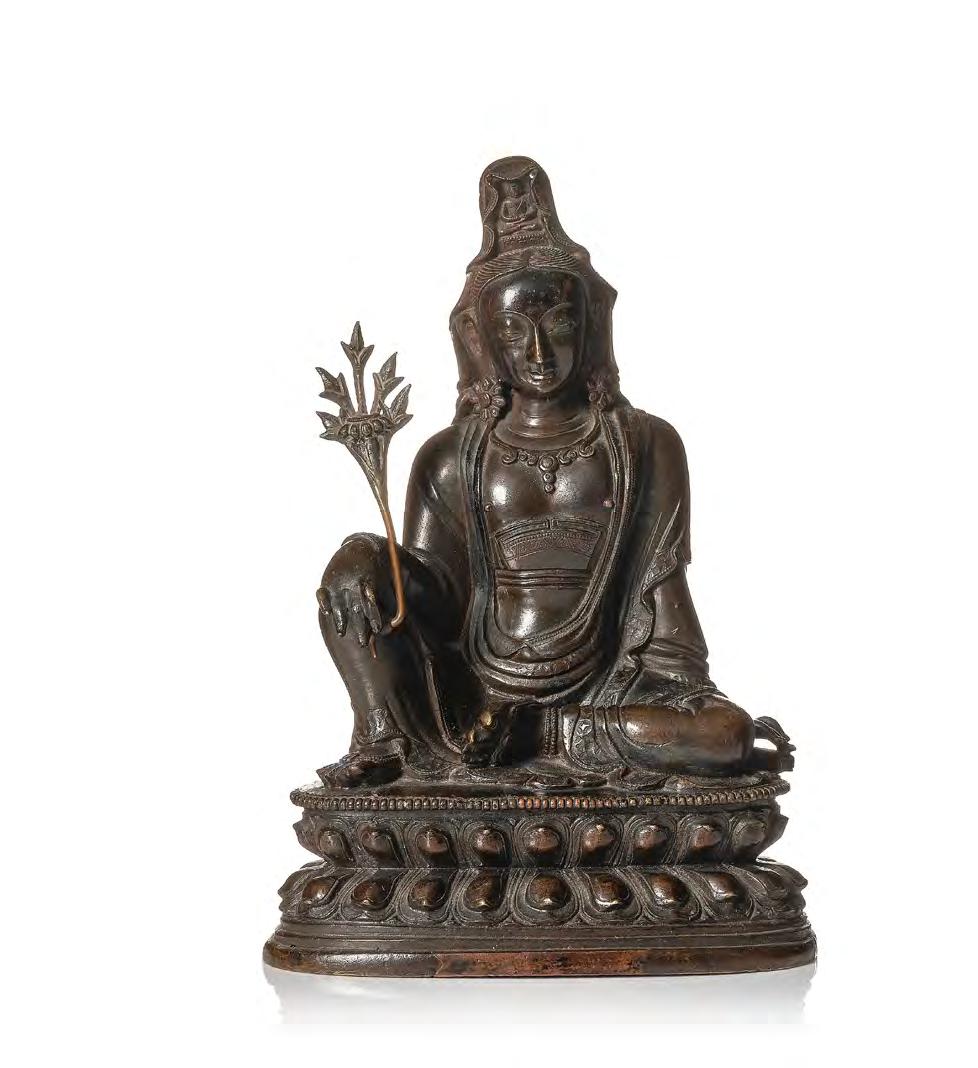
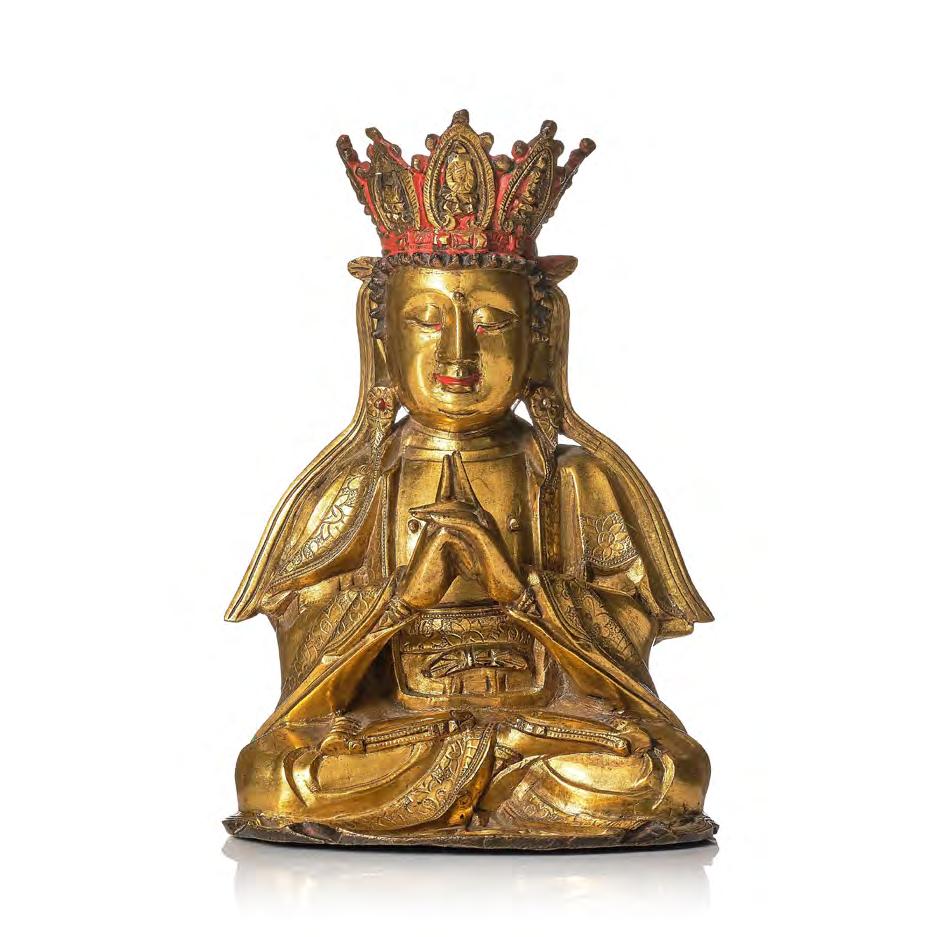
Provenance: From an esteemed Finnish collector and mecenat of the Arts.
Exhibitions: A few related examples in gilt-bronze have been sold at Christie’s; in particular, compare the present work with a gilt-bronze figure of Vairochana sold at Christie’s New York on 15 September 2011, lot 1383.
Catalogue note: The present gilt-bronze figure of Vairocana is an excellent example of its type, exhibiting fine casting, especially in the hems of the robes and the openwork crown. Vairochana is considered to be the Great Solar Buddha of Light and Truth, and is the Bliss Body of the historical Buddha in Buddhist Law. Vairochana is also considered one of the Five Dhyani Buddhas, also known as the Five Wisdom Tathagatas, which are representations of the five qualities of the Buddha. The latter is represented by the five diminutive Buddha images in the crown of the present figure.
Estimate: SEK 60 000 – 80 000 / EUR 5 280 – 7 040
Provenance: From an esteemed Finnish collector and mecenat of the Arts.
Estimate: SEK 40 000 – 60 000 / EUR 3 520 – 5 280
1092. A gilt-bronze figure of a Boddhisattva,
(1638–1644). The avalokiteshvara sits in dhyanasana with the hands clasped in a form of vajramudra. He is clad in voluminous robes with hems elegantly incised with a foliate pattern. The face is serene in expression and surmounted by a tiara with diminutive Buddha images. Around the back there is 18 arms, some still holding attributes. Height 17,5 cm.
Provenance: From an esteemed Finnish collector and mecenat of the Arts.
 Ming dynasty
1093. A bronze figure of Avalokiteshvara, Qing dynasty, 18th Century. Depicted seated in a royal ease on a double lotus throne, holding a pearl in one hand. Height 17 cm.
Ming dynasty
1093. A bronze figure of Avalokiteshvara, Qing dynasty, 18th Century. Depicted seated in a royal ease on a double lotus throne, holding a pearl in one hand. Height 17 cm.
1094. A bronze figure of a crowned goddess, Qing dynasty, Crowned, seated on a double lotus throne. Height 17 cm. From an esteemed Finnish collector and mecenat of the Arts, the major part of the collection was brought together during 1920-1960, thence by descent.
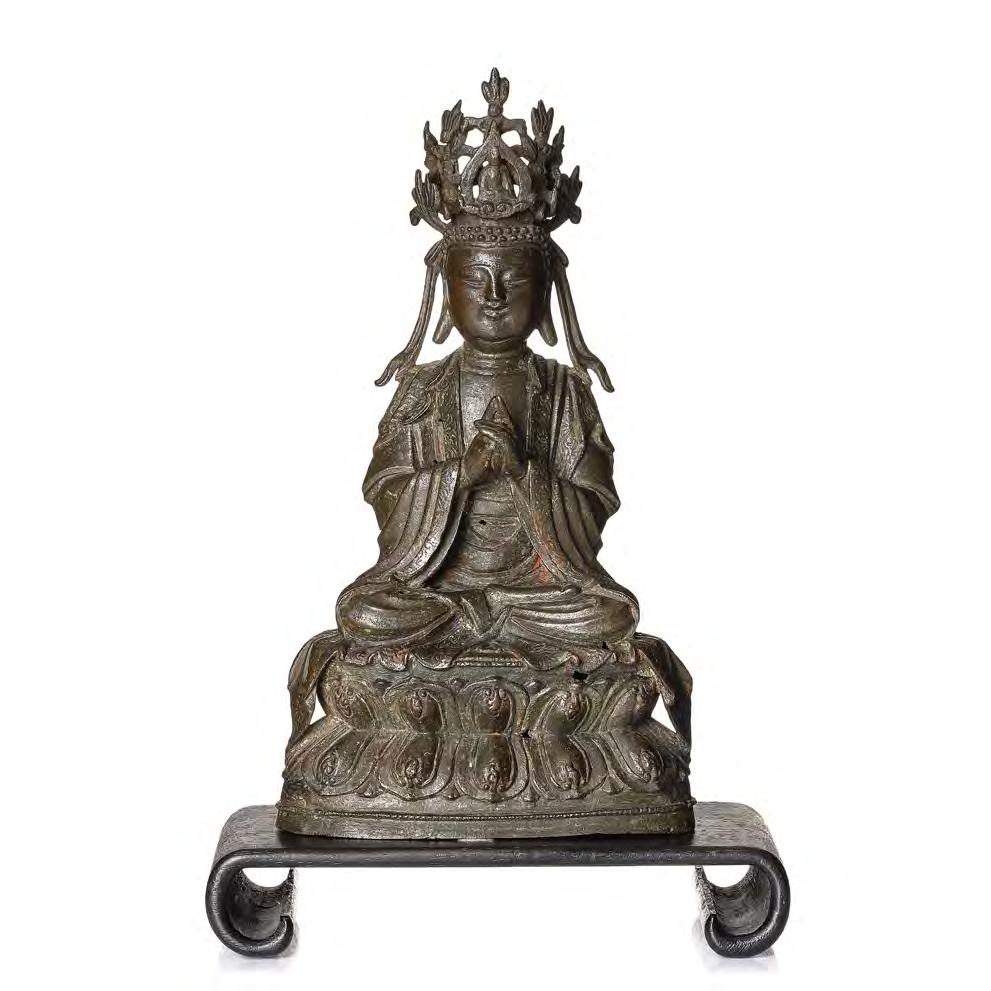
SEK 40 000 – 60 000 / EUR 3 520 – 5 280
1095. A bronze scultpure of Guanyin, Ming dynasty (1368–1644). Seated in a meditative pose on a double lotus throne, large pierced crown with amitayus buddha to the center, clad in a dhoti that is draped over the edge of the throne. Height 23 cm. Height with wooden stand 27 cm.


Provenance: From a private Scandinavian Collector.
Catalogue note: Guanyin is a Bodhisattva associated with compassion.
Estimate: SEK 15 000 – 20 000 / EUR 1 320 – 1 760
1096. A bronze scultpure of Guanyin, Ming dynasty (1368–1644). The godess is depicted seated, down cast eyes, wide forehead, large crown with phoenix birds, clad in an elaborately decorated robe, holding a stele in her hands. Traces of lacquer and cold gilt. Height 34 cm. Property of a Swedish Estate.
Guanyin is a Bodhisattva associated with compassion.
SEK 8 000 – 10 000 / EUR 710 – 880
1097. A bronze figure of Guanyin, late Ming dynasty (1368–1644). Depicted as a crowned deity with a lotus branch in one hand, by the left shoulder a bird, by the rigth shoulder there has been a vase, now missing. Height 27 cm.

Guanyin is a Bodhisattva associated with compassion.
SEK 12 000 – 15 000 / EUR 1 060 – 1 320
1098. A gilt copper figure of Amitayus, Tibeto-Chinese, 18th Century.
Seated in dhyanasana on a double lotus base, hands folded in his lap, wearing long flowing robes incised with detailed floral scroll borders, beaded necklaces, armlets and bracelets once inset with various hardstones, only one stone left, his face with a serene expression. Sealed base with double vajra. Traces of paint.
Height 19 cm.
Provenance: Purschased at Bukowskis, 2015, Stockholm 589, lot 109. Then from a Scandinavian Collection.
Estimate: SEK 50 000 – 75 000 / EUR 4 400 – 6 600
1099. A gilt copper alloy figure of buddha, Nepal, 18th Century. Seated in Dhyanasana on a double-lotus base with his hands in Bhumisparshamudra, dressed in a diaphanous anghati with the folds draped over the shoulder and gathered beneath the ankles, the face with bow-shaped mouth and elongated eyes flanked by pendulous pierced earlobes, the hair in tight curls over the Ushnisha and topped with a knop. Height 17 cm.


Puchasedn in the early 1970's, thence by descent within the family.
SEK 25 000 – 30 000 / EUR 2 200 – 2 640
1100. A gilt bronze Pala-revival sculpture of Amitayus, 18/19th Century, possibly Mongolian. Finely cast seated in vajraparyankasana on a double-lotus base, depicted with hands held in dhyana mudra supporting a bumpa, his face with a serene expression and framed by an elaborate headdress and a pair of pendulous earlobes adorned with ornamental earrings, clad in loose clothing with finely detailed floral hems and and neatly folded by the lotus base. Traces of cold gilt and enamels. Height 14.5 cm.

Literature: Tibetan Buddhism was patronized by the Qing emperors, both for personal and political reasons, resulting in a surge in the production of Buddhist sculpture and painting. During the reign of Qianlong, the artisans of the Beijing workshops increasingly emulated sculpture from different periods and geographic areas, using as models the bronzes given as gifts from Tibetan dignitaries to the Qing court. Examples of Pala-style sculpture, from ninth-twelfth century Northeastern India, still remain in The Palace Museum Collection. Compare with a Pala-period bronze figure of Vajrasattva, illustrated in Cultural Relics of Tibetan Buddhism Collected in the Qing Palace, Beijing, 1992, Catalogue no. 56, and with a Pala-style Tibetan brass statue of Manjushri (see ibid., cat. no. 53).
Estimate: SEK 15 000 – 20 000 / EUR 1 320 – 1 760
1101. A Mongolian, partly gilt repoussé sculpture of Amitayus, 19th Century.
Depicted seated on a double lotus throne. Crown made separately. Height 18 cm.
Provenance: Purchased at auction in Norway after the Director General of the Chinese Postal Service Erik Tollefsen (1872–1938).
Estimate: SEK 50 000 – 75 000 / EUR 4 400 – 6 600
1102. A Tibeto Chinese figure of Avalokiteshvara, late Qing dynasty, circa 1900.
A standing 8 armed 11 headed figure of avalokiteshvara, clad in a loose dhoti with pendelous earrrings. Traces of colour pigment to the faces. Closed base with placque. Height with wooden stand 23 cm.
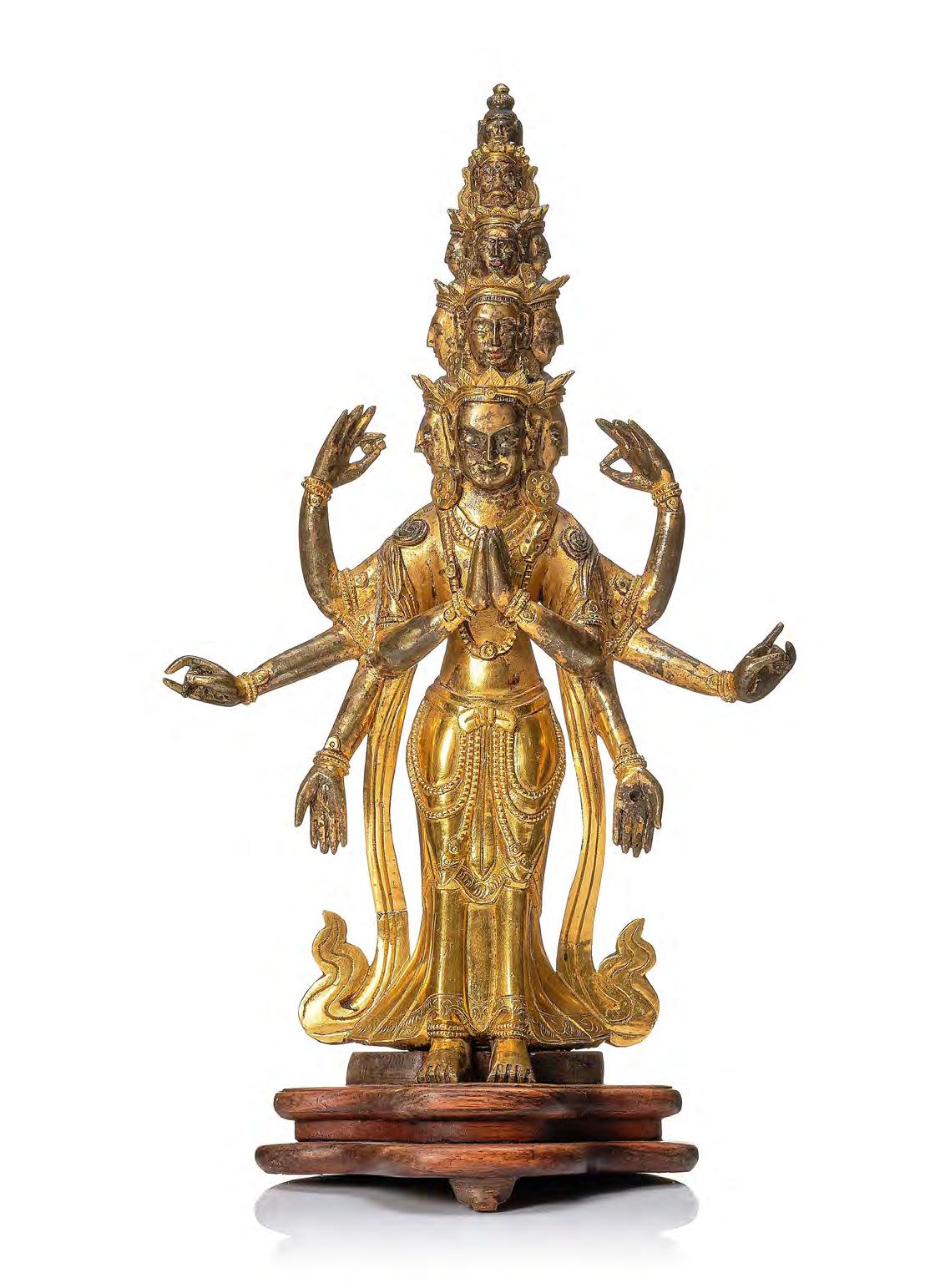
From the Estate of a Private Swedish Collection. SEK 8 000 – 10 000 / EUR 710 – 880

1103. A Tibetan gilt bronze throne with moongoose, 19th Century.
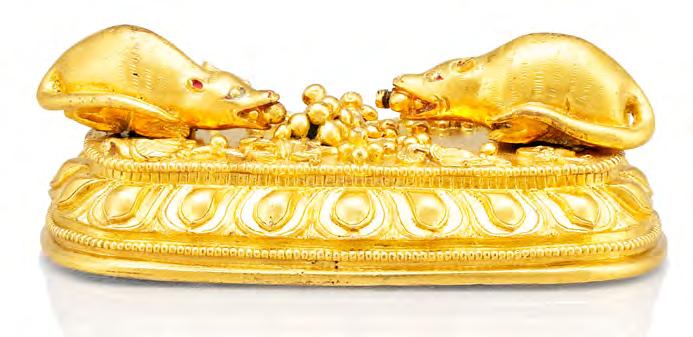
Two moongoses who are puking out gems on a lotus throne, surrounded by buddhist emblems. Length 9 cm. Traces of paint by ears. Height 3 cm.
Provenance: From a Private Swedish Collector, who purchased it from an antique dealer in Stockholm.
Catalogue note: The Buddhist god of wealth Vaiśrava ṇ a (also known as Kubera or Jambhala in Sanskrit) is frequently depicted holding a mongoose in his left hand which spews out jewels from its mouth. The mongoose is the enemy of the snake, a symbol of greed; the ejection of jewels represents generosity.
Estimate: SEK 8 000 – 10 000 / EUR 710 – 880
After the bronze modell, gilded and enamelled. Length 16.5 cm.
Provenance: From a private Swedish Collection.
Exhibitions: Compare with deities made in porcelain from the Qianlong period. For example see Sothebys, sale PF1027, Lot 196. Also see Christies, Auction 2339, Fine Chinese Ceramics and Works of Art lot 1494. 17 Sep 2010.
Also see Registration number Franks.582.+ In the collection of the British Museum.
Catalogue note: The Vajra ‘Thunderbolt’ is a legendary and ritual weapon, symbolising the properties of a diamond (indestructibility) and a thunderbolt (irresistible force). The vajra is a type of club with a ribbed spherical head. The ribs may meet in a ball-shaped top, or they may be separate and end in sharp points with which to stab. The vajra is the weapon of Indra, the Vedic king of the devas and heaven. It is used symbolically by the dharmic traditions of Hinduism, Buddhism, and Jainism, often to represent firmness of spirit and spiritual power.

Estimate: SEK 10 000 – 15 000 / EUR 880 – 1 320
1105. A silk buddhist Kesa cloth/mantel, 19th century.
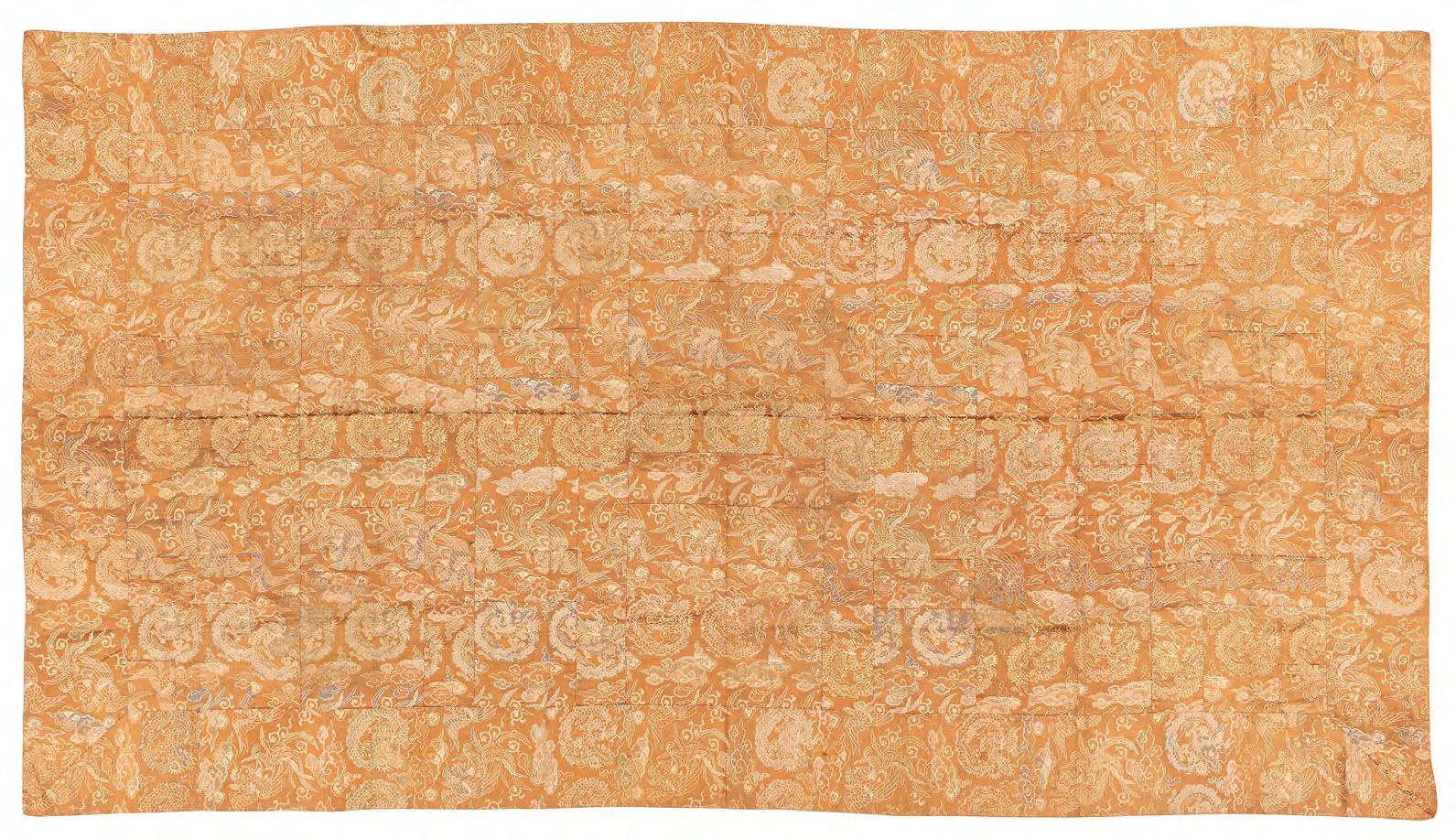
The silk brocade is a pale orange/rusty red colour and finely woven with designs of dragons and phoenix birds amidst cloud formations. The back of the fabric has written characters. Measurement 117 x 210 cm.
Catalogue note: The kesa is worn draped diagonally over the left shoulder and under the right armpit. Meant as a reminder of the Buddha's own simple patched garment, kesa are formed from many fragments of the same cloth. Within each garment, the fragments are typically organized in a series of columns framed by a border with angled corners. The number of columns, indicates both the specific function of that garment and also the rank of the wearer within the religious hierarchy.
Estimate: SEK 6 000 – 8 000 / EUR 530 – 710
1106. A Tibetan thangka of Vajrabhiarava with Tsongkhapa at the top, 19th Century.

The central figure on this large powerful thangka is Yamantaka Vajrabhairava, the main tutelary deity of the Gelug order of Tibetan Buddhism, dark blue in color, with nine heads, thirty-four arms and sixteen legs. The main head is that of a wrathful buffalo with two horns, whilst the small topmost head is that of Manjushri, indicating that Yamantaka Vajrabhairava is the wrathful tantric form of Manjushri, the bodhisattva of wisdom. Yamantaka Vajrabhairava (also known as the Death Tamer and the Diamond Terrifier) is especially important for the Gelugpas, due to lineage founder Lama Tsongkhapa’s special assocation with Manjushri, the Conqueror of Yama. he embraces his pale blue consort, Vajravetali; together they symbolize the union of method and wisdom. In his hands he holds various tantric implements which symbolically destroy all defilements and all enemies of the dharma, whilst underfoot he tramples on numerous animals, birds, humans and devas. Measurment motif 51.5x72.5 cm. Measurment with silk brocade lining 51x150 cm.
Provenance: The collection of Dr Herman (1884–1959) och Hedvig Lindvall. Thence by descent to Nils Lindvall (1922–2008), thence by decent.
Exhibitions: For other lots from this collection, see Bukowskis Live Sale 559, 2010.
Estimate: SEK 20 000 – 25 000 / EUR 1 760 – 2 200
1108. A Tibetan painting/fragment, canvas laid on board, anonymous artist, 18/19th Century.

A daoist dignitary with an attendant in the shape of a mythical creature. Measurment with frame 39 x 70 cm.

Provenance: Stig and Kerstin Dillberg. Thence by descent to the present owner.
Estimate: SEK 6 000 – 8 000 / EUR 530 – 710
1107. A Tibetan Thangka of Green Tara, 19th Century. The central figure of Green Tara is flanked by bodhisattvas. Above her three lamas, and Amithaba buddha. Below Tara are a fierce deites with mortal attendants playing music and carrying offerings. Framed in an old silk brokade with firece five clawed dragon facing each other. Measurment with lining hanging 146 x 71 cm. Measurement motif 44 x 70 cm.
Exhibitions: Once she achieved complete enlightenment, Tara promised to return in a female form to benefit all beings. Meditational practices and visual descriptions of Tara appear in all schools of Buddhist tantra. She is usually depicted as a beautiful young woman, commonly either green (for all types of meditation), white for longevity, and red for power. There are close to two hundred different meditational forms of Tara, varying in color, number of faces and limbs, and in peaceful or wrathful countenances. In this painting, Green Tara is flanked by Marichi to her right, the peaceful deity with clean skin and bright white clothing, and to her left by Ekajati, the ash-covered wrathful deity with third eye wrapped in a tiger skin.
Estimate: SEK 30 000 – 50 000 / EUR 2 640 – 4 400
1109. A mirror stand, Ming dynasty (1368–1644).
A reclining mythical horned beast with a holder for a mirror on its back. Height 29 cm. Lenght 30 cm.

Provenance: Property of a Swedish private collection.
Literature: Mirror stands such as the present lot were popular and made over a long period of time. In Later Chinese Bronzes, London, 1990, cat. no. 87, Rose Kerr illustrates a gilded example from the Salting Bequest in the Victoria & Albert Museum, which she dates to the Song / Yuan dynasty. Ming dynasty examples sold at auction include one from the collection of Ulrich Hausmann, sold at Sothebys, Hong Kong rooms 8th October 2014, lot 3370, and another sold at Sothebys, London rooms, 9th November 2011, lot 391.
Estimate: SEK 10 000 – 15 000 / EUR 880 – 1 320
1111.
1110. A archaistic bronze vase, Ming dynasty (1368–1644).

Archaistic bronze model in baluster shape. Decorated with taotie masks and stylized floral and lotus patterns. Height 29.5 cm.
Estimate: SEK 8 000 – 10 000 / EUR 710 – 880
(1368–1644).
The warrior lord depicted seated with his beard in his hand, clad in armour. Height 23 cm.

Provenance: From the collection of P Wedendal.
Estimate: SEK 18 000 – 20 000 / EUR 1 590 – 1 760
A bronze sculpture of a warrior, Ming dynasty
1112. A bronze sculpture/joss stick holder, Ming dynasty (1368–1644).
Standing figure of a boy holding an ingot and a placque. Height 28 cm.
Provenance: From the Collection of P Wedendal.
Estimate: SEK 8 000 – 10 000 / EUR 710 – 880
1113. A bronze censer in the shape of a buddhist lion, Ming dynasty (1368–1644).
Standing stout on four legs, Height 16 cm.
From the Ankarcrona Collection. The foundation of the collection was laid by Rear Admiral/Flag officer Sten Ankarcrona (1861-1936). Ankarcrona first got a taste for the Asian Art while following his fathers’s footsteps serving as ‘enseigne de vaisseau’ for the French navy “la Royale” during the years 1885-1889, when his Fregatt sailed in the area. Ankarcrona continued to ad on to the collection, later in life when he was sent on a special mission to Japan in 1923. He brought back vast collections of lacquer, bronzes, textiles, ceramics. In 1911 the family moved to the mansion like duplex next to Sturegatan in Stockholm. The elegant home and their summer house at Brevik by Erstaviken where Ankarcrona created a Japanese garden (1923-27) and even set up a complete Japanese building was documented in the the magazine ‘Svenska Hem i ord och bild’ in 1928, which provide us with a fascinating window into this golden age of European collecting. The world renowned collection received many prestigious visitors throughout the years, the guest book contains signature of both the Swedish king Gustav VI Adolf as well as the Japanese crown prince, later Emperor Akihito.Stens son Sten S:son Ankarcrona (1904-1981, continued the tradition of collecting, amongst other things Swedish 18th Century furniture and art, pieces that worked well with family heirlooms from the Bergenstråhle, Bohnstedt, Cassel, Mörner and Lybecker families. Thence by descent.
Arts from the Scholar’s studio, the Oriental Ceramics Society of Hong Kong, 1986. page 232. It is not known when this type of censer was first created. But one sees them depicted on porcelain. The idea is that the smoke of the incense is to come out through the mouth… as if breathing smoke.
SEK 4 000 – 6 000 / EUR 360 – 530
1114. A large bronze censer, Ming dynasty (1368–1644).

Tripod with uppturned handles, pierced cover and finail in the shape of a buddhist lion with its paw on some lingzhi fungus. Height 45 cm.


Provenance: Property from a Swedish Private Collection.
Estimate: SEK 10 000 – 15 000 / EUR 880 – 1 320
1115. A bronze censer with cover, late Ming dynasty (1368–1644). Rectangular shape, with upturned handles, stanging stout on four legs. Pireced cover with a finial in the shape of a buddhist lion. Height 32 cm.
Provenance: Property from a Swedish Private Collection.
Estimate: SEK 12 000 – 15 000 / EUR 1 060 – 1 320

20.5 x 14.5 x
Provenance: Property of a Swedish private collection.
Estimate: SEK 8 000 – 10 000 / EUR 710 – 880
1116. A copper alloy censer, Qing dynasty, 18th/19th Century. Tripod with handles. Length 21.5 cm. Height with wooden stand 16 cm. Weight 3453 gram.

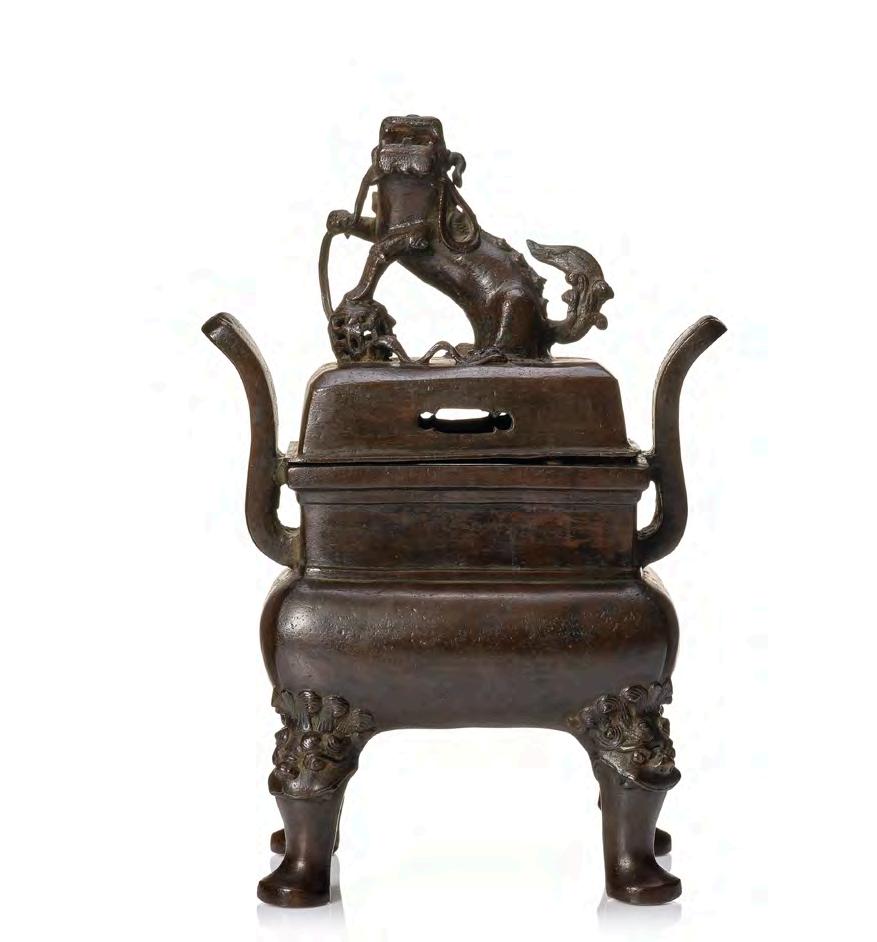
Provenance: Purschased at Bukowskis, sale 633, lot 860. From the Collection of Henrik Eugene Reuterswärd (1881-1964), thence by descent to Marina Reuterswärd. The buddhas, the painting and the bronses are listed in Henrik E Reuterswärds 1921 pre-nup upon his marriage to Ebba Ingeborg (Inge) Sjögren, at the time he lived in a 7 room flat at Storgatan 55, Östermalm, Stockholm. Henrik E Reuterswärd were employed by Mo and Domsjö Aktiebolag, from 1901, later MoDo, the company was later lead by the famous collector of Asian art Carl Kempe (1884-1967). Reuterswärd built his collection during the golden age of collecting in Europe. The interest for works of art from Asia were great at the time, this was enhanced by many factors such as; that the world renowned Swedish geographer, topographer, explorer, photographer, travel writer Sven Hedin 1865-1952 hade made several excursions to Asia 1898-1907. The famous China Club were founded in 1929. The Karlbeck syndicate were formed and Orvar Karlbeck (1879-1967) made several trips to acquire objects for collectors and Museums around the world. Henriks relative C.R. Patrik Reuterswärd (1885-1963) was posted as charge d’affaires in Tokyo, Peking and Shanghai 1911-1914.
Exhibitions: Compare with a censer of this type but with incised decoration in the British museum, Museum number, 1937,0315.1.a-b.
Estimate: SEK 40 000 – 50 000 / EUR 3 520 – 4 400
1117. A bronze with silver appliqué censer/flowerpot, 19th Century. Rectangular. Decorated in relief. Measurement
8 cm.
1118. A bronze sculpture of Sholaou and his deer, circa 1900.
In the shape of a seated figure of the deity. Heigth 22 cm. Width 20 cm.

Provenance: The collection of Dr Herman (1884–1959) och Hedvig Lindvall. Thence by descent to Nils Lindvall (1922–2008), thence by decent.
Exhibitions: For other lots from this collection, see Bukowskis Live Sale 559, 2010.
Estimate: SEK 8 000 – 10 000 / EUR 710 – 880
1119. A gilded lacquered bowl, Qing dynasty, Yongzheng/ Qianlong17th Century. The exterior decorated in relief with a continous lotus scroll beneath a ruyiband and with shou characters. All finely gilded in different gold tones. The interior in a dark yellow lacquer.

From the Collection of Rear Admiral/Flag officer Sten Ankarcrona (1861-1936). Ankarcrona first got a taste for the Asian Art while following his fathers’s footsteps serving as ‘enseigne de vaisseau’ for the French navy “la Royale” during the years 1885-1889, when his Fregatt sailed in the area. Ankarcrona continued to ad on to the collection, later in life when he was sent on a special mission to Japan in 1923. He brought back vast collections of lacquer, bronzes, textiles, ceramics. In 1911 the family moved to the mansion like duplex next to Sturegatan in Stockholm. The elegant home and their summer house at Brevik by Erstaviken where Ankarcrona created a Japanese garden (1923-27) and even set up a complete Japanese building was documented in the the magazine ‘Svenska Hem i ord och bild’ in 1928, which provide us with a fascinating window into this golden age of European collecting. The world renowned collection received many prestigious visitors throughout the years, the guest book contains signature of both the Swedish king Gustav VI Adolf as well as the Japanese crown prince, later Emperor Akihito.Stens son Sten S:son Ankarcrona (1904-1981, continued the tradition of collecting, amongst other things Swedish 18th Century furniture and art, pieces that worked well with family heirlooms from the Bergenstråhle, Bohnstedt, Cassel, Mörner and Lybecker families. Thence by descent.
Estimate: SEK 4 000 – 6 000 / EUR 360 – 530
1120. A cloisonne basin, late Ming dynasty (1368–1644).
Decorated in the enamels yellow, green, white, blue and red against a turqouise ground with lotus, flying horses and buddhist lions.
Diameter 34.8 cm.
Provenance: Property of a private Swedish Collection.
Literature: Compare a similar dish in; Compendium of Collections in the Palace Museum, no 94. Gu 118611. 2011.
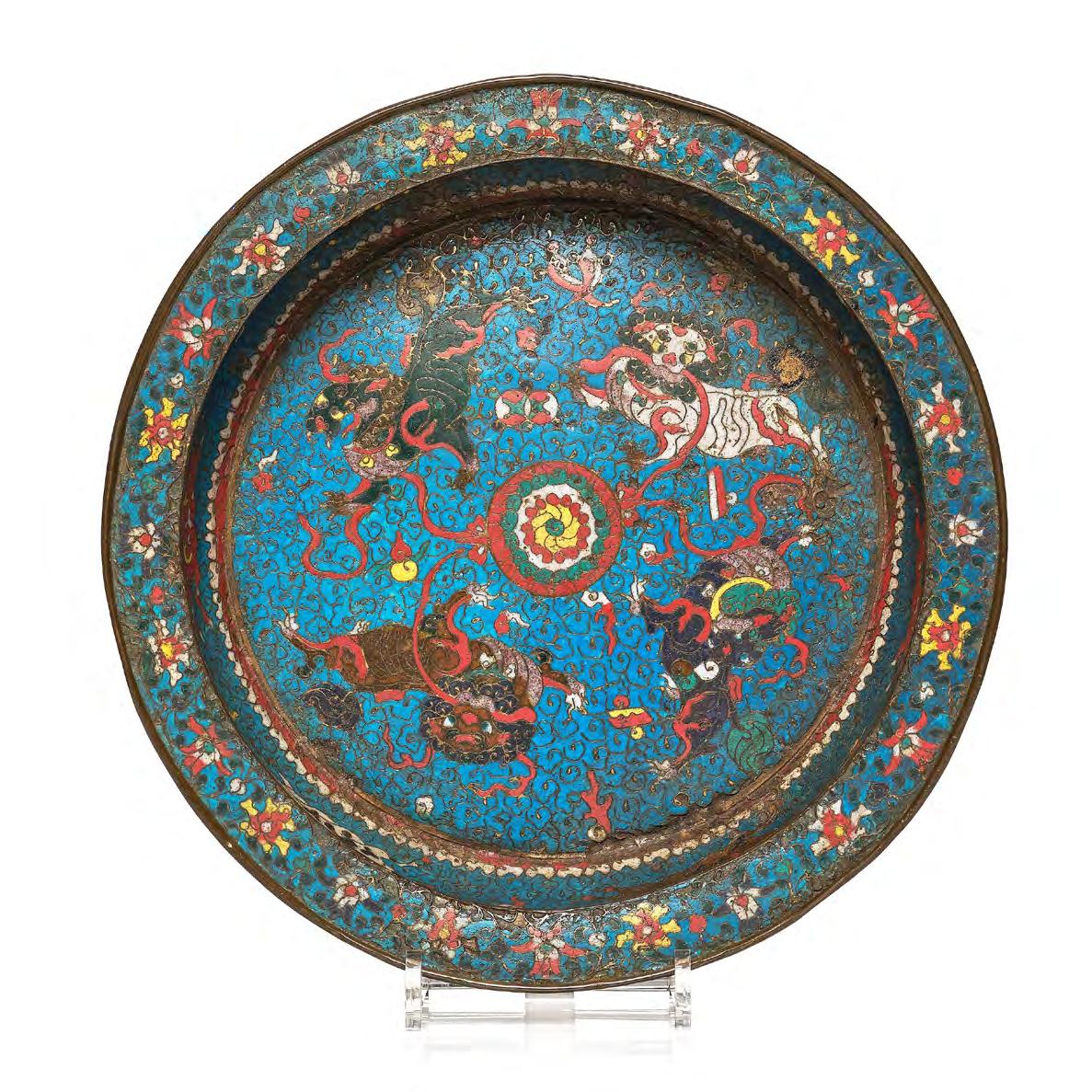
Estimate: SEK 6 000 – 8 000 / EUR 530 – 710
1121. A hu shaped cloisonné vase, late Mingdynasty/early Qingdynasty, 17th Century.
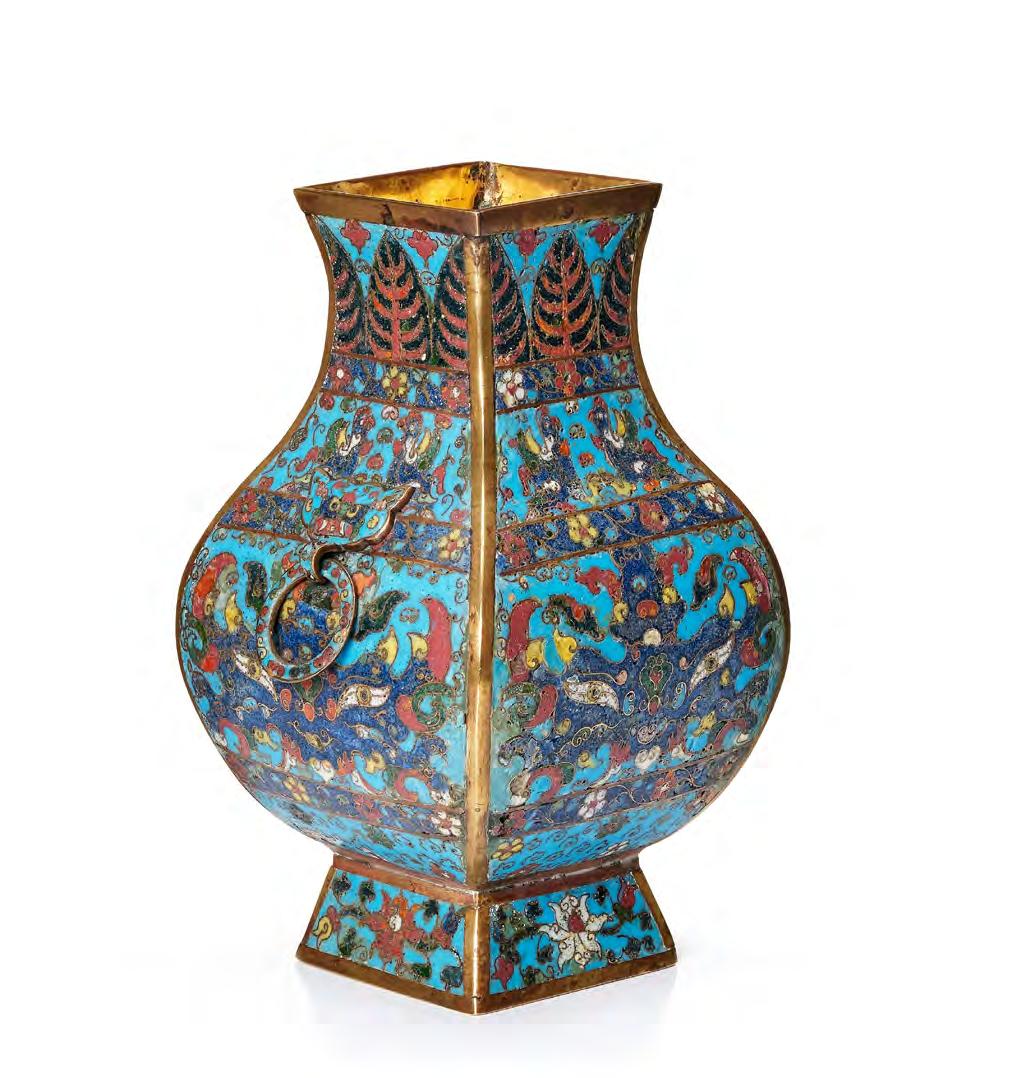
Baluster shape with mascaron handles, decorated with taothie masks, birds and lotus's in the enamels red, green, yellow, white, black and blue against a turqouise ground. Height 29 cm.
Property of a Swedish private collection.
SEK 15 000 – 20 000 / EUR 1 320 – 1 760
1122. A pair of Chinese cloisonné and chamleve caparisoned elephants, Qing dynasty, 18th/19th Century. Each cast standing foursquare the heads with almond eyes swaying slightly to the sides, the trunks curled between long tusks, the striated blackbody caparisoned with a saddle rug decorated with lotus supporting a baluster vase with cover. Height 35.5 cm.

Provenance: Previously in the Collection of sea captain Lennart Treys, Borgå, Finland.
Catalogue note: Models of elephants were very popular in Imperial China and made from various media to adorn halls and throne rooms throughout the Imperial palaces. They are associated with strength, wisdom and long-life and are also significant animals within the Buddhist religion. A prominent member of the Buddhist pantheon, Samantabhadra (Puxian), is frequently shown seated on an elephant. They are considered guardians of honour and were symbols of peace and good harvests. The elephant in China is also one of the seven Buddhist Sacred Treasures and symbolises peace. The combination of a vase ping 瓶 ), punning with ‘peace’ ping 平 ), and elephant xiang 象 , homophone with the word for ‘sign’ or ‘portent’, forms a rebus for the phrase taiping youxiang ( 太平有象 ), meaning ‘Where there is peace, there is a sign (or elephant)’.
Estimate: SEK 40 000 – 50 000 / EUR 3 520 – 4 400

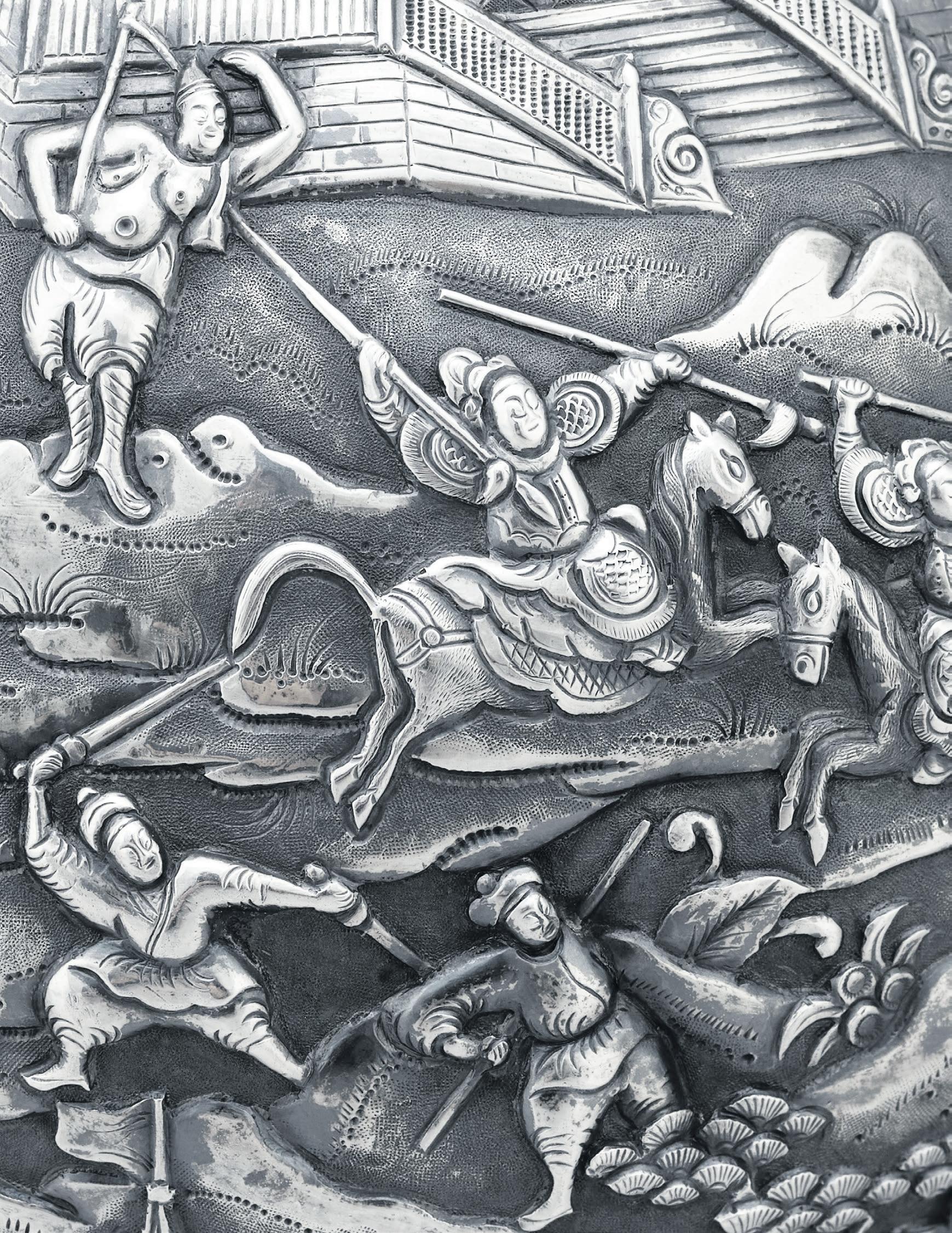 1126. A Chinese export silver wine ewer, Qing dynasty, 19th Century.
1126. A Chinese export silver wine ewer, Qing dynasty, 19th Century.
1123. A pair of gilt decorated blue ground painted enamel bowls, Qianlong four character seal mark and period (1736–95).

The four character seal mark in blue enamel to the base. Decorated to the exterior with a contionus lotus scroll, avove a lappet band to the foot, all reserved on a dark blue ground. The interior is enamelled in turquoise. Gilded rim. Diameter 12 cm.
Provenance: Aquired at auction at Ängsö Slott, 1968.
Exhibitions: Compare another pair of bowls with the same provenance at Östasiatiska Museet, Stockholm. Inventory no OM-1984–0010/11.
Literature: Compare a similar pair sold at Chiristies, Live Auction 12292, Lot no 684, 2016.
Also see Christies, Live Auction 2297, lot no 1178, 2010.
Estimate: SEK 50 000 – 75 000 / EUR 4 400 – 6 600
1125. A Chinese enamel on copper tazza, Qing dynasty, 19th Century.
Lobed on a tall foot, decorated in famille rose colours against a dark pink ground. Diameter 18.5 cm. Height 10 cm.

Provenance: Major Bertil Rudling, 1897–1981, thence by descent.
Estimate: SEK 4 000 – 6 000 / EUR 360 – 530
1124. Two Chinese enamel on copper cups, Qing dynasty, 18th Century.
A lobed dish with a handle in the shape of a branch, surrounded by leafs in relief. Length 9 cm. A small cup,

1126. A Chinese export silver wine ewer, Qing dynasty, 19th Century.

Interior gilded. The vessel is of European form with a hinged cover and arched handle in the shape of a dragon, the slender ovoid body is decorated in repoussé with a lively battle scene below figures at leisure before pavilions. The inscription above one of the pavillions may be translated as ‘Bronze bird terrace (or tower)’ which relates to the famous chinese litterary work ‘The Romance of the Western Chamber’, and presumably identifies the scene on the ewer. Height 34.5 cm. A silk lined fitted box accompanies the piece. Measurement of box 41x25.5x17 cm. Weight silver 819 gram. Monogram VJJ.
Literature: Compare a very similar sold at Bonhams Skinner. Auction: European Furniture & Decorative Arts - 2519B. Boston. October 02, 2010. Compare a ewer sold at Chrisites, live auction 7339. Chinese Ceramics, Works of Art and Textiles, 9 Nov 2012. Compare a similar sold at Freemans, lot no 204. 22nd May, 2014 10:00 EST. Silver & Objets de Vertu.
Estimate: SEK 90 000 – 100 000 / EUR 7 920 – 8 800
1127. A Chinese Export silver bowl, marked Wang Hing, circa 1900. Weight 790 gram.

Decorated in heigh relief with peonies. Marked WH, 90. Diameter 23 cm. Weigth 790 gram. Gilded interior.
Provenance: Wang Hing & Co. – Canton
Wang Hing originated as a jade dealer in Canton and evolved to become the best known and most prolific maker of export silver during the late China Trade period. Towards the end of the 19th century Wang Hing forged connections with Western silver firms and exhibited silver at international exhibitions. The firm later expanded to Shanghai, and opened a flagship store in Hong Kong in 1920.
Estimate: SEK 8 000 – 10 000 / EUR 710 – 880
1128. A silver tea pot with cover, Qing dynasty (1664–1912).
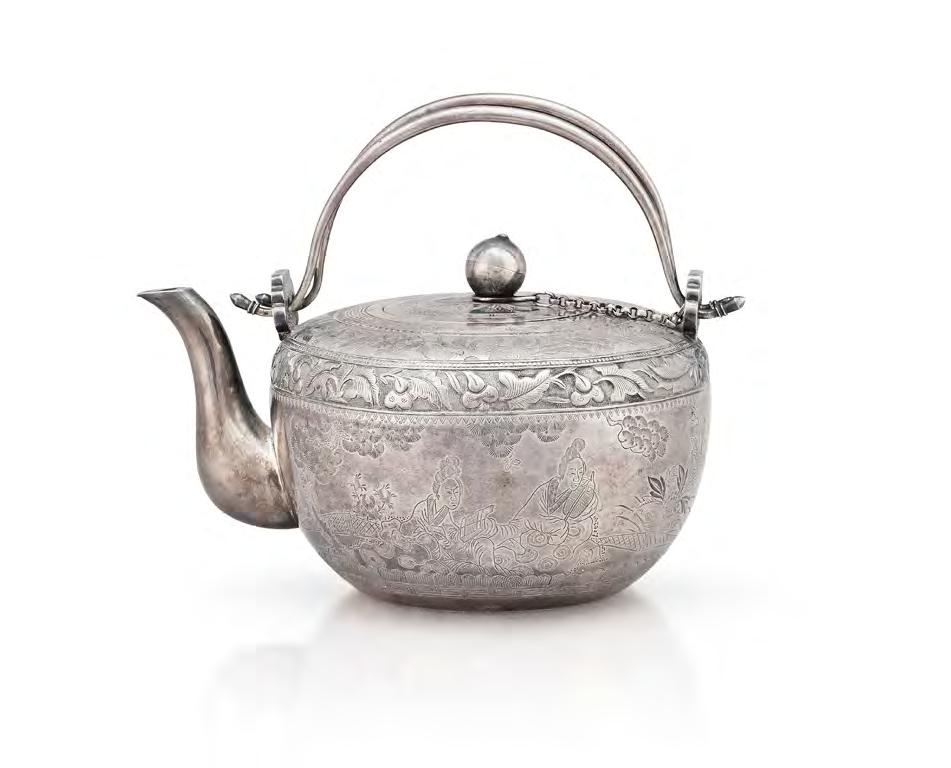
Inpressed Chinese mark. Import marks. Decorated in relief with a floral scroll, figure scene to one side, birds in a garden on the other side. Height handle up 12.5 cm. Lenght 14 cm.
SEK 4 000 – 6 000 / EUR 360 – 530
1129. A heavy stone slate/press, presumably Ming dynasty (1368–1644).

Rectangular shape decorated in a shallow relief with animals and vegetation, handle in the shape of a human figure. Around the rim a stylized frieze pattern. Measurment approx. 20.4 x 31 x 12 cm.
Estimate: SEK 8 000 – 10 000 / EUR 710 – 880
1130. A pair of stone sculptures of buddhist lions, Qing dynasty (1664–1912).

Height 16 cm.
Estimate: SEK 4 000 – 6 000 / EUR 360 – 530
1131. A red Chinese ink stick, 20th Century. With inscription to one side. Painted, gilded and decorated in relief with flowers, antiques and symbols. Length 24.5 cm. Measurement of fitted box 13 x 28 x 3 cm.
Estimate: SEK 4 000 – 6 000 / EUR 360 – 530
1132. A Chinese seal, early 20th Century.


A seated mythical creature. Height 5 cm. Measurment 3.5 x 3.5 cm.
Provenance: Property of a Swedish Collector.
Estimate: SEK 4 000 – 6 000 / EUR 360 – 530
1133. A carved nephrite sculpture of a lohan, Qing dynasty (1664–1912).

Presumably part of a screen. Height 12 cm. Height with wooden stand 14 cm.
Provenance: From the Collection of P Wedendal.
Estimate: SEK 12 000 – 15 000 / EUR 1 060 – 1 320
1134. A set of four Chinese nephrite objects, 20th Century.

Comprising; a carved piece with a butterfly and some fruites, length 10.5 cm A sculptured flower, diameter 7 cm. A sculptured bi disc. Diameter 5.5 cm. A pendant, height 5.2 cm.
Provenance: From the Collection of P Wedendal.
Estimate: SEK 8 000 – 10 000 / EUR 710 – 880
1135. A Chinese carved nephrite sculpture of a man, 20th Century.
The figure depicted seated, clad in a loose fitted robe holding a bowl. Height 7 cm.
Estimate: SEK 8 000 – 10 000 / EUR 710 – 880
1136. A Chinese archaistic nephrite placque, 20th Century. Carved deocration in the shape of a disk with a qilin dragon and rats. Length 10 cm.

Estimate: SEK 6 000 – 8 000 / EUR 530 – 710
One carved as a finger lemon, length 9.5 cm. Scupltured wooden stand accompanies the piece. One carved as a peach, length 8 cm. Sculptured fitted wooden stand accompanies the piece.


Provenance: Property of a Swedish Collector.
Estimate: SEK 8 000 – 10 000 / EUR 710 – 880
1138. A Chinese box with a gilt metal cover, 20th Century. Oval shape, green mottled stone. The cover with a gilded metal placque decorated with two deers. Length 8.5 cm.
Estimate: SEK 4 000 – 6 000 / EUR 360 – 530

1140. A large Chinese soapstone sculpture of Li Bai, 20th Century.
Anonymous artist, depciting the drunken poet Li Bai. Lenght 46 cm. Height 25 cm. Height with wooden stand 32 cm.

Catalogue note: Li Bai (701–762), also pronounced as Li Bo, was a Chinese poet, acclaimed from his own time to the present as a brilliant and romantic figure who took traditional poetic forms to new heights. He and his friend Du Fu (712–770) were two of the most prominent figures in the flourishing of Chinese poetry in the Tang dynasty, which is often called the “Golden Age of Chinese Poetry”.
Estimate: SEK 15 000 – 20 000 / EUR 1 320 – 1 760

1139. A Chinese leaf shaped nephrite dish, 20th Century. With seal mark to base. Carved decoration. Length 25.5 cm. SEK 8 000 – 10 000 / EUR 710 – 880

1141. A set of three snuff bottles with stoppers. Qing dynasty.

One carved malachite. Height 7.5 cm. One in a mottled stone. Height 6.2 cm. One in pekingglass. Height 6 cm.
Provenance: From the collection of the owner of Nenneman & Thomsen, Århus, thence by descent to the present owner.
Estimate: SEK 8 000 – 10 000 / EUR 710 – 880
From the Collection of Tove and Karl Emil Strømstad (born 1936), Norway. The couple built their collection over the decades. They started to collect in the early 1970’s after buying the first piece, a famille rose bowl, dating from the 18th Century. Mr Strømstads work at IBM brought the couple and their family to various places around the world and they built their vast academic collection of ceramics dating from the Han dynasty to the Qing dynasty by visiting auction houses, antique dealers and antique fairs. Always striving to acquire pieces form different epoques and constantly seeking more knowledge about the pieces, the techniques and their history.
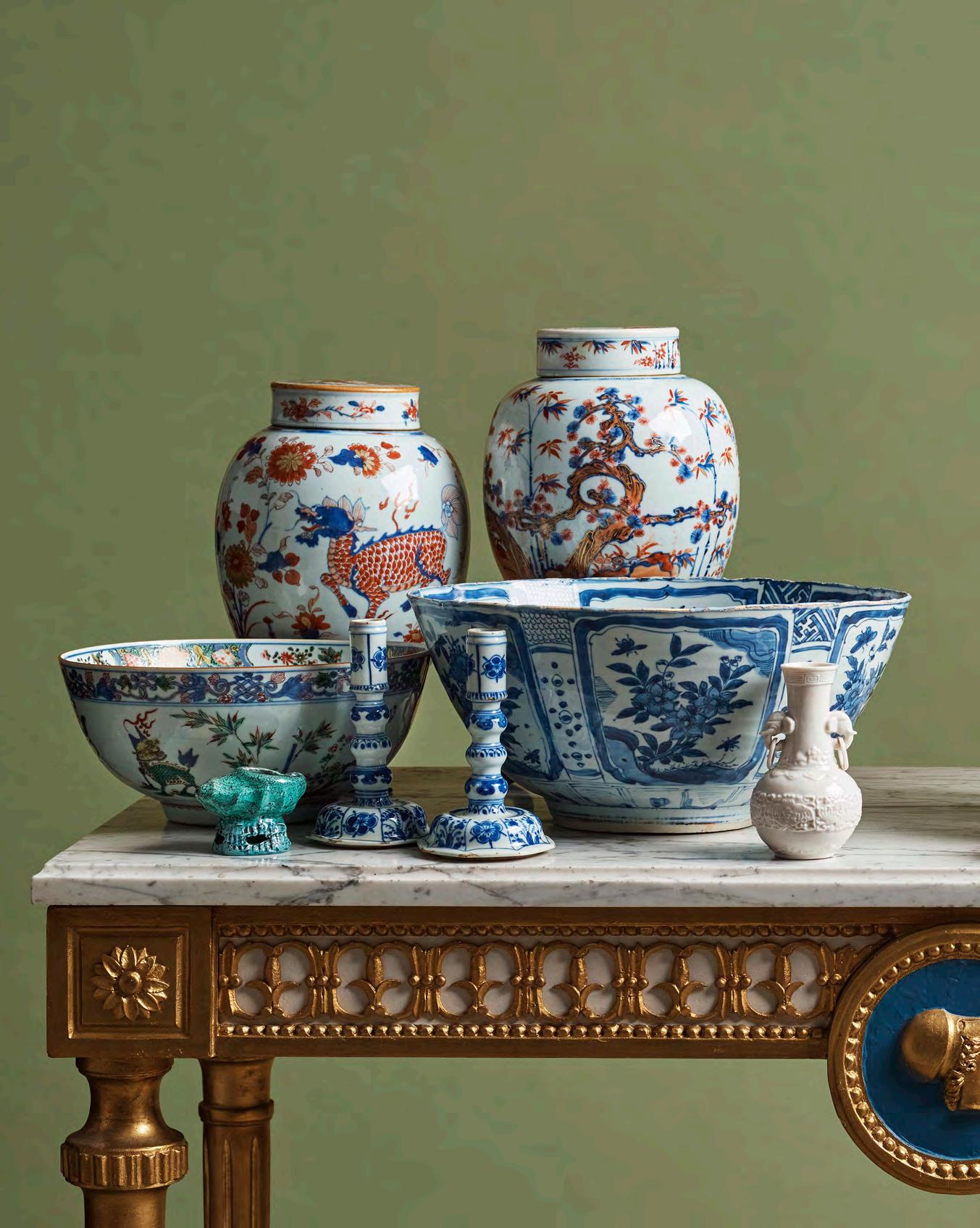 LOT 1142 – 1228
The Tove and Karl Emil Strömstad Collection.
LOT 1142 – 1228
The Tove and Karl Emil Strömstad Collection.

1142. A blue and white dish, Ming dynasty, late 15th Century/early 16th Century.
Decorated in blue and white with an intricate floral pattern. In the center a roundel with a conchshell. The exterior decorated with a continonus lotus scroll. Diameter 33 cm.

Provenance: From the Collection of Tove and Karl Emil Strømstad (born 1936), Norway. Strømstad label 15. Purchased at Portobello Road 1985.
From Mr W v Halm
Exhibitions: For other items from this collection, see Sothebys, Asian Arts / 5000 Years. 18 April 2023. Paris. Lot no 1–39.
Estimate: SEK 15 000 – 20 000 / EUR 1 320 – 1 760
1144. A large blue and white kraak bowl, Ming dynasty, Wanli (1572–1622).
Large with rounded sides, decorated with flowers and fruits. Central motif with a cricket on a rock in a garden in full bloom. Diameter approx. 32 cm. Height 13.5 cm.
Provenance: From the Collection of Tove and Karl Emil Strømstad (born 1936), Norway. Strømstad label 470.
Exhibitions: For other items from this collection, see Sothebys, Asian Arts / 5000 Years. 18 April 2023. Paris. Lot no 1–39.
Estimate: SEK 30 000 – 50 000 / EUR 2 640 – 4 400
1143. A massive blue and white kraak punch bowl, Ming dynasty, Wanli (1572–1622).


Decorated in underglaze blue with birds and plants. Central scene with birds in a garden in full bloom. Diameter 36 cm. Height 17 cm.
Provenance: From the Collection of Tove and Karl Emil Strømstad (born 1936), Norway. Strömstad label 484. Purchased at Renasciemento, Lisboa.
Exhibitions: For other items from this collection, see Sothebys, Asian Arts / 5000 Years. 18 April 2023. Paris. Lot no 1–39.
Estimate: SEK 50 000 – 75 000 / EUR 4 400 – 6 600
1145. A blue and white kraak dish, Ming dynasty, Wanli (1572–1622).
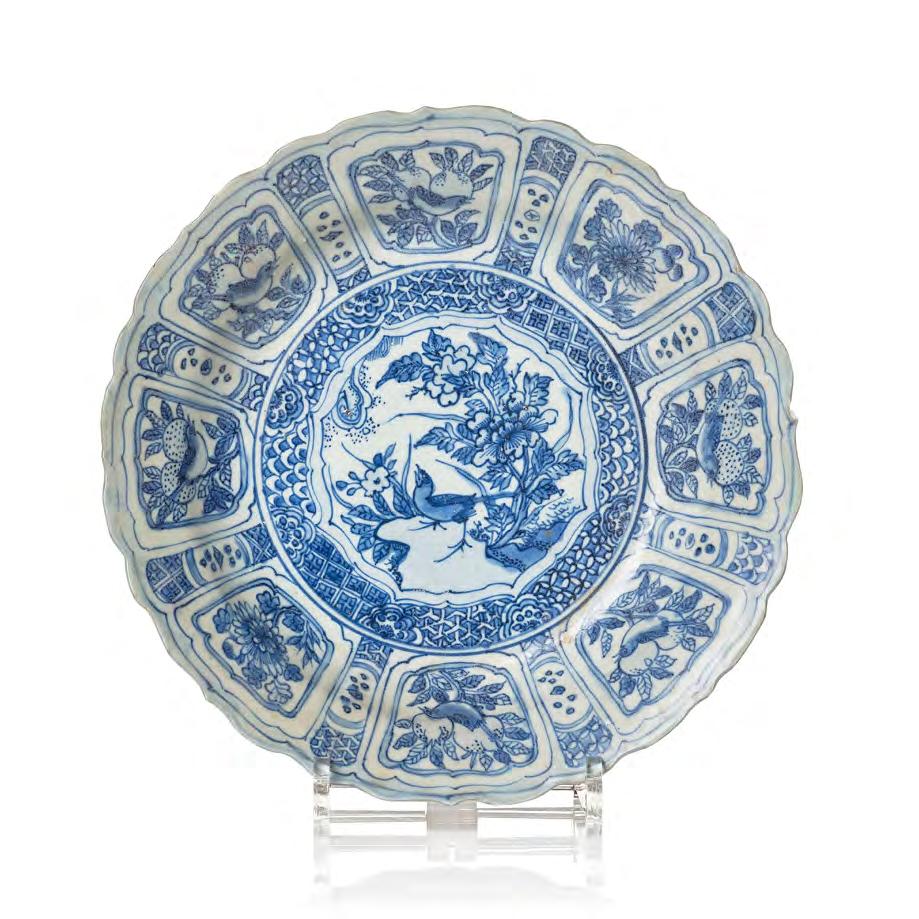

Decorated with flowers and precious objects. Diameter 29 cm.
Provenance: From the Collection of Tove and Karl Emil Strømstad (born 1936), Norway.
Exhibitions: For other items from this collection, see Sothebys, Asian Arts / 5000 Years. 18 April 2023. Paris. Lot no 1–39.
Estimate: SEK 6 000 – 8 000 / EUR 530 – 710
Classic shape, decorated in underglaze blue with flowers and precious objects. Height 19 cm.

Provenance: From the Collection of Tove and Karl Emil Strømstad (born 1936), Norway. Strømstad label 2. Purchased at van Halm, 1984.
Exhibitions: For other items from this collection, see Sothebys, Asian Arts / 5000 Years. 18 April 2023. Paris. Lot no 1–39.
Estimate: SEK 8 000 – 10 000 / EUR 710 – 880
1146. A blue and white kraak dish, Ming dynasty, Wanli (1572–1620).
Decorated with flowers, fruit and birds. Diameter 26.5 cm.
Provenance: From the Collection of Tove and Karl Emil Strømstad (born 1936), Norway. Label from the Hatcher Collection, Christies 1984. Strømstad label 3.
Exhibitions: For other items from this collection, see Sothebys, Asian Arts / 5000 Years. 18 April 2023. Paris. Lot no 1–39.
Literature: Colin Sheaf and Richard Kilburn, The Hatcher Porcelain Cargoes, The Complete Record, London, 1988, p. 30) Sheaf and Kilburn take a step-by-step process to deduce that the ship most likely sunk between 1643 and 1646. The inclusion of two covers for ovoid jars (similar in shape to the lot 3513) bearing inscriptions and a cyclical date corresponding to the spring of 1643 indicates that the vessel sank no earlier than the spring of 1643. The authors also note that because of the internal unrest in China at the time, trade was significantly disrupted at the fall of the Ming dynasty and studies of VOC records show that by 1646 the Manchus were preventing the free movement of trade and shipments out of Jingdezhen. The authors conclude that it is therefore very likely that the Chinese junk known as the ‘Hatcher Cargo’ must have sunk sometime in the years between 1643 and 1646.
Estimate: SEK 12 000 – 15 000 / EUR 1 060 – 1 320
1147. A blue and white kendi, Ming dynasty, Wanli (1572–1620).
1149. A blue and white Swatow dish, Ming dynasty (1368–1644).

Deep, decorated in underglaze blue with a mythical creature.
Diameter 32 cm.
Provenance: From the Collection of Tove and Karl Emil Strømstad (born 1936), Norway. Strømstad label 548.
Exhibitions: For other items from this collection, see Sothebys, Asian Arts / 5000 Years. 18 April 2023. Paris. Lot no 1–39
Estimate: SEK 8 000 – 10 000 / EUR 710 – 880
1148. A blue and white kraak dish, Ming dynasty, 17th Century. Decorated in blue and white with scholars sitting on rock formations surrounded by pine tree, bamboo and cherry blossoms. Central panel with a riverscape. Diameter 31.5 cm.
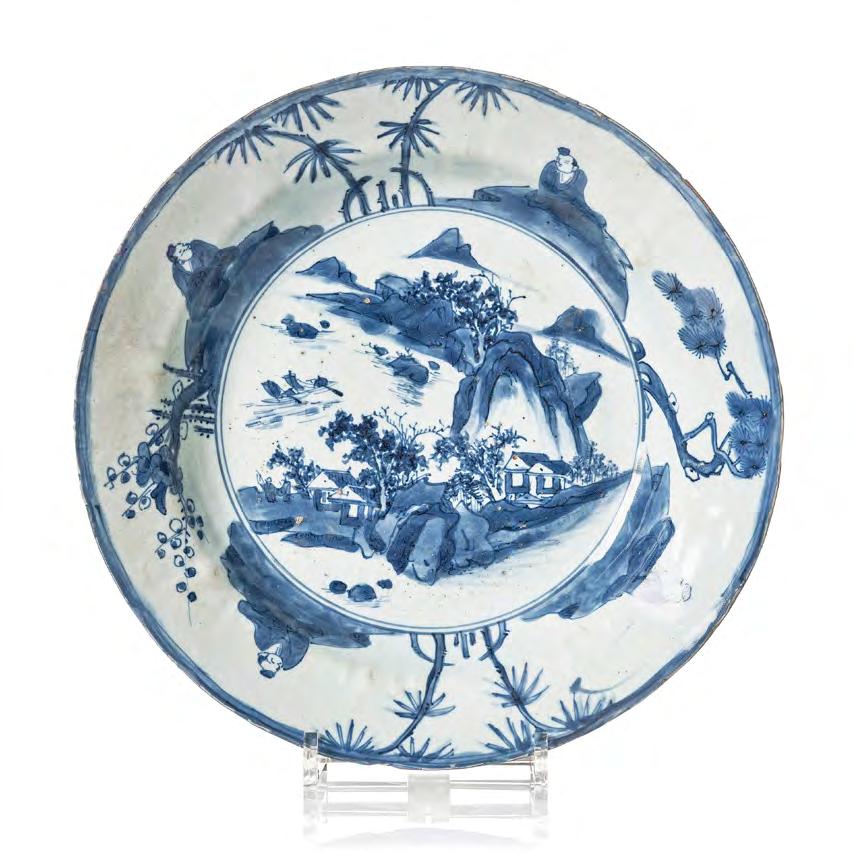
Provenance: From the Collection of Tove and Karl Emil Strømstad (born 1936), Norway.
Exhibitions: For other items from this collection, see Sothebys, Asian Arts / 5000 Years. 18 April 2023. Paris. Lot no 1–39.
Estimate: SEK 15 000 – 20 000 / EUR 1 320 – 1 760
1150. A blue and white kraak bowl, Ming dynasty, Wanli (1572–1620).

Impressed decoration and decoration in underglaze blue with a flowerpot with flowers in it to the center. The reverse of the rim with 2 branches. Diameter 15 cm.
Provenance: From the Collection of Tove and Karl Emil Strømstad (born 1936), Norway. Strømstad label 11.
Exhibitions: For other items from this collection, see Sothebys, Asian Arts / 5000 Years. 18 April 2023. Paris. Lot no 1–39.
Estimate: SEK 4 000 – 6 000 / EUR 360 – 530
1151. A set with 3 blue and white kraak dishes, Ming dynasty, Wanli (1572–1620).

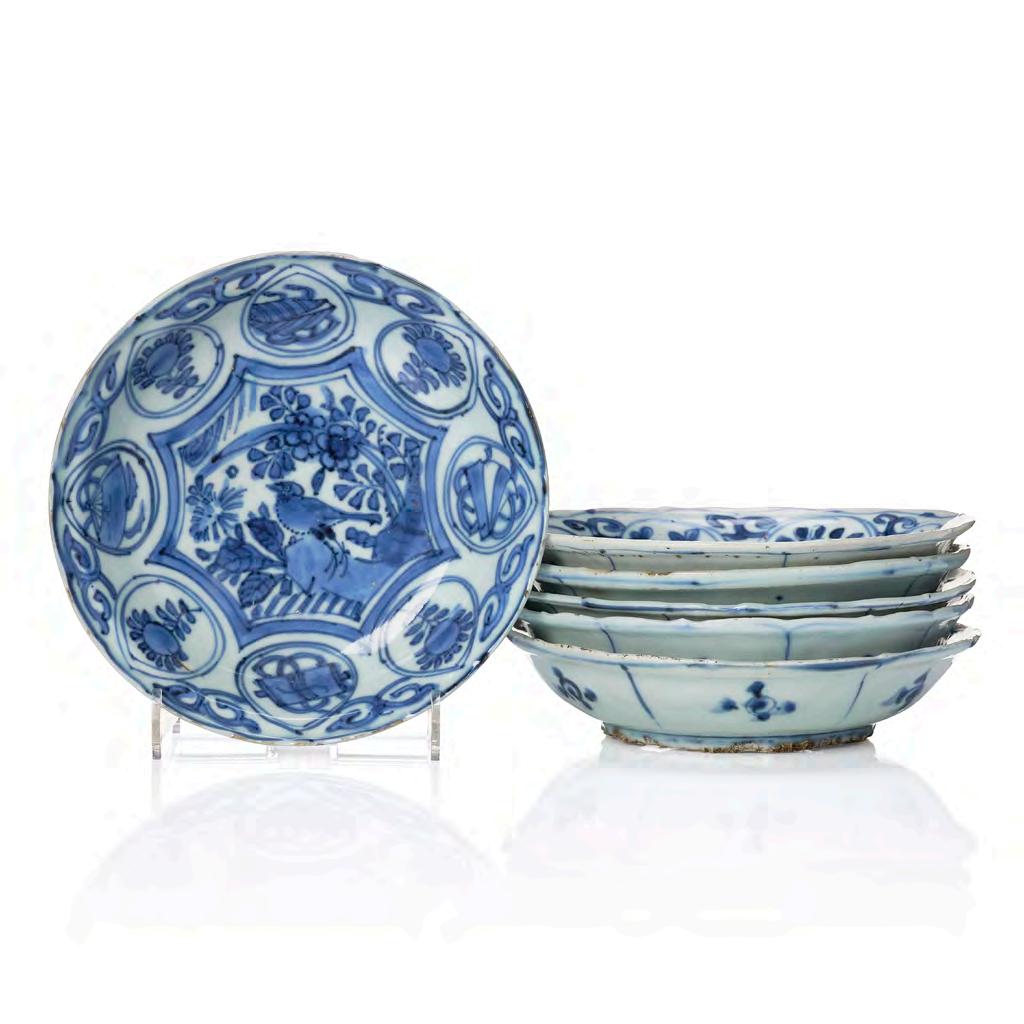

Deep, with a matched decoration in underglaze blue with flowers, antiques and fruits. Diameter approx. 14.5 cm.
Provenance: From the Collection of Tove and Karl Emil Strømstad (born 1936), Norway.
Exhibitions: For other items from this collection, see Sothebys, Asian Arts / 5000 Years. 18 April 2023. Paris. Lot no 1–39.
Estimate: SEK 4 000 – 6 000 / EUR 360 – 530
From the Collection of Tove and Karl Emil Strømstad (born 1936), For other items from this collection, see Sothebys, Asian Arts / 5000 Years. 18 April 2023. Paris. Lot no 1–39.
SEK 6 000 – 8 000 / EUR 530 – 710
Decorated in underglaze blue with flowers and birds. The interior with a bird. Diameter 10.3 cm. Height 6.6 cm.
Provenance: From the Collection of Tove and Karl Emil Strømstad (born 1936), Norway. Strømstad label 358.
Exhibitions: For other items from this collection, see Sothebys, Asian Arts / 5000 Years. 18 April 2023. Paris. Lot no 1–39.
Estimate: SEK 3 000 – 4 000 / EUR 270 – 360
1155. A blue and white kraak dish, Ming dynasty, Wanli (1572–1620).
Decorated in underglaze blue with flowers and buddhist emblems. Diameter 21 cm.
Provenance: From the Collection of Tove and Karl Emil Strømstad (born 1936), Norway. Strømstad label 357.
Exhibitions: For other items from this collection, see Sothebys, Asian Arts / 5000 Years. 18 April 2023. Paris. Lot no 1–39.
Estimate: SEK 4 000 – 6 000 / EUR 360 – 530
1156. A blue and white 'Hatcher cargo' bowl, Ming dynasty, 17th Century.



Decorated in blue and white with flowers. Diameter 10.5 cm.
Provenance: From the Collection of Tove and Karl Emil Strømstad (born 1936), Norway. With label from The Hatcher Collection, Christies, Amsterdam, 1984. Strømstad label 8B.)
Exhibitions: For other items from this collection, see Sothebys, Asian Arts / 5000 Years. 18 April 2023. Paris. Lot no 1–39.
Literature: Colin Sheaf and Richard Kilburn, The Hatcher Porcelain Cargoes, The Complete Record, London, 1988, p. 30) Sheaf and Kilburn take a step-bystep process to deduce that the ship most likely sunk between 1643 and 1646. The inclusion of two covers for ovoid jars (similar in shape to the lot 3513) bearing inscriptions and a cyclical date corresponding to the spring of 1643 indicates that the vessel sank no earlier than the spring of 1643. The authors also note that because of the internal unrest in China at the time, trade was significantly disrupted at the fall of the Ming dynasty and studies of VOC records show that by 1646 the Manchus were preventing the free movement of trade and shipments out of Jingdezhen. The authors conclude that it is therefore very likely that the Chinese junk known as the ‘Hatcher Cargo’ must have sunk sometime in the years between 1643 and 1646.
Estimate: SEK 3 000 – 5 000 / EUR 270 – 440
1157. A set with two blue and white bowls and two dishes, Ming dynasty (1368–1644).
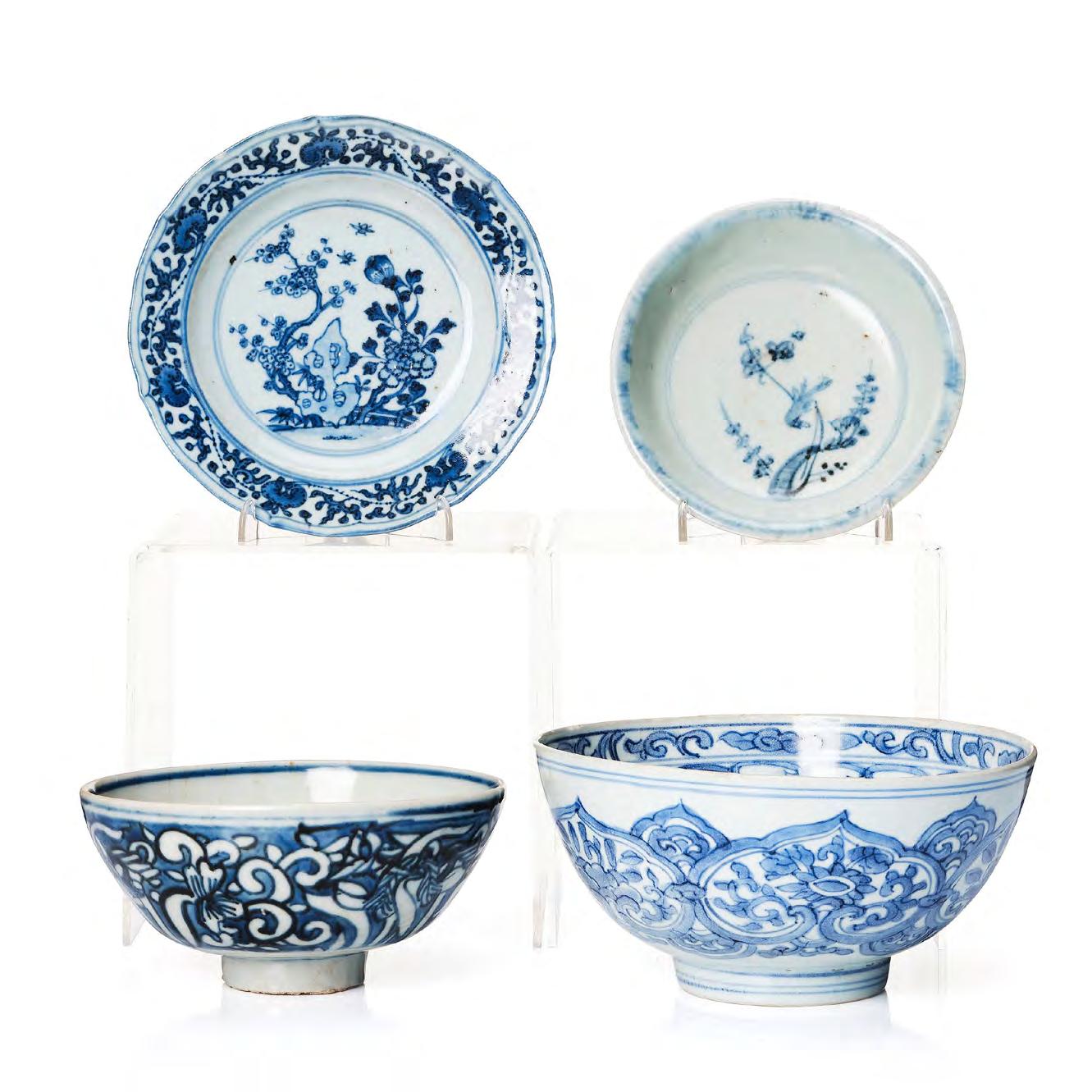
Of different decoration. Diameter 14–18 cm.
Provenance: From the Collection of Tove and Karl Emil Strømstad (born 1936), Norway. For other items from this collection, see Sothebys, Asian Arts / 5000 Years. 18 April 2023. Paris. Lot no 1–39.
SEK 4 000 – 6 000 / EUR 360 – 530
1158. A blue and white bowl, Qing dynasty, Kangxi (1662–1722). Slightly lobed, decorated with rabbits and flowers. Diameter 15 cm.

Provenance: From the Collection of Tove and Karl Emil Strømstad (born 1936), Norway. Strømstad label 23.)
Exhibitions: For other items from this collection, see Sothebys, Asian Arts / 5000 Years. 18 April 2023. Paris. Lot no 1–39.
Catalogue note: According to Daoist legend, a jade-white hare or rabbit lives on the moon, grinding the elixir of immortality with a pestle and mortar. The elixir was believed to have been stolen from the archer Yi by Lady Chang-E, who fled with it to the moon. However, a Buddhist story provides another explanation of how the rabbit came to live on the moon. The Buddha arrived in a forest, exhausted and hungry after many days of traveling. All the animals came to him bringing the foods that they usually gathered for themselves. The rabbit intended to bring fresh green grass and leaves, but when he found them, he ate them himself. The rabbit was consumed by guilt and going to the Buddha admitted his folly and offered that the Buddha could eat him instead. The Buddha was so touched by this gesture that he bestowed upon the rabbit the gift of eternal life on the moon. Rabbits are therefore associated with long life.
Estimate: SEK 6 000 – 8 000 / EUR 530 – 710
1160. A blue and white dish, Qing dynasty, Kangxi (1662–1722). Decorated in underglaze blue with flowers within separate compartments. The center with a lotus flower. The reverse of the rim with three floral sprigs. The base with an artemisa leaf within a double circle in underglaze blue. Diameter 38.2 cm.
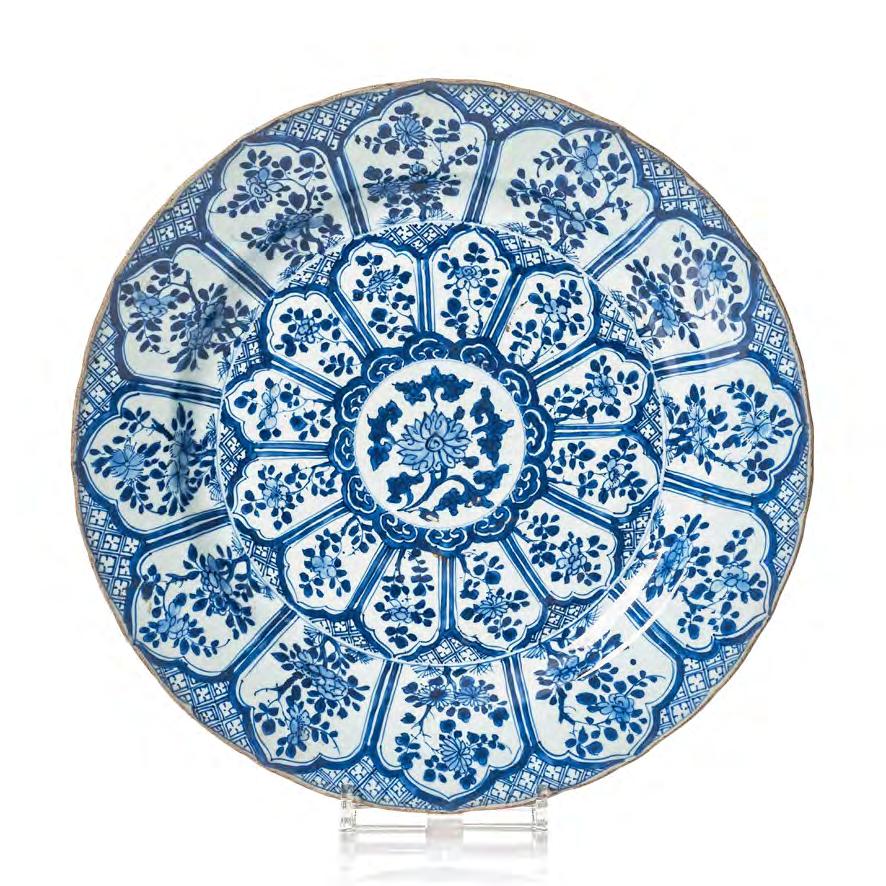
Provenance: From the Collection of Tove and Karl Emil Strømstad (born 1936), Norway. Strømstad label 433.
Exhibitions: For other items from this collection, see Sothebys, Asian Arts / 5000 Years. 18 April 2023. Paris. Lot no 1–39.
Estimate: SEK 8 000 – 10 000 / EUR 710 – 880
1159. A blue and wite vase, Qing dynasty, Kangxi (1662–1722). Baluster shape, decorated with flowers and insects. Height 17 cm.

From the Collection of Tove and Karl Emil Strømstad (born 1936), Norway.
For other items from this collection, see Sothebys, Asian Arts / 5000 Years. 18 April 2023. Paris. Lot no 1–39.
SEK 6 000 – 8 000 / EUR 530 – 710
1161. A pair of blue and white candles sticks/covers, Qing dynasty, Kangxi (1662–1722).

Decorated with flowers and bands. Height 15.5 cm.
From the Collection of Tove and Karl Emil Strømstad (born 1936), Norway. Strømstad label 483b. Purchased at Bruun-Rasmussen. For other items from this collection, see Sothebys, Asian Arts / 5000 Years. 18 April 2023. Paris. Lot no 1–39.
SEK 10 000 – 15 000 / EUR 880 – 1 320
For other items from this collection, see Sothebys, Asian Arts / 5000 Years. 18 April 2023. Paris. Lot no 1-39.
Literature: Rose Kerr, Hallwyllska Museet, see similar cups in teh Collection of the Hallwyllska Museet in Stockholm.
Estimate: SEK 30 000 – 50 000 / EUR 2 640 – 4 400
1163. A pair of blue and white plates, Qing dynasty, Kangxi (1662–1722).


Hexagonal, decorated in vibrant blue with peonies in a garden with a garden rock. Diameter 20.5 cm.
Provenance: From the Collection of Tove and Karl Emil Strømstad (born 1936), Norway. Strømstad label 18a&18b. London, 1986, W v Halm.
Exhibitions: For other items from this collection, see Sothebys, Asian Arts / 5000 Years. 18 April 2023. Paris. Lot no 1–39.
Estimate: SEK 6 000 – 8 000 / EUR 530 – 710
1164. A blue and white 'Rouen pattern' ewer with cover, Qing dynasty, Kangxi (1662–1722).

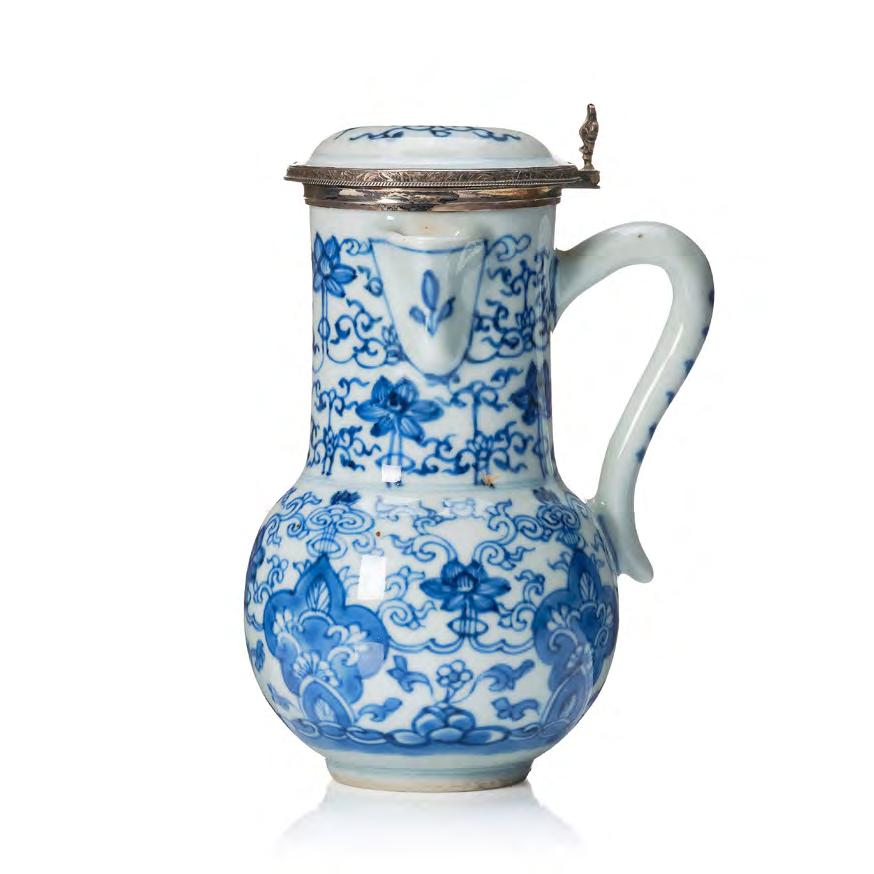

After a silver model, decorated after a french 'Rouen' design often seen on faiences of the period. Height 22 cm.
Provenance: From the Collection of Tove and Karl Emil Strømstad (born 1936), Norway. Strømstad label 389. Purchased at Artcurial, 2012.)
Exhibitions: For other items from this collection, see Sothebys, Asian Arts / 5000 Years. 18 April 2023. Paris. Lot no 1–39.
Literature: Compare with a faience dish from the French Rouen factory in the collection of the Metropolitan Museum, New York, Credit Line: Gift of J. Pierpont Morgan, 1917. Accession Number: 17.190.1772.
Estimate: SEK 8 000 – 10 000 / EUR 710 – 880
1165. A silver mounted ewer with cover, Qing dynasty, Kangxi (1662–1722).
Pear shaped with a handle and spout, decorated in underglaze blue with stylized flowers. Height 15.5 cm.
Provenance: From the Collection of Tove and Karl Emil Strømstad (born 1936), Norway.
Exhibitions: For other items from this collection, see Sothebys, Asian Arts / 5000 Years. 18 April 2023. Paris. Lot no 1–39.
Estimate: SEK 10 000 – 15 000 / EUR 880 – 1 320
1166. A ewer with cover, Qing dynasty, early 18th Century. Mark to base. With metal mount. Unusual decoration in underglaze blue and red against a pale celadon. Height 14 cm.
Provenance: From the Collection of Tove and Karl Emil Strømstad (born 1936), Norway. R G Mc Pehrson, label to base no 246. Strømstad label 347.)
Exhibitions: For other items from this collection, see Sothebys, Asian Arts / 5000 Years. 18 April 2023. Paris. Lot no 1–39.
Estimate: SEK 12 000 – 15 000 / EUR 1 060 – 1 320
1167. A pair of octagonal blue and white cups with stands, Qing dynasty, Kangxi (1662–1722).


Octagonal, decorated in underglaze blue with riverscapes alternating with flowers. Diameter cup 8.5 cm. Diameter stand 12.5 cm.
From the Collection of Tove and Karl Emil Strømstad (born 1936), Norway. For other items from this collection, see Sothebys, Asian Arts / 5000 Years. 18 April 2023.
SEK 8 000 – 10 000 / EUR 710 – 880
1168. A blue and white bowl, Qing dynasty, 18th Century. The base with a mark within double circle. Decorated with lingzhifungus and flowers. Diameter 10.5 cm.

Provenance: From the Collection of Tove and Karl Emil Strømstad (born 1936), Norway.
Exhibitions: For other items from this collection, see Sothebys, Asian Arts / 5000 Years. 18 April 2023. Paris. Lot no 1–39.
Estimate: SEK 8 000 – 10 000 / EUR 710 – 880
1169. Two blue and white cups, Qing dynasty, 18th Century. Of different decoration in underglaze blue. Diameter 7.6–9.6 cm.
Provenance: From the Collection of Tove and Karl Emil Strømstad (born 1936), Norway.
Exhibitions: For other items from this collection, see Sothebys, Asian Arts / 5000 Years. 18 April 2023. Paris. Lot no 1–39.
Estimate: SEK 4 000 – 6 000 / EUR 360 – 530
1170. A blue and white silver mounted dish, Qing dynasty, Kangxi (1662–1722).

Decorated in underglaze blue with a peacock in a garden with antiques and flowers. Diameter 25 cm.
Provenance: From the Collection of Tove and Karl Emil Strømstad (born 1936), Norway. Strømstad label 326.
Exhibitions: For other items from this collection, see Sothebys, Asian Arts / 5000 Years. 18 April 2023. Paris. Lot no 1–39.
Estimate: SEK 4 000 – 6 000 / EUR 360 – 530
1171. A set of four blue and white dishes, Qing dynasty, Kangxi (1662–1722).

Of different decoration in underglaze blue. One of them from the Ca Mau Bonh Thuan. Diameter 21–22.5 cm.
Provenance: From the Collection of Tove and Karl Emil Strømstad (born 1936), Norway. Strømstad label 17, 19, 33. 309.)
Exhibitions: For other items from this collection, see Sothebys, Asian Arts / 5000 Years. 18 April 2023. Paris. Lot no 1–39.
Estimate: SEK 4 000 – 6 000 / EUR 360 – 530
1172. A blue and white flower shaped dish, Qing dynasty, first half of the 18th Century.

Lobed rim with brown at the edge. Decorated with flowers in underglaze blue. The reverse decorated with further nine flowers and the center with the character for jade within a double circle. Diameter 22 cm.
Provenance: From the Collection of Tove and Karl Emil Strømstad (born 1936), Norway.
Exhibitions: For other items from this collection, see Sothebys, Asian Arts / 5000 Years. 18 April 2023. Paris. Lot no 1–39.
Estimate: SEK 4 000 – 6 000 / EUR 360 – 530
1173. A set of three blue and white dishes, Qing dynasty, Kangxi (1662–1722).
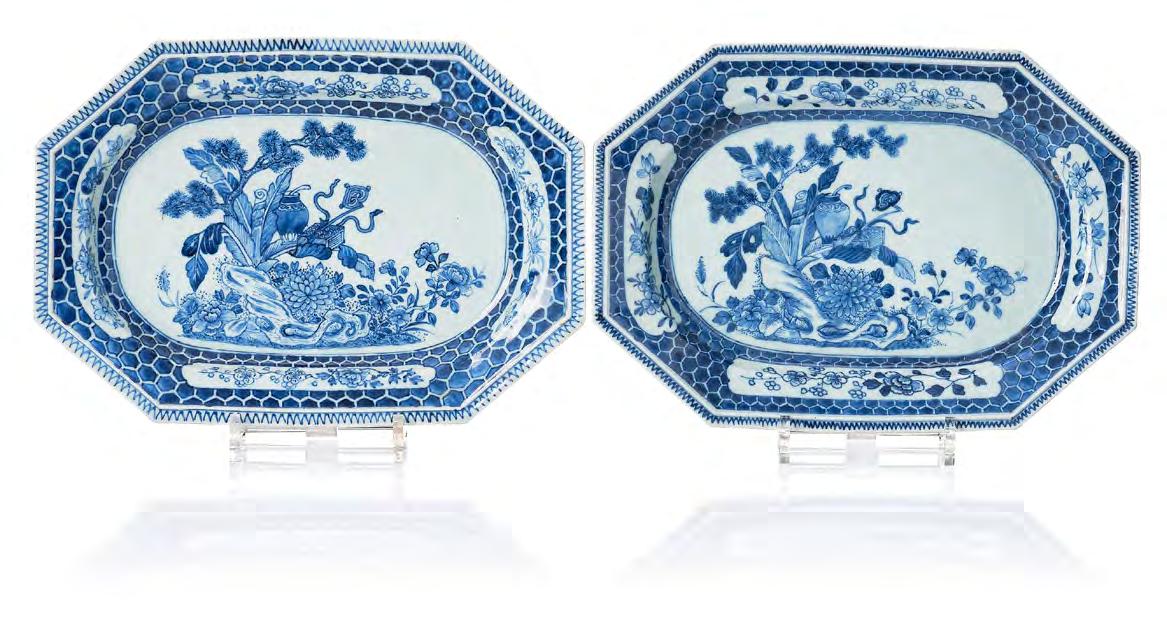

Lobed, decorated with flowers. Diameter 22.5 cm.
Provenance: From the Collection of Tove and Karl Emil Strømstad (born 1936), Norway. Strømstad label 35.
Exhibitions: For other items from this collection, see Sothebys, Asian Arts / 5000 Years. 18 April 2023. Paris. Lot no 1–39.
Estimate: SEK 5 000 – 7 000 / EUR 440 – 620
Estimate: SEK 6 000 – 8 000 / EUR 530 – 710
1176. A blue and white vegetable tureen with cover, Qing dynasty, Qianlong (1736–95).
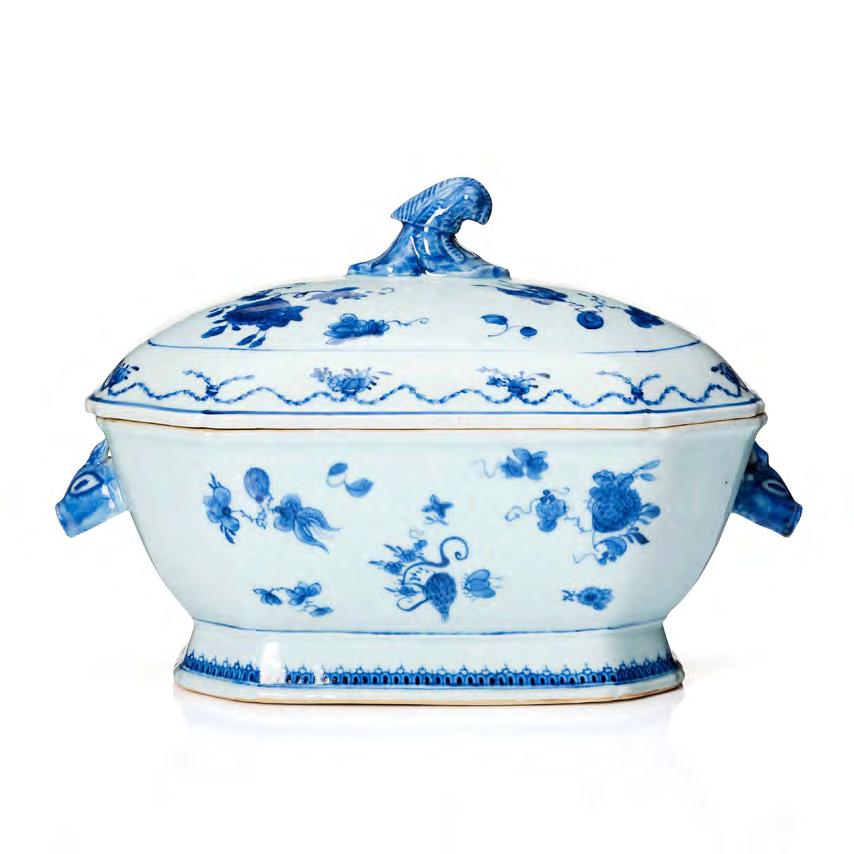

Hexagonal ground with a oval tureen part decorated with a riverscape in underglaze blue. Length 29 cm.
Provenance: From the Collection of Tove and Karl Emil Strømstad (born 1936), Norway.Strømstad label no 391a. Purchased in 2012, from the Collection of Toftager.
Exhibitions: For other items from this collection, see Sothebys, Asian Arts / 5000 Years. 18 April 2023. Paris. Lot no 1–39.
1175. A blue and white dish, Qing dynasty, Yongzheng (1723–35). Presumably ment to have been decorated in doucai colours. Now decorated in underglaze blue with a crane and a deer in a garden setting. Diameter 32 cm.

Provenance: From the Collection of Tove and Karl Emil Strømstad (born 1936), Norway.
Exhibitions: For other items from this collection, see Sothebys, Asian Arts / 5000 Years. 18 April 2023. Paris. Lot no 1–39.
Estimate: SEK 6 000 – 8 000 / EUR 530 – 710
1177. A blue and white tureen with cover, Qing dynasty, Qianlong (1736–1795).
Octagonal shape, rabbitshead handles, and a finial in the shape of an acantus leaf, decorated with flowers and garlands. Lenght 36 cm. Height 24 cm.
Provenance: From the Collection of Tove and Karl Emil Strømstad (born 1936), Norway.
Exhibitions: For other items from this collection, see Sothebys, Asian Arts / 5000 Years. 18 April 2023. Paris. Lot no 1–39.
Estimate: SEK 6 000 – 8 000 / EUR 530 – 710
1178. A blue and white tureen dish, Qing dynasty, Qianlong (1736–95).

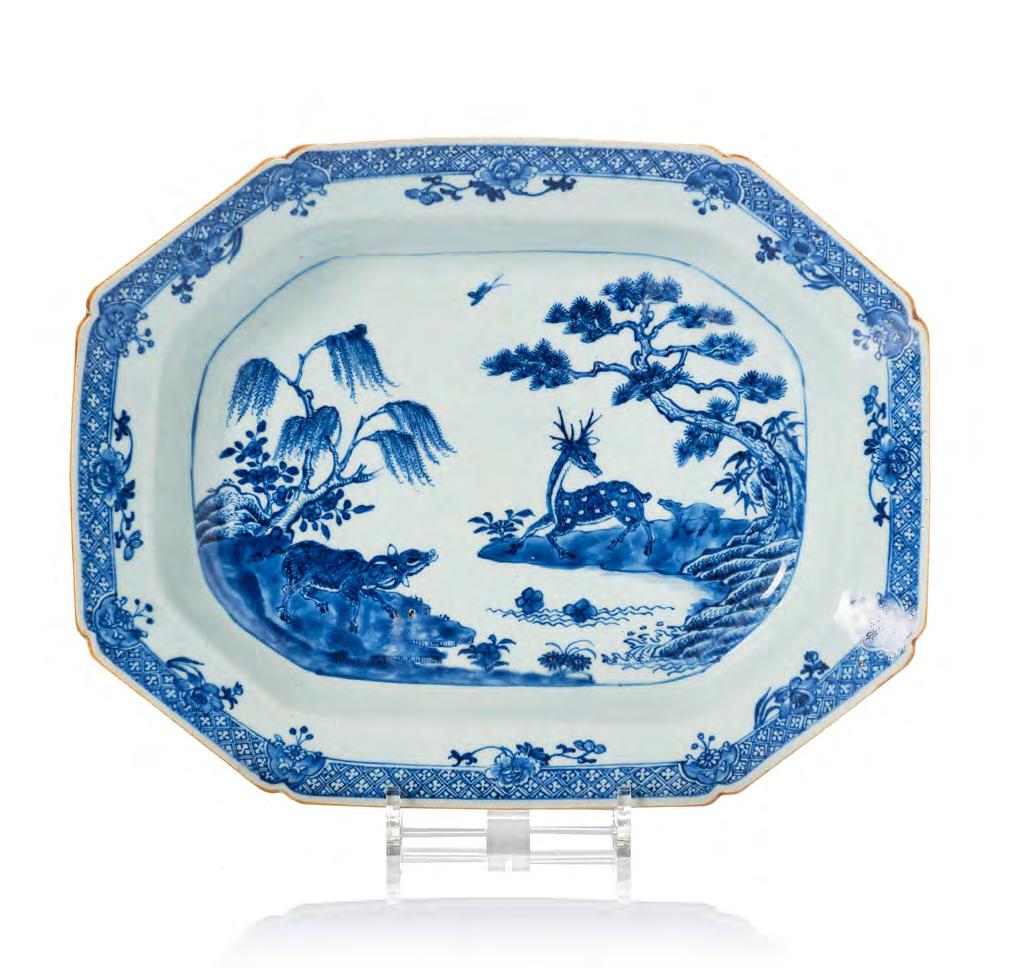
Deep, oktagonal decorated with a spotted deer with a fawn and a buffalo by the river. Length 37.5 cm.
Provenance: From the Collection of Tove and Karl Emil Strømstad (born 1936), Norway.
Exhibitions: For other items from this collection, see Sothebys, Asian Arts / 5000 Years. 18 April 2023. Paris. Lot no 1–39.
Estimate: SEK 4 000 – 6 000 / EUR 360 – 530
1179. A blue and white sauce boat, Qing dynasty, 18th Century. Handles in the shape of foxes, decorated with a landscape with pagoda. Lenght 20 cm.
Provenance: From the Collection of Tove and Karl Emil Strømstad (born 1936), Norway.
Exhibitions: For other items from this collection, see Sothebys, Asian Arts / 5000 Years. 18 April 2023. Paris. Lot no 1–39.
Estimate: SEK 2 500 – 3 000 / EUR 220 – 270
1180. A blue and white Chinese Export silver mounted tankard, Qing dynasty, Qianlong (1736–95). Bergen, Norway 1783. With silver makers mark. Bergen, Norway 1783. Johan Helmich Hoff. Prober master Jens and Dithmar Karks. Month stamp 'Virgin' 21/8–23/9. Decorated in underglaze blue with a riverscape. Height with silver mount 19 cm.

Provenance: From the Collection of Tove and Karl Emil Strømstad (born 1936), Norway. Strømstad label 547.
Exhibitions: For other items from this collection, see Sothebys, Asian Arts / 5000 Years. 18 April 2023. Paris. Lot no 1–39.
Estimate: SEK 6 000 – 8 000 / EUR 530 – 710
1182. A blue glazed jar with cover, Qing dynasty, Qianlong (1736–95).

Ovoid shape, unglazed rim, decorated in a blue glaze and with gilded decoration. Height 23 cm.
Provenance: From the Collection of Tove and Karl Emil Strømstad (born 1936), Norway.
Exhibitions: For other items from this collection, see Sothebys, Asian Arts / 5000 Years. 18 April 2023. Paris. Lot no 1–39.
Estimate: SEK 16 000 – 20 000 / EUR 1 410 – 1 760
1181. A blue and white charger, Qing dynasty, Qianlong (1736–95).

Decorated with a garden in full bloom, around the rim a scroll with lotus, the reverse of the rim with two floral sprigs. Diameter 41 cm.
Provenance: From the Collection of Tove and Karl Emil Strømstad (born 1936), Norway.
Exhibitions: For other items from this collection, see Sothebys, Asian Arts / 5000 Years. 18 April 2023. Paris. Lot no 1–39
Estimate: SEK 4 000 – 6 000 / EUR 360 – 530
1183. A blue glazed vase, Qing dynasty, Qianlong (1736–95). Droppshaped, with a bulb top, decorated with a blue glaze and gilded decoration. Height 23.5 cm.

Provenance: From the Collection of Tove and Karl Emil Strømstad (born 1936), Norway. Strømstad label 436. Bukowskis 2016.)
Exhibitions: For other items from this collection, see Sothebys, Asian Arts / 5000 Years. 18 April 2023. Paris. Lot no 1–39.
Estimate: SEK 5 000 – 7 000 / EUR 440 – 620
1184. A blue glazed tripod censer, Qing dynasty, 19th Century. Tripod with blue glazed and carved decoration. Diameter 22.5 cm. Height 9.5 cm.

Provenance: From the Collection of Tove and Karl Emil Strømstad (born 1936), Norway. Strømstad label 130.)
Exhibitions: For other items from this collection, see Sothebys, Asian Arts / 5000 Years. 18 April 2023. Paris. Lot no 1–39.
Estimate: SEK 8 000 – 10 000 / EUR 710 – 880
1186. Two butter shells, Qing dynasty, early 18th Century. One dish decorated in underglaze blue. Measurement 18.5 x 17 cm. The other decorated in famille verte. Measurement 16 x 15.5 cm.

Provenance: From the Collection of Tove and Karl Emil Strømstad (born 1936), Norway. Strømstad label 445, 565.)
Exhibitions: For other items from this collection, see Sothebys, Asian Arts / 5000 Years. 18 April 2023. Paris. Lot no 1–39.
Estimate: SEK 6 000 – 8 000 / EUR 530 – 710
1185. A water dropper and a brush washer, Qing dynasty, 18/19th Century. Comprising a water dropper in the shape of a duck by a lotus leaf, glazed in the colours yellow, aubergine and turquoise. Measurement 8 x 10x4.5 cm. And a shell shaped water

From the Collection of Tove and Karl Emil Strømstad (born 1936), Norway.
There are examples of shell shaped porcelain vessels from the scholars desk at the Musee Guimet, France, see for example lot G 2021 +. Collection Ernest Grandidier. Compare also the duck, it is represented in the Musee Guimet, France, lot no G 3162 (+). Collection Ernest Grandidier. For other items from this collection, see Sothebys, Asian Arts / 5000 Years. 18 April 2023.
Estimate: SEK 6 000 – 8 000 / EUR 530 – 710
1188. An imari verte dish and plate, Qing dynasty, early 18th Century.
Decorated with spotted deer pulling a cart with a flower pot, all set in a garden with peonies under a moon-lit sky. Diameter 22.5–35 cm.
Provenance: From the Collection of Tove and Karl Emil Strømstad (born 1936), Norway.
Exhibitions: For other items from this collection, see Sothebys, Asian Arts / 5000 Years. 18 April 2023. Paris. Lot no 1–39.
Catalogue note: A symbol of longevity and grace in Chinese mythology, the word deer is pronounced lu, a homonym for emoluments – favors granted to officials. They therefore represent wealth, nobility and success in imperial examinations (civil service exams for selecting candidates for the state bureaucracy in Imperial China).
Estimate: SEK 12 000 – 15 000 / EUR 1 060 – 1 320
1187. A large famille verte bowl, Qing dynasty, Kangxi (1662–1722).

Rounded sides on a tall footrim, decorated in famille verte colours, the exterior with bamboo and cherry blossom alternating with phoenix birds and mythical creatures, all beneath a broad floral scroll by the rim. The interior decorated with a central motif of the 'three friends' bamboo, pine and cherry blossom. Diameter 27 cm. Height 12 cm.
Provenance: From the Collection of Tove and Karl Emil Strømstad (born 1936), Norway.
Exhibitions: For other items from this collection, see Sothebys, Asian Arts / 5000 Years. 18 April 2023. Paris. Lot no 1–39.
Estimate: SEK 20 000 – 25 000 / EUR 1 760 – 2 200
1189. A pair cups with stands, Qing dynasty, Kangxi (1662–1722). Lobed, decorated in ironred and famille verte. Diameter cup 7 cm. Diameter dish 11 cm.


Provenance: From the Collection of Tove and Karl Emil Strømstad (born 1936), Norway. )
Exhibitions: For other items from this collection, see Sothebys, Asian Arts / 5000 Years. 18 April 2023. Paris. Lot no 1–39.
Literature: Compare a cup in the British Museum, Museum number Franks.541.+. Sir Augustus Wollaston Franks.
Estimate: SEK 5 000 – 7 000 / EUR 440 – 620
1190. A set of four odd imari verte dishes, Qing dynasty, Kangxi (1662–1722). Of different decoration in imari verte colours. Diameter 22–22.5 cm.

Provenance: From the Collection of Tove and Karl Emil Strømstad (born 1936), Norway. Strømstad label 509. 457. 335.)
Exhibitions: For other items from this collection, see Sothebys, Asian Arts / 5000 Years. 18 April 2023. Paris. Lot no 1–39.
Estimate: SEK 6 000 – 8 000 / EUR 530 – 710
1191. A famille rose jar with cover, Qing dynasty, 18th Century. Ovoid shape, unglazed rim, decorated in famille rose with a garden in full bloom with cherry blossom, peonies etc. Height 24 cm.


Provenance: From the Collection of Tove and Karl Emil Strømstad (born 1936), Norway. Strømstad label 398.)
Exhibitions: For other items from this collection, see Sothebys, Asian Arts / 5000 Years. 18 April 2023. Paris. Lot no 1–39.
Estimate: SEK 12 000 – 15 000 / EUR 1 060 – 1 320
1192. An imari jar with cover, Qing dynasty, early 18th Century. Decorated with the 'three friends' pine tree, bamboo and cherry tree. Height 24 cm.
Provenance: From the Collection of Tove and Karl Emil Strømstad (born 1936), Norway. Strømstad label 444.)
Exhibitions: For other items from this collection, see Sothebys, Asian Arts / 5000 Years. 18 April 2023. Paris. Lot no 1–39.
Catalogue note: Because of their ability to thrive even in the harshness of winter, pine, bamboo, and cherry/plum together embody steadfastness, perseverance, and resilience. Pine and bamboo are evergreen, while plum trees blossom at the end of winter, signaling the approach of spring.
Estimate: SEK 15 000 – 20 000 / EUR 1 320 – 1 760
1194. An imari jar with cover, Qing dynasty, Kangxi (1662–1722).

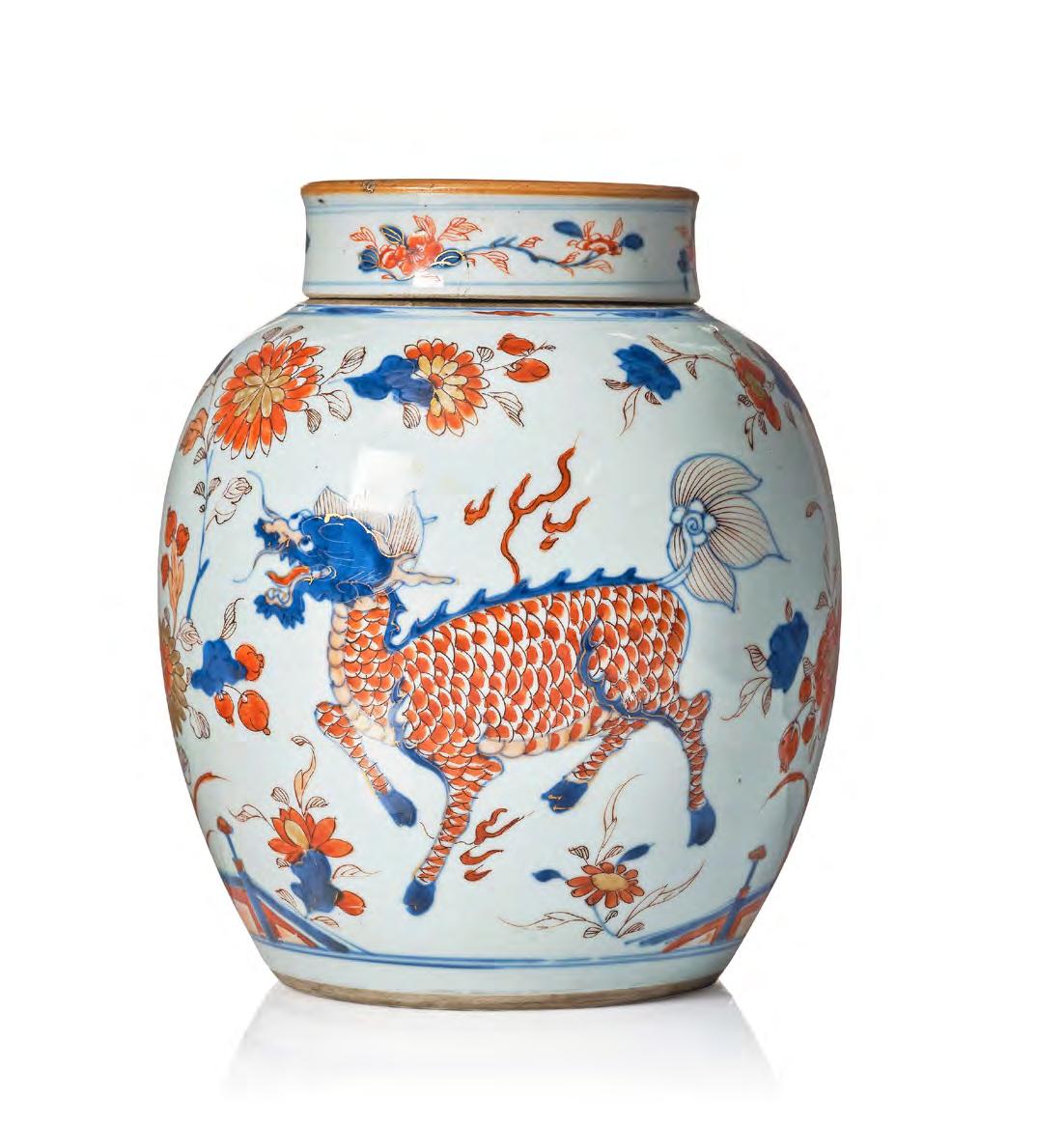
Decorated in imari colours with lively phoenix birds and mythical creatures in a garden setting. Height 24.5 cm.
Provenance: From the Collection of Tove and Karl Emil Strømstad (born 1936), Norway. Strømstad label 508.
Exhibitions: For other items from this collection, see Sothebys, Asian Arts / 5000 Years. 18 April 2023. Paris. Lot no 1–39.
Estimate: SEK 12 000 – 15 000 / EUR 1 060 – 1 320
1193. An imari jar with cover, Qing dynasty, Kangxi (1662–1722). Ovoid shape with an unglazed rim, decorated with a phoenix bird and a mythical creature. Height 23.5 cm.
From the Collection of Tove and Karl Emil Strømstad (born 1936), Norway. Strømstad label 491. Also with label from B F Edwards Collection. Also with label from Leo and Doris Hodroff Collection.
For other items from this collection, see Sothebys, Asian Arts / 5000 Years. 18 April 2023. Paris. Lot no 1–39.
SEK 15 000 – 20 000 / EUR 1 320 – 1 760
Baluster shape, with dolphins flanking a shell at the top, a head were the tap is supposed to be, decorated wtih a continous floral scroll. Height 41 cm.

Provenance: From the Collection of Tove and Karl Emil Strømstad (born 1936), Norway. Strømstad label 476a.
Purchased at Robert Michiels Auctions.)
Exhibitions: Compare a wall fountaing of this model, but with different decoration in the Peabody Essex Museum, Inventory no AE86587.1A-C. For other items from this collection, see Sothebys, Asian Arts / 5000 Years. 18 April 2023. Paris. Lot no 1–39.
Estimate: SEK 15 000 – 20 000 / EUR 1 320 – 1 760
Exhibitions: For other items from this collection, see Sothebys, Asian Arts / 5000 Years. 18 April 2023. Paris. Lot no 1–39.
Estimate: SEK 20 000 – 30 000 / EUR 1 760 – 2 640

1197. An imari dish, Qing dynasty, Kangxi (1662–1722).
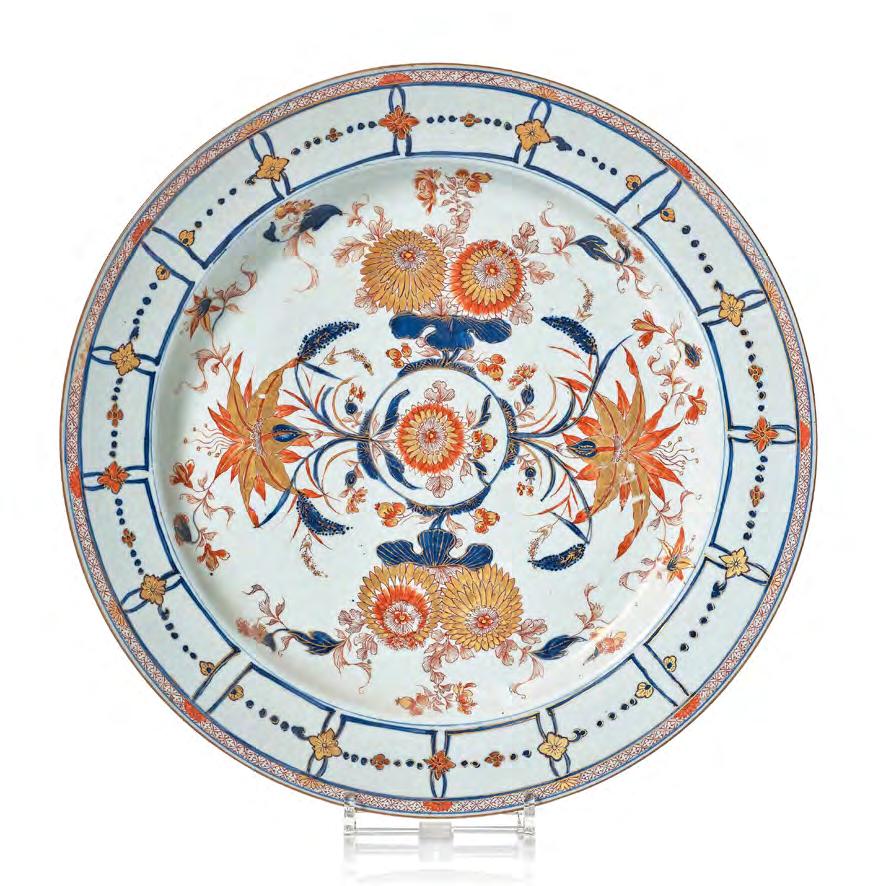

Decorated in imari colours with flowers, the reverse of the rim decorated with a continous lotus scroll. Diameter 35 cm.
Provenance: From the Collection of Tove and Karl Emil Strømstad (born 1936), Norway. Strømstad label 396. Purchased at Sheppard Irish Auctions mai 2013. Exhibitions: For other items from this collection, see Sothebys, Asian Arts / 5000 Years. 18 April 2023. Paris. Lot no 1–39.
Estimate: SEK 6 000 – 8 000 / EUR 530 – 710
1199. An imari bowl, Qing dynasty, Kangxi (1662–1722. Rounded sides on a tall footrim, decorated in imari colours with flowers. Diameter 23 cm.

Provenance: From the Collection of Tove and Karl Emil Strømstad (born 1936), Norway.
Exhibitions: For other items from this collection, see Sothebys, Asian Arts / 5000 Years. 18 April 2023. Paris. Lot no 1–39.
Estimate: SEK 5 000 – 7 000 / EUR 440 – 620
1198. An imari charger, Qing dynasty, Kangxi (1662–1722). Decorated with flowers. The reverse decorated with two floral sprigs and double circle. Diameter 42.5 cm.
Provenance: From the Collection of Tove and Karl Emil Strømstad (born 1936), Norway. Strømstad label 400. Purchased form Woolley and Wallis, 2003. Lot 803.
Exhibitions: For other items from this collection, see Sothebys, Asian Arts / 5000 Years. 18 April 2023. Paris. Lot no 1–39.
Estimate: SEK 8 000 – 10 000 / EUR 710 – 880
1200. An imari charger, Qing dynasty, Kangxi (1662–1722). Decorated in imari colours with chrysanthemum, lotus and peonies, around the rim further flowers. The reverse of the rim with two floral sprigs. Diameter 39 cm.


Provenance: From the Collection of Tove and Karl Emil Strømstad (born 1936), Norway. Strømstad label 395. Purchased
For other items from this collection, see Sothebys, Asian Arts / 5000 Years. 18 April 2023. Paris. Lot no 1–39.
Estimate: SEK 10 000 – 15 000 / EUR 880 – 1 320
1202. Two imari butter shells, Qing dynasty, early 18th Century. Shell shaped, decorated in imari colours. Measurement approx. 16 x 15 cm.
Provenance: From the Collection of Tove and Karl Emil Strømstad (born 1936), Norway.
Exhibitions: For other items from this collection, see Sothebys, Asian Arts / 5000 Years. 18 April 2023. Paris. Lot no 1–39.
Estimate: SEK 5 000 – 7 000 / EUR 440 – 620
1203. An imari ewer with cover, Qing dynasty, Kangxi
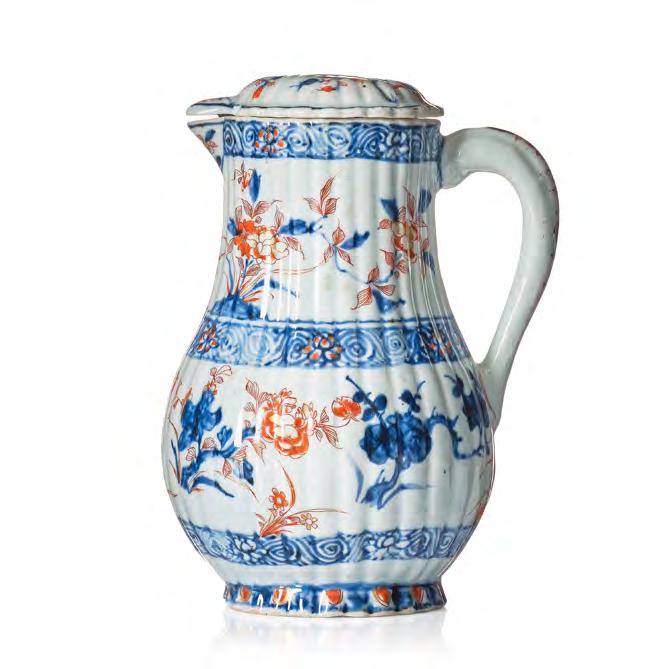
After a silver modell, decorated in vibrant colours with peonies,
Provenance: From the Collection of Tove and Karl Emil Strømstad (born 1936), Norway. Strømstad label 392.)
Exhibitions: Compare a ewer of this model but with coat of arms in the Musee Guimet, Paris. Inventory no G 5010 (+). Collection Ernest Grandidier. For other items from this collection, see Sothebys, Asian Arts / 5000 Years. 18 April 2023. Paris. Lot no 1–39.
Estimate: SEK 10 000 – 12 000 / EUR 880 – 1 060
1205. An imari charger, Qing dynasty, Kangxi (1662–1722). Decorated in imari colours with birds in a garden in full bloom. Diameter 39.2 cm.


Provenance: From the Collection of Tove and Karl Emil Strømstad (born 1936), Norway. Strømstad label 408. Purchased at Chiswick Auctions.
Exhibitions: For other items from this collection, see Sothebys, Asian Arts / 5000 Years. 18 April 2023. Paris. Lot no 1–39.
Estimate: SEK 8 000 – 10 000 / EUR 710 – 880
1204. An imari ewer with cover, Qing dynasty, Kangxi (1662–1722).
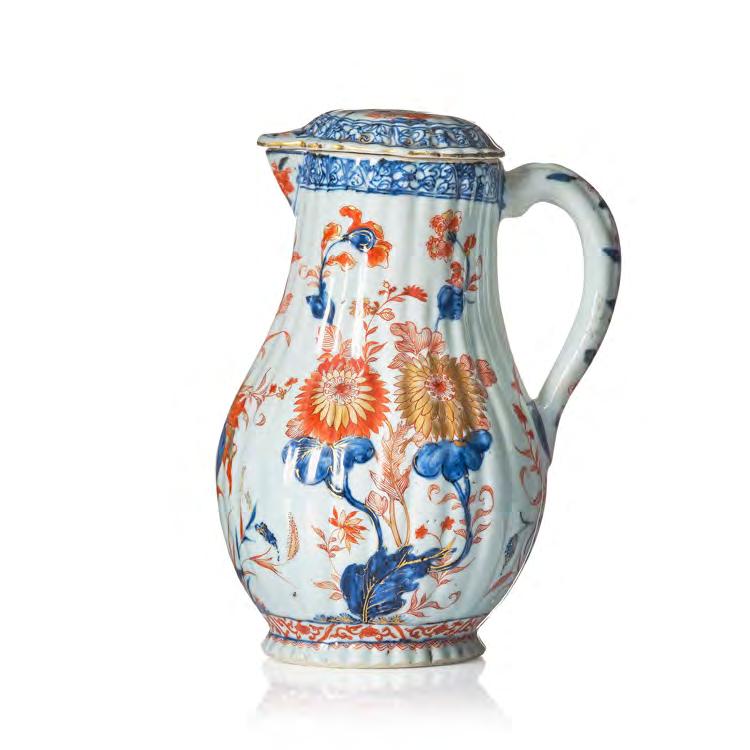
After an european silver model, decorated in imari colours with flowers and bands. Height 22.5 cm.
Provenance: From the Collection of Tove and Karl Emil Strømstad (born 1936), Norway. Strømstad label 342.
Exhibitions: Compare a ewer of this model but with coat of arms in the Musee Guimet, Paris. Inventory no G 5010 (+). Collection Ernest Grandidier. For other items from this collection, see Sothebys, Asian Arts / 5000 Years. 18 April 2023. Paris. Lot no 1–39.
Estimate: SEK 10 000 – 12 000 / EUR 880 – 1 060
1207. An Imari tankard, Qing dynasty, Kangxi (1662–1722). Slightly pear shaped, decorated in imari colours with peonies in full bloom. Height 16 cm.

Provenance: From the Collection of Tove and Karl Emil Strømstad (born 1936), Norway. Strømstad label 359.
Exhibitions: For other items from this collection, see Sothebys, Asian Arts / 5000 Years. 18 April 2023. Paris. Lot no 1–39.
Estimate: SEK 6 000 – 8 000 / EUR 530 – 710
1206. An imari dish with pierced sides, Qing dynasty, early 18th Century.
Decorated in imari colours with a man on his horse riding through a landscape by the river. Diameter 24.5 cm.

Provenance: From the Collection of Tove and Karl Emil Strømstad (born 1936), Norway. Strømstad label 393.
Exhibitions: For other items from this collection, see Sothebys, Asian Arts / 5000 Years. 18 April 2023. Paris. Lot no 1–39.
Estimate: SEK 3 000 – 4 000 / EUR 270 – 360
1208. An imari chamber pot with cover, Qing dynasty, Kangxi (1662–1722).

Decorated in imari colours with flowers. Length 21.5 cm. Height 12 cm.
Provenance: From the Collection of Tove and Karl Emil Strømstad (born 1936), Norway. Strømstad label 354.)
Exhibitions: For other items from this collection, see Sothebys, Asian Arts / 5000 Years. 18 April 2023. Paris. Lot no 1–39.
Estimate: SEK 6 000 – 8 000 / EUR 530 – 710
1209. An imari coffee pot, Qing dynasty, early 18th Century. Siver mounted cover. Decorated in imari colours with a garden with peonies in full bloom. Height 22 cm.

Provenance: From the Collection of Tove and Karl Emil Strømstad (born 1936), Norway. Strømstad label 346.)
Exhibitions: For other items from this collection, see Sothebys, Asian Arts / 5000 Years. 18 April 2023. Paris. Lot no 1–39.
Estimate: SEK 6 000 – 8 000 / EUR 530 – 710
1211. An imari water sprinkler and a dish, Qing dynasty, Kangxi (1662–1722).

The height of the water sprinkler 21 cm. Diameter of dish 21.5 cm.
Provenance: From the Collection of Tove and Karl Emil Strømstad (born 1936), Norway.
Exhibitions: For other items from this collection, see Sothebys, Asian Arts / 5000 Years. 18 April 2023. Paris. Lot no 1–39.
Estimate: SEK 5 000 – 7 000 / EUR 440 – 620
1210. A set of four imari verte dishes with parrots, Qing dynasty, Decorated with parrots amidst peonies, fruits, flowers and a dragonfly.

From the Collection of Tove and Karl Emil Strømstad (born 1936), Norway.Strømstad label 102.
For other items from this collection, see Sothebys, Asian Arts / 5000 Years. 18 April 2023. Paris. Lot no 1–39.
SEK 5 000 – 7 000 / EUR 440 – 620
1212.
 A silver mounted tankard, Qing dynasty, Kangxi (1662–1722). Unidetified makers mark on the silver. Engraved dating to the cover 1799. Silver coin to the center of the cover. 'CAROLUS IV DEI GRATIA 1789'. 'HISPAN IND REX'. Decorated in iron red and gold. Height 20 cm.
A silver mounted tankard, Qing dynasty, Kangxi (1662–1722). Unidetified makers mark on the silver. Engraved dating to the cover 1799. Silver coin to the center of the cover. 'CAROLUS IV DEI GRATIA 1789'. 'HISPAN IND REX'. Decorated in iron red and gold. Height 20 cm.
1213. An iron red tankard, Qing dynasty, Kangxi (1662–1722). Cylindrical shape with a raised handle, decorated in iron red and gold with flowers. Height 16 cm.
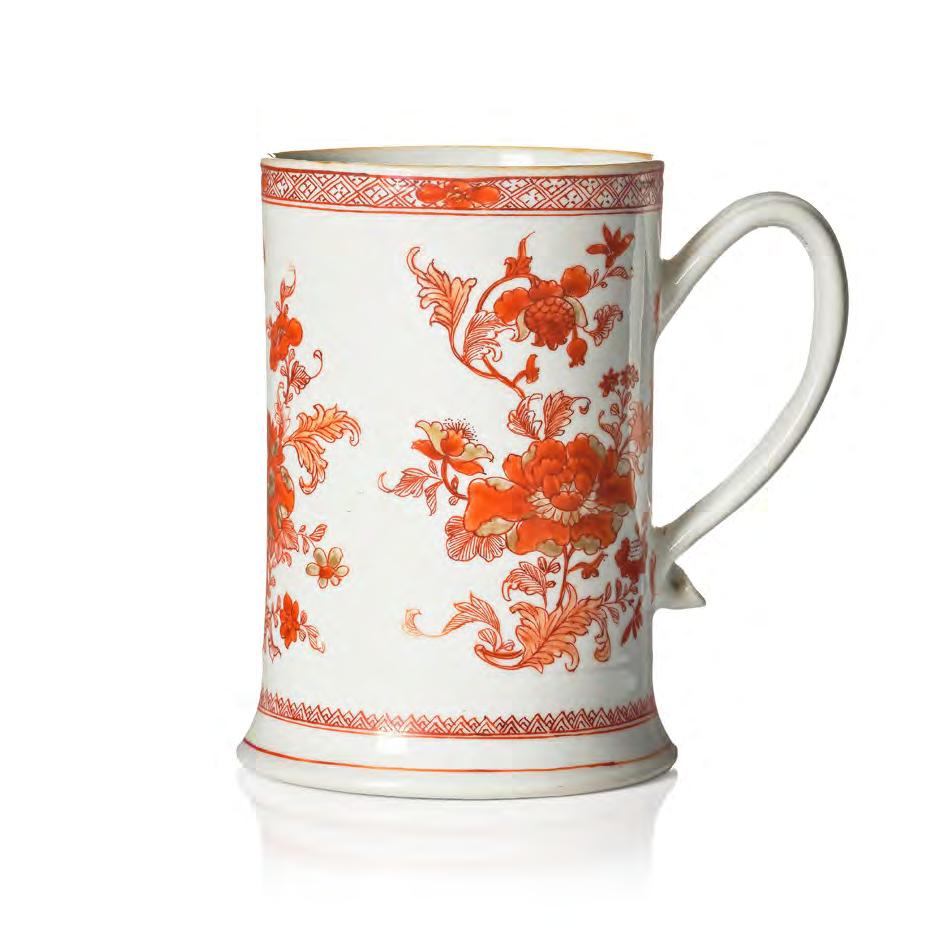
P rovenance: From the Collection of Tove and Karl Emil Strømstad (born 1936), Norway.
Exhibitions: For other items from this collection, see Sothebys, Asian Arts / 5000 Years. 18 April 2023. Paris. Lot no 1–39.
Estimate: SEK 10 000 – 15 000 / EUR 880 – 1 320
1214. A iron red bowl, Qing dynasty, early 18th Century. Decorated in iron red with flowers and pomme granate.

Diameter 26 cm.
Provenance: From the Collection of Tove and Karl Emil Strømstad (born 1936), Norway.
Exhibitions: For other items from this collection, see Sothebys, Asian Arts / 5000 Years. 18 April 2023. Paris. Lot no 1–39.
Estimate: SEK 6 000 – 8 000 / EUR 530 – 710
1215. A iron red rose water sprinkler, Qing dynasty, Kangxi (1662–1722).
Drop shaped decorated in iron red and gold with a floral scroll. Height 20 cm.

Provenance: From the Collection of Tove and Karl Emil Strømstad (born 1936), Norway. Strømstad label 526.
Exhibitions: For other items from this collection, see Sothebys, Asian Arts / 5000 Years. 18 April 2023. Paris. Lot no 1–39.
Estimate: SEK 4 000 – 6 000 / EUR 360 – 530
1216. A matched set of bowls, Qing dynasty, early Moulded shape with tulips around the sides. Decorated in iron red and gold. One of them with an interior scene with a pair of elegant ladies playing a board game in a garden. Both decorated to the exterior with flowers. Diameter approx. 20 cm.
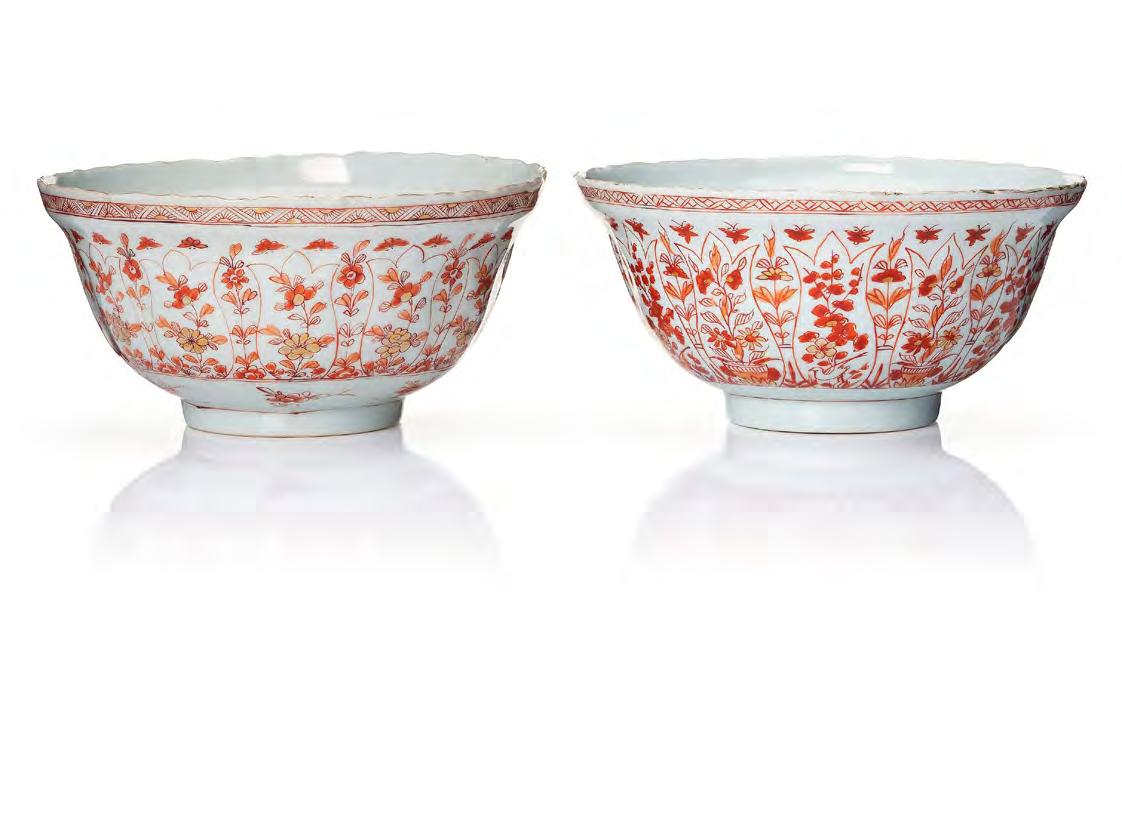
From the Collection of Tove and Karl Emil Strømstad (born 1936), Norway. Strømstad label 546.
For other items from this collection, see Sothebys, Asian Arts / 5000 Years. 18 April 2023. Paris. Lot no 1–39.
SEK 8 000 – 10 000 / EUR 710 – 880
1217. A black and iron red decorated bowl, Qing dynasty, early 18th Century.

Rounded sides on a tall footrim, the exterior decorated in a black glaze, s.k. 'mirror-black'. The interior decorated in underglaze blue, iron red and gld. Diameter 19 cm.
Provenance: From the Collection of Tove and Karl Emil Strømstad (born 1936), Norway. Strømstad label 479. Swan Auctions.
Exhibitions: For other items from this collection, see Sothebys, Asian Arts / 5000 Years. 18 April 2023. Paris. Lot no 1–39.
Estimate: SEK 6 000 – 8 000 / EUR 530 – 710
1218. A cappuciner brown and famille rose coffee pot with cover, Qing dynasty, 18th Century. Cone shaped with handle and spout and doomed cover, decorated in famille rose. Height 22 cm.

From the Collection of Tove and Karl Emil Strømstad (born 1936), Norway. Strømstad label 348a. Purchased at Bukowskis 2010. For other items from this collection, see Sothebys, Asian Arts / 5000 Years. 18 April 2023. Paris. Lot no 1–39.
SEK 6 000 – 8 000 / EUR 530 – 710
1219. A Chinese Export chamber pot with cover, Qing dynasty, Kangxi (1662–1722).

Decorated in ironred against a cappuciner brown ground. Length 22 cm. Height 12 cm.
Provenance: From the Collection of Tove and Karl Emil Strømstad (born 1936), Norway.
Exhibitions: For other items from this collection, see Sothebys, Asian Arts / 5000 Years. 18 April 2023. Paris. Lot no 1–39.
Literature: Compare a tea pot of this style of decoration in the Musee Guimet,
1220. A famille rose serving dish, Qing dynasty, Yongzheng (1723–35).

Decorated with a blossoming cherry tree, peonies and chrysanthemum. Diameter 36 cm.
Provenance: From the Collection of Tove and Karl Emil Strømstad (born 1936), Norway. Strømstad label 493. Vendehuis De Jager, Holland.
Exhibitions: For other items from this collection, see Sothebys, Asian Arts / 5000 Years. 18 April 2023. Paris. Lot no 1–39.
Estimate: SEK 8 000 – 10 000 / EUR 710 – 880
1221. A pair of famille rose trembleuses, Qing dynasty, 18th Century. Shell shaped with pierced cup holders, decorated in famille rose. Length 22 cm.

Provenance: From the Collection of Tove and Karl Emil Strømstad (born 1936), Norway. Strømstad label 537. And with old collectors label to the base.
Exhibitions: For other items from this collection, see Sothebys, Asian Arts / 5000 Years. 18 April 2023. Paris.
Lot no 1–39.
Catalogue note: After a silvered model, probably made for the Spanish market. A mancerina/trembleuse is special piece for the chocolate service. It was invented by a Spanish grandee, in Mexico, in the seventeenth century and was named after the man who had invented it, Pedro de Toledo, 1st Marquis of Mancera, who served as Viceroy of Peru from 1639 to 1648. Known in France as “tasse trembleuse” and “Chocolate stand” in England, some were ordered from China but remain more easy to find in Southern Europe.
Estimate: SEK 25 000 – 30 000 / EUR 2 200 – 2 640
1222. A famille rose tea service, Qing dynasty, Qianlong (1736–95). (18 pieces). Decorated in famille rose with flowers. Comprising; teapot with cover, a tea dish, a milk jug, a tea caddy, 8 cups with handle, six cups without handle. Length of tea pot 21 cm

Provenance: From the Collection of Tove and Karl Emil Strømstad (born 1936), Norway.
Exhibitions: For other items from this collection, see Sothebys, Asian Arts / 5000 Years. 18 April 2023. Paris. Lot no 1–39.
Estimate: SEK 12 000 – 15 000 / EUR 1 060 – 1 320
1223. A famille rose bowl, Qing dynasty, Qianlong (1736–95). Decorated in famille rose colours. Diameter 20.5 cm.

Provenance: From the Collection of Tove and Karl Emil Strømstad (born 1936), Norway.
Exhibitions: For other items from this collection, see Sothebys, Asian Arts / 5000 Years. 18 April 2023. Paris. Lot no 1–39.
Estimate: SEK 3 000 – 5 000 / EUR 270 – 440
1225. A large ewer with handle, late Qing dynasty. Octagonal in the shape of a water bucket, decorated in famille jeune with flowers. Height 22.5 cm. Length 20 cm.

Provenance: From the Collection of Tove and Karl Emil Strømstad (born 1936), Norway.
Exhibitions: For other items from this collection, see Sothebys, Asian Arts / 5000 Years. 18 April 2023. Paris. Lot no 1–39.
Estimate: SEK 10 000 – 15 000 / EUR 880 – 1 320
1224. A pair of famille rose miniature cups with stands, Qing dynasty, Decorated in famille rose colours with an elegant woman with a flower basket to the center. Diameter of cup 5 cm. Diameter of dish 9 cm.

From the Collection of Tove and Karl Emil Strømstad (born 1936), Norway. The couple built their collection over the decades. They started to collect in the early 1970's after buying the first piece, a famille rose bowl, dating from the 18th Century. Mr Strømstads work at IBM brought the couple and their family to various places around the world and they built their vast academic collection of ceramics dating from the Han dynasty to the Qing dynasty by visiting auction houses, antique dealers and antique fairs. Always striving to acquire pieces form different epoques and constantly seeking more knowledge about the pieces, the techniques and their history.
Exhibitions: For other items from this collection, see Sothebys, Asian Arts / 5000 Years. 18 April 2023. Paris. Lot no 1–39.
Estimate: SEK 4 000 – 6 000 / EUR 360 – 530
1226. A pair of cloisonné cups, late Qing dynasty. Decorated with butterflies and flowers. Diameter 8 cm. Height 4.8 cm.

Provenance: From the Collection of Tove and Karl Emil Strømstad (born 1936), Norway.
Exhibitions: For other items from this collection, see Sothebys, Asian Arts / 5000 Years. 18 April 2023. Paris. Lot no 1–39.
Estimate: SEK 4 000 – 6 000 / EUR 360 – 530
Baluster shape, decorated in relief with an archaistic bronze pattern, handles in the shape of elephant heads. Height 14.5 cm.
Provenance: From the Collection of Tove and Karl Emil Strømstad (born 1936), Norway. Strømstad label 91. Purchased at the antique fair 1985.
Exhibitions: For other items from this collection, see Sothebys, Asian Arts / 5000 Years. 18 April 2023. Paris. Lot no 1–39.
Estimate: SEK 4 000 – 6 000 / EUR 360 – 530
1228. A blanc de chine libation cup, Qing dynasty, Kangxi (1662–1722).

In the shape of a rhinoserous horn, decorated in relief with a deer and a dragon. Height 6 cm, length 10.5 cm.
Provenance: From the Collection of Tove and Karl Emil Strømstad (born 1936), Norway. Strømstad label 72. Purchased from W van Halm. Portobello Road 1985.)
Exhibitions: For other items from this collection, see Sothebys, Asian Arts / 5000 Years. 18 April 2023. Paris. Lot no 1–39.
Estimate: SEK 5 000 – 7 000 / EUR 440 – 620

1229. A set of two dancers, Western Han dynasty (206 BC - 220 AD).
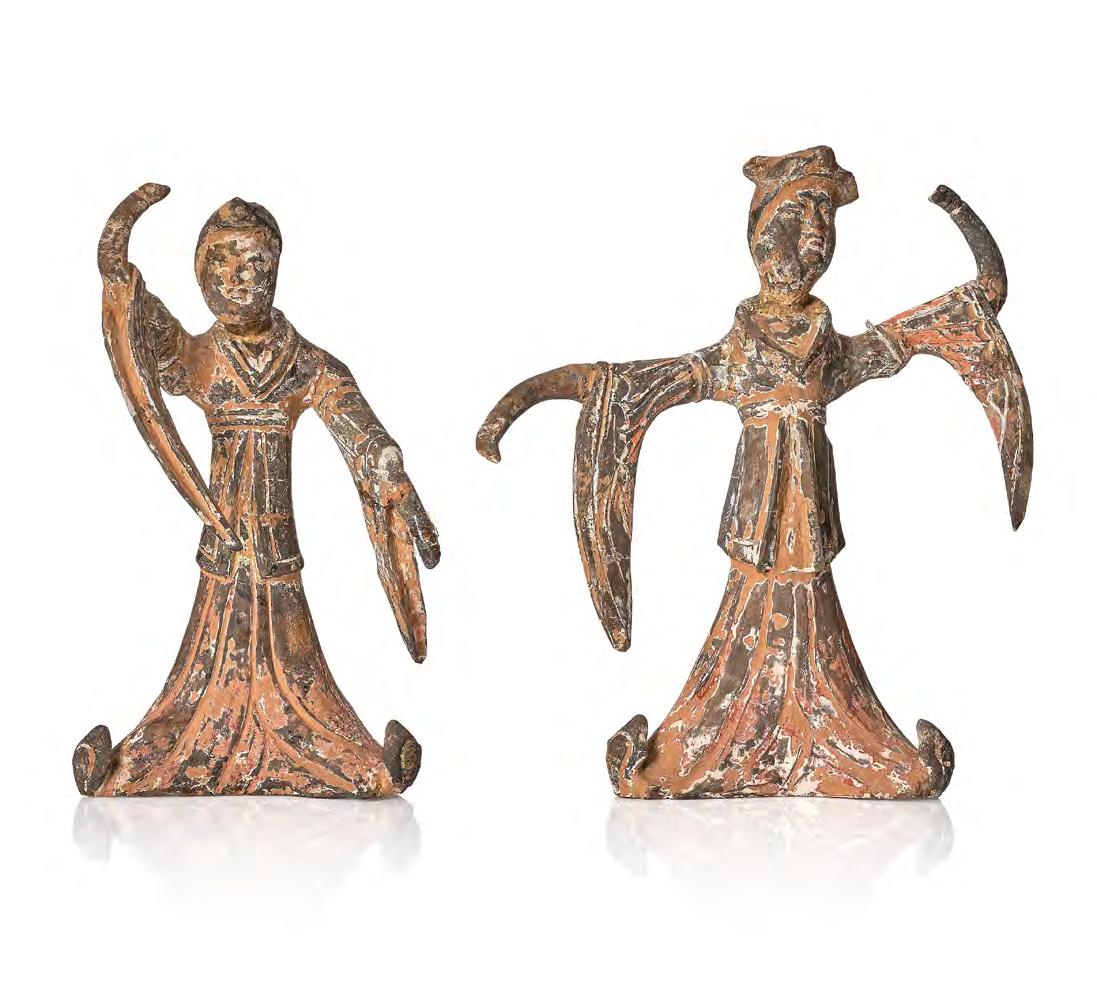
With traces of red, black and blue colour pigment. Height 29.5 cm.
Provenance: Purchased at Bukowskis sale 559:1399. Then from the Emil Hultmark Collection. Emil Hultmark was one of the co-founders of the ‘Kinaklubben’ (China Club) in Stockholm in the 1920's with Carl Kempe (1884–1967) and the Crown Prince Gustav Adolf. He is a well known collector and his beautiful home and summer house is well documented in the magazine 'Svenska Hem i ord och bild' in the 1930's, which provide us with a fascinating window into this golden age of European collecting.
Estimate: SEK 16 000 – 20 000 / EUR 1 410 – 1 760
1230. A Junyao purple-splashed blue glazed bowl. Song/Yuan dynasty.

Round shape, blue glaze and the purple splash to the interior. Height 6.5 cm, diameter 13.5 cm.
Provenance: Purchased from Antik West 2012.
According to Antik West upon purchase from the Collection of Mr Carl Ekman (1883–1957) who got it as a gift from M. T. Lau at The Ekman Foreign Agencies (China) Ltd for his 60th or 70th birthday in the 1940s or 1950s. Carl Ekman was a Swedish businessman who worked for Ekman & Co, a Swedish company founded in 1802.
Estimate: SEK 20 000 – 25 000 / EUR 1 760 – 2 200
1231. A massive green and yellow glazed joss stick holder, Ming dynasty (1368–1644).
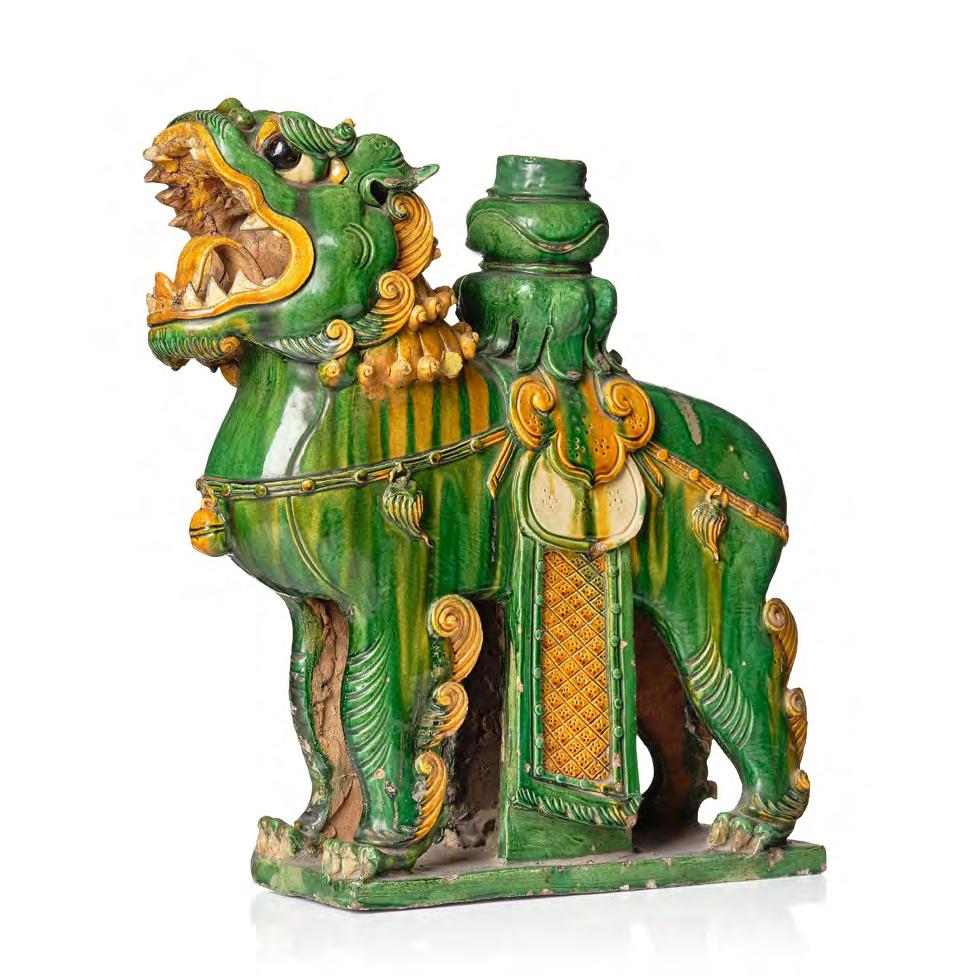
Standing on a postament, carrying a saddle, saddlepad with a censer on its back. Height 55 cm. Lenght 50 cm.
Provenance: Property of a Swedish private collection.
Exhibitions: Compare sculptures of this type in the British Museum. Museum number 1910,1223.1.
Estimate: SEK 8 000 – 10 000 / EUR 710 – 880
1233. A melon shaped jar decorated with the eight immortals, Ming dynasty, 17th Century.
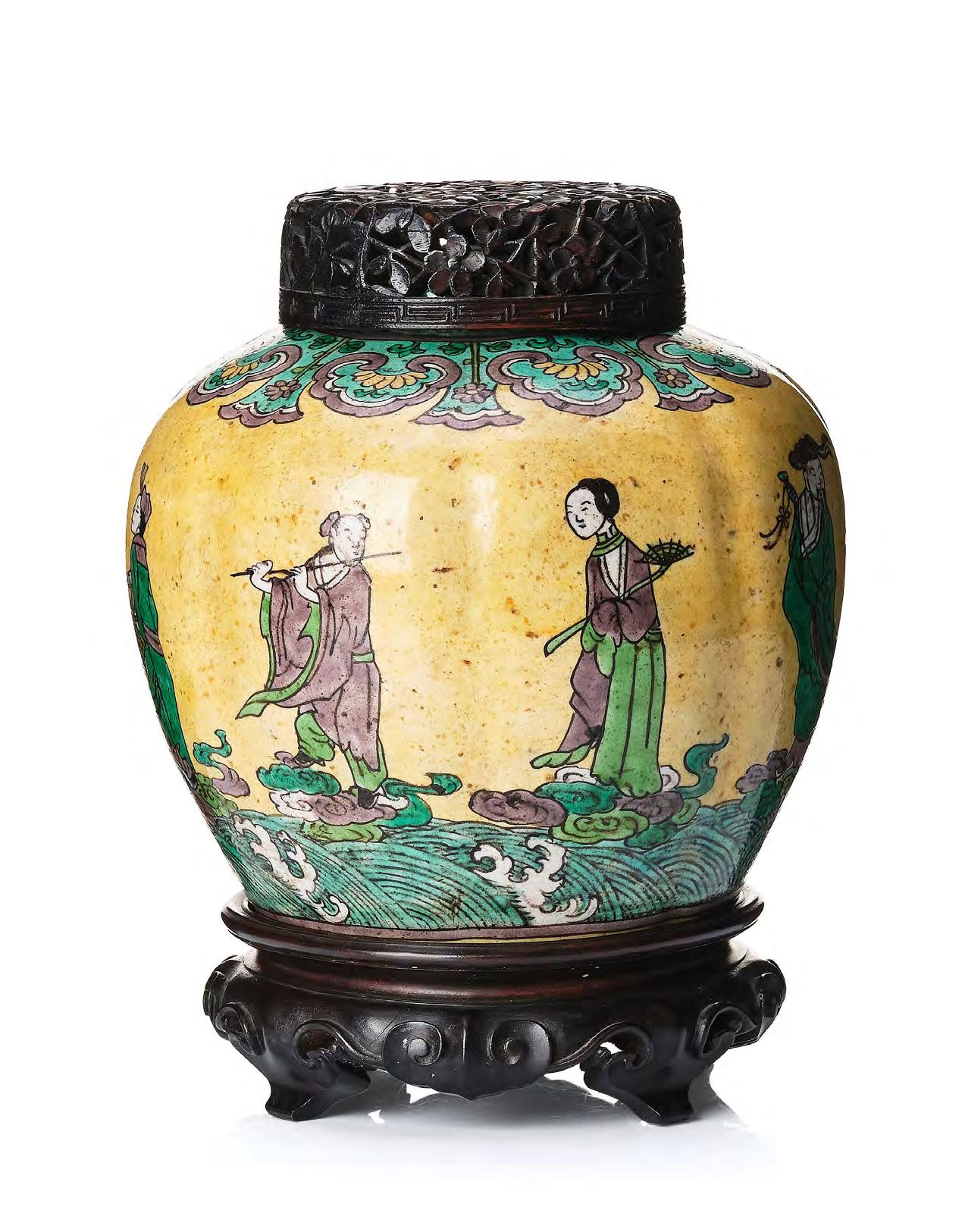
Melon shaped, decorated with the eight daoist immortals above fierce waves, the shoulder with a lambrequin pattern, all against a yellow ground, Height 17 cm. Height with accompanying wooden cover and stand 24.5 cm.
Provenance: From the Collection of Herman Lindell (1851–1926), thence by descent. Helmer Lindell founded the company OY Herman Lindell AB on the Esplanaden in Helsinki in 1890 and the company sold office and artist materials, which meant that there were close contacts with artists. Herman Lindell had a large art and works of art collection with works by, among others by amous Scandinavian artists such as Axel Gallen Kallela, Carl Larsson, Helene Schjerfbeck, Jarnefalt and Albert Edelfelt.
Estimate: SEK 8 000 – 10 000 / EUR 710 – 880
1232. A large glazed candle/joss stick holder, late Ming dynasty (1368–1644).
A standing mythical creature, with a saddelcloth and a vase on its back, glazed in yellow, green and creme. Height 37 cm. Length 44 cm.

Provenance: Property of a Swedish private collection.
Exhibitions: Compare sculptures of this type in the British Museum. Museum number 1910,1223.1.
SEK 8 000 – 10 000 / EUR 710 – 880
1234. A reticulated lonquan celadon vase/candle holder, Ming dynasty (1368–1644).

Pierced sides, decorated with flowers. Height 13 cm.
Exhibitions: Compare a vase sold at Christies, March 2008, New York, lot no 571.
Literature: J Harrisson Hall, Ming Ceramics in the British Museum, London 2001. pp 474-5. Openwork lonquan celadon vessels of this type are rare. Another example is illustrated here. There is a discussion about if these vessels might have contained incenese or been a brushpot since they are pierced.
Estimate: SEK 4 000 – 6 000 / EUR 360 – 530
1235. A celadon tripod censer. Qing dynasty (1664–1912). Round body on three curved legs, waisted neck with two raised handles. Wooden stand accompanies the piece. Height 19 cm.

Provenance: Purchased at Bukowskis 408: 928, in 1978.
SEK 6 000 – 8 000 / EUR 530 – 710
1236.
The Guanyin is standing on a cloud formation, dressed in a robe with rich drapings, bejewelled, tiara. Height 44 cm.

Provenance: The Collection of G. B. Sabelström (1888–1944). Sabelström worked for the Indian Brewery/United Breweries and lived in Shanghai from the 1920s up until his death in 1944. He was an important art collector and a member of The Royal Asiatic Society in Shanghai that was closely related to the Shanghai Art Museum. As he passed without heirs, he left his collection to Erik Dahl (1896–1979), a Swedish agent for the Swedish paperindustry stationed in Shanghai and Kobe during the 1920s. Erik Dahl returned to Sweden by the Trans-Siberian Railway and the collection was sent by sea to Sweden after World War II. Thence by descent.
Estimate: SEK 6 000 – 8 000 / EUR 530 – 710
A blanc de chine figure of Guanyin, Qing dynasty, 18/19th Century.
1238. Two blanc de chine libation cups, Qing dynasty, Kangxi (1662–1722).

In the shape of rhinoserous horns, decorated in relief. Length 13.5–14 cm.
Estimate: SEK 8 000 – 10 000 / EUR 710 – 880
1237. A blanc de chine libation cup, Qing dynasty, Kangxi (1662–1722).
In the shape of a rhinoceros horn, decorated in relief with dragons and a deer in a landscape setting with prunus. On a wooden base with carved branches. The cups height 8 cm. Total height including the wooden base 12 cm.
Provenance: The Collection of G. B. Sabelström (1888–1944). Sabelström worked for the Indian Brewery/United Breweries and lived in Shanghai from the 1920s up until his death in 1944. He was an important art collector and a member of The Royal Asiatic Society in Shanghai that was closely related to the Shanghai Art Museum. As he passed without heirs, he left his collection to Erik Dahl (1896–1979), a Swedish agent for the Swedish paperindustry stationed in Shanghai and Kobe during the 1920s. Erik Dahl returned to Sweden by the Trans-Siberian Railway and the collection was sent by sea to Sweden after World War II. Thence by descent.)
Estimate: SEK 6 000 – 8 000 / EUR 530 – 710
1239. A massive blanc de chine basin, Qing dynasty, 18th Century. With a 滄亭清玩 'cang ting qing wan' mark.

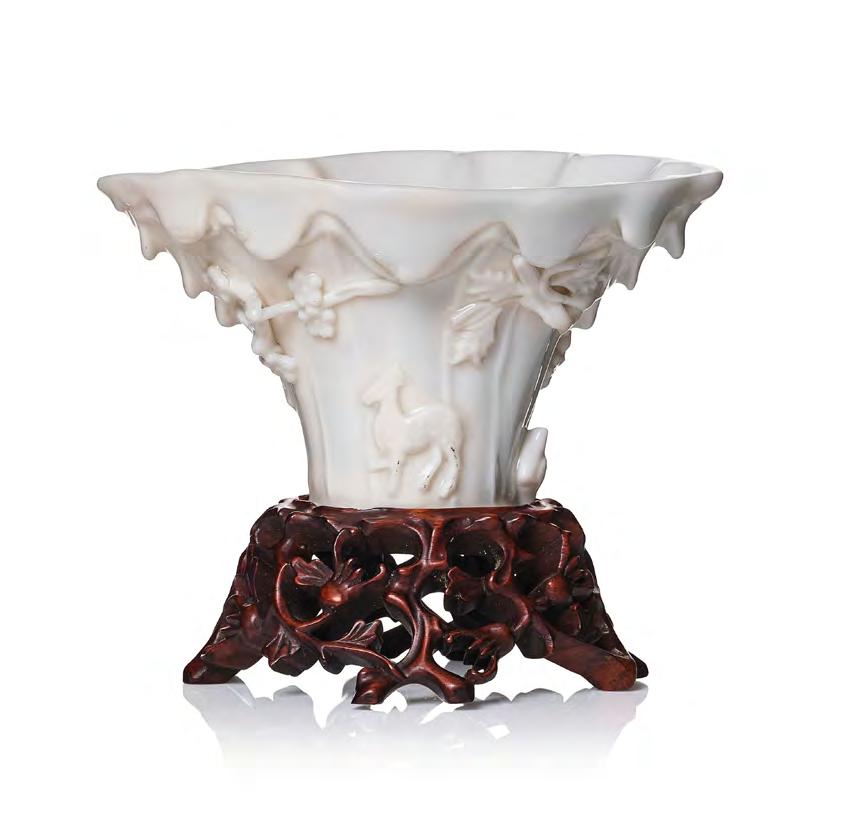
The four character mark can be translated as ‘the pure trinket of the Cang Pavilion’. Archaistic decoration in relief. Diameter 63.5 cm. Height 49 cm.
Provenance: From the Alströmer family Collection at Östad Säteri, Västergötland, Sweden, thence by descent. From the Collection of Patrick Alströmer (1733–1804). The massive piece can be traced back to the estate inventory of Patrick Alströmer. Mr Alströmer was a Swedish noble man and famous industrialist of the 18th Century. The family had business in Alsingsås, and in Russia. His brother Claes Alströmer was a merchant in Gothenburg and a well known bothanist as well as married to Niclas Sahlgrens daugher. Patrick held a number of offices such as kommersråd 1770, landshövding 1774. Director of the Swedish East India Company 1777. He and his brother were introduced in 1778. He founded the Muscical Academy and was a member of the Royal Swedish Academy of Sciences. His brother Claes Alströmer worked with Carl von Linne and sailed on the east -india men to gather information on plants. Claes was also married to Niclas Sahlgrens daughter.)
Catalogue note: Depicted online is the inventory of the Estate of Mr Patrik Alströmer, dated 1804. Then listed as in good condition. In the inventory in 1892, after Jonas Alströmer (1807–1891) it is listed again.

Lot. no 1045. A pair of spotted bamboo chairs and a table, Qing dynasty, 19th Century.
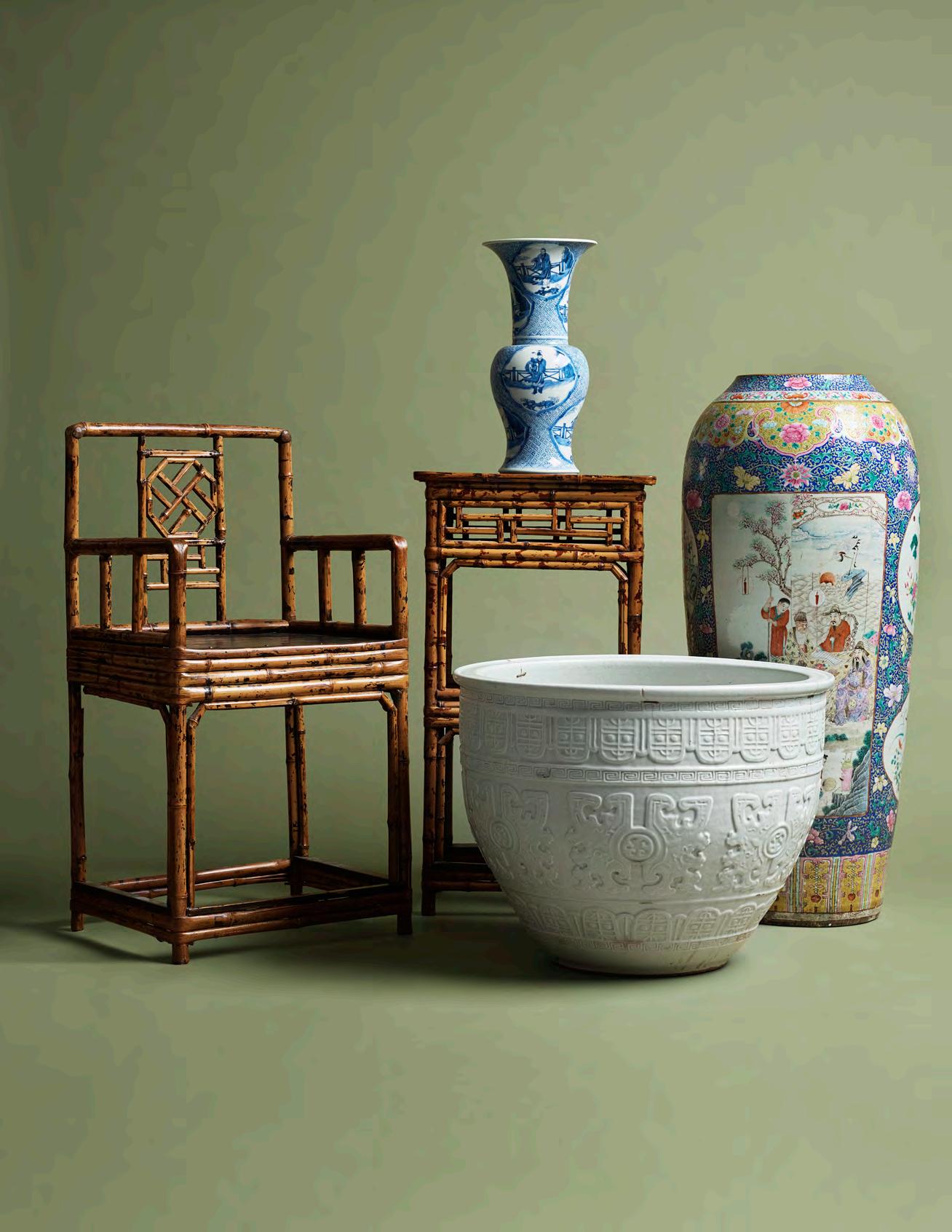
Lot. no 1322. A blue and white vase, Qing dynasty, Kangxi (1662–1722).
Lot. no 1239. A massive blanc de chine basin, Qing dynasty, 18th C entury. With a 滄亭清玩 ’cang ting qing wan’ mark.
Lot. no 1279. A large palace vase, Qing dynasty, 19th Century.
1240. A pair of turquoise glazed porcelain figures of buddhist lions, Qing dynasty 18th/19th Century.

Seated lions one with a brocade ball, the other with a cub under the front paw. Height 14 cm. Height with wooden stand 16 cm.
Estimate: SEK 15 000 – 20 000 / EUR 1 320 – 1 760
1241. A sang de boeuf glazed vase, Qing dynasty, 19th Century. Rounded base, slender neck, decorated in a sang de boef glaze. Height 26 cm.

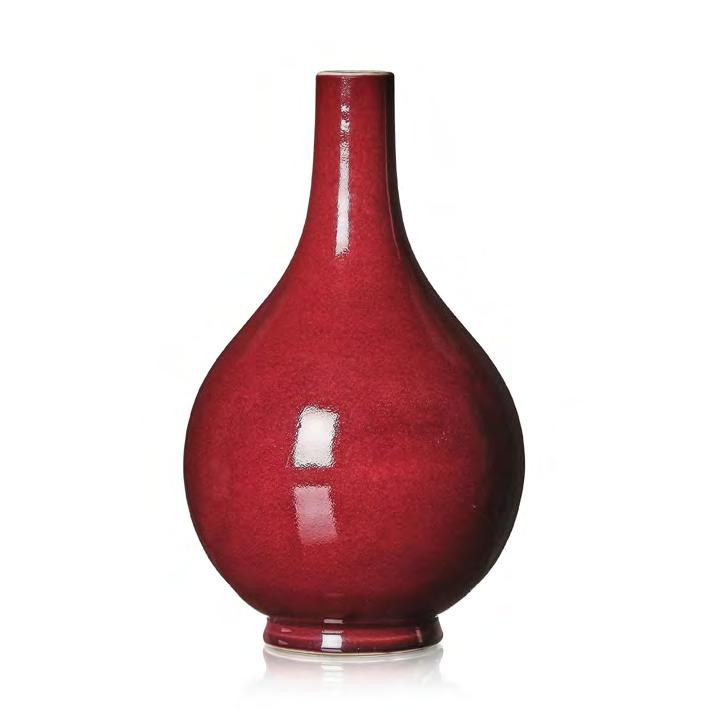
Provenance: Property from a Swedish Private Collection. The vase was given to the present owner by Nita Wallenberg, daughter of Gustaf Wallenberg, Swedish Envoyé of Japan and China in the early 20th Century. The families got to know each other when they worked toghther in Mexico City for LM Ericson with Nitas husband Mr Söderlund in the 1930s and 1940s.
SEK 6 000 – 8 000 / EUR 530 – 710
Dropp shaped with a tall neck and slightly flared rim. Height 21 cm.
Estimate: SEK 4 000 – 6 000 / EUR 360 – 530
1242. A flambe glazed vase, Qing dynasty, 19th Century.
1243. An armorial imari charger, Qing dynasty, early 18th Century. Decorated in imari colours with garlands and a central crest below the coronet of a count. Diameter 43 cm.
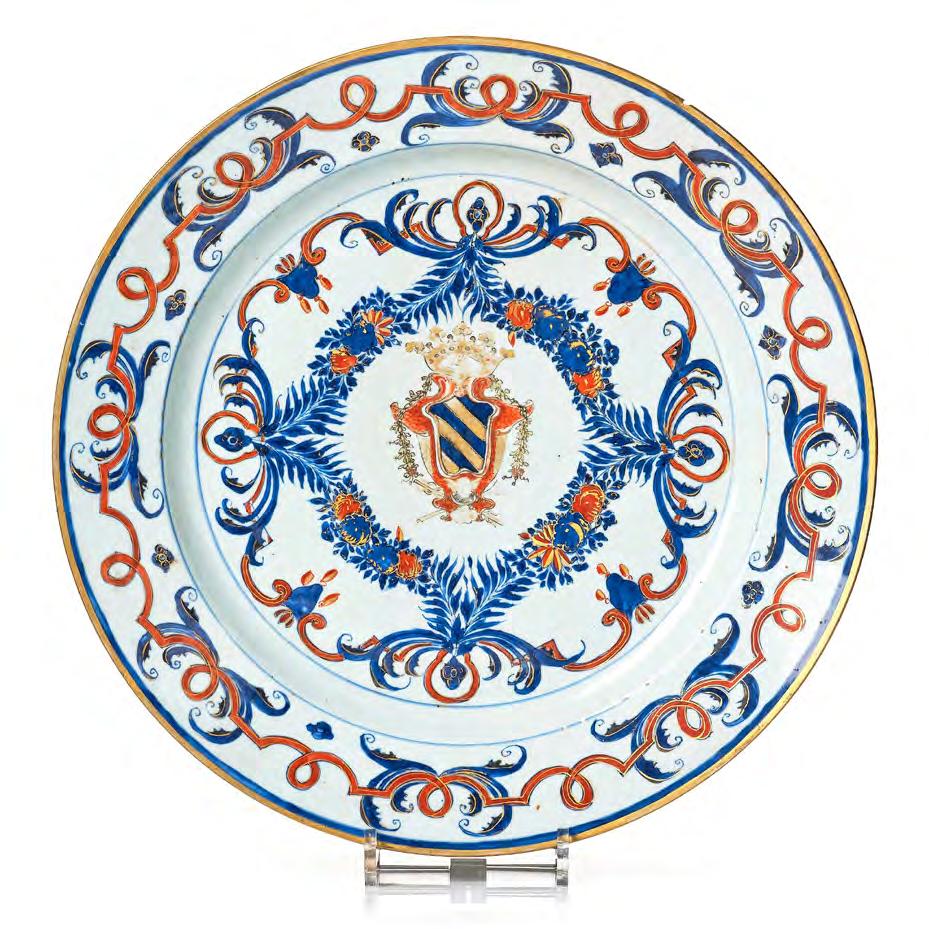
Provenance: Stig and Kerstin Dillberg. Thence by descent to the present owner.
Estimate: SEK 15 000 – 20 000 / EUR 1 320 – 1 760
1244. A wucai censer for the 'Islamic' market, Transition, 17th Century.
Hall mark to base. Round on three feet. Decorated in wucai colours with roundels with islamic script against a ground with a continous lotus scroll. Height 9 cm. Diameter 12 cm.
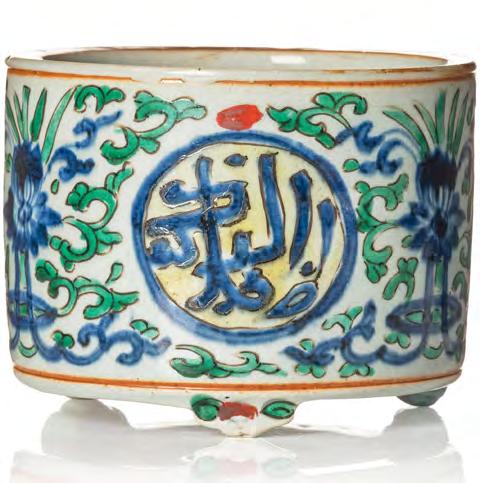
Estimate: SEK 8 000 – 10 000 / EUR 710 – 880
1245. A wucai Transitional sleeve vase, 17th Century. Round, tall with a waisted neck and flared rim. Decorated in green, red, yellow and black enamels on an underglaze blue decoration depicting a bird and insects in a garden setting. Height 20 cm.

Provenance: From a Swedish private collection, purchased at Beijiers Auktioner, 1988, lot no 837.
Estimate: SEK 8 000 – 10 000 / EUR 710 – 880
1246. A pair of egg and spinach glazed figures of mythical creatures, Qing dynasty, Kangxi (1662–1722).
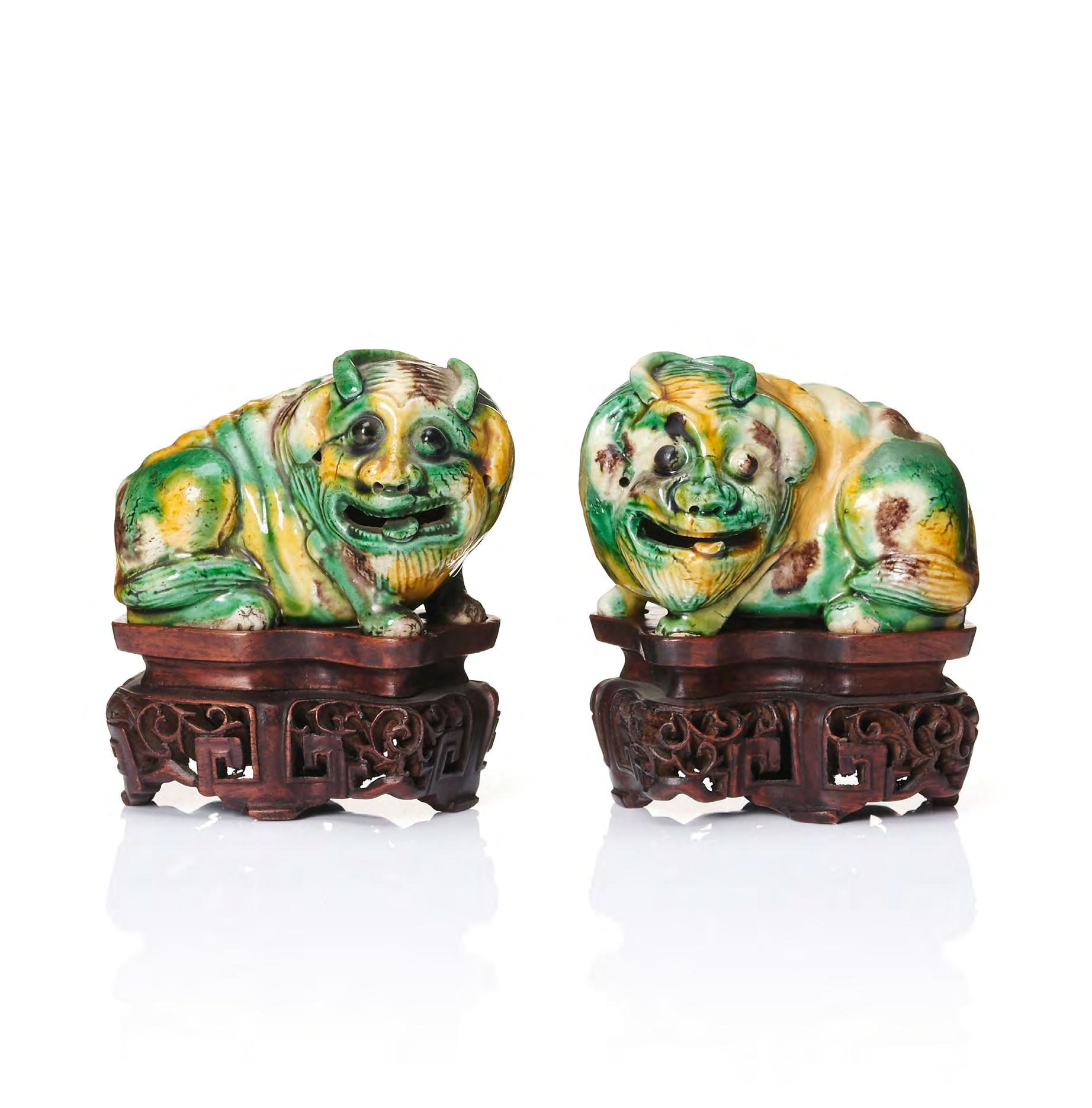
Reclining sancai glazed mythical beasts. Length 8 cm. Height with wooden stand 9.5 cm.
Provenance: From the Collection of P Wedendal. Purchased in London at Bluett and Son. Label to the base.
Exhibitions: Compare one sold in these rooms at Bukowskis sale 645, lot no 858. From the Collection of Ivar Björnberg.
Literature: Compare one in the Collection of the Hallwylska Museet, Stockholm.
Estimate: SEK 20 000 – 30 000 / EUR 1 760 – 2 640
1248. An impressive famille verte charger, Qing dynasty, Kangxi (1662–1722).
Finely decorated in famille verte colours with a figure scene with an elegant couple in a pavillion with a qin, antquies, flowers and precious objects. Diameter 37 cm.
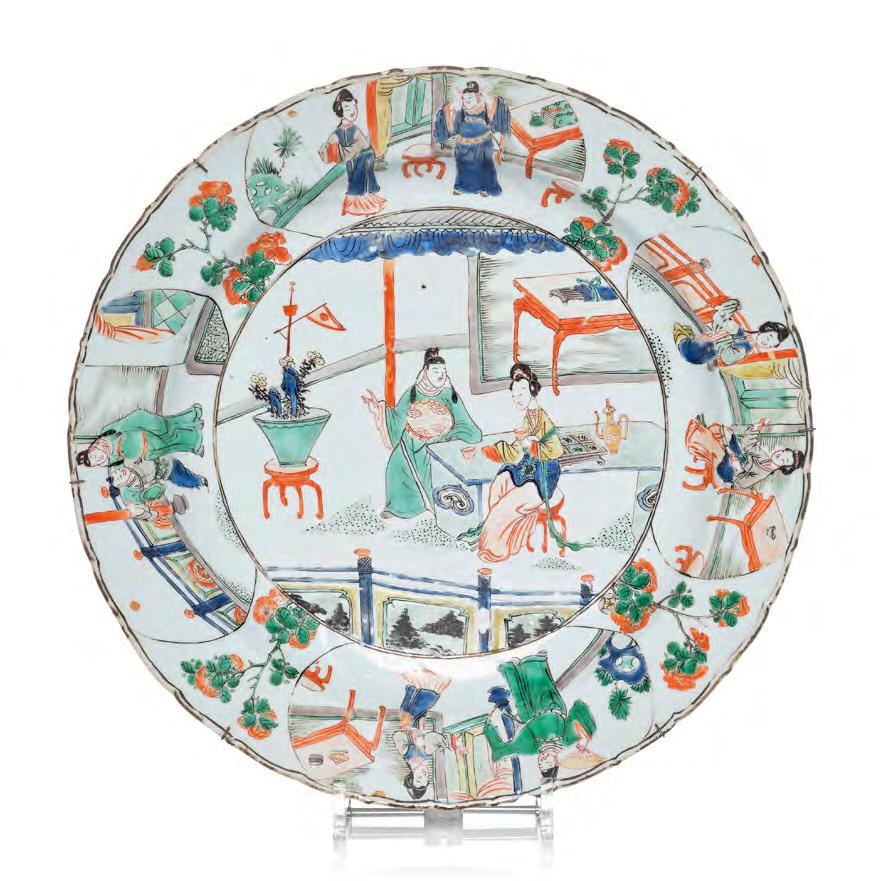

Provenance: From the Collection of the sister of Ivan Traugott. (1871–1952). Thence by descent within the family. Traugott was a Swedish businessman and important art collector. A large part of his collections can be seen today at Nationalmuseum and East Asian Museum in Stockholm.
Estimate: SEK 15 000 – 20 000 / EUR 1 320 – 1 760
1247. A famille verte dish, Qing dynasty, Kangxi (1662–1722). Decorated with a garden scene with a bird in a peony tree. Diameter 21 cm.

Estimate: SEK 4 000 – 6 000 / EUR 360 – 530
1249. A famille verte dish with a carp, Qing dynasty, Kangxi (1662–1722).
Decorated in famille verte with a carp amidst firece waves, around the rim further six fishes. The base with an artimisia leaf within double circle. Diameter 35 cm.
Provenance: From the Collection of Ivan Traugott. (1871–1952). Thence by descent within the family. Traugott was a Swedish businessman and important art collector. A large part of his collections can be seen today at Nationalmuseum and East Asian Museum in Stockholm.
Exhibitions: Compare a dish of this design in the Musee Guimet, Paris, inventory no. G 3555 (+). Collection Ernest Grandidier.
Estimate: SEK 15 000 – 20 000 / EUR 1 320 – 1 760
1251. A hexagonal famille rose tea pot stand, Qing dynasty, Yongzheng (1723–35).

Hexagonal shape decorated with gold fish in a lotus pond.
Diameter 12.5 cm.
Provenance: From a private Swedish Collection.
Estimate: SEK 4 000 – 6 000 / EUR 360 – 530
1250. A pair of porcelain cups, Qing dynasty, first half of the 17th Century.

Decorated in red, green, yellow and blue enamels with gilded details with inspiration from kakiemon decoration. Height 7.5 cm.
Estimate: SEK 4 000 – 6 000 / EUR 360 – 530
1252. A pair of famille verte cups with stands, Qing dynasty, Moulded shape, decorated in famille verte colours with flowers and buddhist emblems. Diameter of cup 8 cm. Diameter of stand 13 cm.

1254. A doucai '100 antiques' dish, Qing dynasty, 18th Century with a Ming mark.
Decorated with antiques and precious objects. The reverse of the rim further decorated with cherry blossom, peonies, chrysanthemum and lotus. Diameter 15 cm.
1253. A Chinese Export chamber pot, Qing dynasty, Yongzheng, ca 1725.
Decorated in famille rose with flowers and with the French Coat of Arms for Count Nöel Danycan de L´Espine (1658–1734/35). Lenght 23 cm.
Provenance: Greve Nöel Danycan de L´Espine (1658–1734/35). He had a military, fighting the British along the coast of Newfoundland, then made a name for himself as an explorer. Searching for sea routes in South America, where he discovered Iles Malouines, now the Falkland Islands. He founded the Compagnie des Mers du Sud. In the early 18th century, he was one of the most prominent French ship owners. He was ennobled in 1695 and appointed 'Chevalier de l'Ordre de Saint Michel' in 1706.
Exhibitions: See items from the same service, Christies, Paris, 11 June 2008, auction no 5521, lot 154. Art d'Asie
Literature: Antonie Lebel, Armoiries francaises et suisses sur la porcelaine de Chine au XVIIIe siecle.
Estimate: SEK 6 000 – 8 000 / EUR 530 – 710
1255. A famille rose bowl, Qing dynasty, Yongzheng (1723–35). Lobed, decorated in famille rose colours with a contionus peony decoration that runs over the edge and continues to the interior. Diameter 23.5.
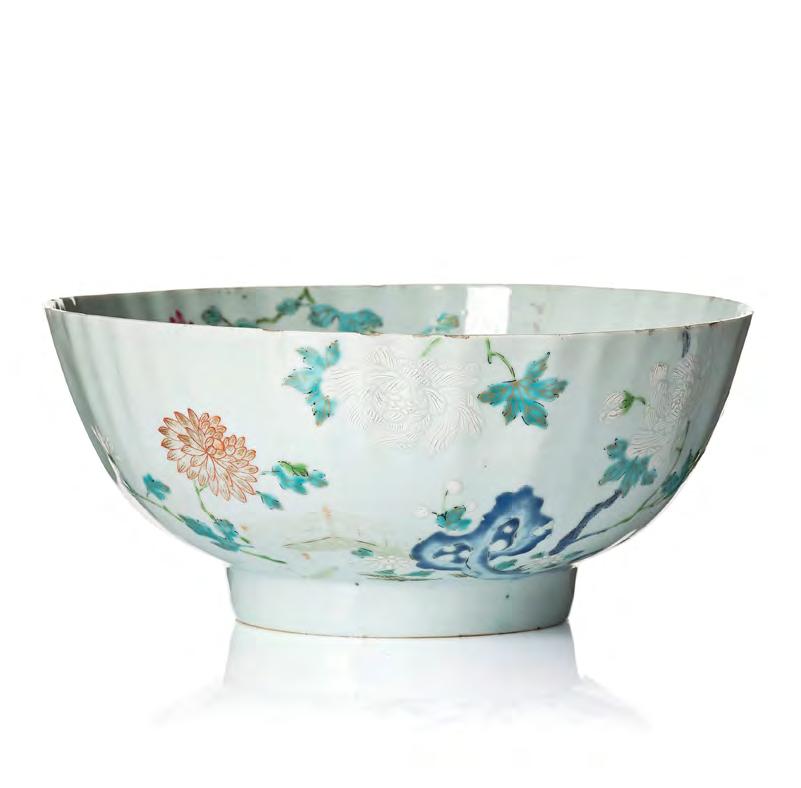

Estimate: SEK 4 000 – 6 000 / EUR 360 – 530

1257. A pair of famille rose flower pots, Qing dynasty, Qianlong (1736–95).
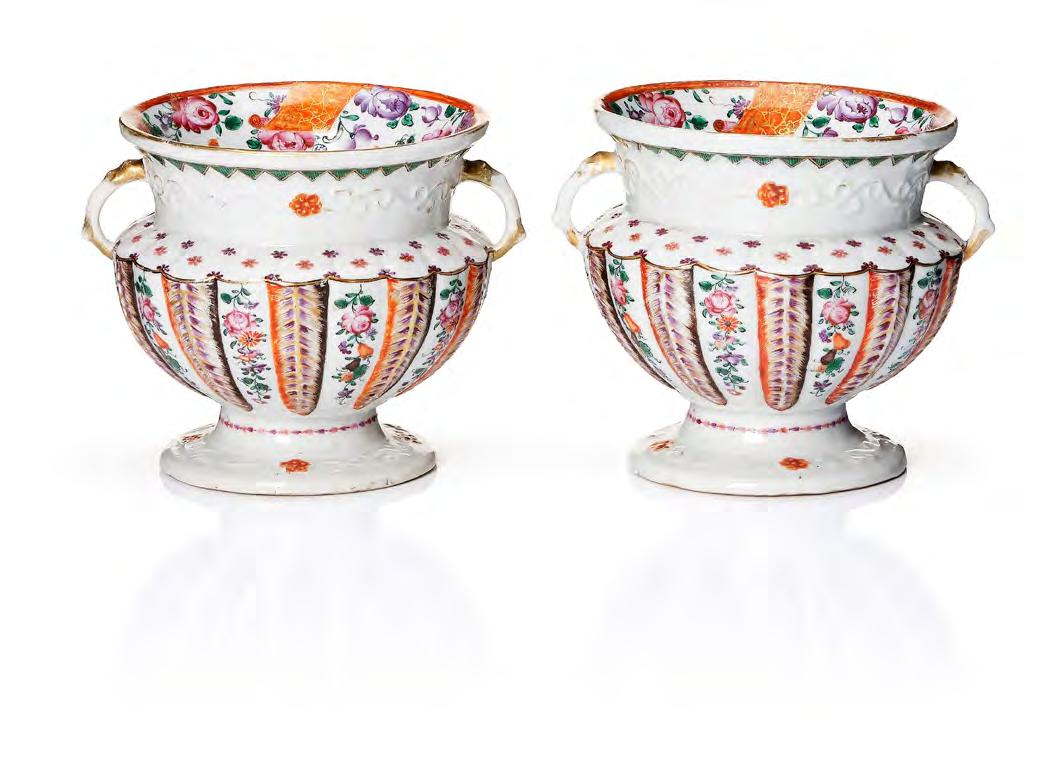
Urnshaped with handles, decorated in a european fashion.
Height 11.5 cm. Diameter 12 cm.
Estimate: SEK 8 000 – 10 000 / EUR 710 – 880
1256. A famille rose Chinese Export 'Tobacco leaf' dish, Qing dynasty, Qianlong (1736–95).
Decorated in famille rose in the tobacco leaf pattern. Length 32 cm.

Estimate: SEK 8 000 – 10 000 / EUR 710 – 880
1258. A set of 15 famille rose dinner plates, Qing dynasty, Qianlong (1736–95).

Decorated with a flower garland. Diameter 23 cm.
SEK 8 000 – 10 000 / EUR 710 – 880
1259. A set of 12 famille rose Chinese Export dinner plates and a serving dish, Qing dynasty, Qianlong (1736–95). Decorated with a central scene with a garden in full bloom, the rim with a fleur de lys trip and a broad blue enamel band. Diameter 23 cm, and 25 cm.
SEK 8 000 – 10 000 / EUR 710 – 880
1260. A set of five famille rose dishes, Qing dynasty, Qianlong (1736–95).
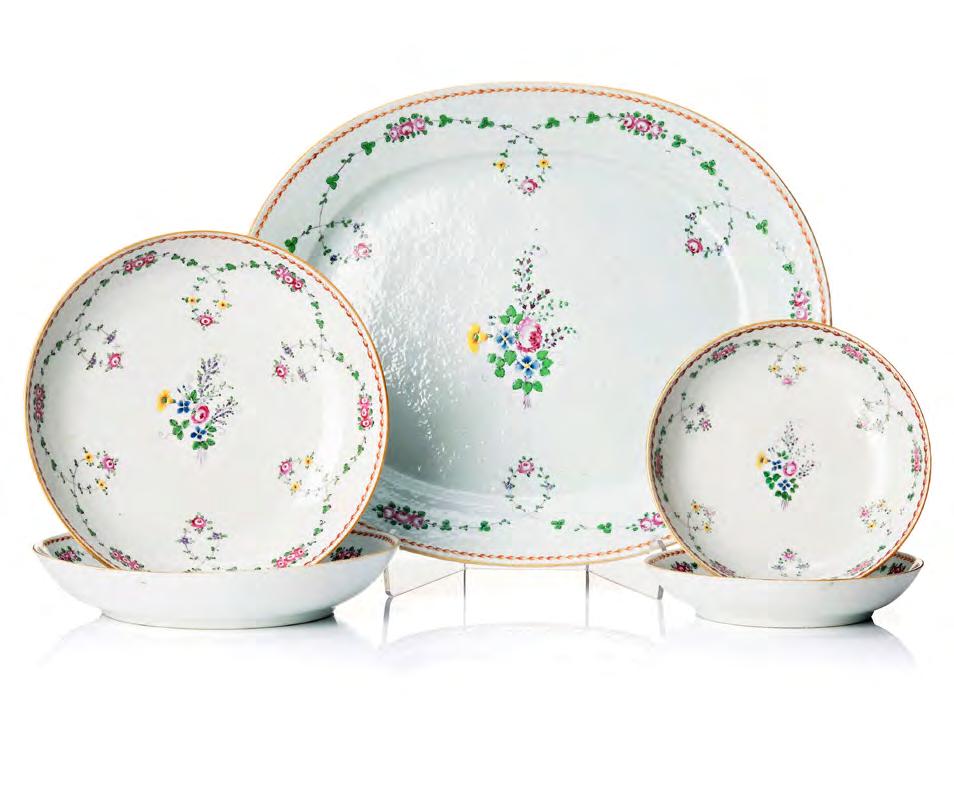

Decorated in famille rose with flower garlands. Comprising, two deep dishes, diameter 18 cm, two deep dishes, diameter 24 cm. A serving dish, lenght 40.5 cm.
Estimate: SEK 8 000 – 10 000 / EUR 710 – 880
1261. A famille rose jug, Qing dynasty, Qianlong (1736–95).
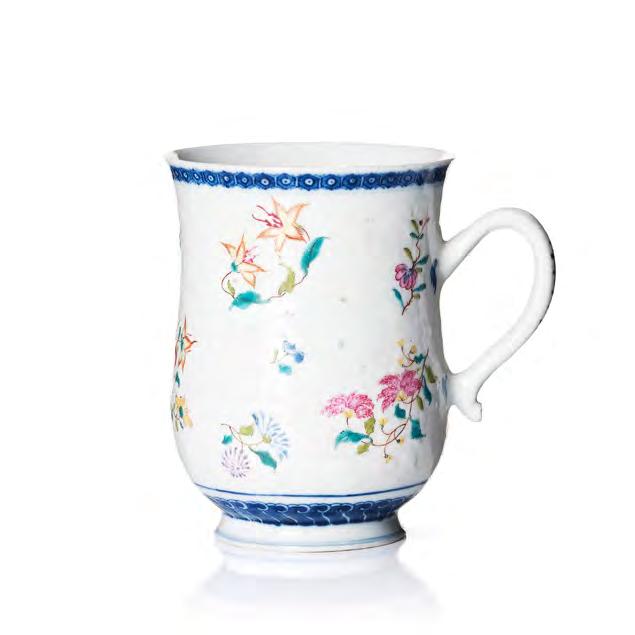
Decorated both in relief and with flowers in famille rose colors. Height 15 cm.
Estimate: SEK 4 000 – 6 000 / EUR 360 – 530
1262. A pair of clay figure of buddhist lions, Qing dynasty, signed.

A pair of reclining figure of mythical creatures. Length 17 cm. Height 11.5 cm.
Provenance: Property of a Swedish private collection.
Estimate: SEK 8 000 – 10 000 / EUR 710 – 880
1264. A large famille rose 'Rockefeller-pattern' vase with cover, Qing dynasty, Qianlong (1736–95).
Flattened baluster shape, finial in the shape of a buddist lion, handles in the shape of stylized dragons. Painted with scenes from court life in vibrant colours. Height 46.5 cm.
Estimate: SEK 10 000 – 15 000 / EUR 880 – 1 320
1263. A large famille rose 'Rockefeller pattern' basin, Qing dynasty, Qianlong (1736–95).
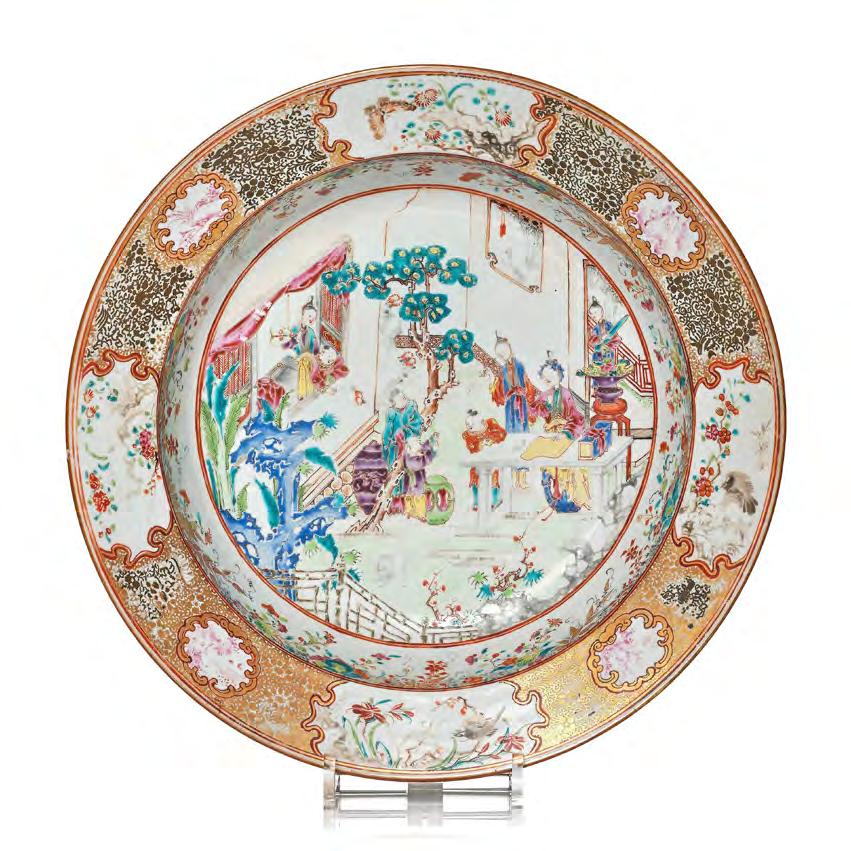
Decorated in vivid colours with a scene from court life with elegant ladies and children in a garden setting. Diameter 38.5 cm.

Estimate: SEK 12 000 – 15 000 / EUR 1 060 – 1 320
1265. A large famille rose tankard, Qing dynasty, Qianlong (1736–95).

Decorated in famille rose with a scene from court life. Height 14 cm.
Estimate: SEK 4 000 – 6 000 / EUR 360 – 530
1266. A pair of famille rose roosters, Qing dynasty (1644–1912). Roosters on a rock formation, decorated in famille rose. Height 25.5 cm.

Provenance: Property of a private Swedish Collection.
Estimate: SEK 10 000 – 15 000 / EUR 880 – 1 320
1267. A Chinese Export dinner service, late 18th Century. (72 pieces). Decorated in blue enamel and gold. Comprising; 43 dinner plates (diameter 24,5 cm), 12 soup dishes (diameter 24,5 cm), a tureen with cover (length 35 cm), a vegetable tureen with cover (length 31 cm), a set of four serving dishes (lenght 34–46.5 cm), 8 custard cups with cover, a sauce boat with stand, 2 round dishes (diameter 24 cm).
Estimate: SEK 70 000 – 100 000 / EUR 6 160 – 8 800

1268. A Chinese Export dinner service, Qing dynasty, Jiaqing (1796–1820). (27 pieces). Decorated in blue enamels and gold with carnations and bands. Comprising; a vegetable tureen with cover, lenght 36 cm, a set of eight dinner plates, diameter 23 cm, a set of nine soup dishes, diameter 22.5 cm, a set of six bowls, diameter 11 cm, a coffee pot with cover, height 22 cm, a milk jug, height 13 cm, a suger bowl with cover, height 14.5 cm.
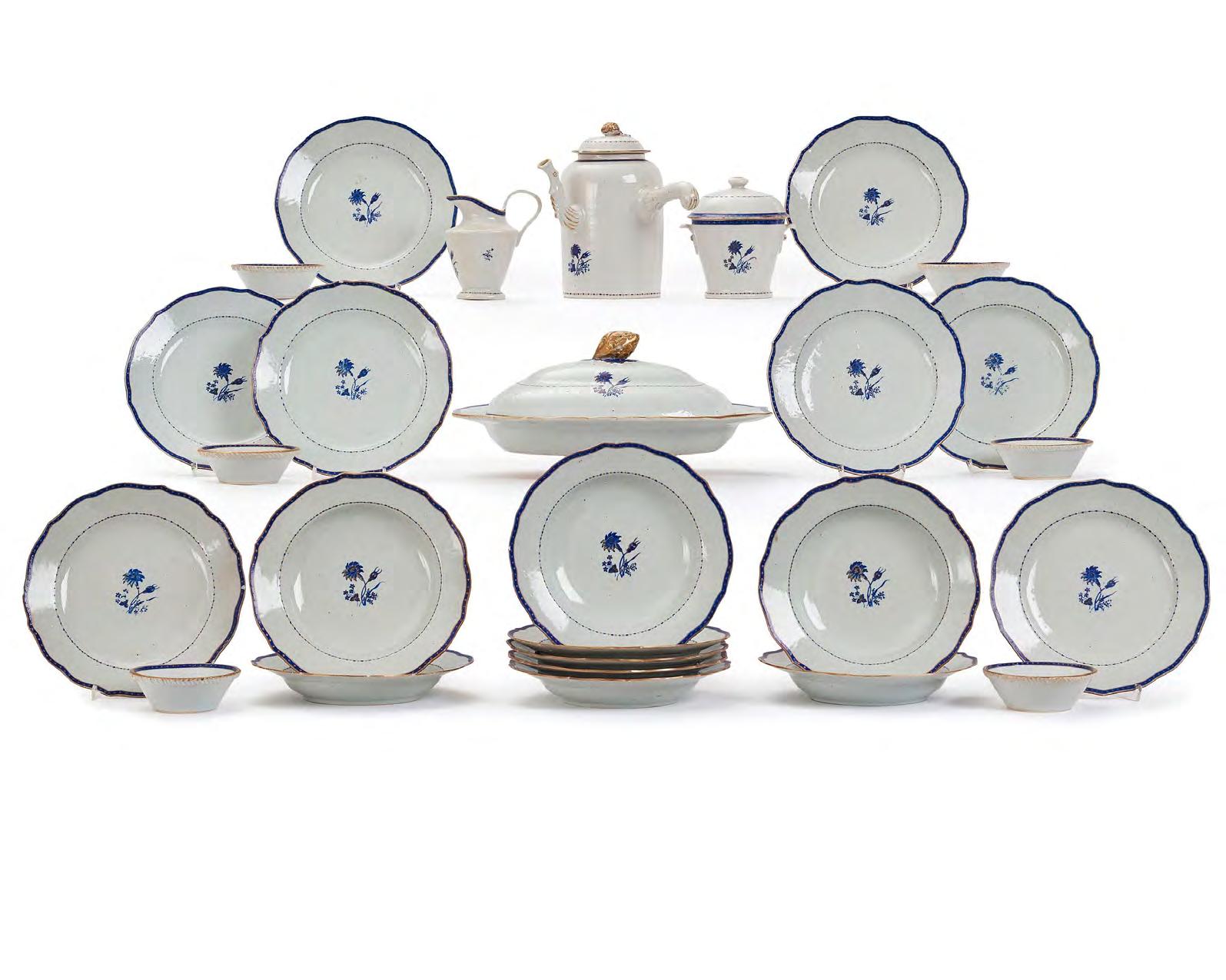
Estimate: SEK 18 000 – 20 000 / EUR 1 590 – 1 760
1269. A pair of mirror black vases, Qing dynasty, 19th Century. Rounded shoulder, brown glazed rim, mirror black glaze with gilded decoration with flowers. Height 24.5 cm.
Estimate: SEK 15 000 – 20 000 / EUR 1 320 – 1 760

1271. A pair of famille rose wall figurines, Qing dynasty, 19th Century.
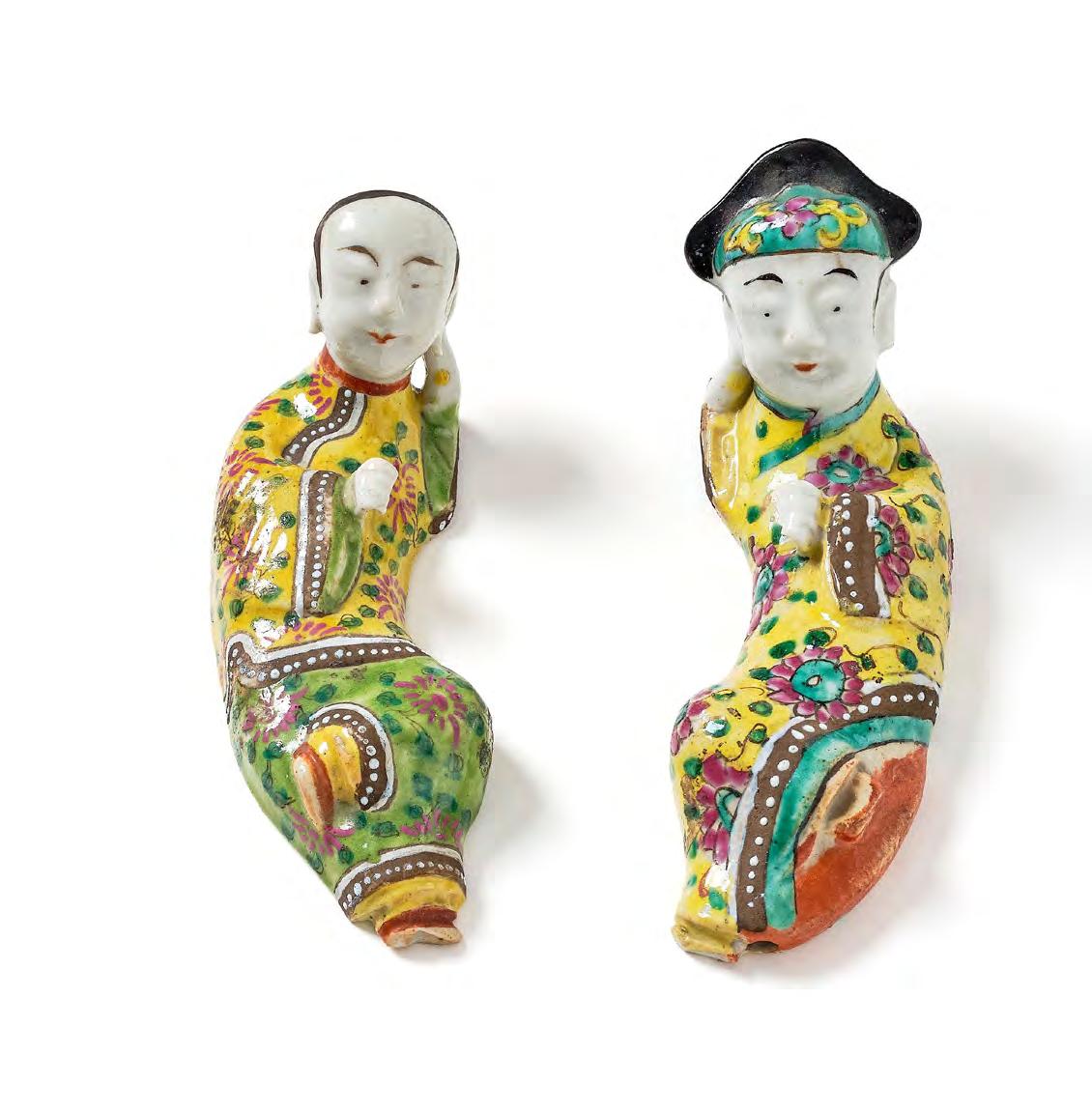
Sculptured as a pair of reclining figures, with holes to the back for flowers, decorated in famille rose. Length 15.5–16.5 cm.
Provenance: Purchased at Bonhams, London, November 2002.
Estimate: SEK 8 000 – 10 000 / EUR 710 – 880
1270. A famille rose 'Chinese Export' Canton dinner service, Qing dynasty, 19th Century. (109 pieces).

Painted decoration of flowers, butterflies and fruits. Comprising; 51 dinner plates (diameter 25 cm. 18 soup dishes (diameter 25 cm). 27 small dishes (diameter 20 cm). Two large tazzas (length 36 cm). A large serving dish with strainer (length 44 cm), Five oval serving dishes (length 26–36 cm. A round serving dish (diameter 28 cm), A jar with cover, height 20 cm. Two pillow shaped tureens with covers, (measurement 24 x 22 cm), two oval vegetable turrens with covers, (length 32 cm).
Provenance: From a private Swedish family Collection.
Estimate: SEK 60 000 – 80 000 / EUR 5 280 – 7 040
1273. A famille rose 'nine dragon' dish, Qing dynasty, 19th Century.
Decorated in bright colours with nine fierce four clawed dragons chasing the flaming pearl amdist cloud formations. Lenght 35.5 cm.

Catalogue note: A legend explains the reasons why there are 9 dragons as opposed to 8 or 10 in Chinese mythology. According to Zhou Yi (one of the oldest of the Chinese classic texts), nine symbolizes yang. Ancient Chinese categorized numbers into yang numbers and yin numbers. Odd numbers signify yang, while even numbers represent yin, and nine is the largest yang number and a symbol of the emperor.
Estimate: SEK 8 000 – 10 000 / EUR 710 – 880
1272. A large famille rose flower pot, Qing dynasty, 19th Century. Hexagonal shape, decorated in famille rose with a continous figure scene. Diameter 35.5 cm. Height 22.5 cm.
Provenance: From the Collection of Åke Reuterswärd (1884–1973), thence by descent. Åke Reuterswärd was a passionate collector who aquired most of his collection through his brother Thorsten Reuterswärds gallery, the well reknowned 'Japanska Magasinet' in Stockholm.
Estimate: SEK 10 000 – 15 000 / EUR 880 – 1 320
1274. A circular sweet meat box, Qing dynasty with Guangxu mark and of the period (1874–1908).
Round, the interior devided into two compartments. Decorated in famille rose and enamels, the cover with a central shou character surrounded by a lotus pond with cranes. The sides are decorated with a continous swastica pattern in yellow and blue. Diameter 16 cm.
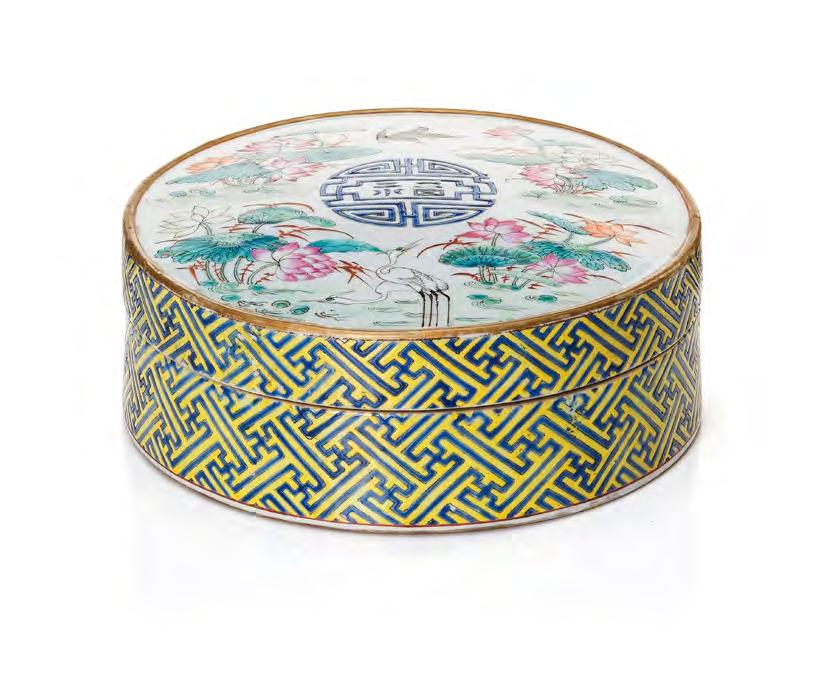
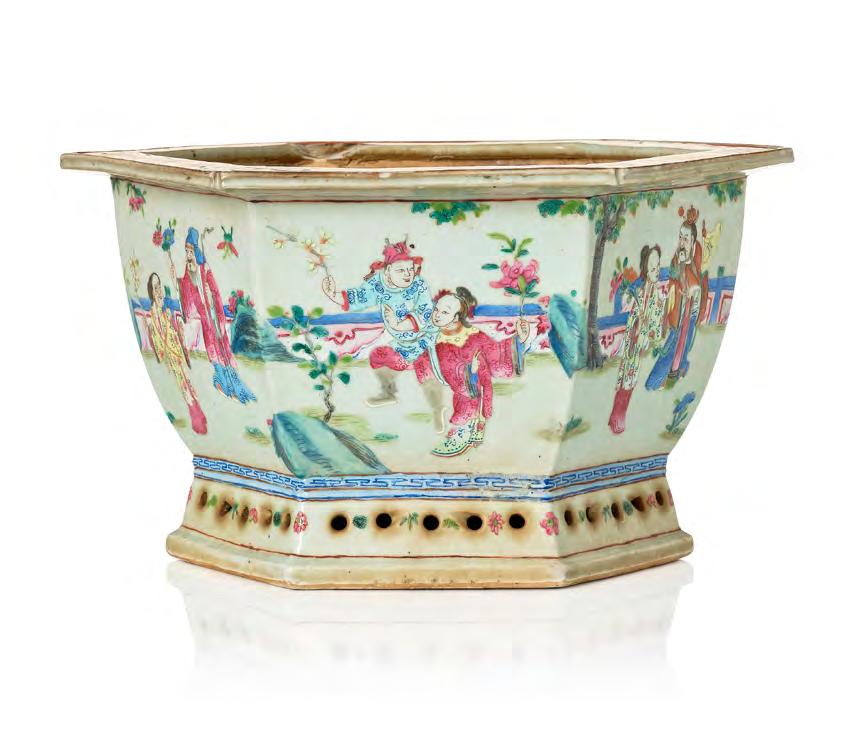
Provenance: Property of a private Swedish Collection.
Estimate: SEK 5 000 – 7 000 / EUR 440 – 620
1275. A large famille rose flower pot, late Qing dynasty, 19th Century.

Decorated in famille rose with a continous lotus scroll and shou characters. Diameter 40.5 cm, height 22 cm.
Provenance: Property of a Swedish private collection.
Estimate: SEK 5 000 – 7 000 / EUR 440 – 620
1276. A pair of famille rose lanterns with stands, late Qing dynasty.

Rounded shape on a tall stand, decorated in bright famille rose colours wtih flowers and figure scens. Height with stand 31 cm.
Provenance: From the collection of Brith & Berthil Christenson, Djursholm. Thence by descent. The painting (lot no 1040) and the lanterns (lot no 1276) was purchased in the 1950’s when Brith Christenson was on tour with the Opera Ballet in China. The altartable from the same collection (lot no 1047) was purchased from another family in Djursholm in the 1960’s.
Estimate: SEK 16 000 – 20 000 / EUR 1 410 – 1 760
1277. A wucai decorated vase, Qing dynasty, 19th Century. Four character mark to base in underglaze blue. Finely decorated with an elegant scene from court life, a gentleman playing the insturment qin, and elegant ladies of the court strolling in a palace garden. Height 34 cm.

Provenance: Property of a Swedish private collection.
Estimate: SEK 5 000 – 7 000 / EUR 440 – 620
1278. A ’five clawed’ dragon vase, Qing dynasty, 19th Century with a six character Kangxi mark.
1288. A doucai ’dragon and phoenix’ vase, late Qing dynasty with Qianlong mark.
1278. A 'five clawed' dragon vase, Qing dynasty, 19th Century with a six character Kangxi mark.
Of baluster shape with a tall slightly flared neck, decorated in relief with two fierce five clawed dragons casing the flaming pearl amidst cloud formations. Decorated in green, yellow, aubergine and white glaze against a dark vivid blue ground. Height 36 cm. Height with wooden stand 42 cm.

From a private Scandinavian Collector.
Catalogue note: An unusual technigue appears to have been inspired by fahua or cloisonne enamel decration.
SEK 15 000 – 20 000 / EUR 1 320 – 1 760
1279. A large palace vase, Qing dynasty, 19th Century.

Baluster shape with shortened neck, Decorated with two large panels with scenes from palace life. On each side two roundels decorated with flowers, insects and birds. All this against a blue ground covered with lotus and other flowers. By the shoulder a lambrequin pattern with flowers against a yellow ground. this below a border with bats and peaches. Height 104 cm.
Provenance: Property of a Swedish private collection.
Estimate: SEK 16 000 – 20 000 / EUR 1 410 – 1 760
1280. A famille rose table screen in a wooden stand, Qing dynasty, 19th Century.

Rectangular placque with an elegantly painted riverscape in famille rose colours. Measurment porcelain placque 16 x 20.5 cm. Measurment with wooden stand, width 24.5 cm, height 32.5 cm, depth 12 cm.
Provenance: Property of a Swedish private collection.
Estimate: SEK 8 000 – 10 000 / EUR 710 – 880
1281. A powder blue flower pot, late Qing dynasty, circa 1900. Decorated in famille verte colours with two central panels depicting scenes with elegant people in a garden setting all against a blue ground. Height 21.5 cm. Diameter 26 cm.

Estimate: SEK 8 000 – 10 000 / EUR 710 – 880
1282. A set of six framed tiles, Qing dynasty, 19th Century. With calligraphy and seal marks. Decorated in vibrant famille rose colours with some of the daoist immortals. Measurement porcelain 13 x 13 cm. Measurement with frame 17.5 x 18.5 cm.

SEK 8 000 – 10 000 / EUR 710 – 880
1283. A famille rose sgraffiato 'flower brocade' dish, Qing dynasty.
The exterior richly decorated with polychrome 'flower brocade'-pattern against a light blue ground with sgraftitto decor. The interior with turquoise enamel glaze. Jing yu zhai zhi' (Studio for Cultivating the Land) four character mark to base. Diameter 16 cm.

Provenance: From the Collection of Gustaf Wallenberg (1863–1939). The collection was acquired between 1906 and 1918 when Wallenberg was the Swedish Envoyé in Tokyo. From 1907 he was also accredited for Beijing. Thence by descent. Bukowskis sold a part of this collection at Bukowskis Sale 554 in 2009 and Bukowskis Sale 556, 2010.
Estimate: SEK 25 000 – 30 000 / EUR 2 200 – 2 640
Lot. no 1274. A circular sweet meat box, Qing dynasty with Guangxu mark and of the period (1874–1908).
Lot. no 1285. A large ‘Eight Buddhist Emblems’ dish, Qing dynas ty, mark and period of Guangxu (1875–1908).
 Lot. no 1286. A pair of Chinese stemcups, with the mark o f dowager empress Ci Xi, Dayazhai, late Qing dynasty.
Lot. no 1286. A pair of Chinese stemcups, with the mark o f dowager empress Ci Xi, Dayazhai, late Qing dynasty.
1284. A famille-rose 'baragon tumed' tea bowl, Qing dynasty, Daoguang.
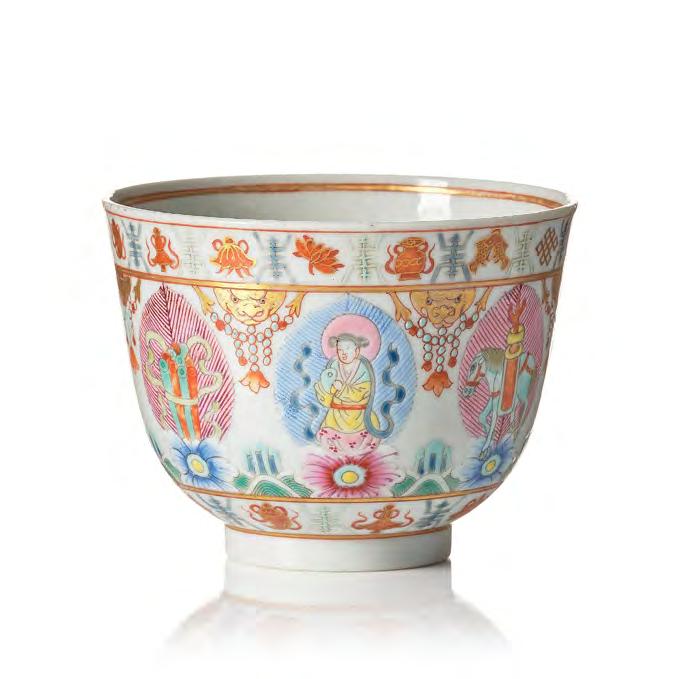
Deep ‘U’-shape, supported on a short foot, decorated around the exterior with a parade of auspicious animals and deities of the qi zheng bao (‘Seven Treasures’), each set on a lotus flower within a mandorla above the sea, below alternating gold animal masks suspending tassels and between bands of the bajixiang (‘Eight Buddhist Emblems’) in ironred divided by shou characters at the foot and rim, the interior with a lotus medallion centred with a vajra motif, the white base inscribed with an iron-red ‘Baragon Tumed’ mark in Mongolian script. Height 6,6 cm. Diameter 9 cm.
Provenance: Property from a Swedish Private Collection. The ‘Baragon Tumed’ mark on the base identifies the bowl as part of a service made at the imperial factories to celebrate the marriage of one of the Daoguang emperor’s daughters to a Mongolian prince of the Tumed Banner in 1842.
Exhibitions: Compare a dish from this service at the British Museum, inventory no Franks.1689. Donated by: Sir Augustus Wollaston Frank
Literature: Compare; Sothebys, Echoes of Fragrance – Evolution of Tea Culture from the Tang to the Qing Dynasties 16 December 2021. Lot 5059.
Estimate: SEK 4 000 – 6 000 / EUR 360 – 530
1285. A large 'Eight Buddhist Emblems' dish, Qing dynasty, mark and period of Guangxu (1875–1908).
The dish is decorated to the interior with a central roundel enclosing a network of flowers and foliage in pale green enamel, encircled by the Eight Buddhist Emblems, bajixiang. The exterior is decorated with three floral blooms growing on scrolling leafy foliage. Diameter 34 cm.

Provenance: From the Collection of Hans Olbers (1932-2020), Djursholm, Sweden. Thence by descent. The Olbers family were active members of the Swedish East India Company during the 18th and 19th Century. The most renowned member of the family is presumably Levinius Olbers (1725-1804), who participated in a total of 12 trips to China, several as commander/captain. The trips were adventurous, and he survived no less than three shipwrecks. Growing up in a family with so much history with the East India Company, it became natural for Hans Olbers to have a great interest in Chinese Works of Art. Throughout his professional life as a businessman he had most of Asia as his field of work.
Exhibitions: Compare; Sothebys, CHINA / 5000 YEARS 1 December, 2022. New York. Lot no 619. Compare also; One at Denver Art Museum; Gift of May Wilfley in memory of her parents, A. R. Wilfley and Addie M. Wilfley. Inventory no 1974.53. Due to the marking of the dish it is thought to be comissioned by dowagar empress Cixi (TSUH-she) (1835-1908) for use in the Palace for Gathering Elegance, one of her palaces in the Forbidden City. Compare also, one inte Musee Guimet, Paris. Inventory no G 3374 (+). Collection Ernest Grandidier.
Literature: A similar dish of this large proportion is illustrated by Peter Lam in Imperial Porcelain of Late Qing from the Kwan Collection, Art Gallery, The Chinese University of Hong Kong, 1983, no. 125, p. 124.The imagery on Chinese decorative arts is often imbued with wishes of good fortune, long life, prosperity, and many children. The Eight Buddhist Emblems that are depicted on this dish were popular decorative elements during the Qing Dynasty, when this dish was made. The eight emblems are: the Wheel of Law, a conch shell, a victory banner, an umbrella, a lotus flower, a vase, a pair of fish, and an endless knot.
Estimate: SEK 50 000 – 75 000 / EUR 4 400 – 6 600
1286. A pair of Chinese stemcups, with the mark of dowager empress Ci Xi, Dayazhai, late Qing dynasty.

Decorated in enamelss with peonies and wisteria in bloom all against a turquoise ground. The foot decorated with wave formations. With the Dayazhiang mark of dowager empress Ci Xi. Height 9 cm, diameter 11 cm. On two wooden bases with carved decor, the bases height 5 cm.
Catalogue note: Dayazhai ceramic works have mainly three inscriptions, namely “Dayazhai”, “Tiandi Yijia Chun” and “Yongqing Changchun”. “Tiandi Yijia Chun” is where Empress Dowager Cixi lived in the Old Summer Palace when she was new in the palace, where “Dayazhai” was one of the rooms. Emperor Xianfeng Emperor also wrote down “Dayazhai” on a horizontal inscribed board as a gift to Cixi. These two inscriptions both meant something special for Cixi. Therefore, when Cixi’s residence in the Old Summer Palace was rebuilt in the 12th year under Tongzhong’s reign (1873), both the building and the wares in it were marked with these two inscriptions.
Estimate: SEK 50 000 – 75 000 / EUR 4 400 – 6 600
1287. A yellow glazed 'nine bats and peaches' bowl, late Qing dynasty with Guangxu mark.

Decorated in famille rose colours with nine bats, peaches and shou characters against a bright yellow ground. Diameter 17 cm.
Provenance: From the Collection of Swedish businessman who worked for the Elof Hansson trading house. He first came out to China in 1949, then by taking the train from Vladivostok. Before retirement 1984, he had travelled to China 50 times. During his travels he became more and more interested in Chinese Works of Art and bought some things for himself. Among these things the two lots included in this sale. He also was a member of Swedish Trade Council and were often consulted when it came questions regarding trading with China.
Estimate: SEK 8 000 – 10 000 / EUR 710 – 880
1288. A doucai 'dragon and phoenix' vase, late Qing dynasty with Qianlong mark.
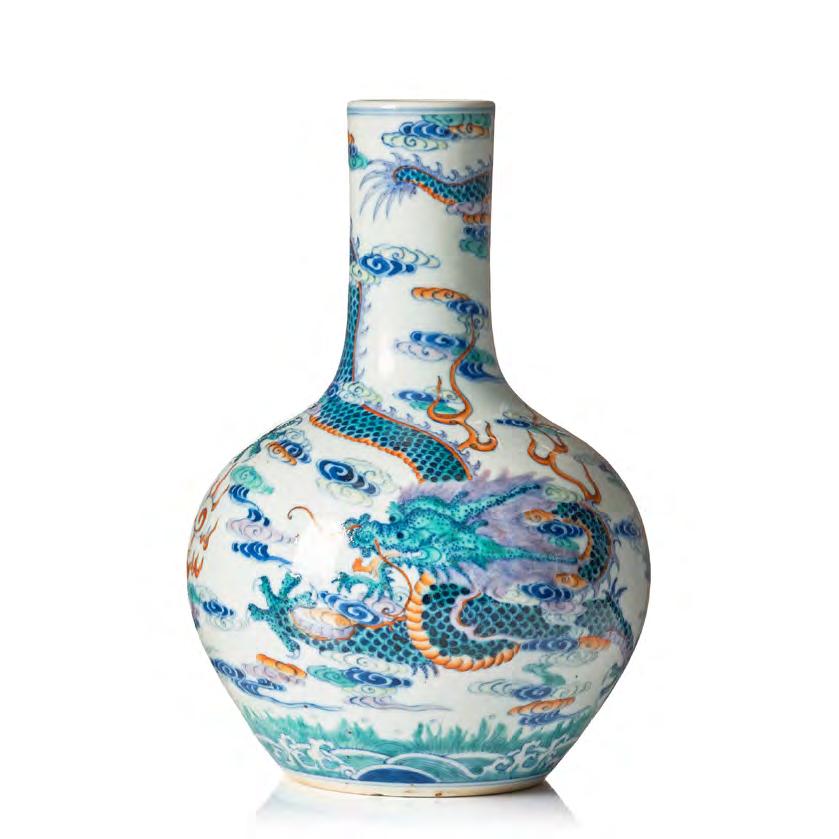
Seal mark to base. The rounded body and tall neck boldly painted in doucai colours with a five-clawed dragon and a phoenix bird in energetic pursuit of a single flaming pearl above firece waves amidst cloud scrolls. Height 22,5 cm.
Estimate: SEK 8 000 – 10 000 / EUR 710 – 880
1289. A dragon dish, Qing dynasty, Guangxu mark and of the period (1875–1908).
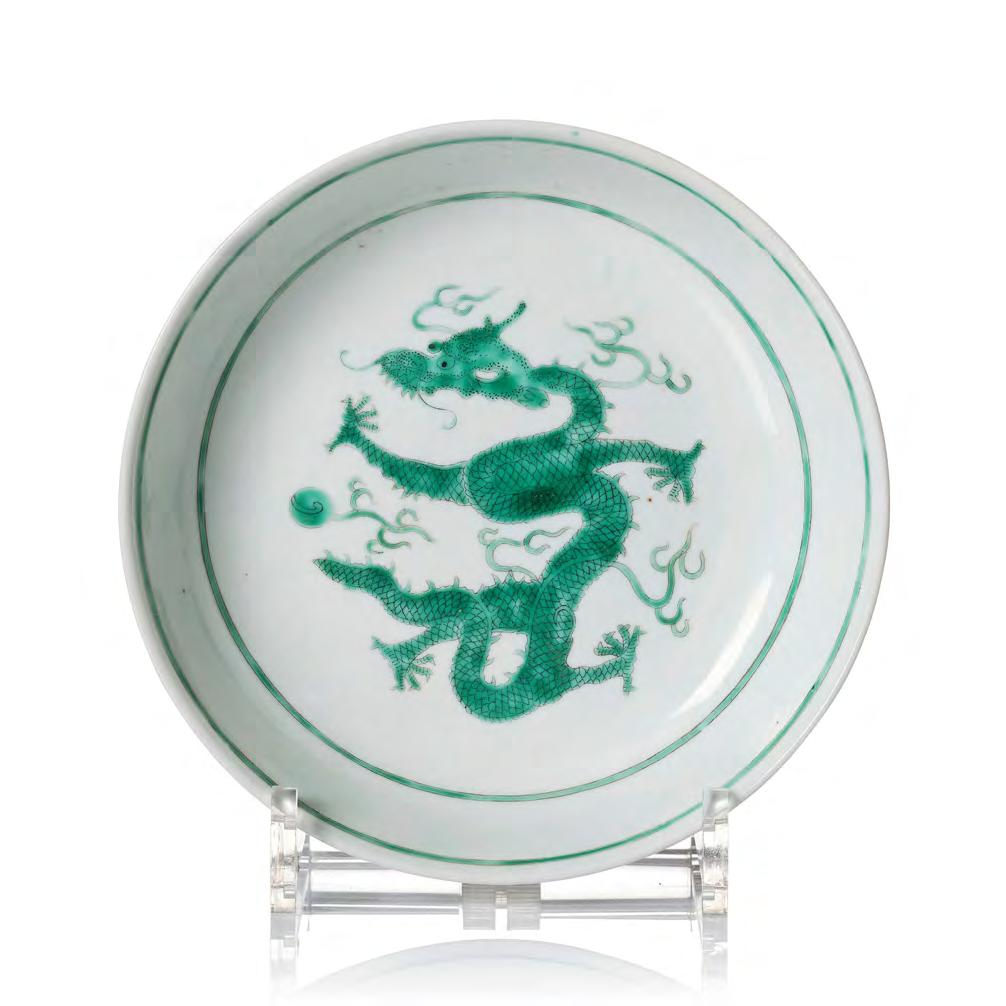
Mark in underglaze blue. Decorated in green enamel with a five clawed dragon chasing the flaming pearl amidst cloud formations. The outside with further two dragons in green enamel on top of an anhua decorated wave ground. Diameter 18.3 cm.
Provenance: From the Bengt Norrlinder Collection.
Estimate: SEK 12 000 – 15 000 / EUR 1 060 – 1 320
1291. A Chinese bowl, late Qing dynasty with Kangxi Mark. Rounded sides on a short foot. Decorated in both under glaze blue and enamels with characters between two bands of floral scroll. Diameter 16.5 cm.

Provenance: From the Collection of Swedish businessman who worked for the Elof Hansson trading house. He first came out to China in 1949, then by taking the train from Vladivostok. Before retirement 1984, he had travelled to China 50 times. During his travels he became more and more interested in Chinese Works of Art and bought some things for himself. Among these things the two lots included in this sale. He also was a member of Swedish Trade Council and were often consulted when it came questions regarding trading with China.
Exhibitions: Compare a bowl like this at the British Museum, Inventory no: Franks.616.+. Donated by: Sir Augustus Wollaston Franks.
Estimate: SEK 4 000 – 6 000 / EUR 360 – 530
1290. A pair of Chinese blue and white 'bats' bowl, Republic

Underglaze blue mark to base. Decorated in blue and white with wirling cloud formations and bats in vivid orange. Diameter 12.5 cm.
Provenance: Property of a Swedish private collection.
Estimate: SEK 6 000 – 8 000 / EUR 530 – 710
1292. A fish and peaches bowl, late Qing dynsty. Decorated in bright colours with peach trees that grows from a rock formation surrounded by firece waves and fishes. Diameter 17.5 cm.
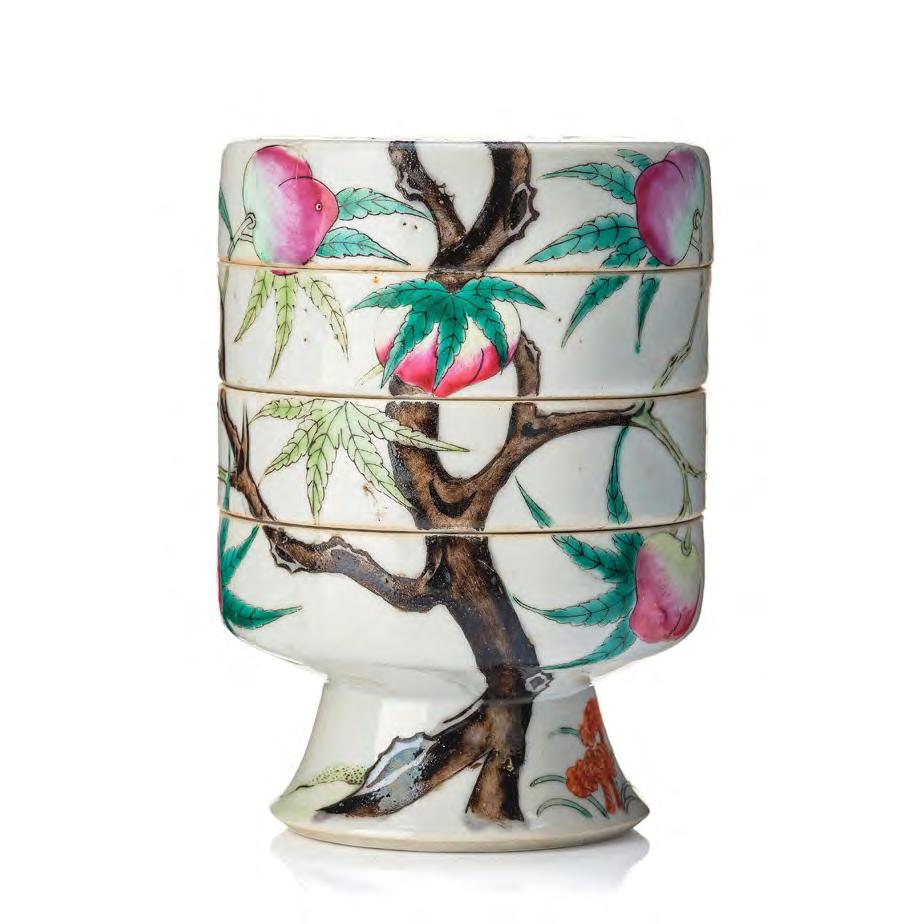

Provenance: Property of a Swedish private collection.
Estimate: SEK 5 000 – 7 000 / EUR 440 – 620
1294. A peach three tiered sweet meat box, late Qing dynasty. With four character to the base. Decorated in famille rose with peaches. Height 14 cm. Diameter 10 cm.
Provenance: Property of a Swedish private collection.
Estimate: SEK 4 000 – 6 000 / EUR 360 – 530
1293. A yellow glazed phoenix vase, Qing dynasty, with a Kangxi mark.
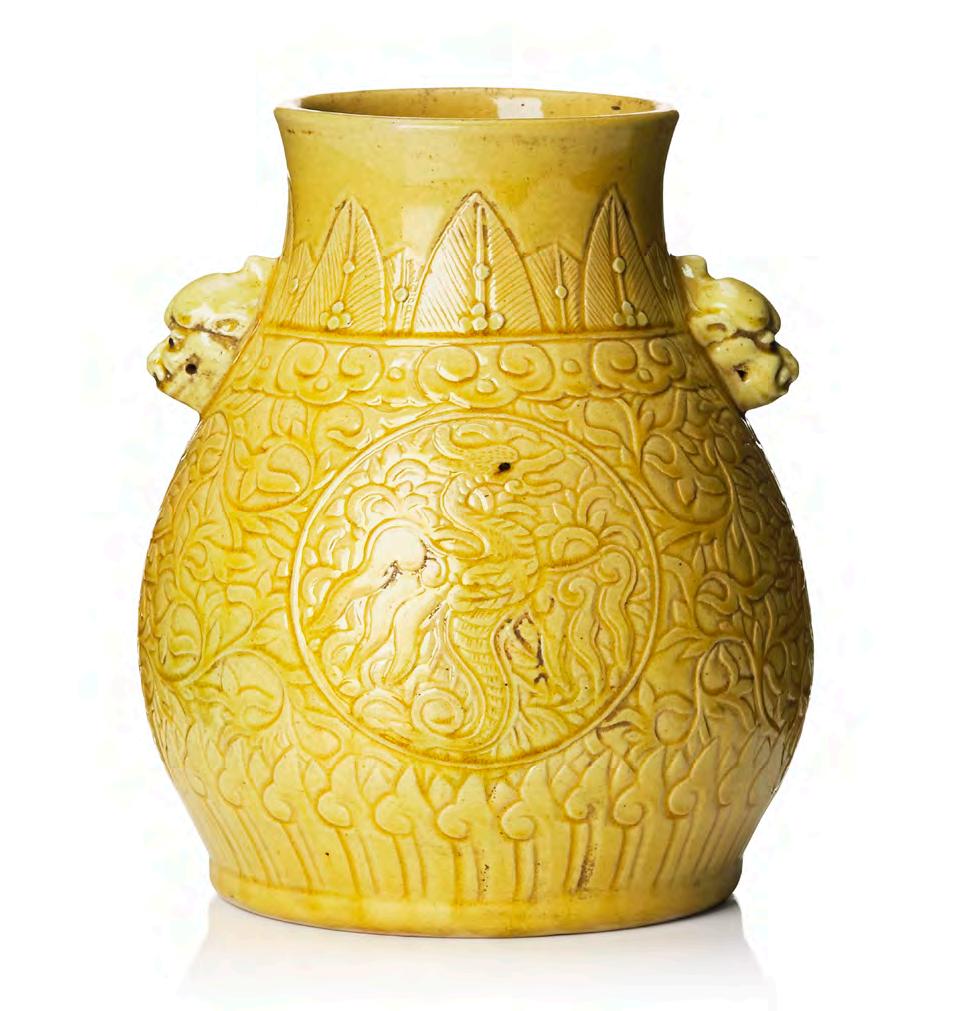
Six character Kangxi mark to base. Slightly pear shaped with a wide mouth and mascaron handles, decorated in relief with a continous lotus scroll with phoenix birds. Height 22.5 cm.
Estimate: SEK 6 000 – 8 000 / EUR 530 – 710
1295. A pair of blanc de chine libation cups, Qing dynasty, 19th Century.
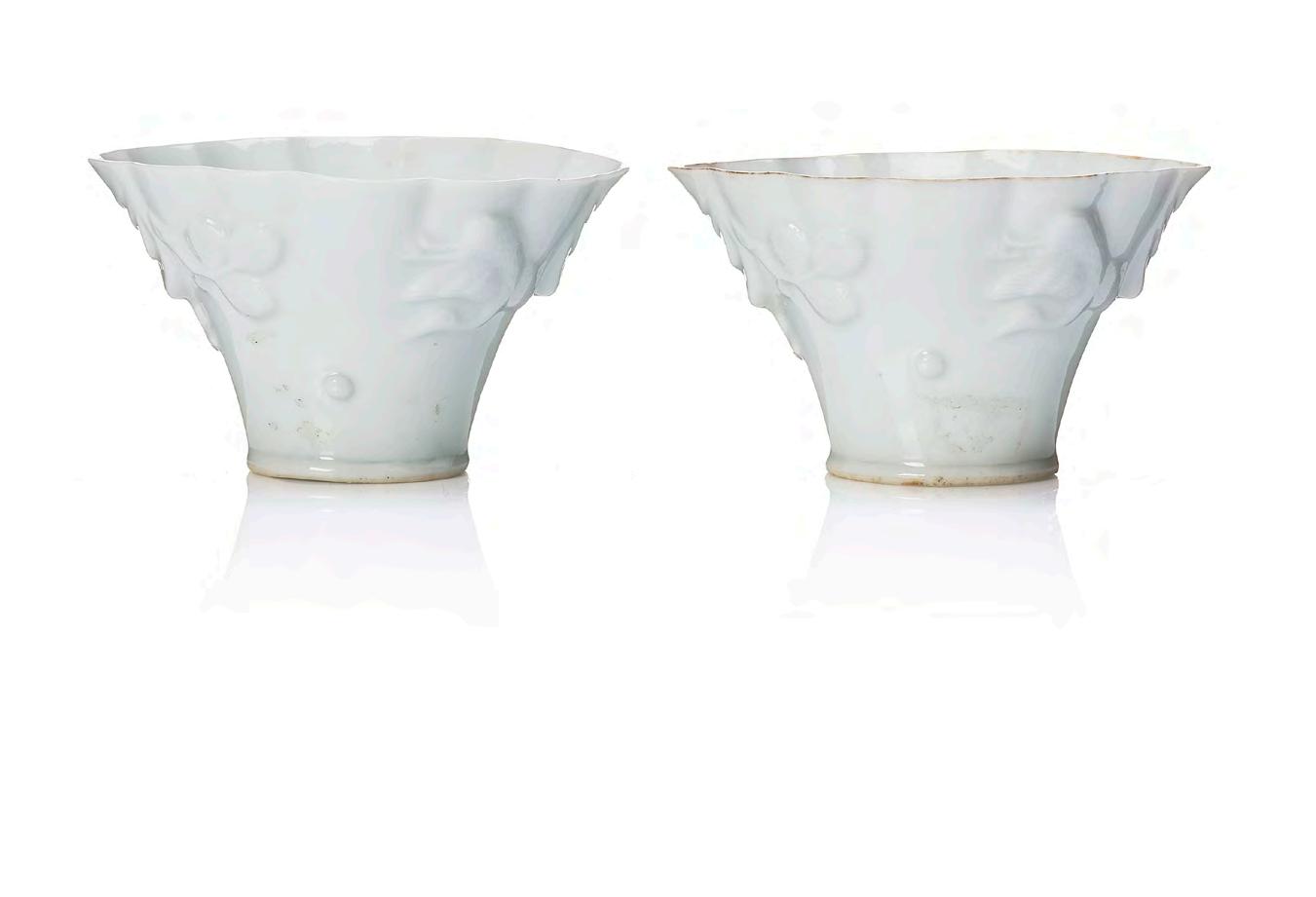
In the shape of rhinoserous horns, decorated in relief. Length 7 cm. Height 4 cm.
Estimate: SEK 4 000 – 6 000 / EUR 360 – 530
1296. A large famille rose vase, late Qing dynasty/early 20th Century.
Baluster shape with handles, decorated in famille rose colours with two scentral scenes, one with a monkey riding a horse, the other with a crane and a deer by a pinetree. Further smaller panels with figure scenes and antiques. Height 62 cm.
Estimate: SEK 6 000 – 8 000 / EUR 530 – 710
1297. A famille rose vase, late Qing dynasty, 19th Century. Baluster shape with handles, decorated in vivid colours with a figure scene from court life, the other side with cherry blossom. Height 61 cm.

Estimate: SEK 5 000 – 7 000 / EUR 440 – 620

1298. A large wucai jar with cover, decorated in Transition style, Samson, 19th Century.
Factory mark in red to base. Balsutershape, decorated with boys amidst peonies. Height 43 cm.
From the collection of the Danish family Rosencrantz, according to the family tradition it has come from the Det Gamle Slott, Fyn, Danmark.
SEK 6 000 – 8 000 / EUR 530 – 710
1299. A Chinese jar depiction '100' boys celebrating a dragon festival, Qing dynasty,. Baluster shape, decorated in vivid colours with boys celebrating the festival by engaging in various activities such as flying kites, playing instruments, dancing, marching, sailing in a palace setting. Height 37 cm.

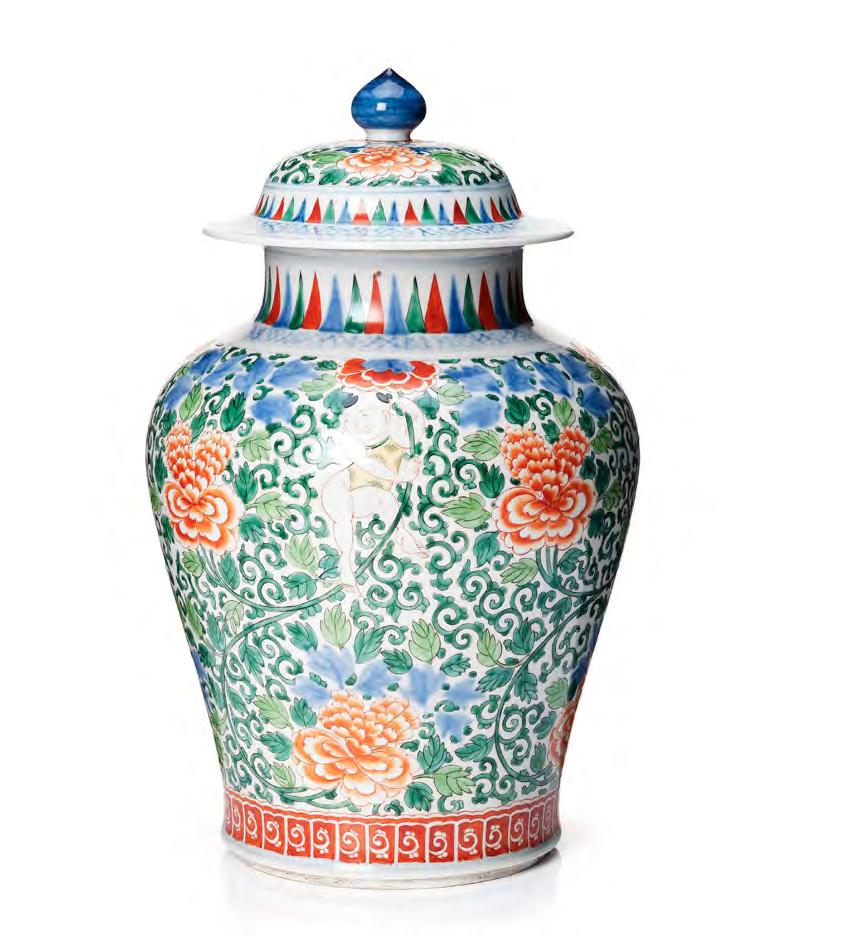
Estimate: SEK 10 000 – 12 000 / EUR 880 – 1 060
1300. A famille rose dish decorated with a dragon festival moment, Qing dynasty, 19th Century.
Richly decorated in bright famille rose colours, depicting a dragon festival with masses of children. Diameter 35.5 cm.

Provenance: Property of a private Swedish Collection.
Estimate: SEK 6 000 – 8 000 / EUR 530 – 710
1301. A massive Canton vase, late Qing dynasty. Of baluster shape with handles in the shape of buddhist lions, decorated with qilindragons on the shoulder and finely painted figure scenes from court life all against a ground with flowers. Height 100 cm.

Estimate: SEK 30 000 – 40 000 / EUR 2 640 – 3 520
1303. A Chinese republic vase, 20th Century. With seal mark in red to base. Decorated in famille rose colours with two gentlemen playing go in a garden setting with pine tree and a crane hovering above. Height 34 cm.

SEK 8 000 – 10 000 / EUR 710 – 880

1304. A Chinese vase, Republic with Qianlong mark. Baluster shape with handles in the shape of branches with peaches, decorated with flowers against a red ground. The interior and the base in turquoise glaze. Height 24.5 cm.

Property of a private Swedish Collection.
SEK 8 000 – 10 000 / EUR 710 – 880
1305. A Chinese famille rose flower pot, Republic period, 20th Century.

Lobed, decorated in famille rose with flowers and insects.
Diameter 14 cm. Height 10 cm.
Provenance: From the collection of Sven Johnsson who funded AB Jonax, in import firm of textile products and gloves. Mr Johnsson first came to China in the 1950’s and made several jouneys to China. He soon started to collect. Mr Johnsson wrote a diary and describes what happened during the cultural revolution, how businessmen were invited to purchase antiques and works of arts from warehouses where they were gathered by the government in rule. He then decided to expand his business to Chinese porcelain and paintings.
Estimate: SEK 6 000 – 8 000 / EUR 530 – 710
1306. A set of six gilded bowls, China, 20th Century, possibly republic. Mark to base. Rounded sides on a short footrim. Gilded decoration of precious objects and with calligraphy. Diameter 10.5 cm.
Estimate: SEK 10 000 / EUR 880

1307. A set of six Chinese snuff bottles, late Qing dynasty and Republic period.

A snuff bottle decorated with roosters, height 7 cm. A snuff bottle decorated in underglaze blue with lotus, height 7.4 cm. A snuff bottle decorated with a dragon and other animals, height 9 cm. A snuff bottle decorated in underglaze blue and red depicting a landscape with a fisherman, height 9 cm, restoration to neck. A snuff bottle decorated in underglaze blue decorated with a deer, height 8 cm, chips. A snuff bottle decorated in underglaze blue with a boy, height 7 cm, chips.
Provenance: From the collection of Sven Johnsson who funded AB Jonax, in import firm of textile products and gloves. Mr Johnsson first came to China in the 1950’s and made several jouneys to China. He soon started to collect. Mr Johnsson wrote a diary and describes what happened during the cultural revolution, how businessmen were invited to purchase antiques and works of arts from warehouses where they were gathered by the government in rule. He then decided to expand his business to Chinese porcelain and paintings.
Estimate: SEK 8 000 – 10 000 / EUR 710 – 880
1308. A Chinese famille rose flower pot, possibly Republic. With calligraphy and seal. Decorated in famille rose colours with flowers. Length 22 cm. Width 16.5 cm. Height 5.5 cm.
Provenance: Property of a Swedish private collection.
Estimate: SEK 6 000 – 8 000 / EUR 530 – 710
1309. A pair of Chinese bowls, 20th Century. Mark to base. Decorated in vivid enamels with peonies in full bloom and calligraphy. The interior with a qilin dragon in blue enamel. Diameter 10.6 cm.


Provenance: With a label from T. Y. King. No 17598. A well reknown antique dealer, first based in Shanghai, then from the mid 20th Century in Hong Kong.
Estimate: SEK 10 000 – 15 000 / EUR 880 – 1 320
1310. A Chinese vase, 20th Century. With seal mark in red to base. Baluster shape, decorated in famille rose with two phoenix birds in a garden. Height 33 cm.

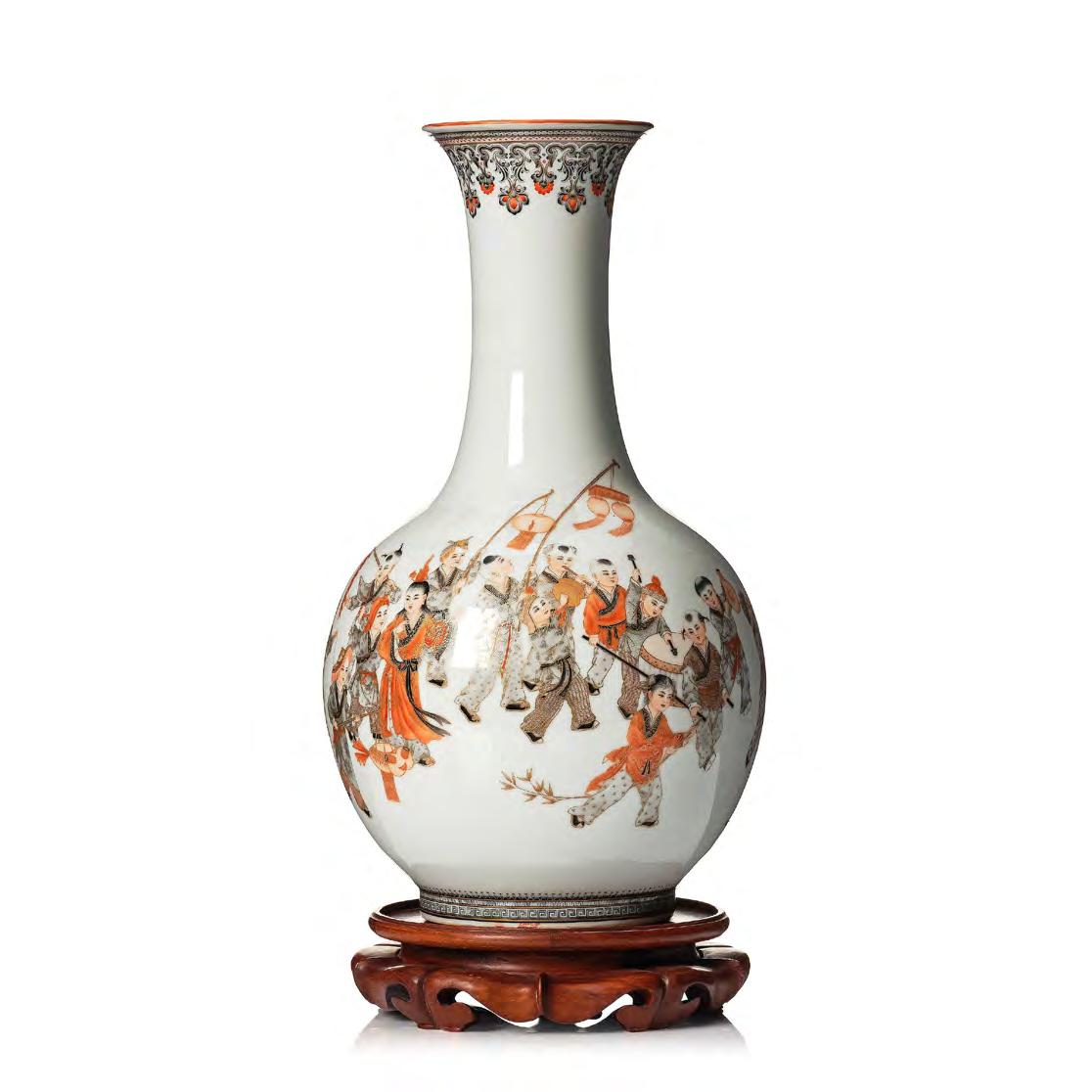

SEK 6 000 – 8 000 / EUR 530 – 710
1311. A finely painted Chinese vase, 20th Century. Seal mark to base. Dropp shaped with a tall neck and flared rim. Finely painted with a procession with boys with banners, lanterns, playing insturments and marching to one side. The other side with seal mark in red and gold and kalligraphy. Height vase 43 cm. Height with wooden stand 49 cm.
Provenance: From the Collection of Ann Felton. Thence by descent. Ann Felton, born in Australia, moved to New York to work as a model for the Ford agency. These vases were purchased when she lived in Hong Kong in the 1960's, where her husband worked.
Estimate: SEK 30 000 – 40 000 / EUR 2 640 – 3 520
1312. A finely painted Chinese vase, 20th Century. Seal mark to base. Painted and gilded decoration with depicting a muscial gathering on one side, the other side with calligraphy and seal marks. Height vase 25 cm. Height with wooden stand 29,5 cm.
From the Collection of Ann Felton. Ann Felton, born in Australia, moved to New York to work as a model for the Ford agency. These vases were purchased when she lived in Hong Kong in the 1960's, where her husband worked.
SEK 15 000 – 20 000 / EUR 1 320 – 1 760
1313. A blue and white dragon dish, Ming dynasty with Jiajings six character mark and of the period (1522–66).

Of square form, painted with a pair of clawed confronting five-clawed dragons reaching for a peach inscribed with the shou character, born on a leafy stem, emerging from rockwork amidst crashing waves. The sides with four sinuous dragons flying amidst cloud scrolls. The base inscribed with a six character mark. Measurement 27 x 27 cm.
Provenance: From the Collection of Christer Löfgren. Mr Löfgren is a prominent collector of Asian Art, Bukowskis has previously had the honour of selling parts of his vast collection. After publishing the second book on Chinese Imperial Regin Marks, the volume ‘Understanding Chinese Reign marks’, he has made the decision to sell his final pieces. Purchased from Marchant & Son in London, in the 1990's.
Exhibitions: Compare a similar dish in the: Collection of Chinese Art at Winchest Colleague. Provenance: Bequeathed as part of the Duberly Collection, 1978; purchased by Major Montagu and Lady Eileen Duberly from the collection of C.M. Woodbridge, sold Sotheby’s, London, 8 May 1951, lot 9. They describe the motif as; – That the dragons are on either side of Mount Penglai, one of the Isles of the Blest. A peach tree springs from its summit bearing a peach inscribed with the character Shou. On either side are the other Isles of the Blest, Fangzhang and Yingzhou.
Literature: Bo Gyllensvärd, Ming blue and white, from Swedish Collections. The Museum of Far Eastern Antquities, compare a dish depicted on page 52. Lot no 49. From the Collection of Einar Lauritzen.
Anthony du Boulay, The Duberly Collection of Chinese Art at Winchester College (Winchester, 2019), p. 29.
Estimate: SEK 100 000 – 120 000 / EUR 8 800 – 10 560
1314. A blue and white kraak dish, Ming dynasty, Wanli (1572–1620).

Decorated with a cricket in a landscape setting. Diameter 29 cm.
Provenance: Property of a private Swedish Collection.
Estimate: SEK 3 000 – 4 000 / EUR 270 – 360
1315. A massive blue and white jar with cover, Ming dynasty, Wanli (1572–1620).
Ovoid shape, decorated with flowers and emblems. Height 51 cm. From the Collection of the Swedish noble family Liljencrantz. Compare similar in the Collection of Kina Slott, Drottningholm, SEK 50 000 – 75 000 / EUR 4 400 – 6 600

1316. A blue and white bowl, 'Hatcher Cargo', 17th Century. Pierced sides, decorated with rouldels with landscapes. Diameter 9 cm.

Provenance: The wares discovered in the early 1980s in the ‘Hatcher Cargo’, named after the Captain who made the discovery, now serve as important benchmarks for the dating of 17th-century Chinese porcelains. The cargo of the ship included some 25,000 pieces of porcelain, mostly blue and white wares from Jingdezhen, but also examples of celadon wares, Dehua wares, polychrome wares and provincial blue and white wares. Several thousand of these were sold in a historic sale at Christie’s Amsterdam in 1984, from which all of the ‘Hatcher’ pieces in the Curtis Collection were purchased. (fig. 1) Because no trade records exist to identify the ship and hence the destination to which it was headed, scholars needed to use a combination of deductive reasoning and knowledge of the porcelain trade at the time to date the wares salvaged from the vessel. While the Dutch East India Company (VOC) used Chinese junks to transport cargos from Taiwan to Batavia, the diversity of the wares in the ‘Hatcher’ wreck indicates that the ship was probably headed for wholesale markets in Batavia or Bantam.

Literature: Colin Sheaf and Richard Kilburn, The Hatcher Porcelain Cargoes, The Complete Record, London, 1988, p. 30) Sheaf and Kilburn take a step-by-step process to deduce that the ship most likely sunk between 1643 and 1646. The inclusion of two covers for ovoid jars (similar in shape to the lot 3513) bearing inscriptions and a cyclical date corresponding to the spring of 1643 indicates that the vessel sank no earlier than the spring of 1643. The authors also note that because of the internal unrest in China at the time, trade was significantly disrupted at the fall of the Ming dynasty and studies of VOC records show that by 1646 the Manchus were preventing the free movement of trade and shipments out of Jingdezhen. The authors conclude that it is therefore very likely that the Chinese junk known as the ‘Hatcher Cargo’ must have sunk sometime in the years between 1643 and 1646. In her article, “Transition Ware Made Plain: A Wreck from the South China Sea” (Oriental Art, Summer, 1985).)
Estimate: SEK 6 000 – 8 000 / EUR 530 – 710
1317. Two blue and white boxes with covers, 'Hatcher Cargo', 17th Century. Doomed cover, decorated with antiques and fans. Diameter 5 cm.
The Hatcher Collection, Christie’s June 1984. The wares discovered in the early 1980s in the ‘Hatcher Cargo’, named after the Captain who made the discovery, now serve as important benchmarks for the dating of 17th-century Chinese porcelains. The cargo of the ship included some 25,000 pieces of porcelain, mostly blue and white wares from Jingdezhen, but also examples of celadon wares, Dehua wares, polychrome wares and provincial blue and white wares. Several thousand of these were sold in a historic sale at Christie’s Amsterdam in 1984, from which all of the ‘Hatcher’ pieces in the Curtis Collection were purchased. (fig. 1) Because no trade records exist to identify the ship and hence the destination to which it was headed, scholars needed to use a combination of deductive reasoning and knowledge of the porcelain trade at the time to date the wares salvaged from the vessel. While the Dutch East India Company (VOC) used Chinese junks to transport cargos from Taiwan to Batavia, the diversity of the wares in the ‘Hatcher’ wreck indicates that the ship was probably headed for wholesale markets in Batavia or Bantam.
Literature: Colin Sheaf and Richard Kilburn, The Hatcher Porcelain Cargoes, The Complete Record, London, 1988, p. 30) Sheaf and Kilburn take a step-by-step process to deduce that the ship most likely sunk between 1643 and 1646. The inclusion of two covers for ovoid jars (similar in shape to the lot 3513) bearing inscriptions and a cyclical date corresponding to the spring of 1643 indicates that the vessel sank no earlier than the spring of 1643. The authors also note that because of the internal unrest in China at the time, trade was significantly disrupted at the fall of the Ming dynasty and studies of VOC records show that by 1646 the Manchus were preventing the free movement of trade and shipments out of Jingdezhen. The authors conclude that it is therefore very likely that the Chinese junk known as the ‘Hatcher Cargo’ must have sunk sometime in the years between 1643 and 1646. In her article, “Transition Ware Made Plain: A Wreck from the South China Sea” (Oriental Art, Summer, 1985).)
Estimate: SEK 4 000 – 6 000 / EUR 360 – 530
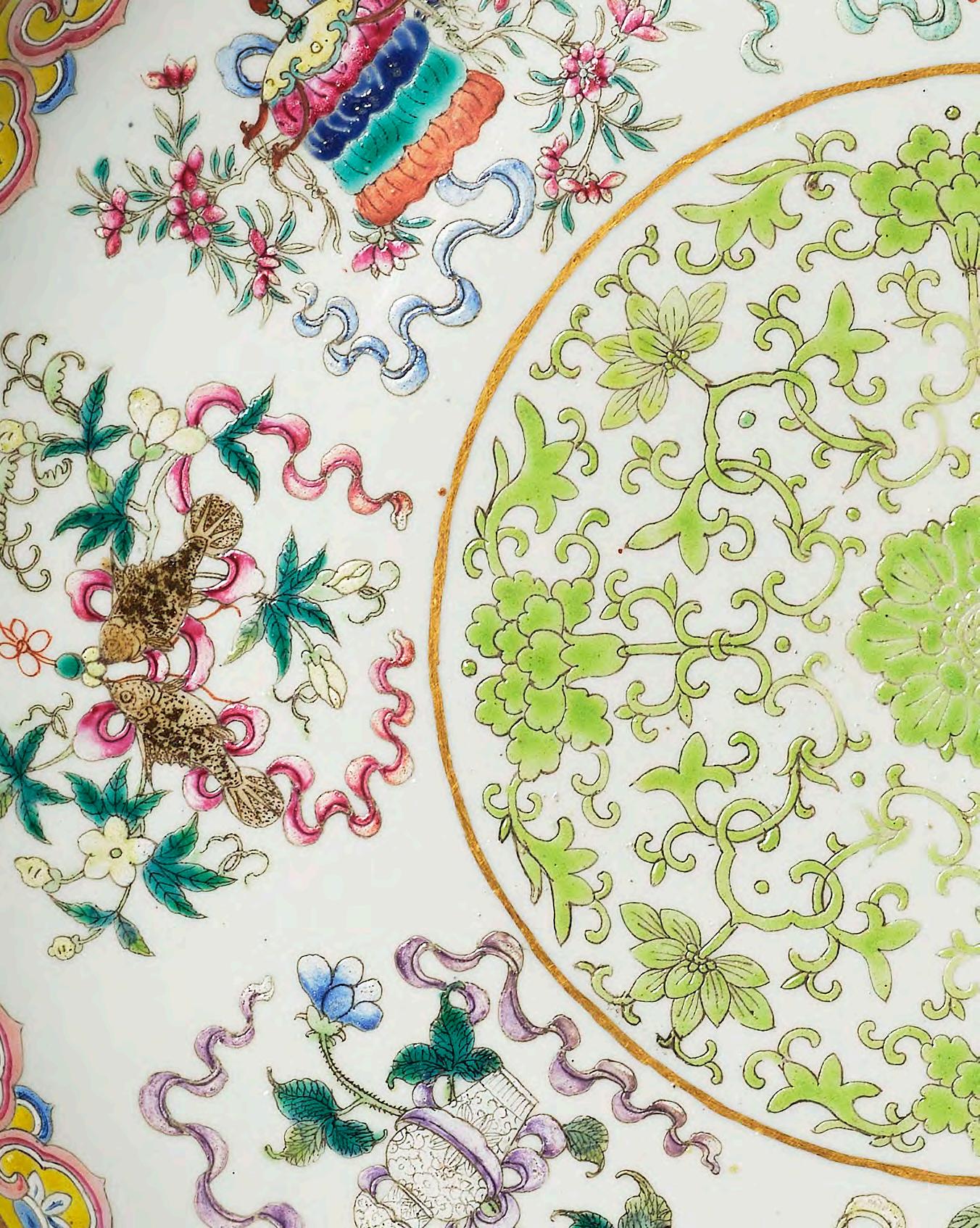 1285. A large 'Eight Buddhist Emblems' dish, Qing dynasty, mark and period of Guangxu (1875–1908).
1285. A large 'Eight Buddhist Emblems' dish, Qing dynasty, mark and period of Guangxu (1875–1908).

porcelain, mostly blue and white wares from Jingdezhen, but also examples of celadon wares, Dehua wares, polychrome wares and provincial blue and white wares. Several thousand of these were sold in a historic sale at Christie’s Amsterdam in 1984, from which all of the ‘Hatcher’ pieces in the Curtis Collection were purchased. (fig. 1) Because no trade records exist to identify the ship and hence the destination to which it was headed, scholars needed to use a combination of deductive reasoning and knowledge of the porcelain trade at the time to date the wares salvaged from the vessel. While the Dutch East India Company (VOC) used Chinese junks to transport cargos from Taiwan to Batavia, the diversity of the wares in the ‘Hatcher’ wreck indicates that the ship was probably headed for wholesale markets in Batavia or Bantam.
Literature: Colin Sheaf and Richard Kilburn, The Hatcher Porcelain Cargoes, The Complete Record, London, 1988, p. 30) Sheaf and Kilburn take a step-by-step process to deduce that the ship most likely sunk between 1643 and 1646. The inclusion of two covers for ovoid jars (similar in shape to the lot 3513) bearing inscriptions and a cyclical date corresponding to the spring of 1643 indicates that the vessel sank no earlier than the spring of 1643. The authors also note that because of the internal unrest in China at the time, trade was significantly disrupted at the fall of the Ming dynasty and studies of VOC records show that by 1646 the Manchus were preventing the free movement of trade and shipments out of Jingdezhen. The authors conclude that it is therefore very likely that the Chinese junk known as the ‘Hatcher Cargo’ must have sunk sometime in the years between 1643 and 1646. In her article, “Transition Ware Made Plain: A Wreck from the South China Sea” (Oriental Art, Summer, 1985).)
Estimate: SEK 12 000 – 15 000 / EUR 1 060 – 1 320
1319. A blue and white four clawed dragon wine cup, 'Hatcher Cargo', 17th Century.


Decorated in underglaze blue with a four clawed dragon chasing the flaming pearl amidst cloud formations. Height 4.2 cm.
Provenance: The Hatcher Collection, Christie’s June 1984. The wares discovered in the early 1980s in the ‘Hatcher Cargo’, named after the Captain who made the discovery, now serve as important benchmarks for the dating of 17th-century Chinese porcelains. The cargo of the ship included some 25,000 pieces of porcelain, mostly blue and white wares from Jingdezhen, but also examples of celadon wares, Dehua wares, polychrome wares and provincial blue and white wares. Several thousand of these were sold in a historic sale at Christie’s Amsterdam in 1984, from which all of the ‘Hatcher’ pieces in the Curtis Collection were purchased. (fig. 1) Because no trade records exist to identify the ship and hence the destination to which it was headed, scholars needed to use a combination of deductive reasoning and knowledge of the porcelain trade at the time to date the wares salvaged from the vessel. While the Dutch East India Company (VOC) used Chinese junks to transport cargos from Taiwan to Batavia, the diversity of the wares in the ‘Hatcher’ wreck indicates that the ship was probably headed for wholesale markets in Batavia or Bantam
Literature: Colin Sheaf and Richard Kilburn, The Hatcher Porcelain Cargoes, The Complete Record, London, 1988, p. 30) Sheaf and Kilburn take a step-by-step process to deduce that the ship most likely sunk between 1643 and 1646. The inclusion of two covers for ovoid jars (similar in shape to the lot 3513) bearing inscriptions and a cyclical date corresponding to the spring of 1643 indicates that the vessel sank no earlier than the spring of 1643. The authors also note that because of the internal unrest in China at the time, trade was significantly disrupted at the fall of the Ming dynasty and studies of VOC records show that by 1646 the Manchus were preventing the free movement of trade and shipments out of Jingdezhen. The authors conclude that it is therefore very likely that the Chinese junk known as the ‘Hatcher Cargo’ must have sunk sometime in the years between 1643 and 1646. In her article, “Transition Ware Made Plain: A Wreck from the South China Sea” (Oriental Art, Summer, 1985).
Estimate: SEK 4 000 – 6 000 / EUR 360 – 530
1320. A blue and white Transitional vase/chopstick-holder, 17th Century.
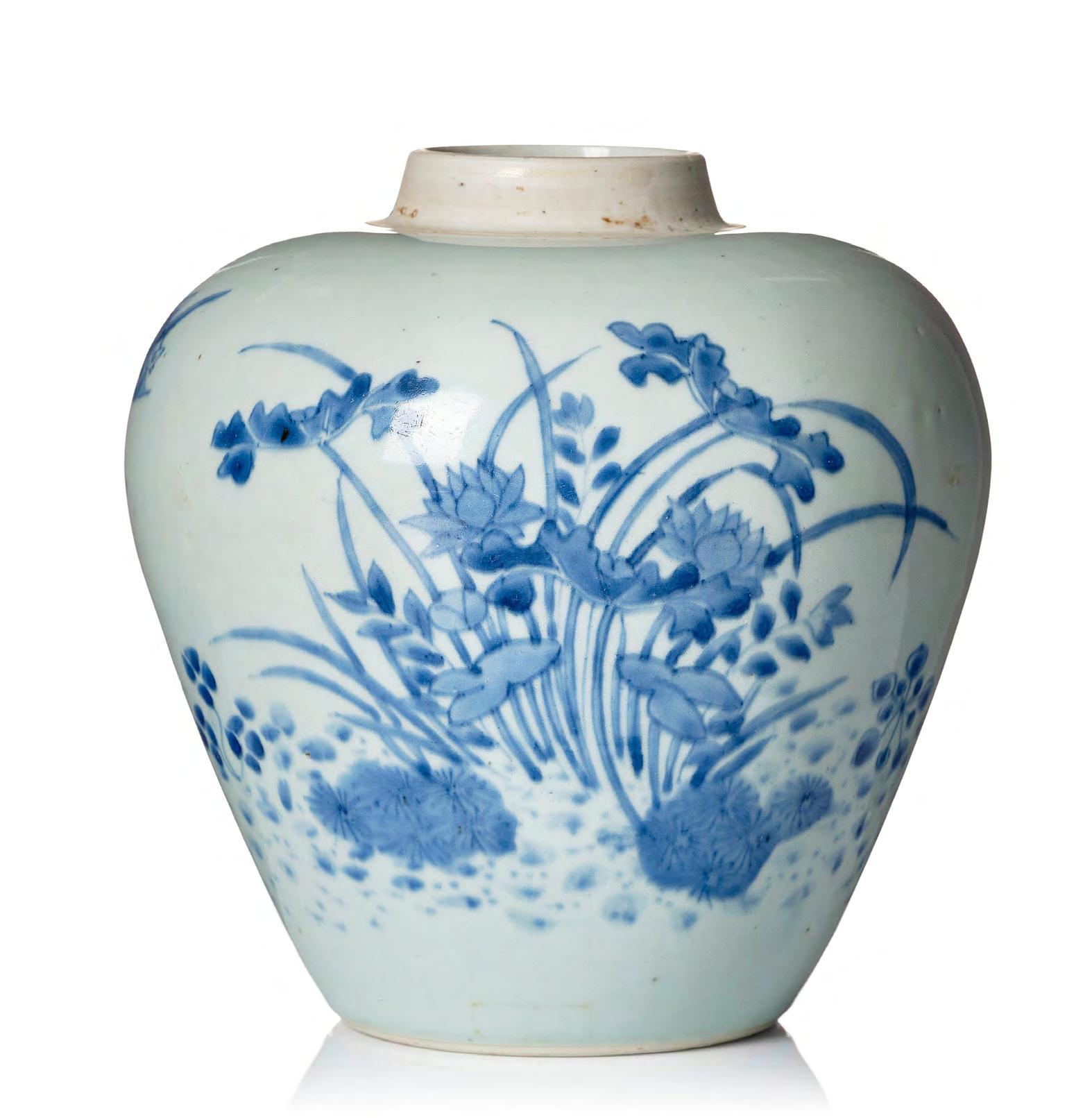

Fanshaped with holes for hanging on the wall, decorated in blue and white with bamboo and calligraphy. Height 16 cm.
Provenance: Purchased at Bukowskis 2012, lot no 1788. Then from the Stenbeck Collection.
Estimate: SEK 12 000 – 15 000 / EUR 1 060 – 1 320
1321. A blue and white Transitional jar, 17th Century.
Well rounded shoulder, unglazed neck, decorated in underglaze blue with birds by a lotus pond during full moon. Height 24 cm.
Provenance: From the Bengt Norrlinder Collection.
Estimate: SEK 20 000 – 25 000 / EUR 1 760 – 2 200
1323. A blue and white lotus dish, Qing dynasty, Kangxi (1662–1722).

Decorated in underglaze blue with a contionous lotus scroll. The back of the rim with four symbols, and to the center an artemisia leaf. Diameter 35.5. cm.
Provenance: Property of a Swedish private Collection.
Label from Geoffrey Waters, London SW3 4PW.
Estimate: SEK 8 000 – 10 000 / EUR 710 – 880
1322. A blue and white vase, Qing dynasty, Kangxi (1662–1722). Decorated with figure scenes. Height 44.5 cm
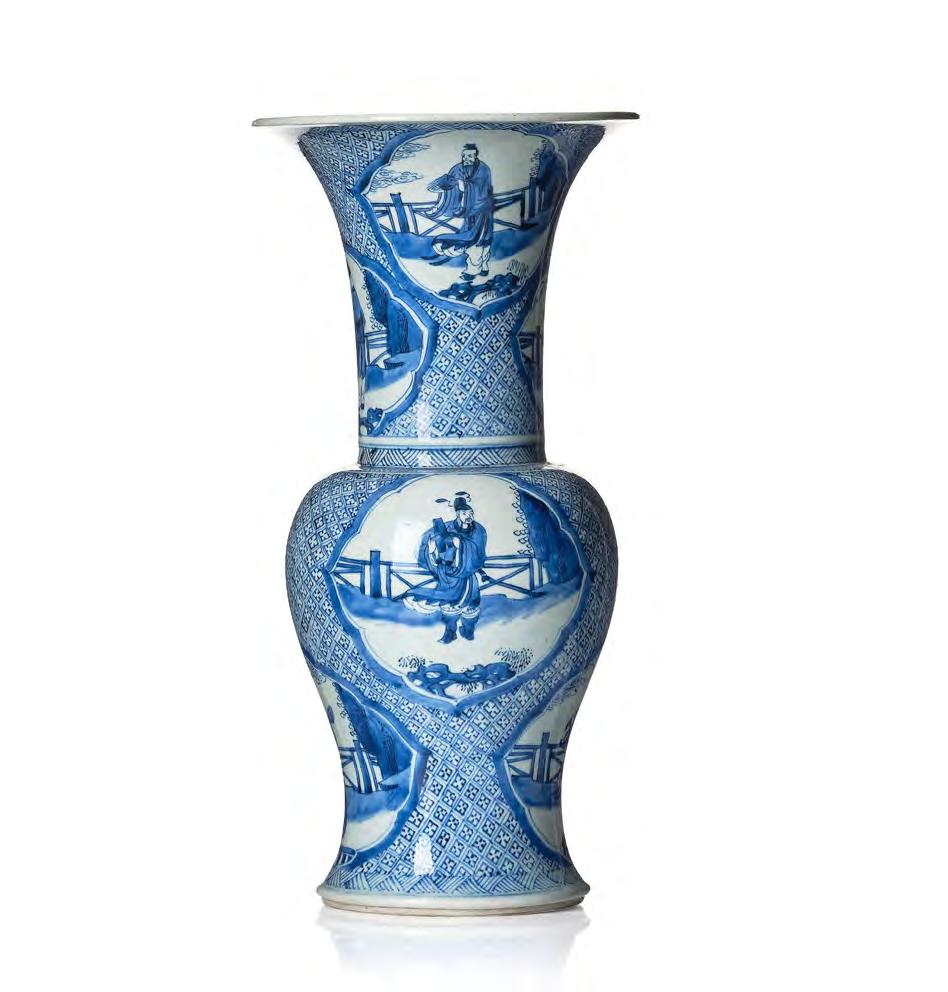

Property of a Swedish private Collection.
SEK 10 000 – 15 000 / EUR 880 – 1 320
1324. A blue and white lotus jar, Qing dynasty, Kangxi (1662–1722).
Of baluster shape, decorated with a contionous lotus scroll. Height 37 cm.
Provenance: Property of a Swedish private Collection.
Estimate: SEK 20 000 – 25 000 / EUR 1 760 – 2 200
1325. A blue and white jar, Qing dynasty, Kangxi (1662–1722).


Traditional shape, decorated with antiques and precious objects against a cracked ice ground with flowers. Height 17 cm. Height with wooden stand and cover 24 cm.
Provenance: Property of a Swedish private Collection.
Estimate: SEK 4 000 – 6 000 / EUR 360 – 530
1326. A blue and white tea caddy, Qing dynasty, Kangxi
Ovoid shape, decorated with cherry blossom against a cracked-ice background. Height 13.5 cm. Wooden cover accompanies the piece. Property of a Swedish private Collection.
SEK 4 000 – 6 000 / EUR 360 – 530
1327. A blue and white bowl, Qing dynasty, Kangxi (1662–1722).
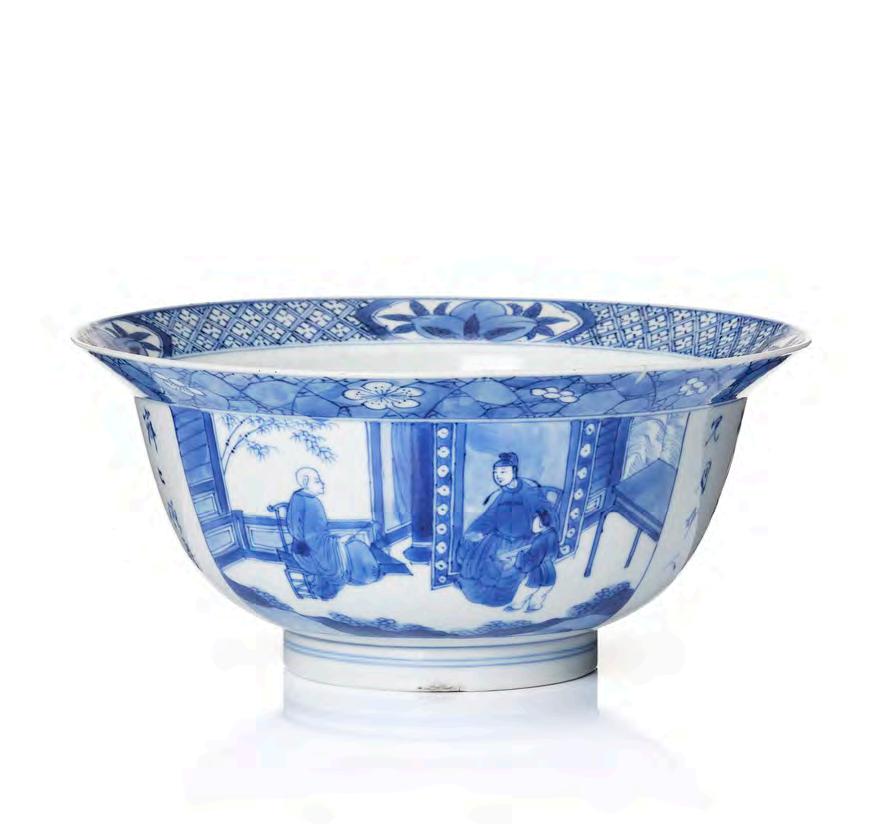
With a seal mark to base within double blue circle 'Da Ming Jiajing nian zhi', decorated in underglaze blue with figure scenes and calligraphy. Diameter 20.2 cm.
Provenance: Property of a Swedish private Collection.
Exhibitions: Compare a another bowl of this type at the Collection of the Musee Guimet, Paris, G 2956 (+).
Estimate: SEK 4 000 – 6 000 / EUR 360 – 530
1329. A blue and white dish, Qing dynasty, 18th Century. Hall mark to base. Decorated in underglaze blue with a monkey, a deer and some birds in a garden. Diameter 28 cm.
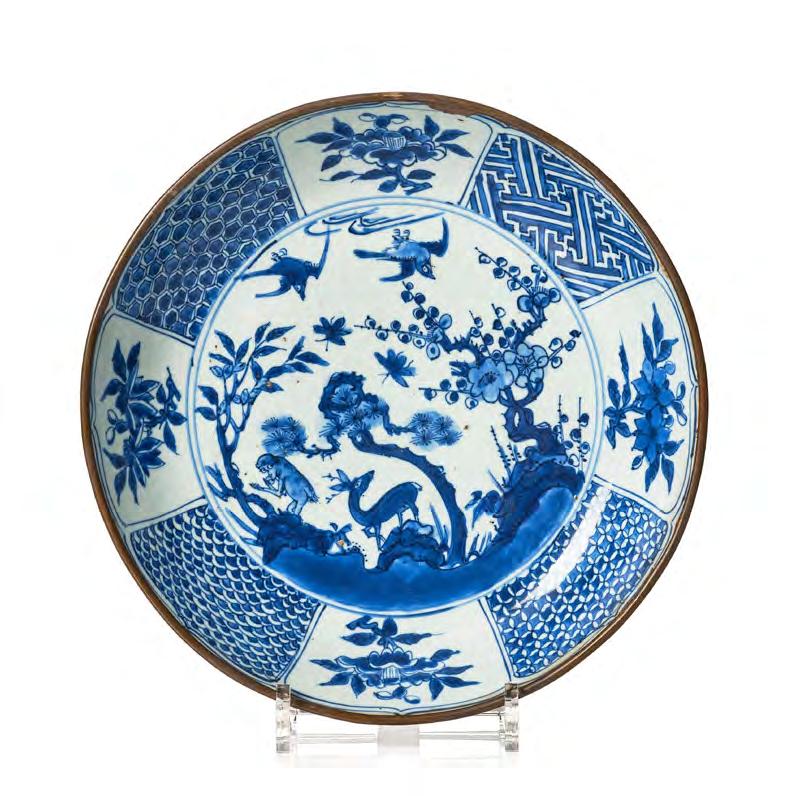

Provenance: Property of a Swedish private Collection.
Estimate: SEK 4 000 – 6 000 / EUR 360 – 530
1330. A blue and white tripod censer, Qing dynasty, 18th Century. Decorated in underglaze blue with four clawed dragons chasing the flaming pearl amidst cloud formations. Diameter 22 cm.

Provenance: Property from a Swedish private Collection.
Estimate: SEK 8 000 – 10 000 / EUR 710 – 880
1331. A blue and white vase, Qing dynasty, Kangxi (1662–1722).
Decorated in underglaze blue with continous floral scrolls. Heigth 13 cm.
Estimate: SEK 4 000 – 6 000 / EUR 360 – 530
1333. A blue and white charger, Qing dynasty, Kangxi (1662–1722).

Decorated in underglaze blue with a scene from a Chinese litterary work. Diameter 39 cm. Wooden stand accompanies the piece.
Estimate: SEK 4 000 – 6 000 / EUR 360 – 530
1332. A blue and white tureen with cover, Qing dynasty, Qianlong (1736–95).

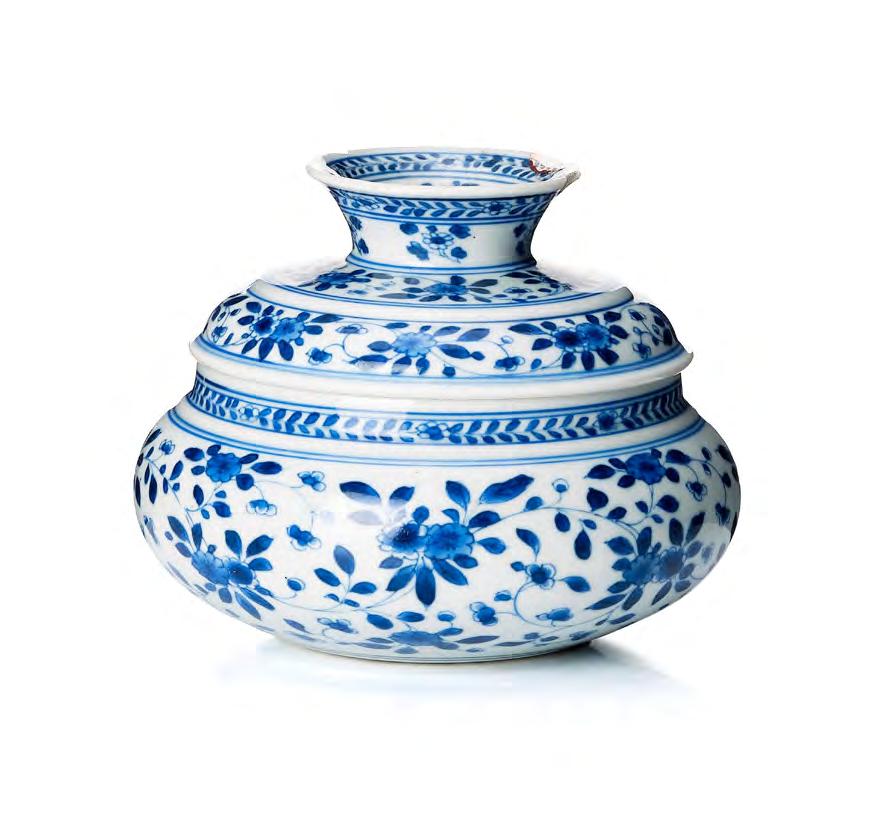
Octagonal with rabbitshead handles and finial in the shape of an acantus leaf, decorated with a classic riverscape in underglaze blue. Length 34 cm.
Estimate: SEK 10 000 – 15 000 / EUR 880 – 1 320
1334. A large blue and white bowl, Qing dynasty, Kangxi (1662–1722).
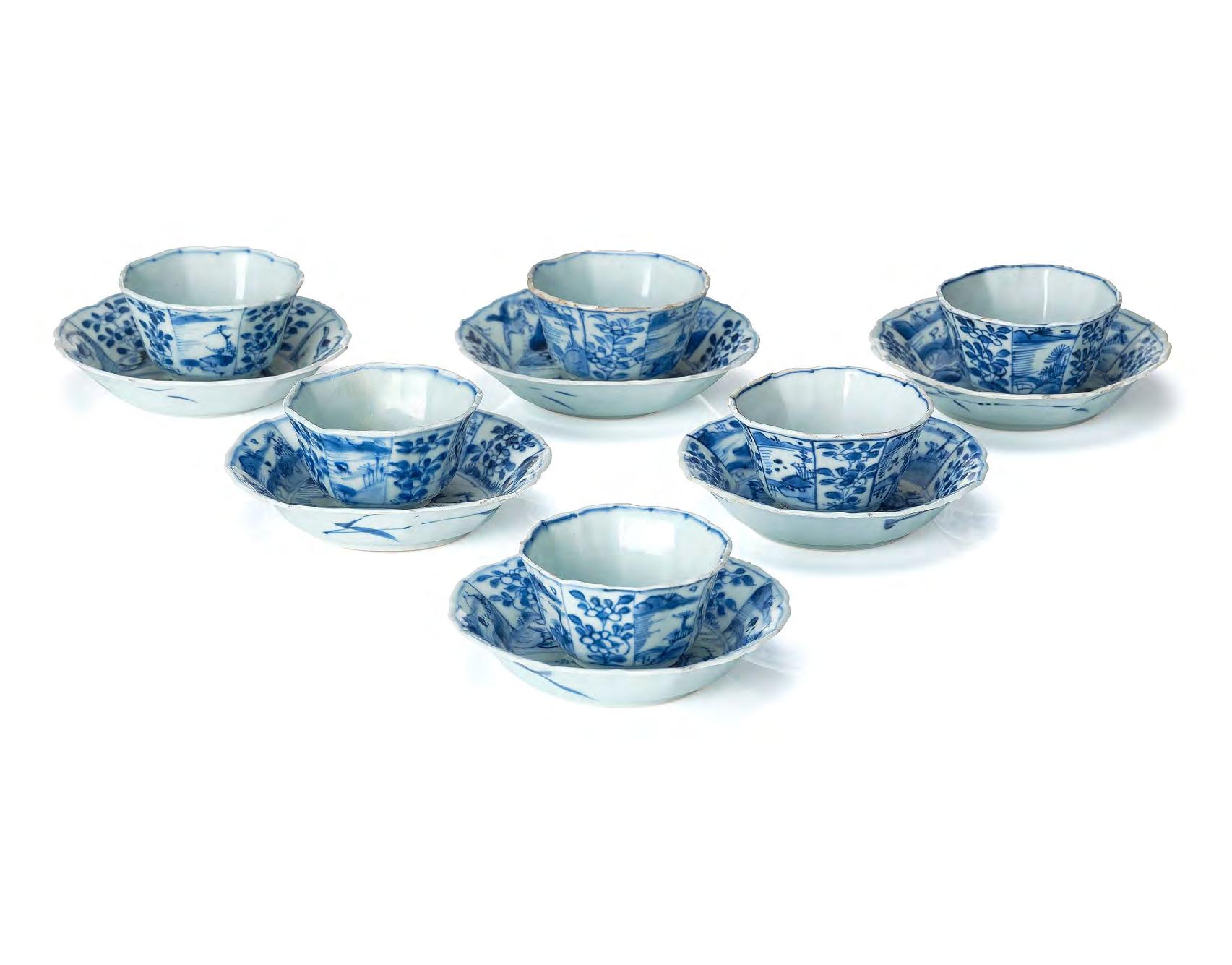

Lobed rim, deep sides, decorated with elegant ladies from the court alternating with bamboo and cherry blossom. Diameter 33.5 cm. Height 15.5 cm.
Provenance: Property of a private Swedish Collection.
Estimate: SEK 12 000 – 15 000 / EUR 1 060 – 1 320
1335. A blue and white jar mounted as a lamp, Qing dynasty, 18th Century.

Ovoid shape decorated in underglaze blue with a central motif with antiques and precious objects against a cracked ice ground with cherry blossoms. Height jar 20 cm. Height with lamp shade and base 58 cm.
Provenance: Property of a private Swedish Collection.
Estimate: SEK 6 000 – 8 000 / EUR 530 – 710
1336. A set of six cups with stands, Qing dynasty, Kangxi (16662–1722).
Hexagonal shape decorated with a landscape motif in the central medallion. Diameter cup 6.5 cm. Diameter dish 10.5 cm.
Provenance: Property of a private Swedish Collection.
Estimate: SEK 5 000 – 7 000 / EUR 440 – 620
1337. A blue and white jar, Qing dynasty, 18th Century. Ovoid shape, decorated in blue and white with a figure scene with women and children in a garden. Height 20.5 cm. Height with mount as lamp and lampshade 46 cm.

Provenance: Property of a private Swedish Collection.
Estimate: SEK 6 000 – 8 000 / EUR 530 – 710
1339. A blue and white 'armorial' dish for the Swedish family 'Grill', Qing dynasty, Qianlong (1736–95).
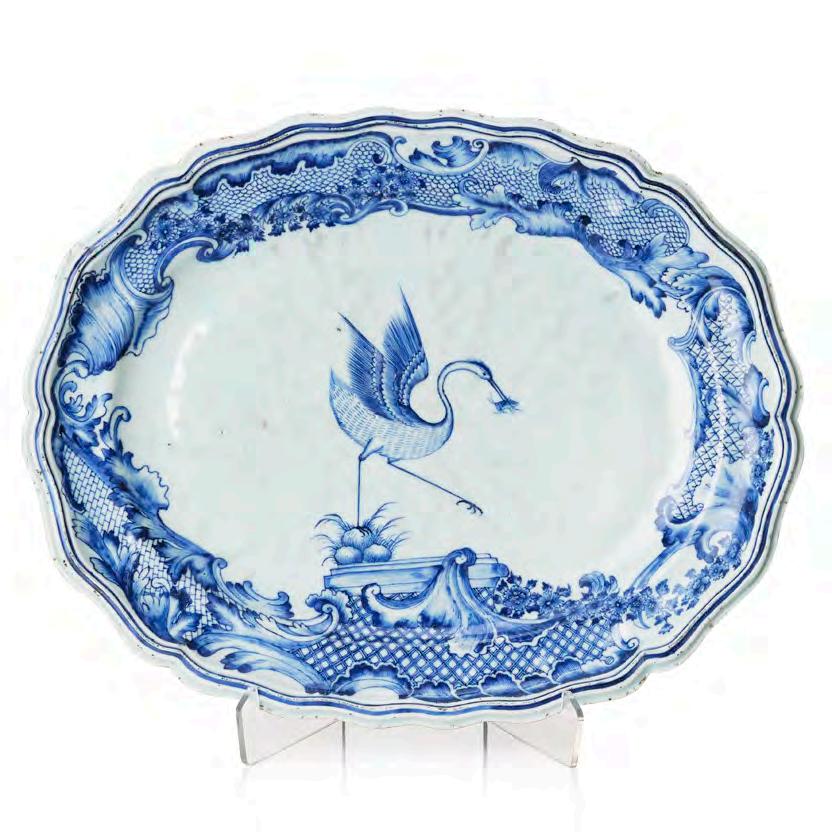
Oval, after a european silver shape, decorated with a crane with a cricket in his beak. Length 45 cm.
Provenance: The Grill family was one of the most powerful in Sweden during the 18th Century. Many family members were involved in the Swedish East India Company. Claes Grill was for example director of the Swedish East-India Company, owner of Sweden’s leading merchant house Claes & Carolos Grill, their trade involved shipping, co-owner of a sail and linen manufactory, glassworks, shipyards, a bank and he owned a line of mines and estates. This service might have been comissioned by Jean Abraham Grill who were the administrative assistant for many years in Canton. He might have comissioned it for his father Abraham Grill, also a Director of the Swedish East India Company. The Grill family derives from a Dutch noble family and was not introduced in Sweden. They used the crane with a cricket in its beak as their coat of arms.
Literature: Cleive Hornstrand, The Family Grill East Indian Porcelain, page 100-110.
Estimate: SEK 12 000 – 15 000 / EUR 1 060 – 1 320
1338. A Chinese tureen with cover, Qing dynasty, Qianlong (1736–95).

Oval shape, decorated with akantus handles, feline finial and a garden with the three 'friends' bamboo, peonies and pine tree. Lenght 36 cm.
Estimate: SEK 8 000 – 10 000 / EUR 710 – 880
1340. A large Chinese Export blue and white lemon basket with stand, Qing dynasty, Qianlong (1736–95).
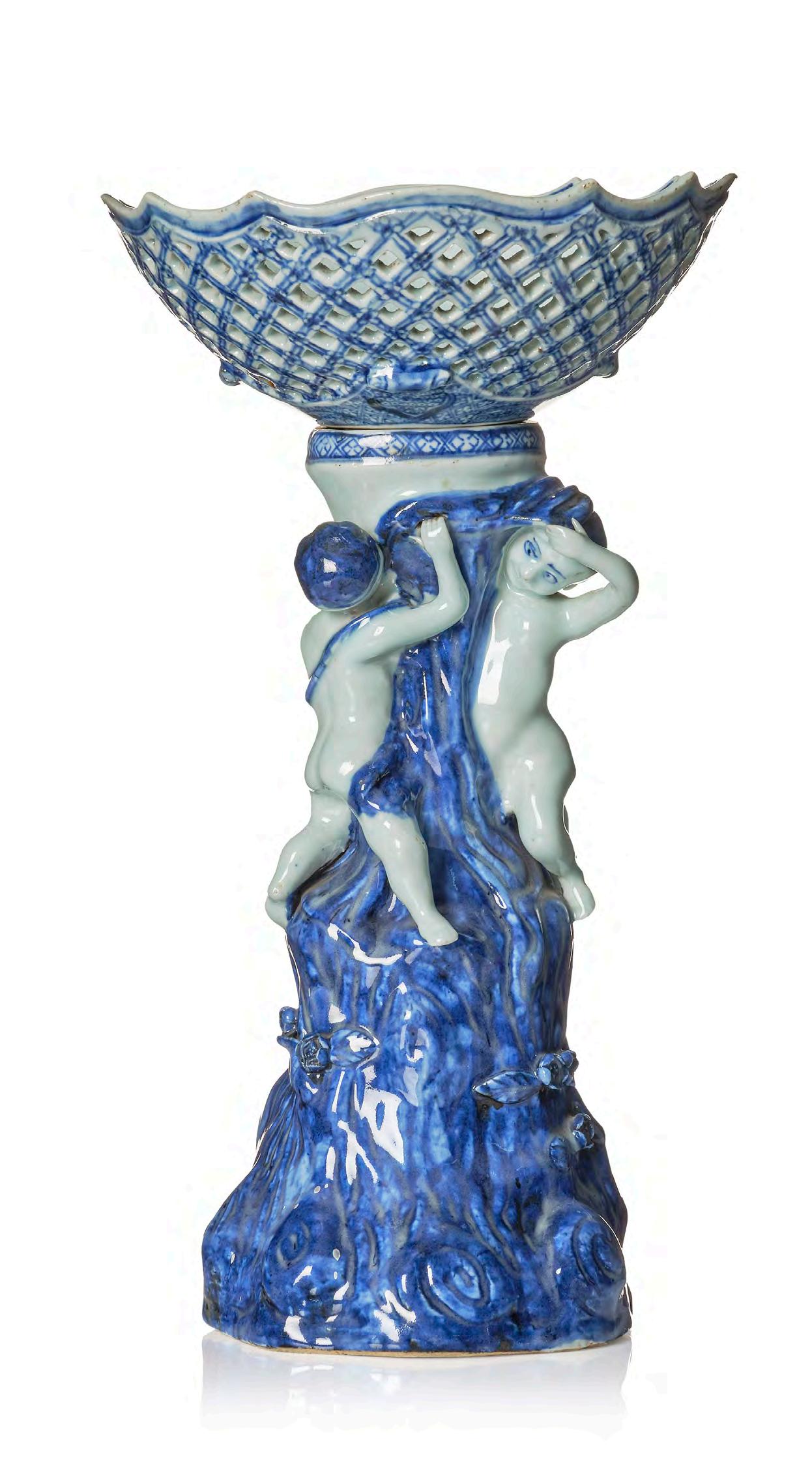
The pierced basket decorated with floral sprigs on the interior below a border, the exterior similarly decorated, the stand modeled as a gnarled tree trunk and with applied flowers, two putti clambering and encircling their arms around the upper part of the trunk.
Height 38 cm. Length basket 21 cm.
Property of a private Swedish Collection.
Directly copying a Meissen model produced around 1740, the form was meant to be a table centerpiece set above an oval tray and surrounded by other smaller condiment pots to hold spice and oil, as illustrated in Bredo L. Grandjean, Dansk Ostindisk Porcelæn, Copenhagen, 1965, fig. 56, cat. no. 40. Another example is illustrated in David Howard and John Ayers, China for the West, vol. II, London, 1978, p. 566, along with a Meissen example.
SEK 12 000 – 15 000 / EUR 1 060 – 1 320
1341. A pair of six armorial custard cups with covers, Qing dynasty, circa 1800.
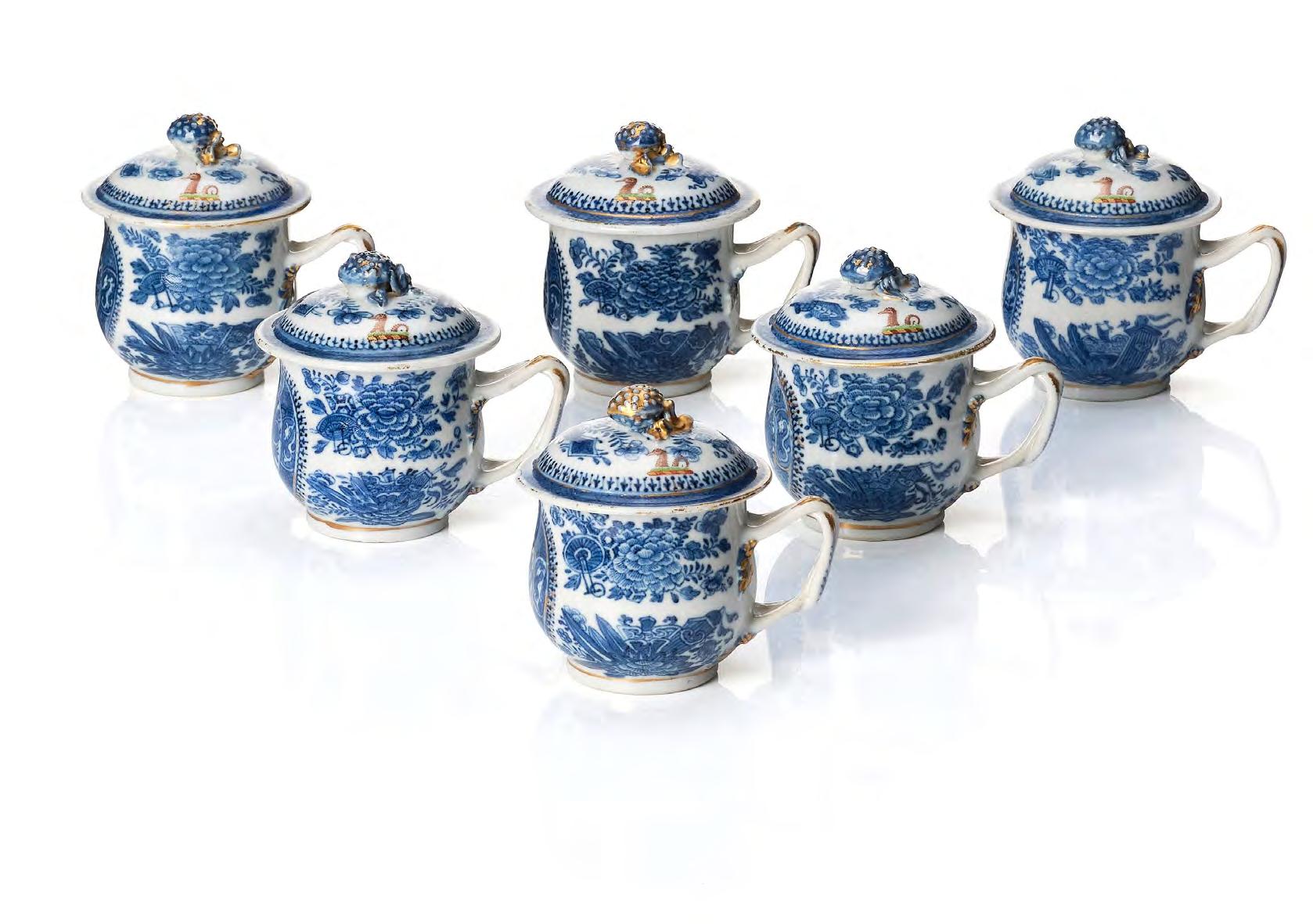
Decorated with 'Fitz-Hugh' pattern and a crest. Height 9 cm.
Estimate: SEK 4 000 – 6 000 / EUR 360 – 530
1342. A Chinese vase underglaze iron red and blue, Qing dynasty, late 19th Century.

Baluster shape, tall neck, decorated in underglaze blue and red with a mythical beast and bird of pray in a garden setting with pine trees. Height vase 56 cm. Height with mount as lamp 66 cm.
Provenance: Property of a private Swedish Collection.
Estimate: SEK 4 000 – 6 000 / EUR 360 – 530
1343. A blue and white bronze shaped vase with mythical creatures, Qing dynasty, 19th Century. Baluster shape, decorated with mascaron handles and mythical cratures in a vibrant blue colour. Height 29.5 cm.
Purchased at Bukowskis, June 2011.
SEK 12 000 – 15 000 / EUR 1 060 – 1 320
1344. A blue and white dish, late Qing dynasty with Guangxu mark. Decorated in underglaze blue with precious objects. Diameter 21 cm.

Provenance: Property of a Swedish private collection.
1345. A blue and white vase, with Qianlong mark. Of archaistic style, the baluster shaped body has a flared waisted neck, the shoulders appled with a pair of molded elephant mask handles, each suspending a mock ring. The shoulder and body is decorated with a continous lotus scroll devided by three bands. The lower part of the body is wrapped in a band of crashing waves above a band of lappets at the foot. The neck is further decorated with leaves beneath a band of


Purchased at auction in Norway. Then with the provenance; Norwegian missionary who lived in China in the 1920s.
SEK 20 000 – 30 000 / EUR 1 760 – 2 640
1347. A blue and white four clawed dragon censer, Qing dynasty, 19th Century.
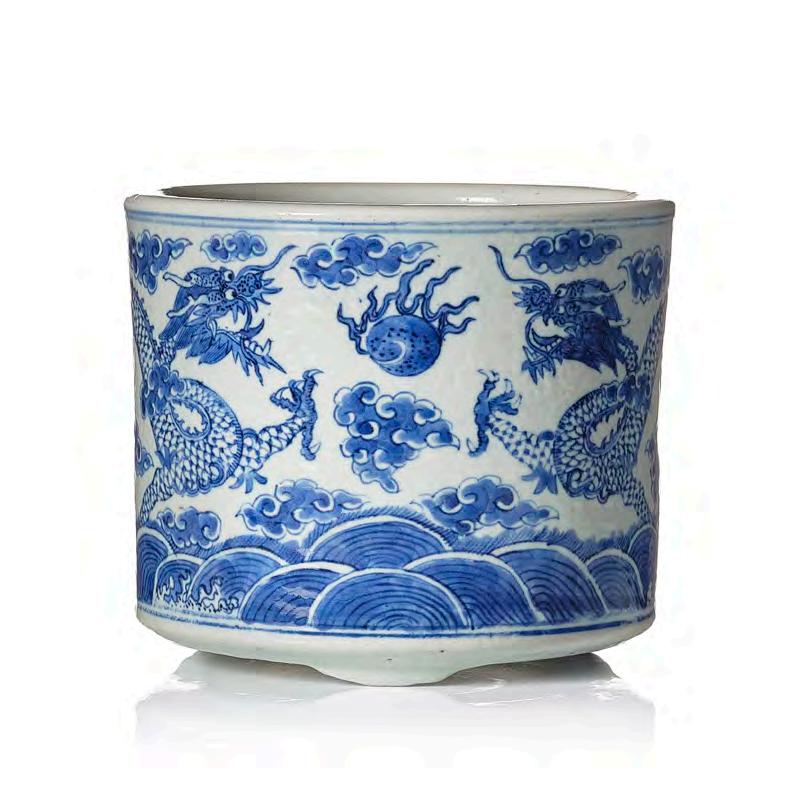

Round on three feet, decorated with four clawed dragons chasing the flaming pear. Diameter 20 cm. Height 15.5 cm.
Estimate: SEK 10 000 – 15 000 / EUR 880 – 1 320
1346. A blue and white four clawed dragon garden seat, Qing dynasty, 19th Century.
Barrel shaped with pierced cacheshaped openings to the side. Decorated in underglaze blue with fierce four clawed dragons chasing the flaming pearl. Height 46 cm.
Provenance: Property of a private Swedish Collection.
Estimate: SEK 6 000 – 8 000 / EUR 530 – 710
1348. A blue and white censer, late Qing dynasty. Round, on three feet, decorated in underglaze blue with four clawed dragons chasing the flaming pearl above wave formations. Diameter 20 cm, height 16.5 cm.
Estimate: SEK 12 000 – 15 000 / EUR 1 060 – 1 320

1349. A blue and white Chinese garden seat, Qing dynasty, 19th Century.
Hexagonal, decorated with a river scape in under glaze blue. Height 48 cm. Diameter 28 cm.
Estimate: SEK 10 000 – 15 000 / EUR 880 – 1 320
1350. A blue and white jar with cover, Qing dynasty, 19th Century. Decorated in underglaze blue with panels with birds in a garden setting against a ground with firece dragons chasing the flaming pearl.

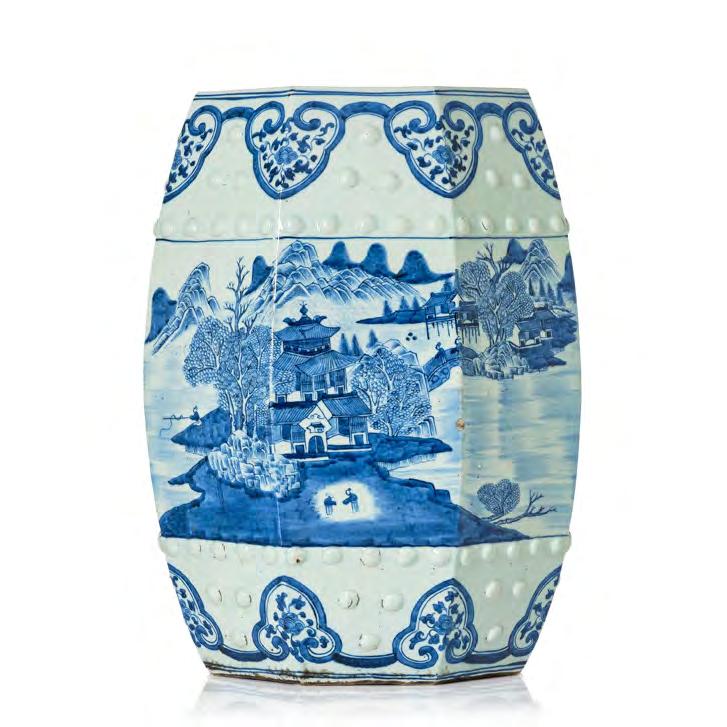
Height 25.5 cm.
Estimate: SEK 5 000 – 7 000 / EUR 440 – 620
1351. A blue and white tray, Qing dynasty, 19th Century. Oval shape on four feet, with four character to the base. Decorated in underglaze blue with men at fighting by a city wall.

Lenght 29 cm.
Provenance: Property of a private Swedish Collection.
Estimate: SEK 4 000 – 6 000 / EUR 360 – 530
1352. A pair of blue and white vases made in to lamps, late Qing dynasty, 19th Century.

Cylindrical shape, decorated in underglaze blue with a figure scene from court life. Height 29.5 cm. Height with mount 40.5 cm.
Estimate: SEK 6 000 – 8 000 / EUR 530 – 710
1353. Shiro Kasamatsu (Japan, 1898 - 1991) The Great Lantern of the Kannon Temple, Asakusa, (Asakusa Kannon-dô Ô-chôchin).

Woodblock print in colours, Sealed with 7mm Watanabe (1957–1989). Reprint edition from circa the 1980's. Vertical ôban: I. 37 x 25 cm.
Provenance: Property of a private Swedish Collection.
Literature: Cf. a print from the original edition in the collection of Museum of Fine Arts, Boston: 51.1752
Estimate: SEK 4 000 – 6 000 / EUR 360 – 530
1354. Eisho Narazaki (Japan, 1864 - 1936) The Interior of Asakusa Kannon Temple, (Asakusa Kanzeon no Naido).

Woodblock print in colours. With Watanabe 'D' seal ((1931–1941). Vertical ôban: sheet size 38 x 27 cm.
Provenance: Property of a private Swedish Collection.
Literature: Cf. a print from the 1932 edition, Museum of Fine Arts, Boston: 50.2848
Estimate: SEK 4 000 – 6 000 / EUR 360 – 530
Autumn at Oirase (Oirase no aki), from the series “Collection of Views of Japan, Eastern Japan Edition (Nihon fukei shu higashi Nihon hen)”. Watanabe Shōzaburō 渡邊庄三郎 , Japanese, 1885 - 1962 (Publisher). Measurment leaf 26 x 39 cm. Motif 24 x 36 cm.

Provenance: Property of a private Swedish Collection.
Exhibitions: Compare a similar print at the Art Institute Chigaco, Reference Number. 1990.607.672. Also compare one in the collection of Virginia Museum of Fine Art. Object Number: 2006.370.
Estimate: SEK 8 000 – 10 000 / EUR 710 – 880
1355. A Japanese woodblock print by Kawase Bunjiro Hasui (1883–1957).
1356. Kawase Bunjiro Hasui (Japan, 1883 - 1957) Moon over Kiyosumi Garden (Tsuki no Kiyosumien).
Woodblock print in colours. Signed Hasui and sealed Kawase. With Watanabe 6mm seal (1946–1957).
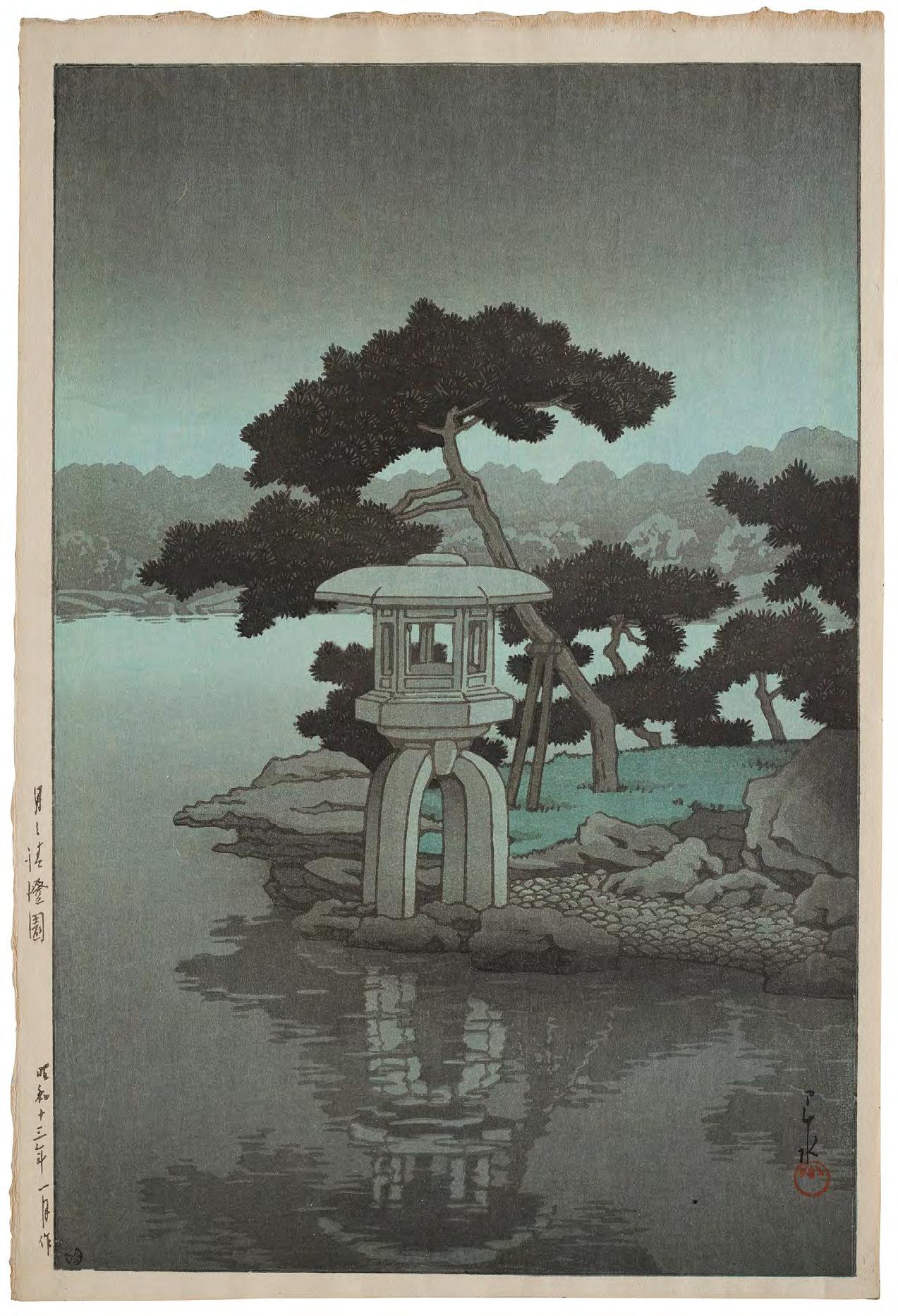
Published by Watanabe Shôzaburô. Vertical ôban: sheet size 38 x 26 cm.
Literature: Compare an example from the 1938 edition at the Art Institute of Chicago: 1990.607.682
Estimate: SEK 6 000 – 8 000 / EUR 530 – 710
1357. Kawase Bunjiro Hasui (Japan, 1883 - 1957) Rain at Maekawa in Sagami Province (Sôshû Maekawa no ame).

Woodblock print in colours. Signed Hasui and sealed Kawase. From the series 'Selected Views of the Tôkaidô Road', (Tôkaidô fûkei senshû), 1932. Published by Watanabe Shôzaburô. Vertical ôban: I. 37,5 x 25,5 cm.
Literature: Compare an impression in the collections of the Art Institute of Chicago: 1990.607.713; and one in the collections of the Museum of Fine Arts Boston: 49.702
Estimate: SEK 6 000 – 8 000 / EUR 530 – 710

1358. Kawase Bunjiro Hasui (Japan, 1883 - 1957) The Shinagawa Offing ( Shinagawa oki).
Woodblock print in colours. Signed Hasui and sealed Kawase. From the series 'Twelve Scenes of Tokyo (Tokyo junidai)', 1920. Horizontal ôban: 24,5 x 36,5 cm.

Provenance: From the Ankarcrona Collection. The foundation of the collection was laid by Rear Admiral/Flag officer Sten Ankarcrona (1861-1936). Ankarcrona first got a taste for the Asian Art while following his fathers’s footsteps serving as ‘enseigne de vaisseau’ for the French navy “la Royale” during the years 1885-1889, when his Fregatt sailed in the area. Ankarcrona continued to ad on to the collection, later in life when he was sent on a special mission to Japan in 1923. He brought back vast collections of lacquer, bronzes, textiles, ceramics. In 1911 the family moved to the mansion like duplex next to Sturegatan in Stockholm. The elegant home and their summer house at Brevik by Erstaviken where Ankarcrona created a Japanese garden (1923-27) and even set up a complete Japanese building was documented in the the magazine ‘Svenska Hem i ord och bild’ in 1928, which provide us with a fascinating window into this golden age of European collecting. The world renowned collection received many prestigious visitors throughout the years, the guest book contains signature of both the Swedish king Gustav VI Adolf as well as the Japanese crown prince, later Emperor Akihito. Stens son Sten S:son Ankarcrona (1904-1981, continued the tradition of collecting, amongst other things Swedish 18th Century furniture and art, pieces that worked well with family heirlooms from the Bergenstråhle, Bohnstedt, Cassel, Mörner and Lybecker families. Thence by descent.
Estimate: SEK 6 000 – 8 000 / EUR 530 – 710
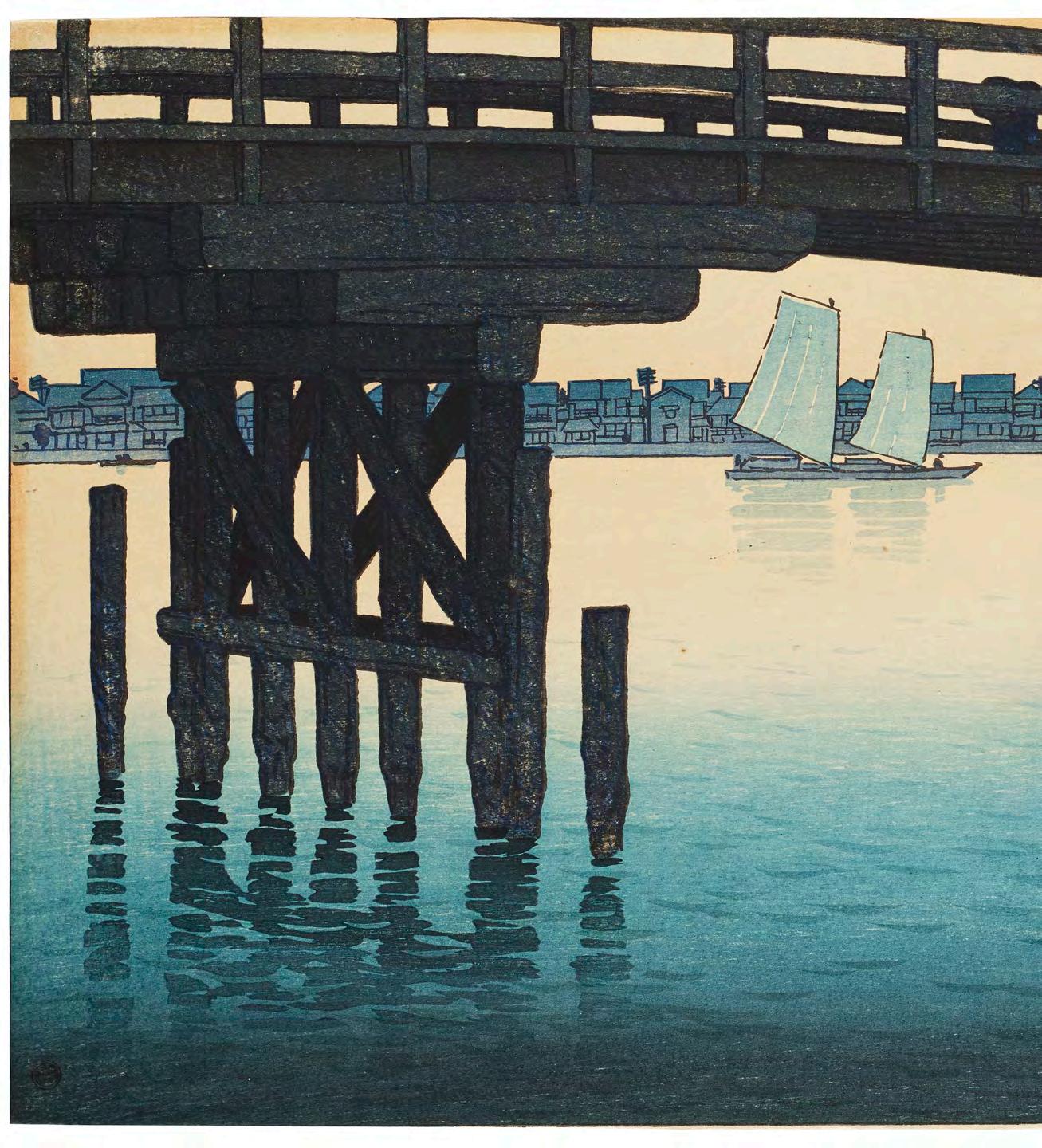
1359. Kawase Bunjiro Hasui (Japan, 1883 – 1957) Kami(no) Bridge, Fukagawa. Woodblock print in colours. Signed Hasui and sealed Kawase. From the series 'Twelve Scenes of Tokyo (Tokyo junidai)', 1920. Published by Watanabe Shôzaburô and with 6mm seal (1918–1924). Horizontal ôban: 24 x 36 cm.
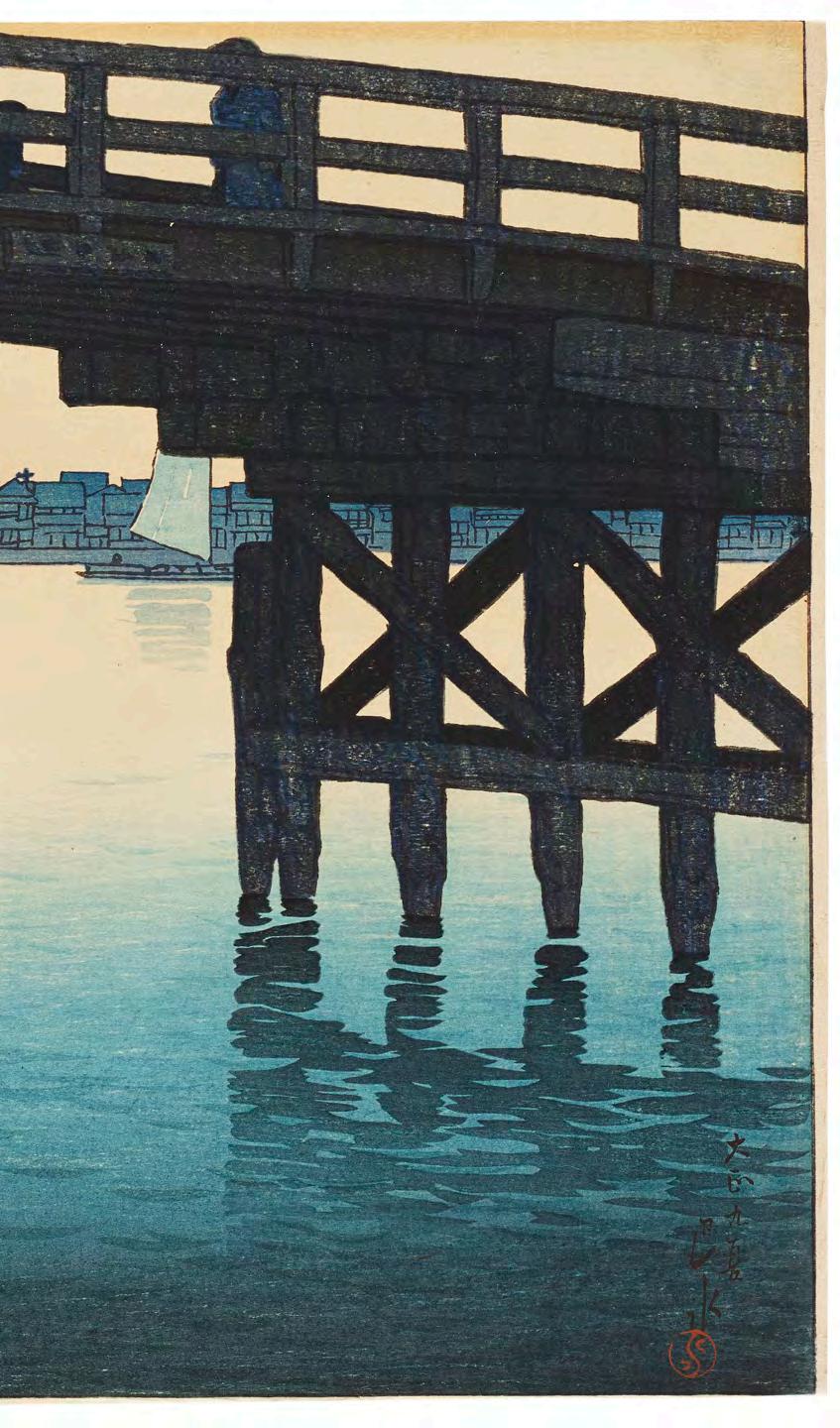
Provenance: From the Ankarcrona Collection. The foundation of the collection was laid by Rear Admiral/Flag officer Sten Ankarcrona (1861-1936). Ankarcrona first got a taste for the Asian Art while following his fathers’s footsteps serving as ‘enseigne de vaisseau’ for the French navy “la Royale” during the years 1885-1889, when his Fregatt sailed in the area. Ankarcrona continued to ad on to the collection, later in life when he was sent on a special mission to Japan in 1923. He brought back vast collections of lacquer, bronzes, textiles, ceramics. In 1911 the family moved to the mansion like duplex next to Sturegatan in Stockholm. The elegant home and their summer house at Brevik by Erstaviken where Ankarcrona created a Japanese garden (1923-27) and even set up a complete Japanese building was documented in the the magazine ‘Svenska Hem i ord och bild’ in 1928, which provide us with a fascinating window into this golden age of European collecting. The world renowned collection received many prestigious visitors throughout the years, the guest book contains signature of both the Swedish king Gustav VI Adolf as well as the Japanese crown prince, later Emperor Akihito. Stens son Sten S:son Ankarcrona (19041981, continued the tradition of collecting, amongst other things Swedish 18th Century furniture and art, pieces that worked well with family heirlooms from the Bergenstråhle, Bohnstedt, Cassel, Mörner and Lybecker families. Thence by descent.)
Exhibitions: Compare a print in the collections of the Art Institute of Chicago: 1990.607.362.
Estimate: SEK 6 000 – 8 000 / EUR 530 – 710
1360. A Japanese tea jar, Edo period (1603–1868).

Glazed in brown and black. With a silk satchel. Height 7 cm.
Estimate: SEK 4 000 – 6 000 / EUR 360 – 530
1361. A Japanese sculptured face mask, Edo period (1603–1868).
Sculptured as a wrathful face. Height 14 cm. Width 13 cm.
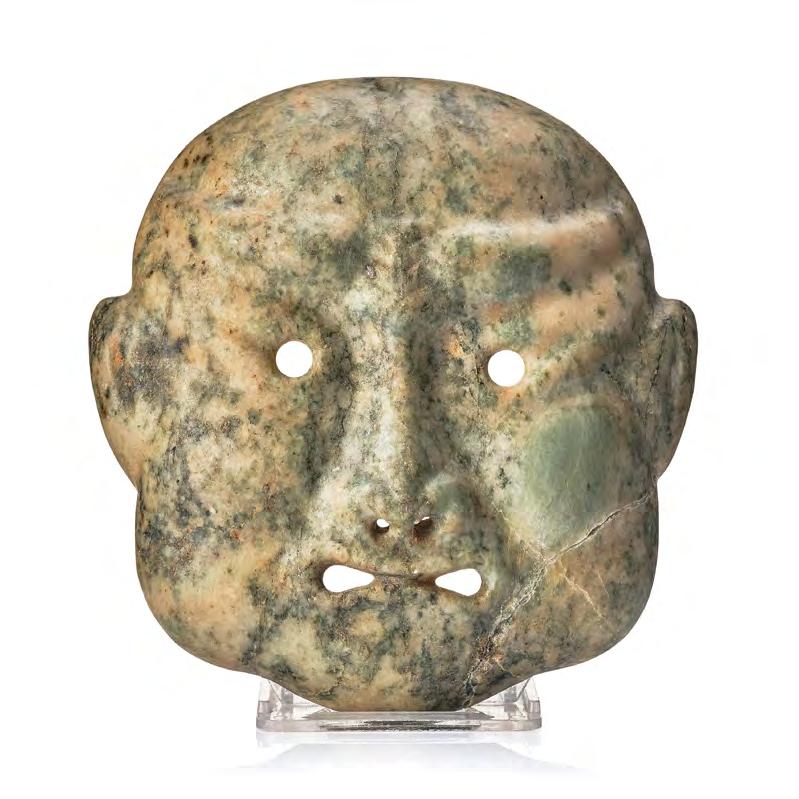
Provenance: Label from Nathan Bentz & Co, Los Angeles, CA. Collectors Chinese Art. For some 50 years, Nathan Bentz was a major figure in the cultural life of Santa Barbara. A collector and connoisseur of Asian art, Bentz built a business international in scope. He also built a home that today is considered one of the city’s architectural gems.
Bentz was born and raised in upstate New York. After spending a short time in South Dakota, he settled in San Francisco in 1881. He first dabbled in the real estate business and then began an apprenticeship with Horace Fletcher. Fletcher was one of San Francisco’s most distinguished antiques dealers, specializing in Japanese items. He had also earned nationwide acclaim as a dietician with his famous Fletcher Cure and Diet.
Bentz spent 10 years with Fletcher, soaking up his knowledge and experience, before striking out on his own by relocating to Santa Barbara in 1891. In 1892, he opened his first antiques store at 1229 State Street. Henry Chapman Ford, Santa Barbara’s first significant painter, also had a studio in this building during the last years of his life.
In 1912, Bentz moved his business to 1236 State Street, and here it would remain until closing for good in 1945. Bentz selected well, for in the 1300 block of State Street stood the Arlington Hotel, Santa Barbara’s premiere and, until the Potter Hotel opened in 1903, only luxury hostelry. The hotel’s wealthy patrons were a natural clientele for Bentz’s offerings of fine Asian art goods.
In the early years, Asian art and artifacts were somewhat hard to come by, and Bentz often had to purchase his wares through other American dealers or use European dealers as middlemen. In 1896, Bentz made his first buying trip overseas, to China and Japan, and these journeys became almost yearly affairs. This was rather remarkable for an era when travel by steamship was the only way to cross the Pacific. Bentz also traveled extensively throughout Europe in his buying quests.
He often returned with one-of-a-kind treasures. In 1911, the local newspaper described a collection of Japanese art gems valued at almost $70,000 that Bentz brought back with him. Success in Santa Barbara allowed him, in partnership with his brother Philip, to open stores in Los Angeles and San Francisco. Bentz developed an international reputation as an expert in Asian art and artifacts, especially porcelain, with buyers and contacts in Europe, Asia, and the U.S.
In spring 1911, Bentz paid local contractor Isaac Hardy $5,000 to build a two-story home on the Riviera. Bentz selected brothers Charles and Henry Greene of Pasadena to design the home. The brothers were among the finest practitioners of the Arts and Crafts architectural style. Probably their best-known work is the David Gamble house in Pasadena. Bentz was aware of the Greenes’ work through his brother, John, who knew them. Bentz was intrigued by their use of Asian elements in their designs. The house, on Prospect Avenue, is the only Greene and Greene building in Santa Barbara and is one of the city’s finest examples of Craftsman architecture.
Meiji period (1868–1912).
Standing figures of samurai soldiers carrying a vessel/candle holder in his hand. Mounted on wooden stands. Gilded details. Height with wooden stand 26.5 cm.
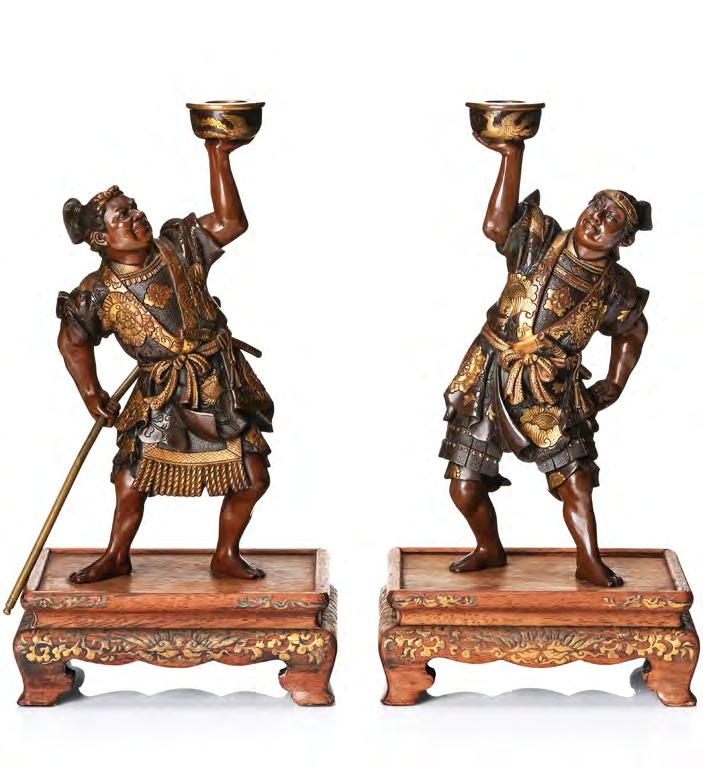
Estimate: SEK 15 000 – 20 000 / EUR 1 320 – 1 760
Bentz’s store weathered the disruptions of the Great Depression and World War II. He died suddenly of a heart attack in 1943, and Philip came down from San Francisco to run the Santa Barbara operation for two years before permanently closing up shop. Nathan Bentz had passed from the scene just as the war and its aftermath were irrevocably changing the nature of the business in which he had been such a success.
Estimate: SEK 6 000 – 8 000 / EUR 530 – 710
1363. A set of five Japanese Tsubas, Edo period (1666–1868). One signed.


In different styles. Height 7–8.5 cm.

Provenance: From the Collection of Åke Reuterswärd (1884–1973), thence by descent. Åke Reuterswärd was a passionate collector who aquired most of his collection through his brother Thorsten Reuterswärds gallery, the well reknowned 'Japanska Magasinet' in Stockholm.
Estimate: SEK 6 000 – 8 000 / EUR 530 – 710
1364. A group of five Japanese Tsubas, Edo period (1868–1666). Two signed.
Of different decoration in relief and with gilded details. Height 7–7.5 cm.
Provenance: From the Collection of Åke Reuterswärd (1884–1973), thence by descent. Åke Reuterswärd was a passionate collector who aquired most of his collection through his brother Thorsten Reuterswärds gallery, the well reknowned 'Japanska Magasinet' in Stockholm.
Estimate: SEK 10 000 – 15 000 / EUR 880 – 1 320
1365. A set of five Japanese Tsubas, Edo period (1666–1868).

Of different decoration, gilded details. Height 6.5 -8 cm.
Provenance: From the Collection of Åke Reuterswärd (1884–1973), thence by descent. Åke Reuterswärd was a passionate collector who aquired most of his collection through his brother Thorsten Reuterswärds gallery, the well reknowned 'Japanska Magasinet' in Stockholm.
Estimate: SEK 6 000 – 8 000 / EUR 530 – 710
1366. A group of five Japanese Tsubas, presumably Edo period. One signed.
Of different models. Height 7–7.5 cm.
Provenance: From the Collection of Åke Reuterswärd (1884–1973), thence by descent. Åke Reuterswärd was a passionate collector who aquired most of his collection through his brother Thorsten Reuterswärds gallery, the well reknowned 'Japanska Magasinet' in Stockholm.
Estimate: SEK 6 000 – 8 000 / EUR 530 – 710
1367. A group of five Japanese Tsubas, 19th Century. Two signed. From the Collection of Åke Reuterswärd (1884–1973), thence by descent. Åke Reuterswärd was a passionate collector who aquired most of his collection through his brother Thorsten Reuterswärds gallery, the well reknowned 'Japanska Magasinet' in Stockholm.
SEK 12 000 – 15 000 / EUR 1 060 – 1 320
1368. A set of five Japanese Tsubas, Meiji period (1868–1912). Of different decoration in relief with gilded and coppered details. Height 6.5–8 cm.
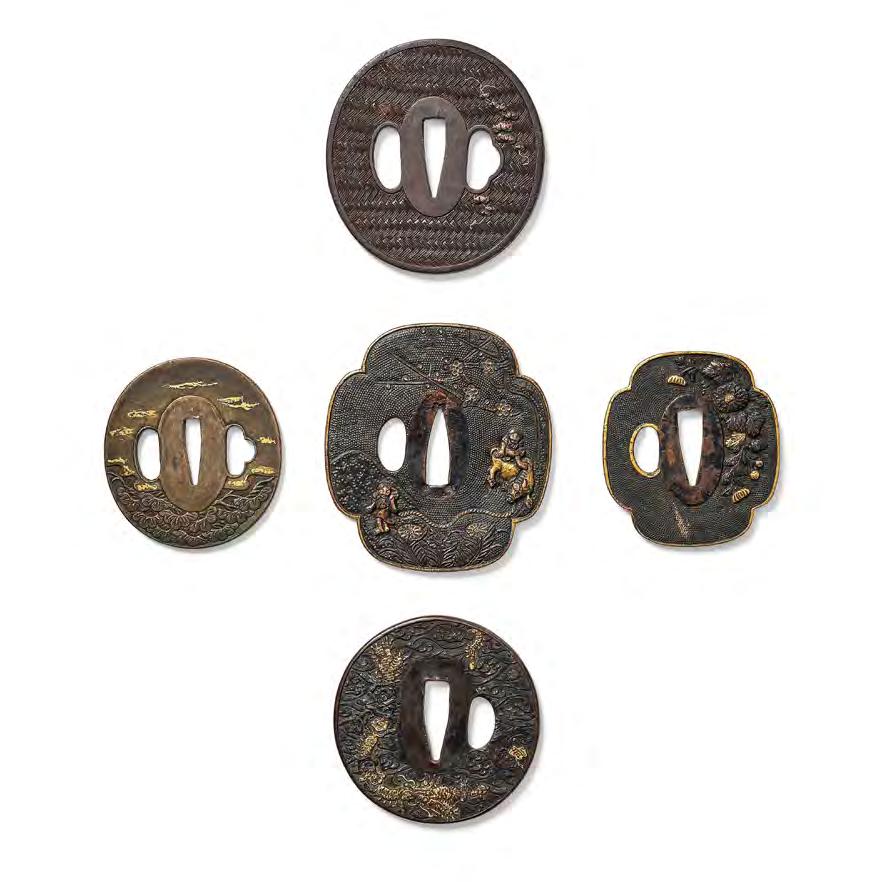

Provenance: From the Collection of Åke Reuterswärd (1884–1973), thence by descent. Åke Reuterswärd was a passionate collector who aquired most of his collection through his brother Thorsten Reuterswärds gallery, the well reknowned 'Japanska Magasinet' in Stockholm.
Estimate: SEK 8 000 – 10 000 / EUR 710 – 880
1369. A set of two Japanese inros, 19th Century. One five tiered decorated with mountains. Height 7 cm. One five tiered decorated with two fishermen with baskets in gold agaist a black lacquer. Height 6,5 cm.

Provenance: From the collection of Blanche Reuterswärd f. Gottschalk (1880-1944), Stockholm. Thence by desent.
Estimate: SEK 8 000 – 10 000 / EUR 710 – 880
The cabinet with drawers and doors, and additional drawers and shelfves behind the doors. Measurment cabinet 29 x 33 x 16 cm. Measurment stand 37 x 23 x 35 cm. Total height 52.5 cm.
Provenance: Property of a private Swedish Collection.
Estimate: SEK 10 000 – 15 000 / EUR 880 – 1 320

1371. A blue and white dish with an elephant, Japan, 19th Century. Octagonal shape, decorated in blue and white with a elephant and two elephant keepers, around the rim a firece dragon. Measurment 29 x 34 cm.

Provenance: From the collection of the Danish family Rosencrantz, according to the family tradition it has come from the Det Gamle Slott, Fyn, Danmark. Thence by descent.
Estimate: SEK 6 000 – 8 000 / EUR 530 – 710
SPRING 2023
DESIGN SALE HELSINKI
Auction Online April 5–16
CONTEMPORARY ART & DESIGN
Viewing April 21–25 | Auction Live April 26
IMPORTANT TIMEPIECES
Viewing April 21–25 | Auction Live April 26
MODERN ART + DESIGN
Viewing May 11–15 | Auction Live May 16–17
HELSINKI SPRING SALE
Auction Online May 17–28
IMPORTANT SPRING SALE
Viewing June 8–13 | Auction Live June 14–16
SYSTEMBOLAGET – BEVERAGE AUCTIONS
D049: 27 Feb–March 1 | D050: April 3–5
D051: May 8–10 | D052: June 12–14
All beverage auctions are online
Estimates are given in Swedish kronor (SEK) and € (EUR). Bukowskis general terms and conditions for buyers and sellers, bidding instructions, and special terms and conditions for individual lots can be found at bukowskis.com
Bukowskis Stockholm
Arsenalsgatan 2 Box 1754 111 87 Stockholm, Sweden
T +46 8 614 08 00
F +46 8 611 46 74 www.bukowskis.com
All lots with a lower estimate value of 15 000 SEK and above in the Art section of Modern Art and Important Winter/Spring’s hammer sales are searched against the Art Loss Register database.

WWW.BUKOWSKIS.COM



 LOT 951 – 969
LOT 951 – 969
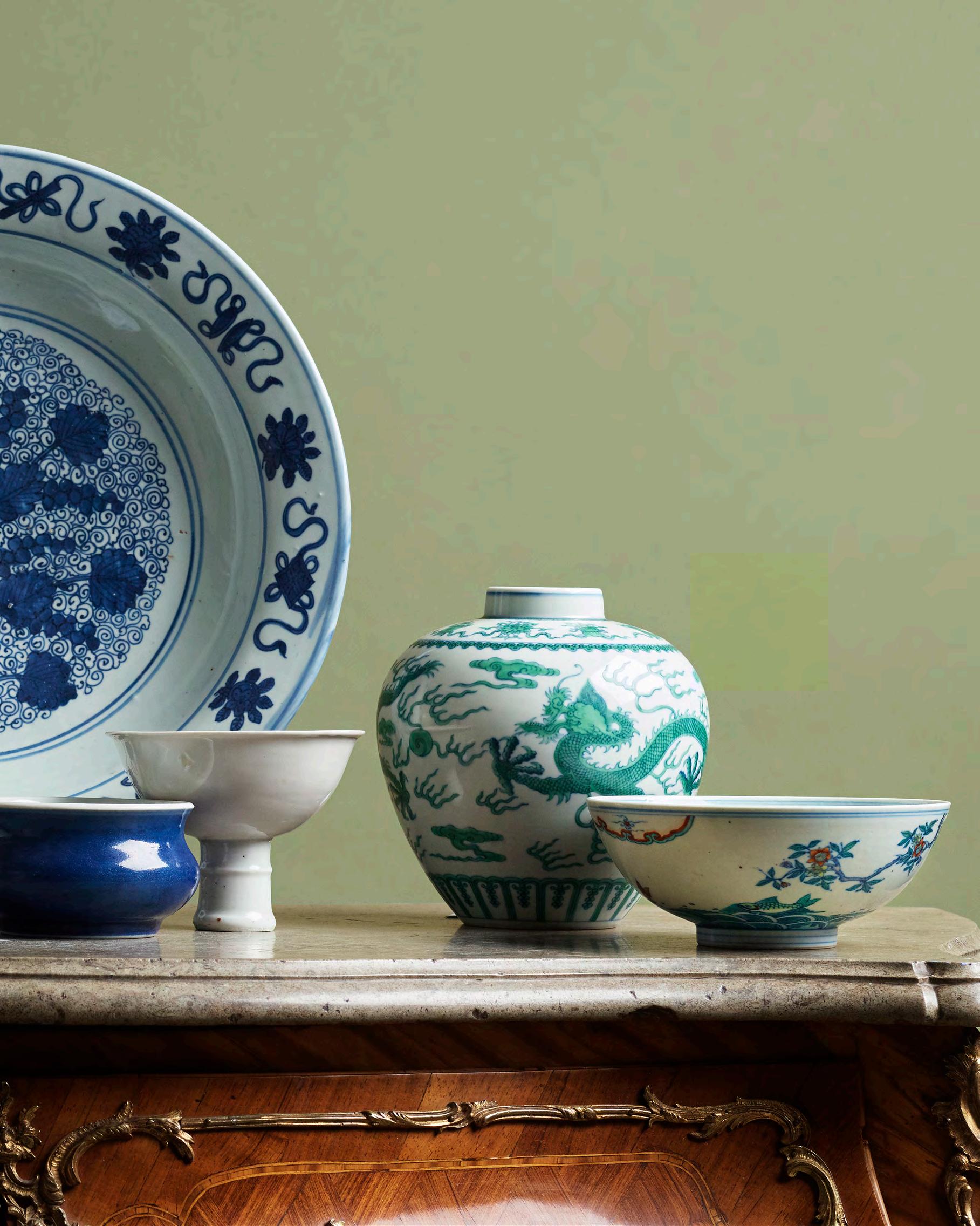

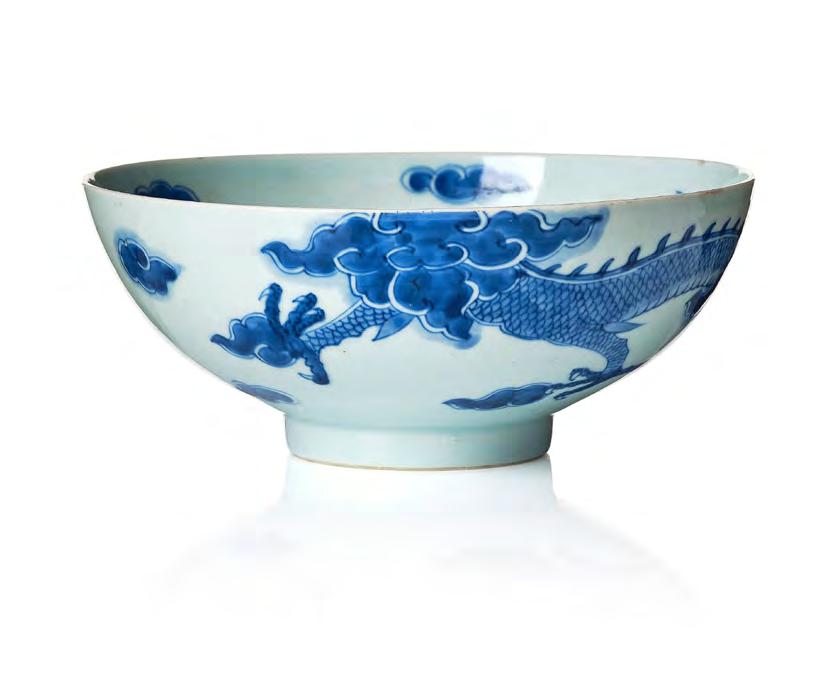
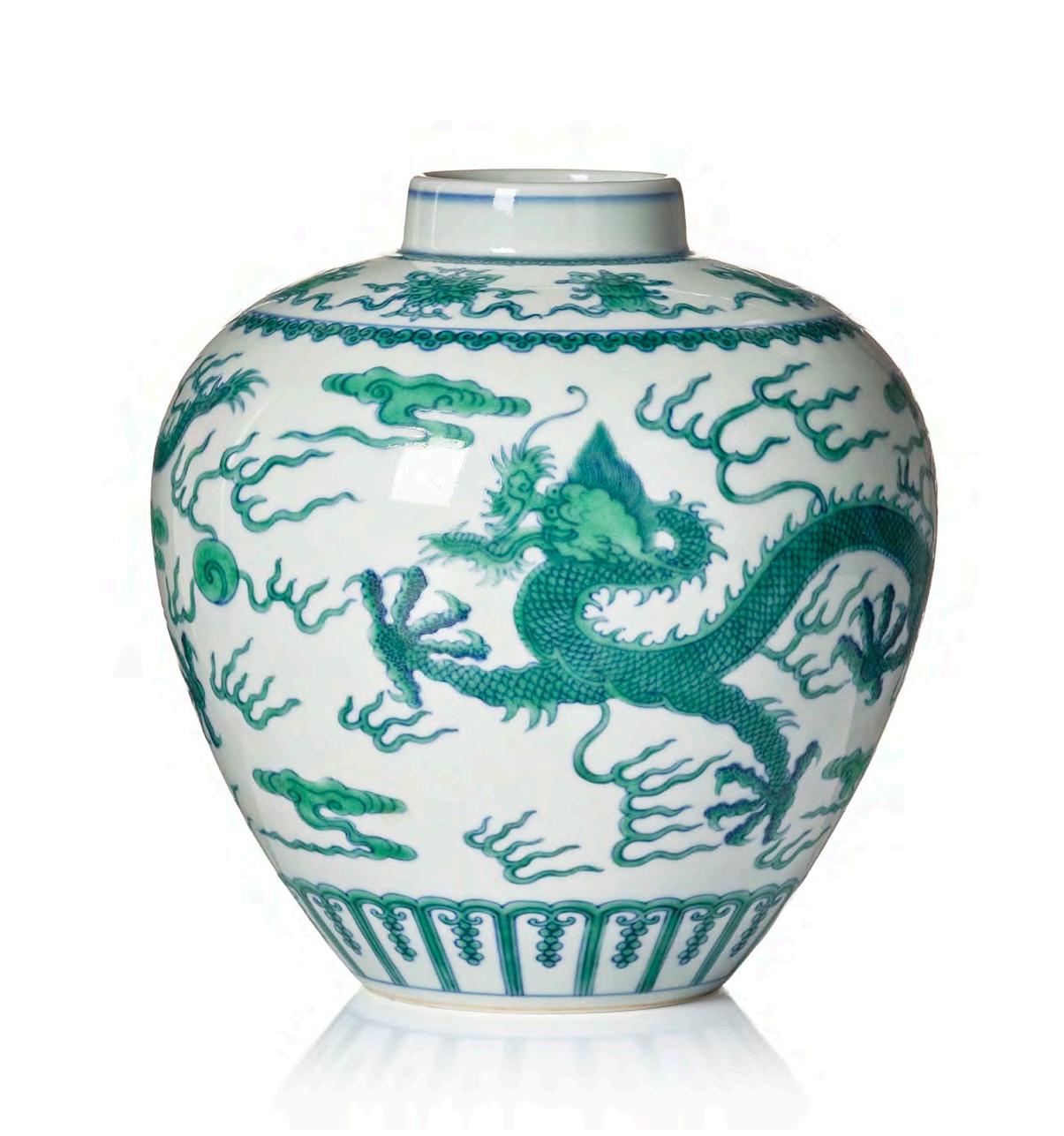



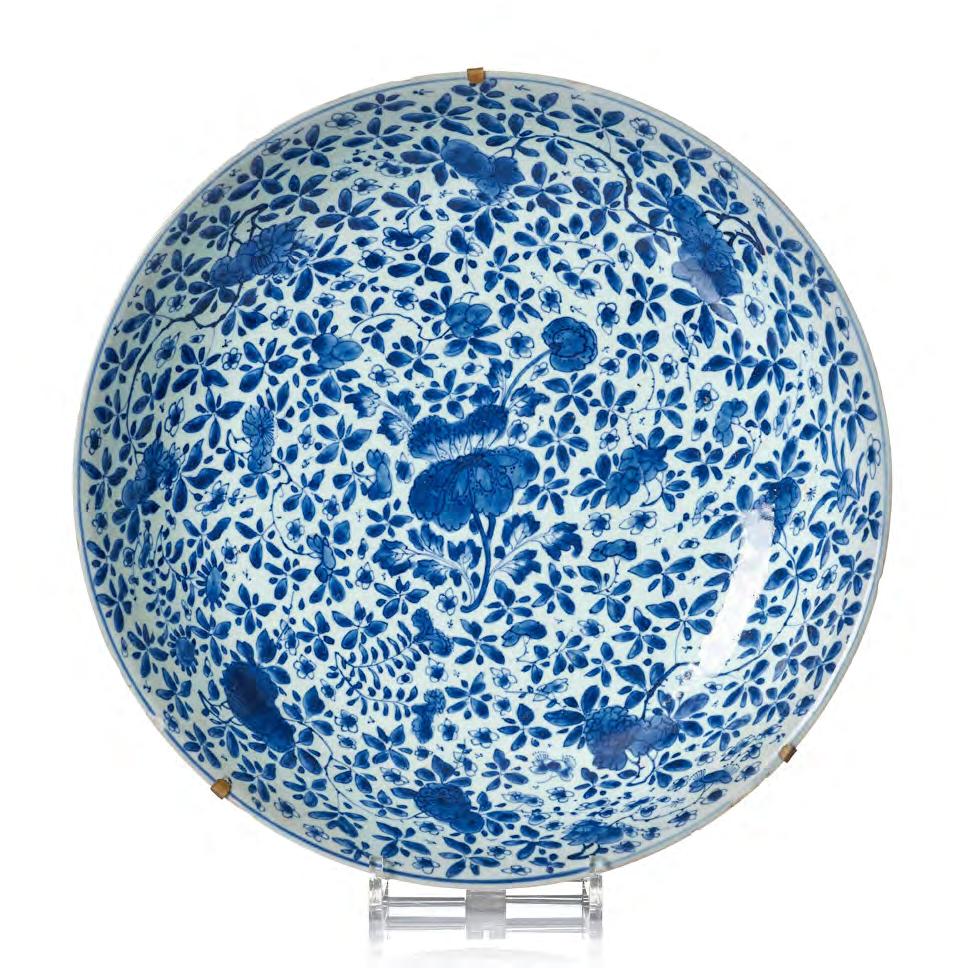
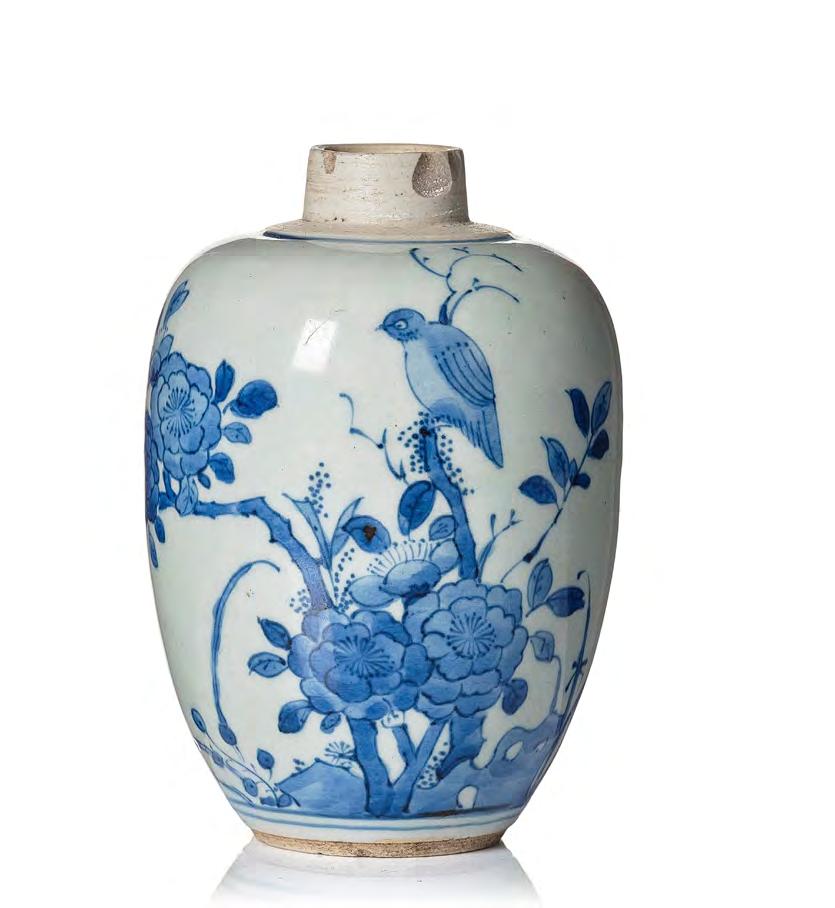


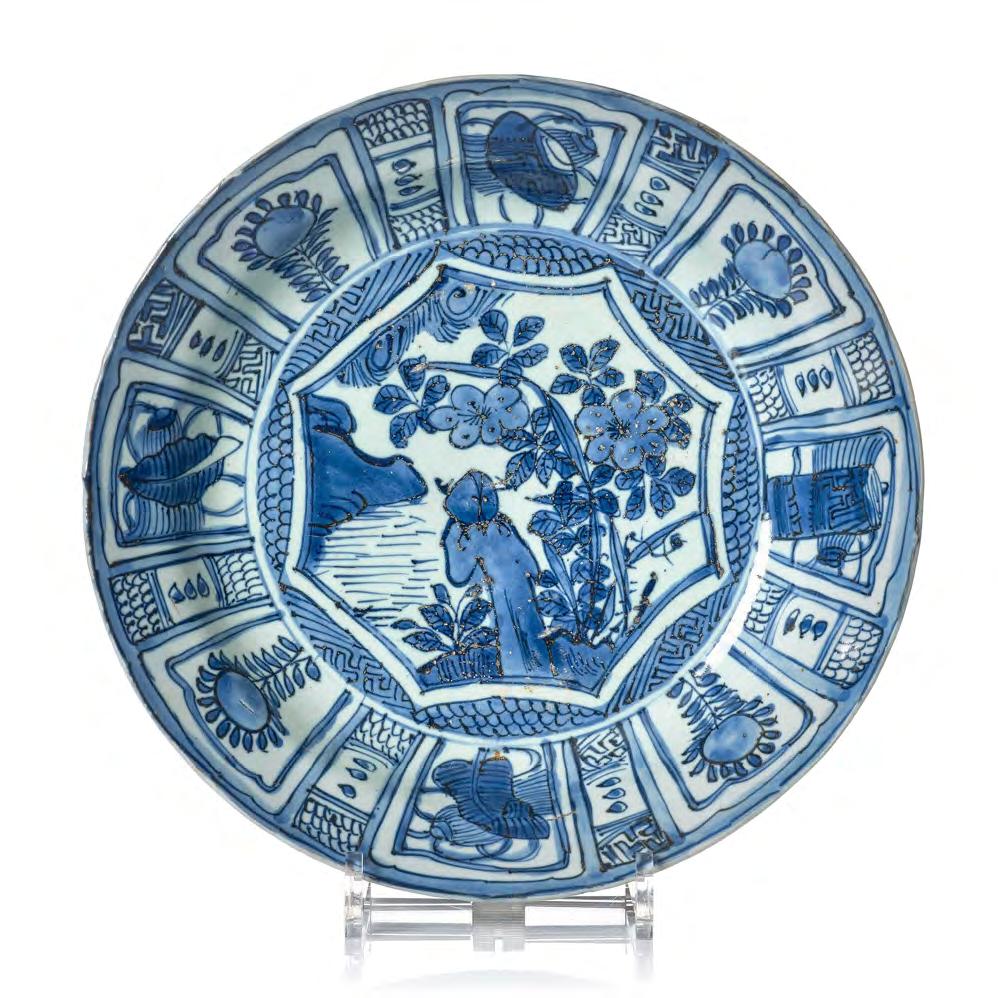

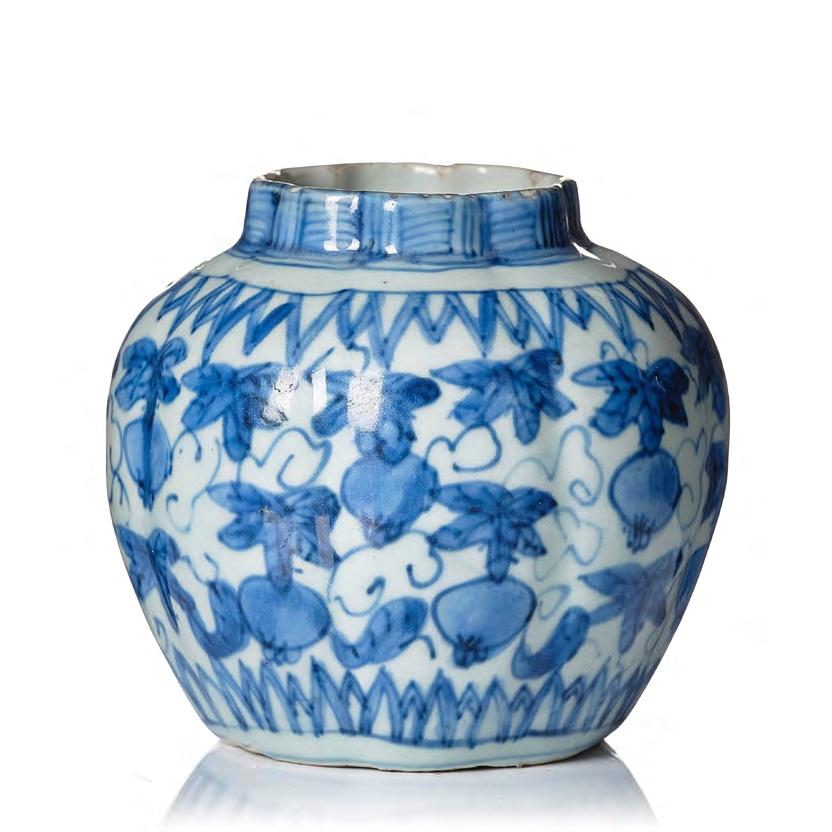


 971. A famille rose 'nine dragon' brush pot, Qing dynasty, Qianlong (1736–95).
971. A famille rose 'nine dragon' brush pot, Qing dynasty, Qianlong (1736–95).
 985. A Chinese album with paintings of Envoys Presenting Tribute 职贡图 (Zhigong tu), probably 17th Century, after an old master.
985. A Chinese album with paintings of Envoys Presenting Tribute 职贡图 (Zhigong tu), probably 17th Century, after an old master.
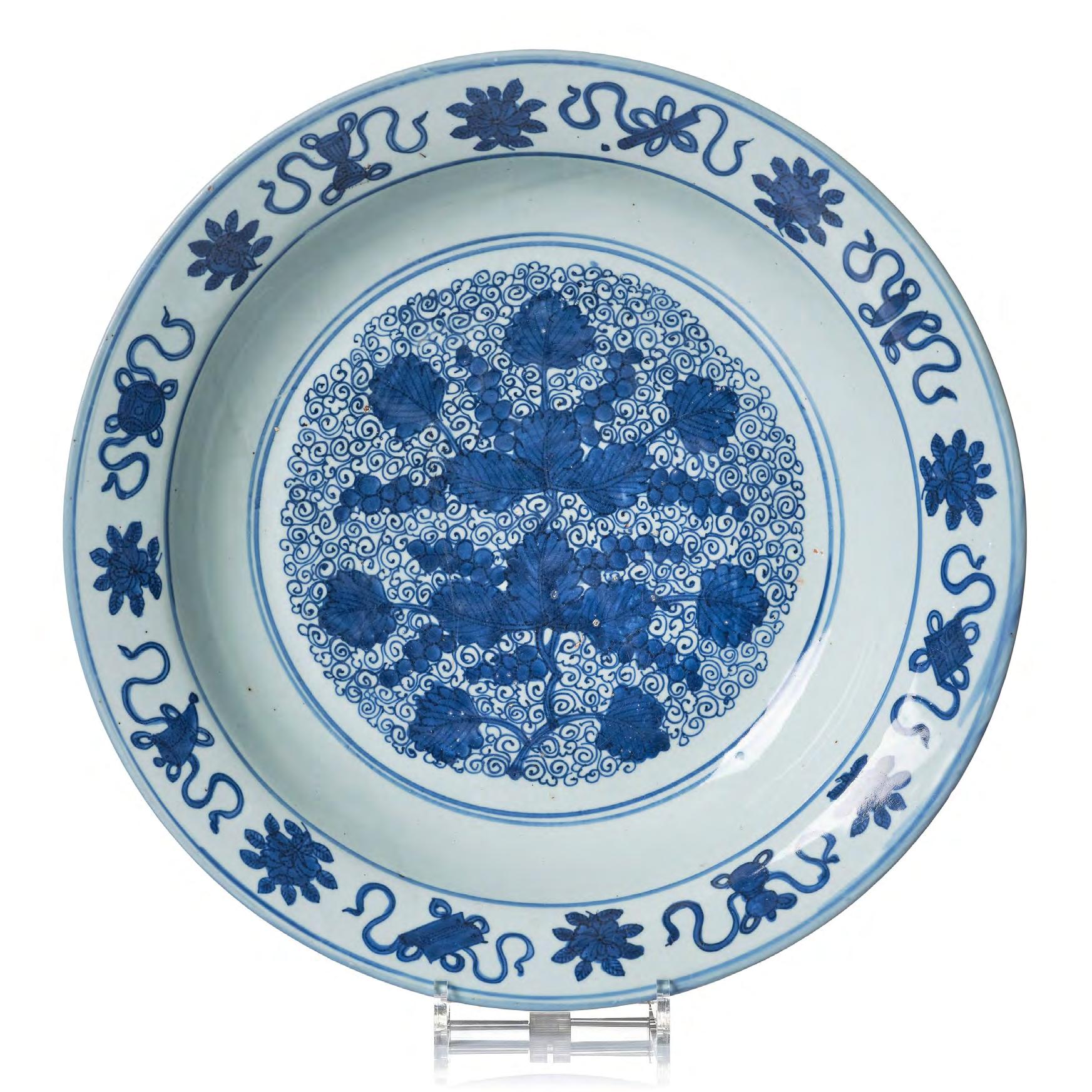
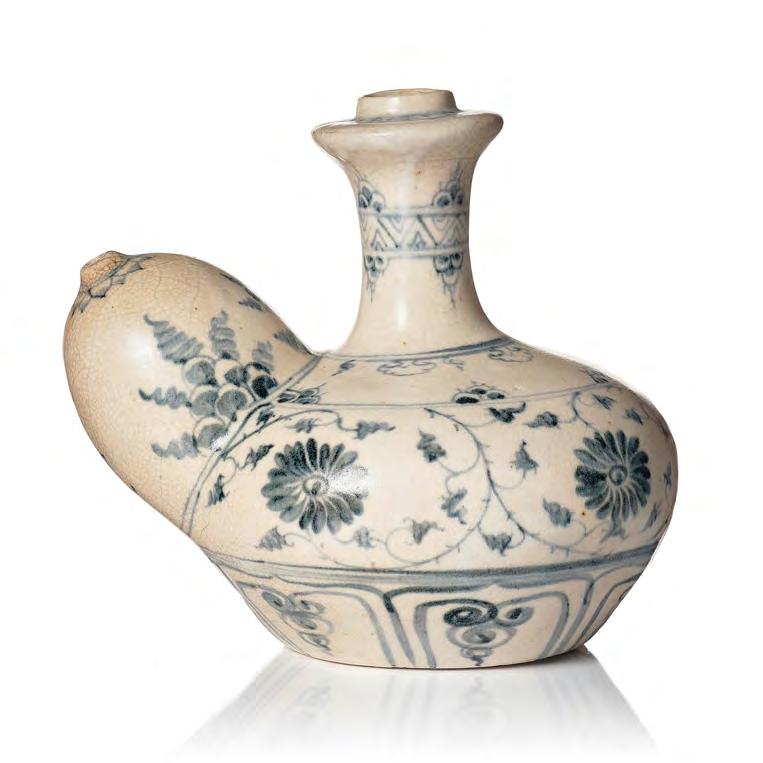


 LOT 970 – 977
LOT 970 – 977













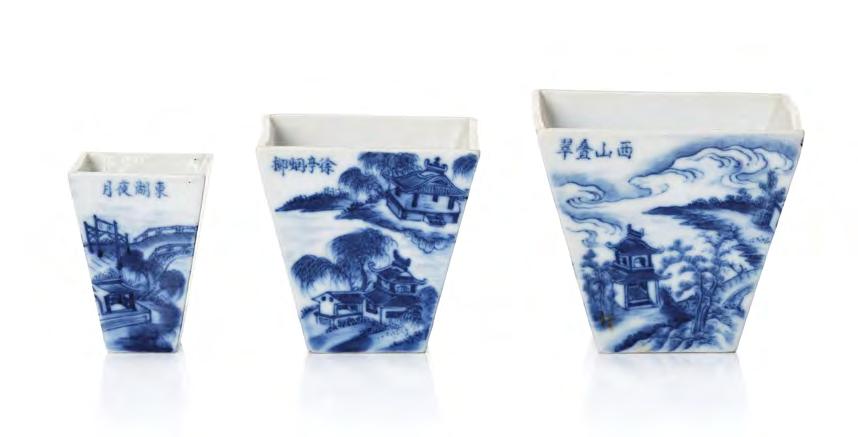

 981. A Chinese zitan altar table with cloisonné placques, Qing dynasty, Qianlong period (1736–1795).
981. A Chinese zitan altar table with cloisonné placques, Qing dynasty, Qianlong period (1736–1795).





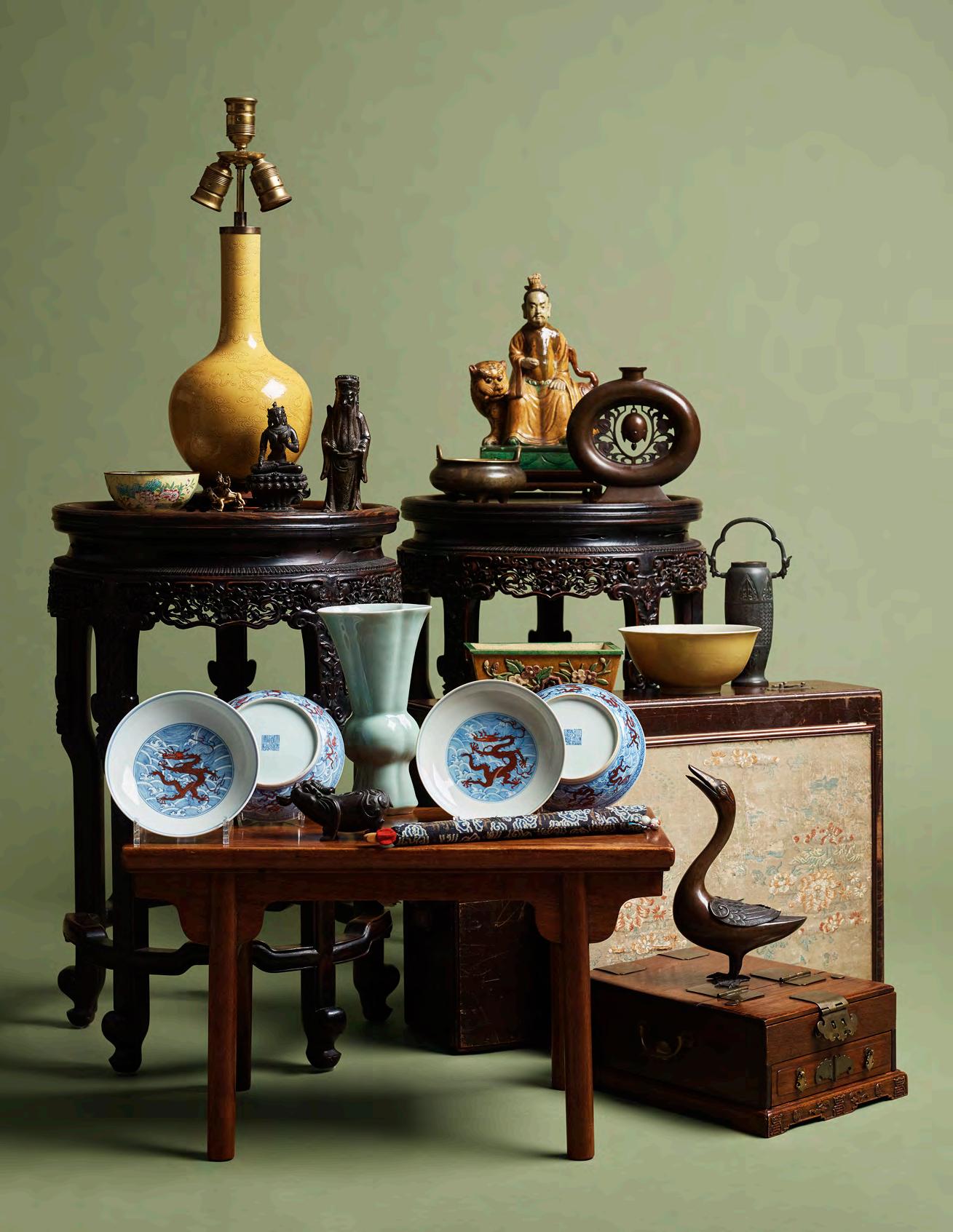


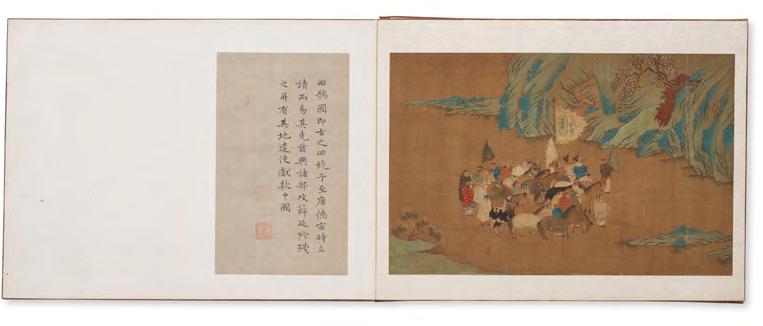


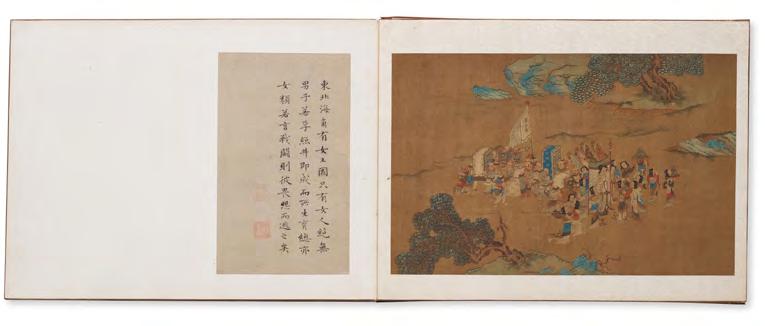













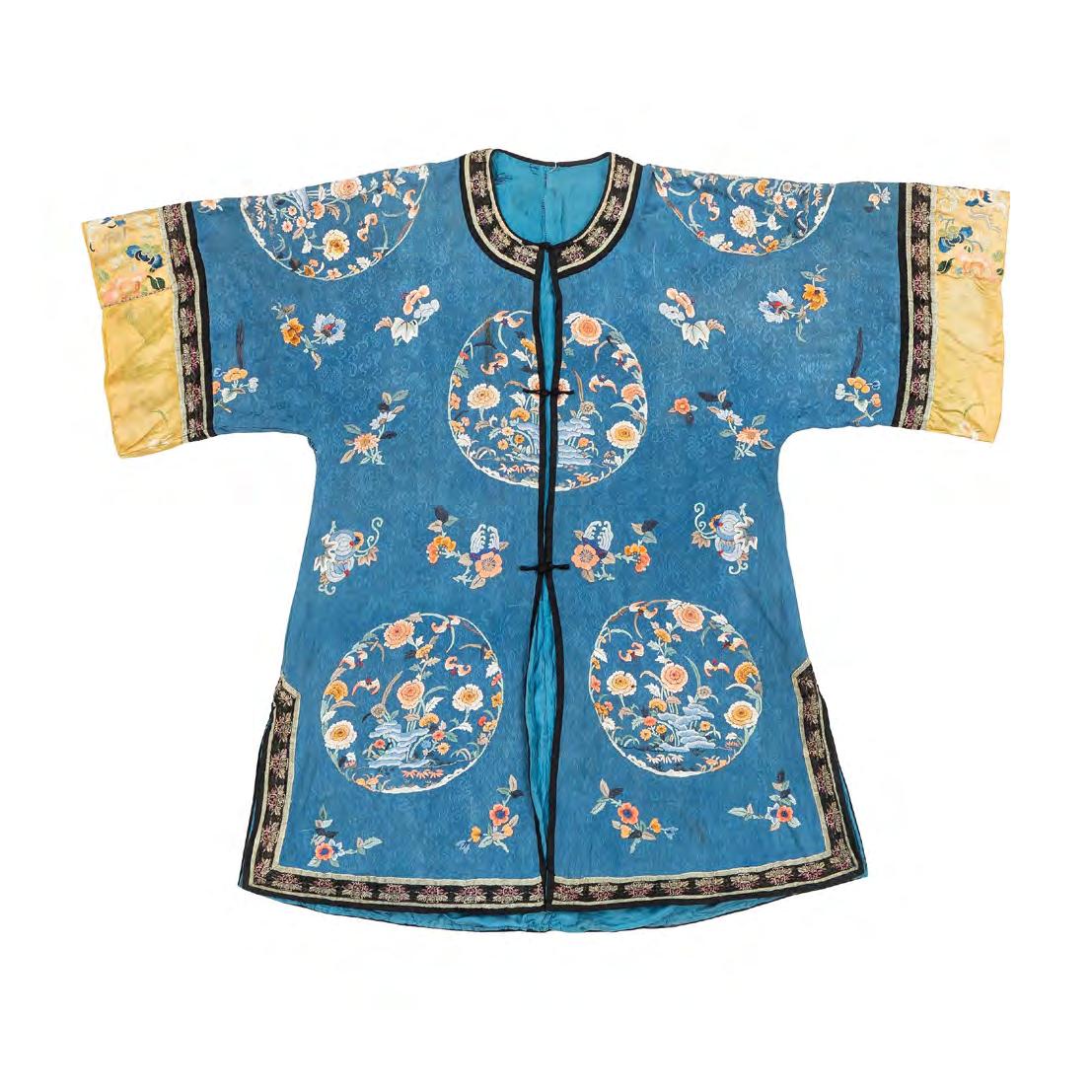
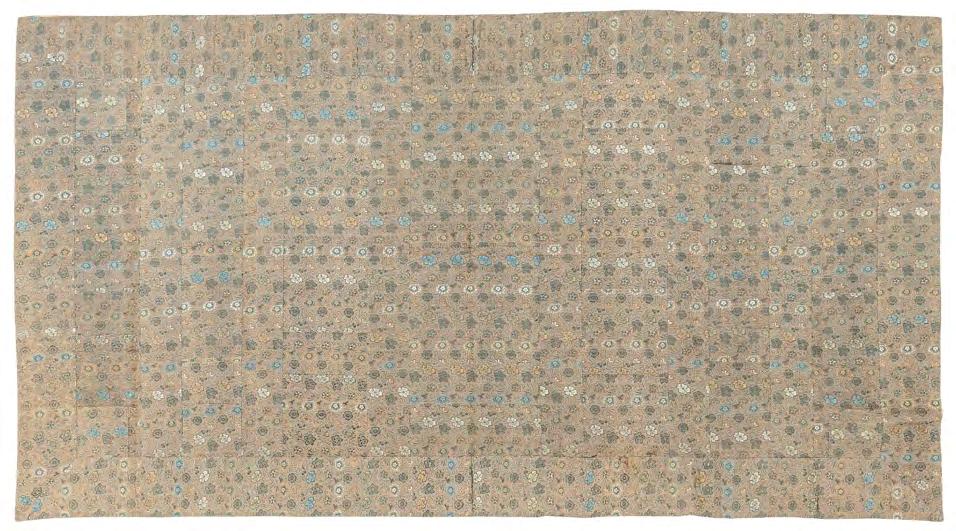







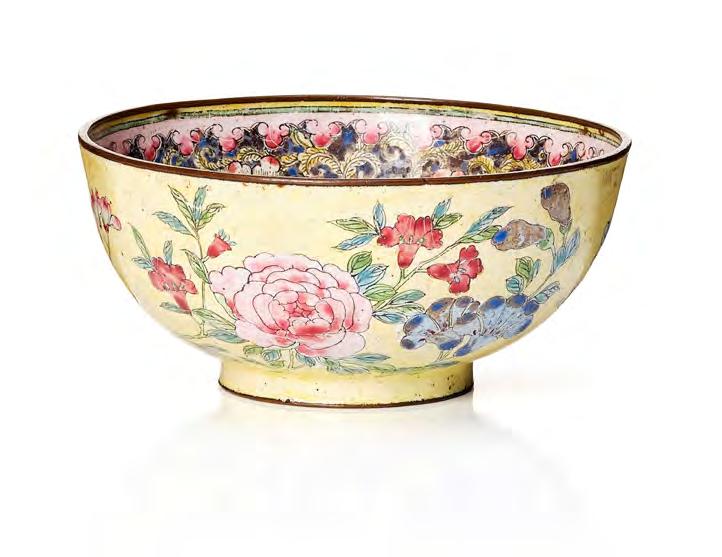



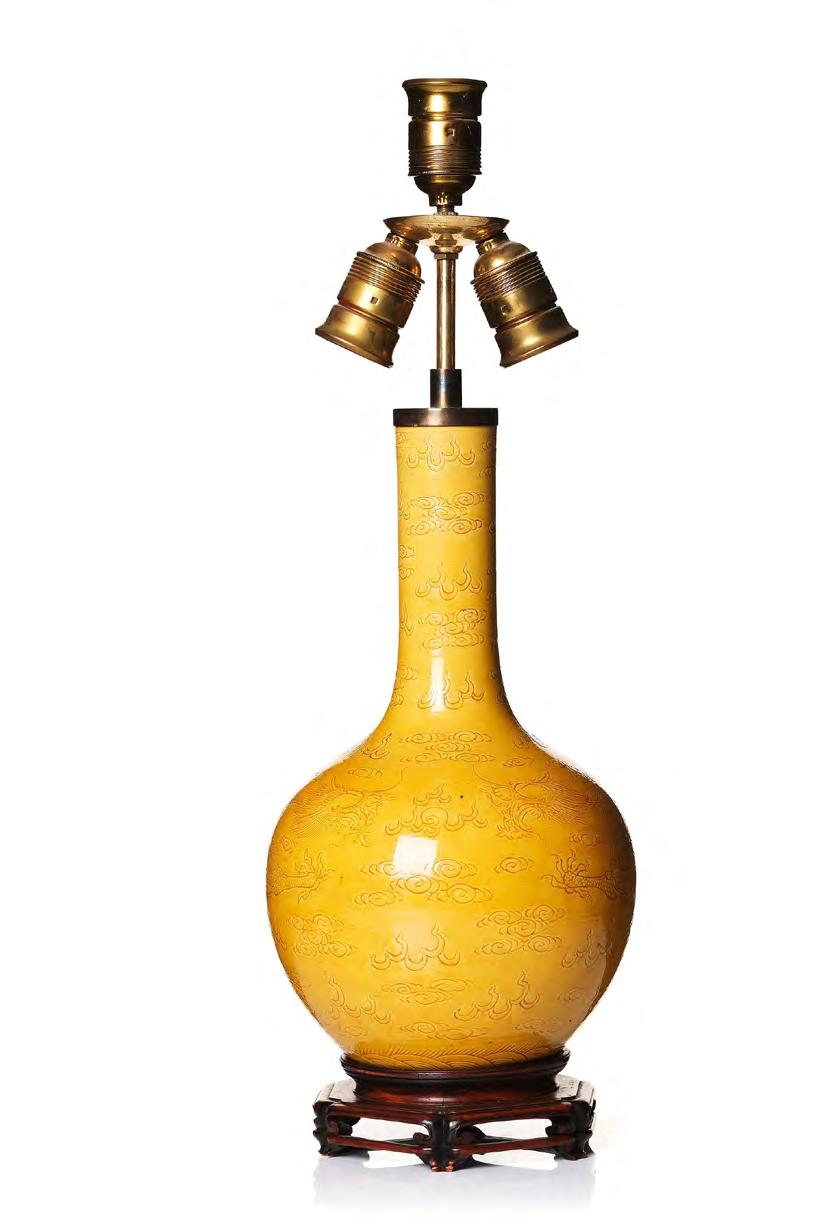



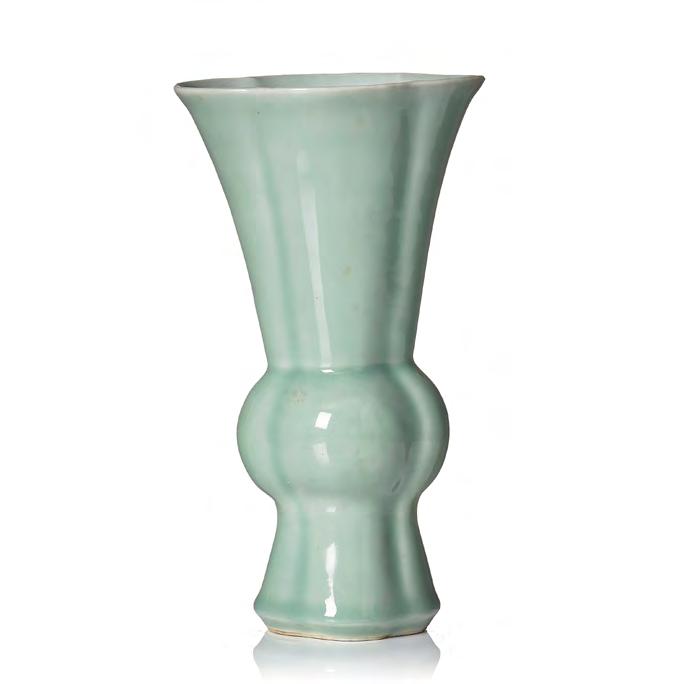


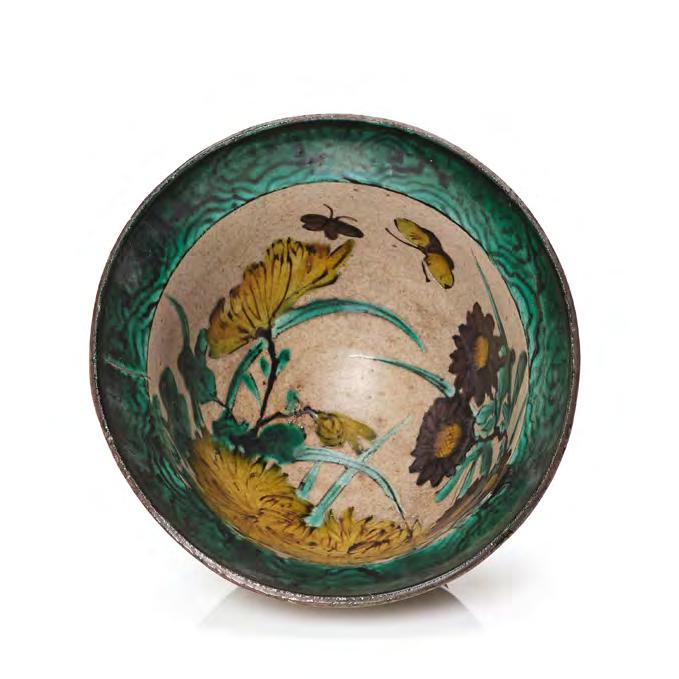




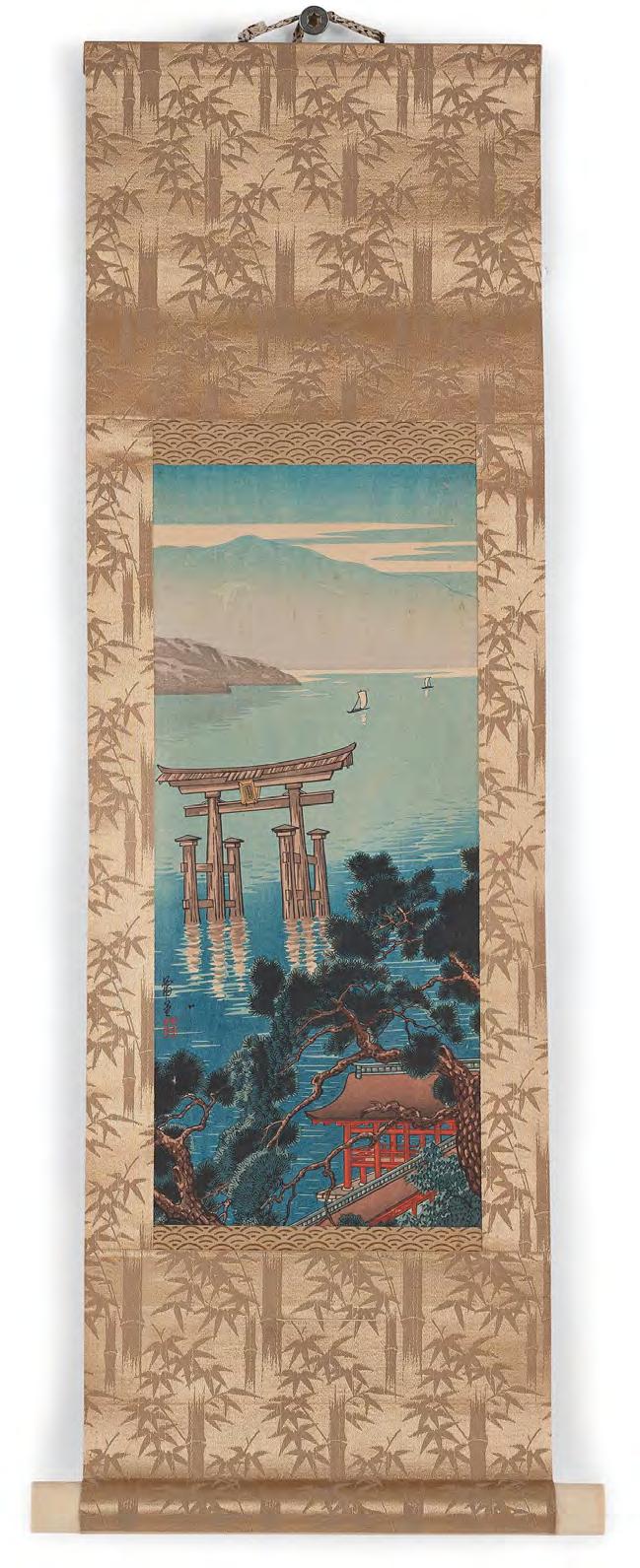
 LOT 1020 – 1032
LOT 1020 – 1032










 1036. A long scroll painting after Zhao Yong (Zhao Zhongmu 1289–1369), ink and colour on paper and on silk, Qing dynasty.
1036. A long scroll painting after Zhao Yong (Zhao Zhongmu 1289–1369), ink and colour on paper and on silk, Qing dynasty.




























 1047. A Chinese black lacquered altar table with mother of pearl inlay, 17th /18th Century.
1047. A Chinese black lacquered altar table with mother of pearl inlay, 17th /18th Century.













 LOT 1054 – 1080
LOT 1054 – 1080



















 1042. The Hongs of Canton by anonymous Chinese artist, around 1800.
1042. The Hongs of Canton by anonymous Chinese artist, around 1800.













 LOT 1081 – 1089
LOT 1081 – 1089












 LOT 1091 – 1094
LOT 1091 – 1094


 Ming dynasty
1093. A bronze figure of Avalokiteshvara, Qing dynasty, 18th Century. Depicted seated in a royal ease on a double lotus throne, holding a pearl in one hand. Height 17 cm.
Ming dynasty
1093. A bronze figure of Avalokiteshvara, Qing dynasty, 18th Century. Depicted seated in a royal ease on a double lotus throne, holding a pearl in one hand. Height 17 cm.






























 1126. A Chinese export silver wine ewer, Qing dynasty, 19th Century.
1126. A Chinese export silver wine ewer, Qing dynasty, 19th Century.




















 LOT 1142 – 1228
The Tove and Karl Emil Strömstad Collection.
LOT 1142 – 1228
The Tove and Karl Emil Strömstad Collection.







































































 A silver mounted tankard, Qing dynasty, Kangxi (1662–1722). Unidetified makers mark on the silver. Engraved dating to the cover 1799. Silver coin to the center of the cover. 'CAROLUS IV DEI GRATIA 1789'. 'HISPAN IND REX'. Decorated in iron red and gold. Height 20 cm.
A silver mounted tankard, Qing dynasty, Kangxi (1662–1722). Unidetified makers mark on the silver. Engraved dating to the cover 1799. Silver coin to the center of the cover. 'CAROLUS IV DEI GRATIA 1789'. 'HISPAN IND REX'. Decorated in iron red and gold. Height 20 cm.









































































 Lot. no 1286. A pair of Chinese stemcups, with the mark o f dowager empress Ci Xi, Dayazhai, late Qing dynasty.
Lot. no 1286. A pair of Chinese stemcups, with the mark o f dowager empress Ci Xi, Dayazhai, late Qing dynasty.


































 1285. A large 'Eight Buddhist Emblems' dish, Qing dynasty, mark and period of Guangxu (1875–1908).
1285. A large 'Eight Buddhist Emblems' dish, Qing dynasty, mark and period of Guangxu (1875–1908).

























































